- Work With Me

- Sierra Leone
- South Africa
- New Zealand
- Falkland Islands
- Netherlands
- Accommodation
- Electrical Gear
- Essential Gear
- Working Abroad
- Blogging Resources

Eastern Europe , Europe , MONTENEGRO
Montenegro travel guide: key things to know before visiting.
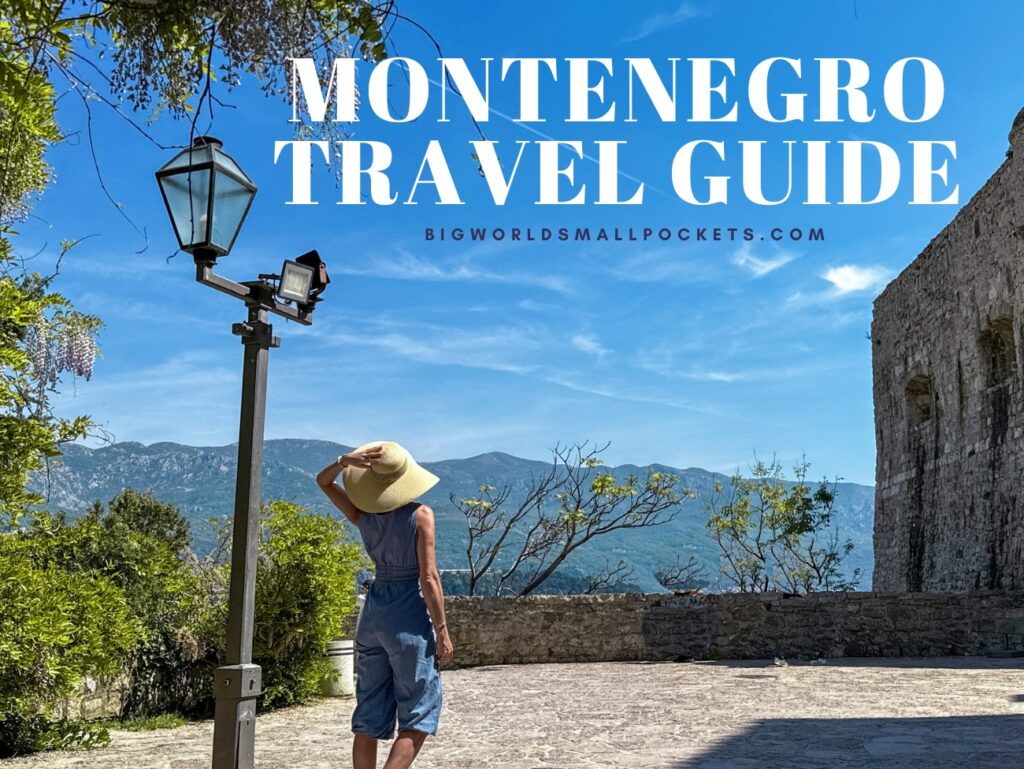
If you’re looking for a fab European summer getaway, but worried that your budget won’t stretch to Greece or Croatia, then can I introduce you to Montenegro!
As this complete travel guide will quickly reveal, Montenegro is one of my top travel dupes.
I first visited this tiny, terrific Balkan country in 2018 and quickly fell in love with its dreamy Adriatic views, stunning national parks and incredible food and wine.
Filled with wild mountainous areas and striking coastal views, not to mention top historical sites and a Mediterranean climate that lends itself to outdoor days and alfresco dining, it will come as no surprise that Montenegro quickly charmed its way into my heart.
So when I got the opportunity to return this year, I couldn’t have been more excited!
In under 3 hours, via a direct flight from London, I could be sunning myself in Kotor, wine tasting in Podgorica or hiking in Durmitor National Park?
Yes please!
With my suitcase hastily packed, and sunglasses at the ready, the only other thing I had to consider was my data allowance and making sure I could stay connected in Montenegro – well this was a work trip after all!
Located outside the EU, a hasty search revealed that unfortunately my current data roaming plan would not extend to Montenegro, so I knew I had to purchase an eSIM policy pronto.
Thankfully Holafly quickly came to the rescue and with my phone connection for my trip secured and passport in hand, I was ready to go!
And what a trip it was!
7 amazing days in perfect weather meant Montenegro shot even higher up my travel hotspot list.
So here, to fill you in on everything you need to know ahead of your trip, is my complete Montenegro travel guide, packed full of the essential info for your upcoming visit…
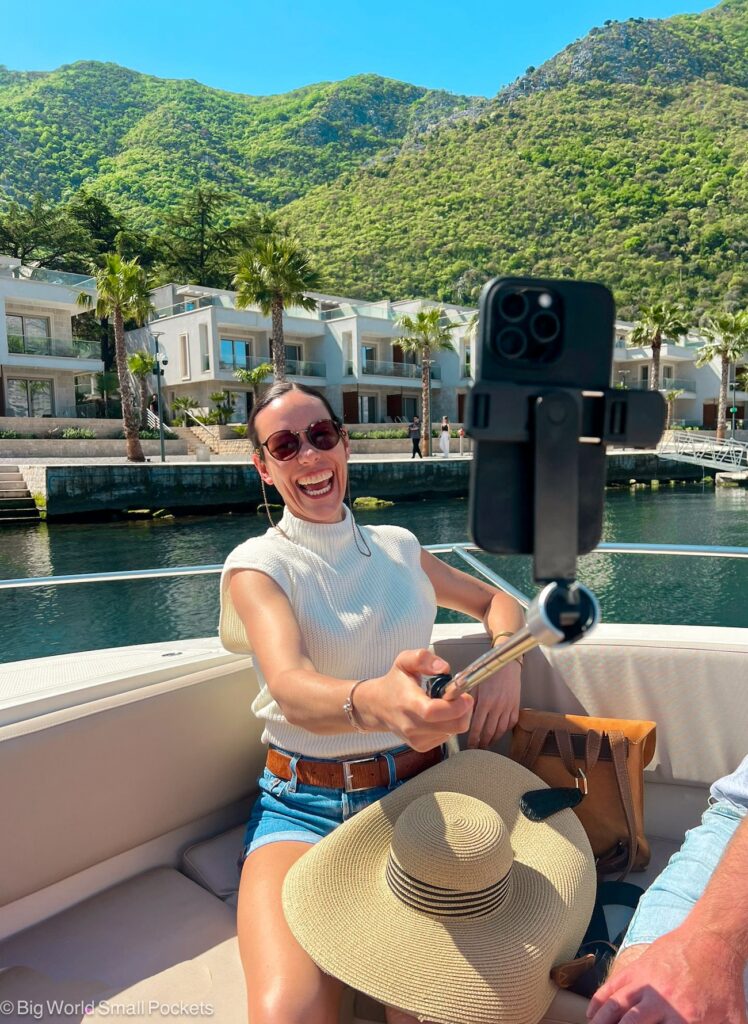
Related Posts
- Best Things to See and Do to Kotor, Montenegro
- 20 Best Things to Do in Podgorica inc Day Trips
- Budva or Kotor… Which is Better?
Best Places to Visit in Montenegro?
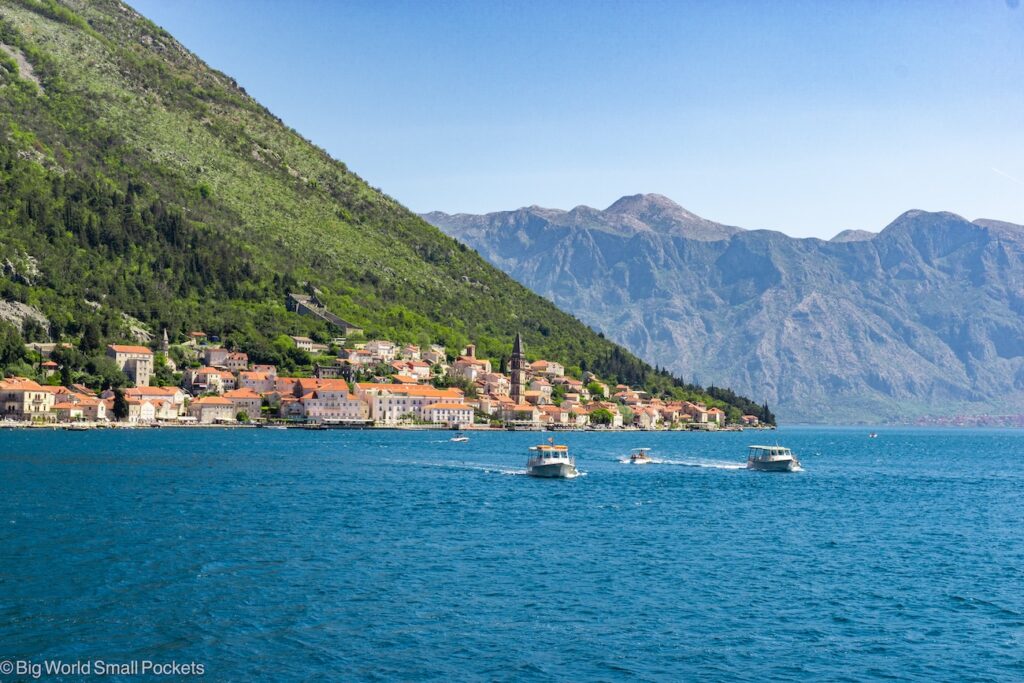
The first thing to think about when planning your trip to Montenegro is of course, where to head for.
Thankfully, as small country of only 600,000 people, Montenegro is pretty easy to get around, meaning that in only a short time you can cover quite a lot of ground here.
Whether you want to base yourself in one location and then day trip from there (which is totally possible), or move around the country, spending a few nights in various destinations, the choice is yours.
To give you some of idea of the best places to visit, I’ve compiled the below list as a shorthand travel guide to Montenegro’s main attractions…
Cultural & Historical Sights to Visit
- Capital Podgorica for museum, galleries & wine tasting
- Former capital Cetinje for UNESCO-listed monuments & street café scenes
Coastal Gems to Discover
- Kotor Old Town for cobbled streets, historic city walls & fortress climbs
- Budva for historic town charm, citadel views and pebbly beaches
- Sveti Stefan for beaches, parks and island views
- Porto Montenegro for marina lunches in luxury surrounds
- Perast for cute coastal village feels and laidback charm
- Our Lady of the Rocks for boat tours and sightseeing ticks
- Herceg Novi for Mount Orjen views, mineral springs, mud spas & wellness
Nature & Outdoor Activities
- Lake Skadar National Park for amazing bird watching, wild orchids & kayaking
- Durmitor National Park for epic hiking via the Black Lake & forest trails
- Tara Canyon for ziplining the deepest ravine in Europe
- Lovćen National Park for flora & mountain views inc 1749m high Black Mountain
How to Travel to Montenegro?
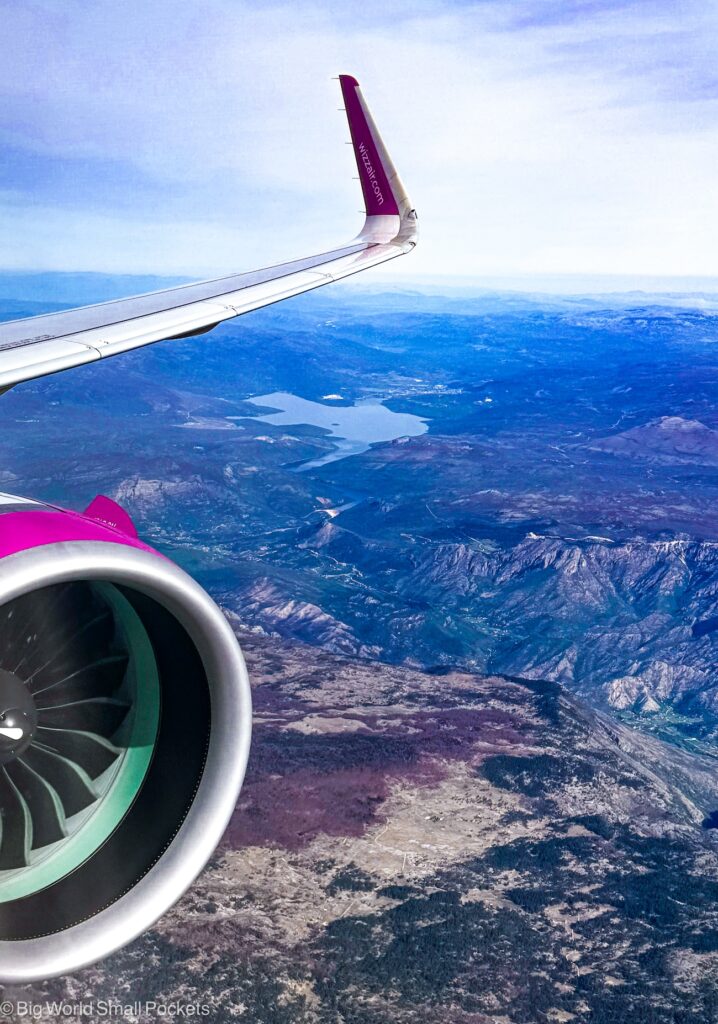
There are numerous way to travel to the increasingly popular destination of Montenegro, so let’s get stuck in…
This country boasts 2 international airports, one in the capital Podgorica and one in the Bay of Kotor at Tivat.
If you only plan to spend time at the coast, it’s probably best to fly direct to Tivat.
With many flights routes from numerous European cities, especially in the summer months, this is a convenient spot to arrive for Budva, Bar and Kotor Old Town.
easyJet fly direct from London to Tivat.
Alternatively, you can also fly direct into Podgorica from many European cities including London.
I flew with Wizz Air from London Gatwick to Podgorica direct in under 3 hours.
Because the flight departed very early in the morning, I treated myself to a Wizz Priority Pass and couldn’t have been happening with the priority check in, luggage allowances, boarding and seat features it afforded me.
As always, I use Skyscanner to get the best flight prices.
You can also travel down the Adriatic coast from Croatia to Montenegro, as well as between Albania and Montenegro very easily.
The quickest towns to transit between are Dubrovnik in Croatia and Herceg Novi in Montenegro.
Even with the border crossing, this journey usually won’t take you more than 2.5hrs (traffic dependent).
I made this crossing on my first trip to Montenegro and found it incredibly easy.
From Herceg Novi you can then continue down to Kotor or Tivat.
Otherwise, if these spots are your final destination, you can also get buses direct to both of them from Dubrovnik and skip Herceg Novi altogether.
Likewise, you can easily travel up from Tirana in Albania to Kotor in a couple of hours.
As always I use Flixbus to book great value coach travel across Europe.
You can also use the train to get to Bar in Montenegro from Belgrade in Serbia.
While not the quickest method, this is a quirky and fun way to travel across part of former Yugoslavia, so definitely one for the experience bucket list!
Learn more here .
Best Time to Visit Montenegro
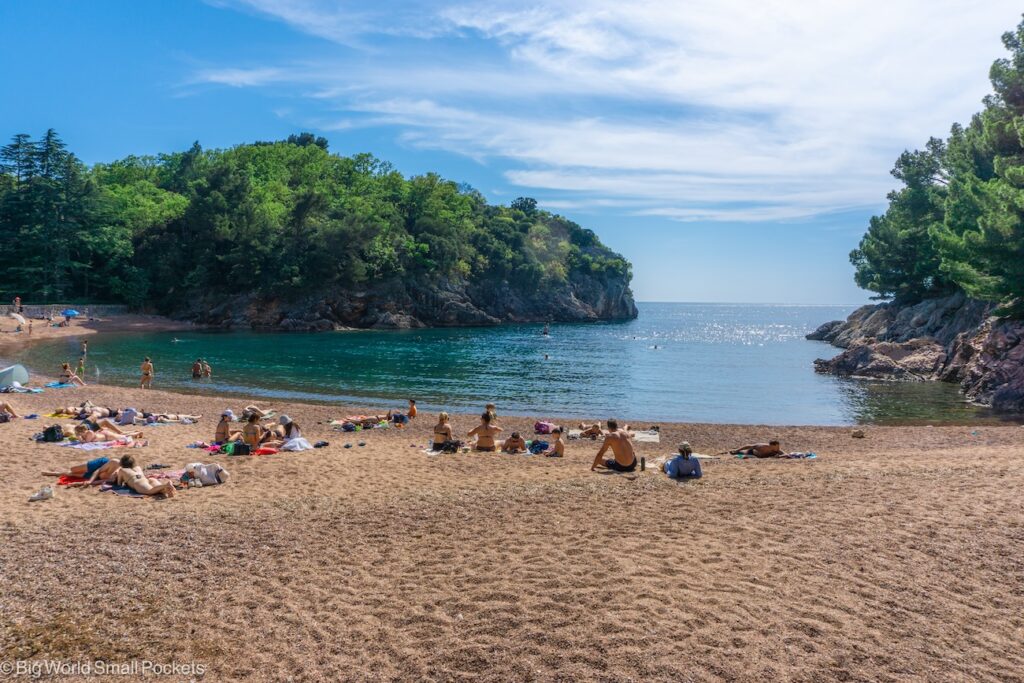
In my opinion, the best time to visit Montenegro is definitely during the warmer seasons of spring, summer and autumn.
Out of these, the shoulder seasons of May and September are the top months to visit.
Between November and March, days are cool and can be wet and windy, so I’d avoid visiting then.
Spring: April – May
My most recent trip to Montenegro was in April – during spring time – and I got amazing weather including 25 degree days and blue sky for an entire week.
The country was very green too and while the sea was a little fresh, taking a quick dip was still possible for the brave!
Hiking in the national parks is ideal in spring thanks to the verdant landscapes and abundance of wildflowers, including wild orchids.
Spring in Montenegro can bring showers and cooler evenings however, so do pack a jumpers and waterproofs, as well as a jacket for the evening if you plan to visit at this time.
Summer: June – August
The summer in Montenegro extends from June through August and while these months usually bring the warmest weather, it’s also the country’s peak season, meaning large crowds and top prices.
The weather can also get really hot everywhere accept the mountains – think 40 degrees Celsius+ – so if you’re not a fan of the heat or busy streets, I’d probably avoid the summer in Montenegro, especially during the school holidays in July and August.
Kotor Old Town especially would be packed during this high season, not least thanks to the cruise ships who dock at the port here almost daily in the summer.
Autumn: September – November
After August, things begin to quiet down again and autumn is a great time to visit Montenegro, especially during September, when the weather is still good, but the crowds have dissipated and accommodation prices lowered.
After the summer, the landscape is unlikely to be as green as during the spring, but the sea temperature will still be warm and fab for swimming.
Autumn is a great time for those who mainly want to visit the coast in Montenegro.
Ideal Montenegro Itinerary: 7 Days
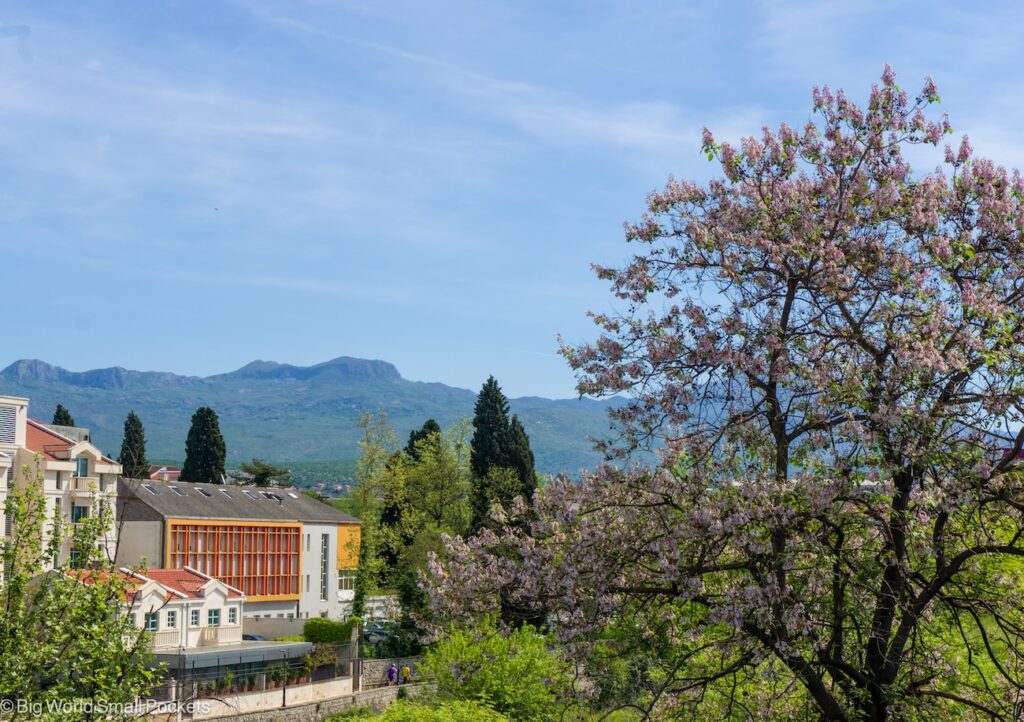
Day 1: Stroll the capital city of Podgorica and then head for wine tasting at Plantaze 13 July
Day 2: Skadar Lake birdwatching and kayaking, followed by people watching in UNESCO World Heritage Site of Cetinje
Day 3: Travel to the coast and relax!
Day 4: Boat trip to Our Lady of the Rock & UNESCO-listed village of Perast
Day 5: Discover historic Kotor Old Town, Kotor Ladder & bouji Porto Montenegro
Day 6: Explore coastal Budva, including its citadel & great little museum
Day 7: Head to Durmitor National Park & Tara River Canyon for hiking and other outdoor adventures
How to Get Around Montenegro?
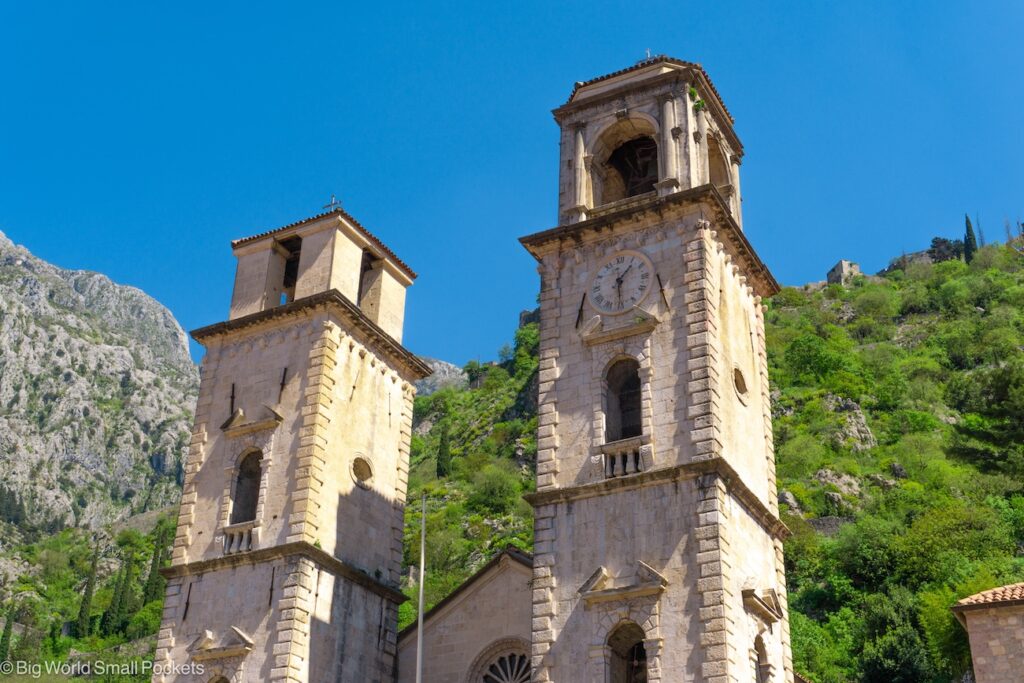
As I mentioned earlier, it’s super easy to get around Montenegro, mostly because it’s a small country.
Generally the road network is easy to navigate and in good condition.
The main issue across Montenegro, especially in the busy summer season however, is traffic.
If you’re heading to the Bay of Kotor especially, be prepared for long queues, as too many cars try to navigate the thin rounds that wind around the bay… you have been warned!
It’s easy to get buses between almost any town in Montenegro as the network is extremely good and most journeys are short.
From Podgorica to Kotor for example it takes just 2 hours by bus and costs under 10€.
I recommend checking timetables and booking bus travel in advance for Montenegro via Bookaway .
Learn more in this post I wrote.
You can also use the excellent Blue Line network to travel around the Bay of Kotor itself.
Stopping anywhere, all you need to do is simply flag down the bus and hop onboard.
Tickets cost a flat 2.5€ and can be purchased from the driver.
This bus runs on a loop once an hour.
Private Transfer
Ideal for more natural destinations, such as the country’s largest lake, Skadar Lake, you may need to take a private transfer to certain parts of Montenegro.
Costs start at around 40€ per hour.
Milos is a great driver that I used when I was in this country.
He’s based in Podgorica and can be contacted via Whatsapp on +382 67 040 808 – just say Steph the blogger sent you!
Day tours are another great way to get around Montenegro, especially for activity trips to spots like Durmitor National Park and the famous Tara River Canyon.
Usually you have the choice of either a group tour or a private option.
Running regularly from the coastal region in particular, check out these top picks , which include transport and attractions to many of Montengro’s fav spots including its national parks.
Driving in Montenegro is pretty straightforward.
Highways are in good condition and locals don’t drive too fast from what I’ve seen!
The toughest challenge is navigating the tiny roads around the Bay of Kotor – you’ll need to good spatial awareness to judge these thin, 2 way streets!
As always, I use Discover Cars to find the best deals for car rental.
You can use the twice daily train to travel from Podgorica to Bar on the coast.
This isn’t a quick journey – it’s more one for the experience and quirky bragging rights!
Where to Stay in Montenegro?
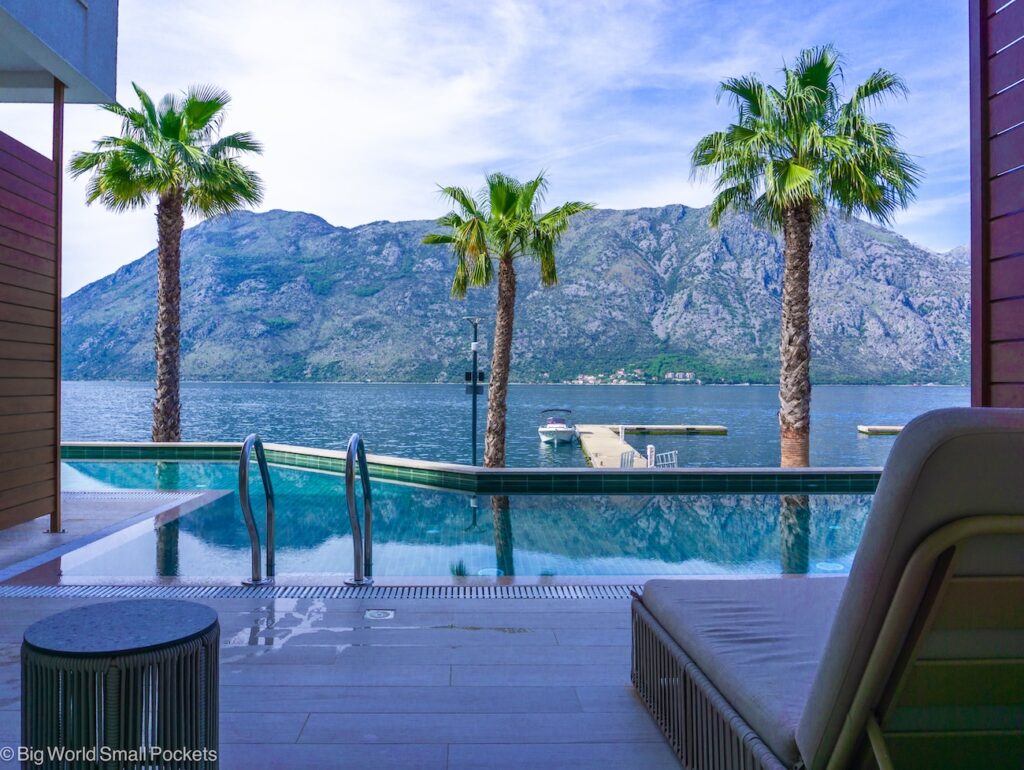
Montenegro accommodation caters to a huge range of budgets – from backpacker hostels, to apartment rentals, guest houses and even 5* hotels, it’s all on offer across the country.
At the Coast
Personally, if you’re looking for a luxury stay for less, then it’s hard to get better then the Hyatt Regency Kotor Bay Resort .
Located in a stunning part of the country’s UNECO World Heritage Site coastline, this fabulous hotel offers king rooms with mountain balconies from just £85pn including breakfast.
With 7 eateries and bars on site, along with panoramic views across the bay, a cute beach and a wellness spa, it’s the all-round package.
I was lucky enough to stay in one of the sea view villas here, which came complete with a private pool and roof terrace.
Trust me, if you’re keen on seeing some stunning sunsets in Montenegro, then this is definitely worth the splurge!
In Podgorica
In the capital, or for nearby destinations such as Skadar Lake and Cetinje, then the Ramada Podgorica comes highly recommended as a good place to stay.
In a fab central location, from where you can easily walk to downtown Podgorica, this modern hotel has a great café / bar outside the lobby that is always thriving with locals – a great vibe!
Breakfasts can be enjoyed alfresco on the roof terrace and there’s a gym for those of you who are feeling smug!
Staying Connected: Holafly eSIM for Montenegro
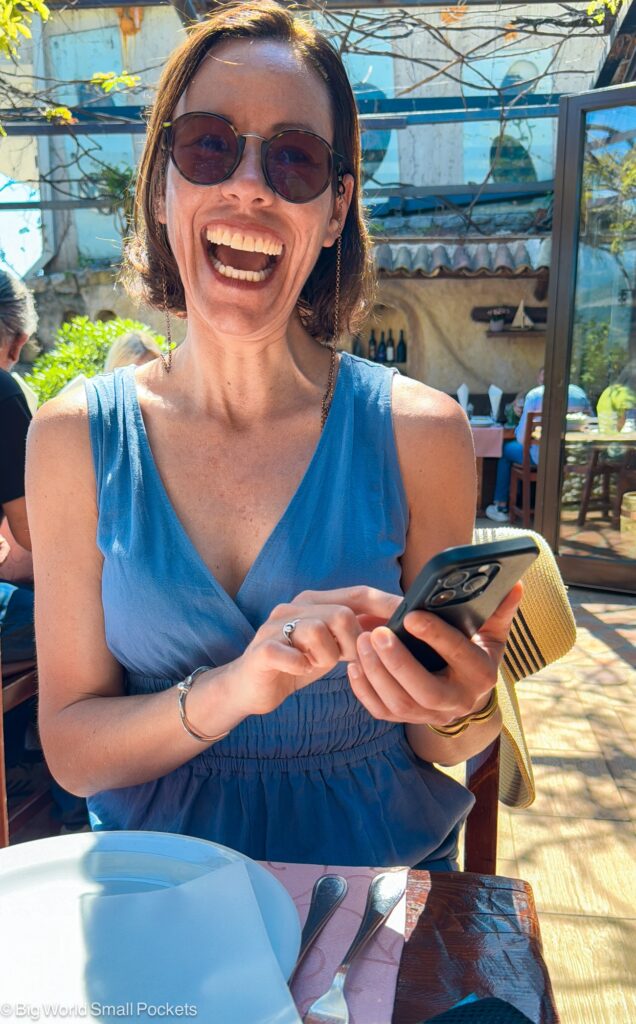
Of course you also need to think about staying connected when travelling in Montenegro, after all, booking transport, day tours, activities and accommodation is a lot easier when you have a mobile phone connection.
And that’s without mentioning the ability to send photos home to make your friends jealous!
But jokes aside, staying connected while you are away is also a safety measure – trust me, as a solo female traveller I know.
While Montenegro might be a very safe country, it’s still wise to take precautions as accidents do happen.
As such, this Montenegro travel guide wouldn’t be doing its job if I didn’t talk about how to stay well connected in Montenegro.
Personally, I loved my Holafly eSIM for Montenegro , which I purchased and installed before I set off on my latest trip to the country.
Then, once I touched down, all I had to do was simply activate the eSIM and I was instantly connected – allowing family and friends to know I had arrived safely.
Last time I visited Montenegro, I remember having to either battle high roaming fees to use my phone, or else go through the tedious and laborious hassle of trying to find a local SIM card provider that offered a product for tourists with lots of data.
Filled with potential pitfalls, I remember spending huge amounts of time and money not only trying to find a local SIM with enough data I could use, but also then trying to get it to work!
With Holafly eSIMs, all this hassle, stress and time is totally avoided as you can purchase the exact product you need for your next trip (based on where you’re travelling and how long for) before you go away.
Plus, you then arrive safe in the knowledge you’re connected from the word go.
No more need to get the wifi password at every café or hotel you visit, and then have to worry about security and VPNs, using Holafly eSIMs is the ideal way to stay connected without high roaming costs or wasting precious holiday time finding a local SIM card.
This is especially true if you don’t speak the local lingo, because I hasten a guess that not many of us are well-versed in the Montenegrin language!
Holafly Montenegro eSIM: How it Works + Features
To put it simply, Holafly eSIMs are digital products you can easily buy online and then seamlessly connect to your phone.
There’s no need to pick up a physical SIM card, or swap your current one out, as Holafly eSIMs instantly connect you digitally to local phone networks.
The first step is to head to the Holafly website, or download their easy to use app, and select your travel destination from their shop.
Holafly eSIMs for Montenegro start from just 27€ for 5 days and you can get 5% off using this link .
Choose the number of days and number of eSIMs you want to purchase (1 should do it for solo travellers!) and then select the currency you want to pay in.
Installing Your Holafly eSIM
After purchasing, your Holafly eSIM is then easy to install and configure.
The best way to do this is through their automatic installation code, which is available for users with iOS 17.4 or later.
This option simplifies the process, meaning less faff for you!
All you have to do to access automatic installation is download the Holafly app, head to the ‘My eSIM’ tab and follow the instructions.
If you aren’t an iOS user, or you prefer an alternative method, you can also easily install your eSIM via QR code, which will sent to you immediately after your eSIM purchase.
Or you can opt for manual installation, which uses 2 simple codes.
Once installed, you’ll be able to activate your Holafly eSIM as soon as you arrive in Montenegro.
Do this by enabling the eSIM line in your mobile service settings and switching on roaming.
Advantages of an Holafly eSIM
All Holafly policies also offer unlimited data, (which personally, is like music to my ears!), as well as fast and reliable connections, with high speed 4G and 5G connectivity.
Holafly eSIMs also allow you to keep your usual Whatsapp number, so you can easily stay in contact with friends and family at home.
There’s also 24/7 customer support in English, as well as a heap of other languages, so you can contact them anytime if you’re having issues.
Disadvantages of an Holafly eSIM
Unfortunately Holafly eSIMs are not compatible with every mobile device, so do check your device meets the requirements (via the Holafly website or app) before purchasing.
You may also find the price of an Holafly eSIM may be higher than other carriers.
However the advantages of unlimited data (and the hassle of not having to top or change your Whatsapp number) outweighed this price discrepancy for me.
Additional Tips for Travelling Montenegro
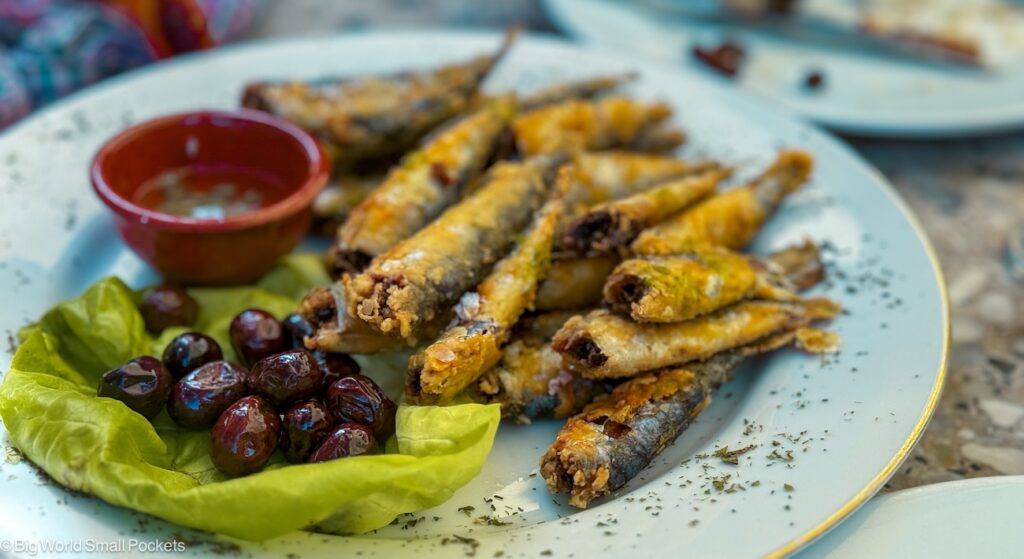
So now that I’ve covered connectivity, it’s probably also worth taking some time to cover other key practical points in this Montenegro travel guide.
I found Montenegro very safe, even as a solo female traveller and would definitely recommend travelling there alone.
Just remember the usual precautions of not going out late at night alone, not drinking too much alcohol, not telling strangers where you are staying and making sure you are covered by travel insurance .
Currency & Costs
Generally, Montenegro is a very cheap country to travel in and, as I mentioned in the introduction, provides a great budget alternative to both Greece and Croatia, which both offer similar experiences and landscapes, but for a much higher price tag!
As a budget traveller, you could expect to spend as little as 40€ a day in Montenegro, if you stay in hostels, take buses around the country, enjoy some activities and eat in local cafes or use supermarkets.
At the other end of the spectrum, 4* or 5* hotel stays, meals in fancy restaurants and plus private transfers and tours could set you back as much as 300€ a day in this country.
Whichever end of the budget spectrum you’re at, it pays to remember to take a bank card away with you that doesn’t charge for ATM withdrawals or foreign transactions, but does offer good exchange rates.
I highly recommend Wise , which I use on all my travels, including paying for things in Montenegro, which has the Euros as its official currency.
Carrying a little bit of cash with you is also a good idea, as some small shops, stall and services in Montenegro don’t always accept card.
Food & Wine
Montenegro is a foodie haven, especially for seafood lovers.
Thanks to its long coastline, baby squid, tuna, octopus, smoked trout and sea bass all proliferate on the menu.
Other must try traditional dishes include Kačamak, Popeci, Japraci, Pršuta and, for the vegetarians among us, the local smoked cheese, local tomato soup and local olives are amazing!
There also tends to be quite a lot of Italian cuisine in Montenegro, thanks to the influence of the Venetian empire back in the day, so expect good risotto and pasta dishes to appear on most menus too.
For local restaurants recommendations try Lanterna Restaurant in Podgorcia and Restaurant Porto in Budva, which does an amazing set menu – with a meat, fish and vegetarian option.
Just enter your details below and I'll email it you - simple!
Information will be sent to the email provided above
Montenegro Travel Guide: FAQs
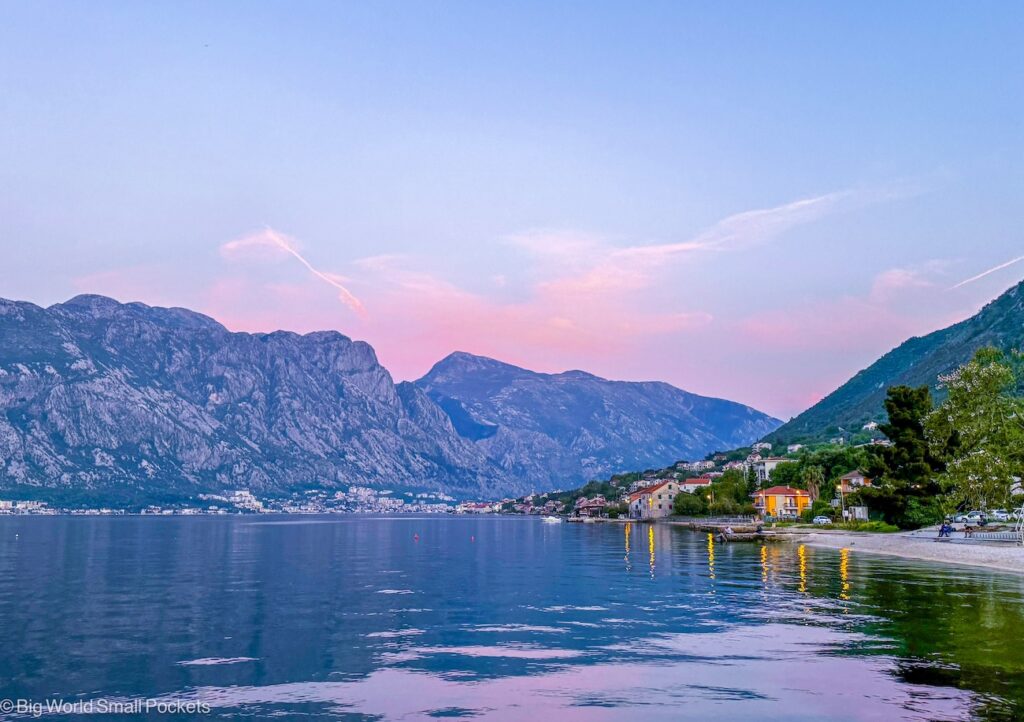
Where is Montenegro?
Montenegro is located on the Balkan Peninsula of southern Europe, along the Adriatic Sea.
Is Montenegro Expensive?
No, Montenegro is a very cheap country to visit in Europe – ideal for backpackers, budget travellers, as well as those looking for a slice of luxury for less.
Is Montenegro a Good Holiday Destination?
Sea, sun, beaches, history, boat tours, beautiful national parks, amazing views, top food and wine… what’s not to love?!
Does Montenegro Support eSIM?
Yes and I recommend an Holafly eSIM when travelling there.
I had a great and fast connection throughout the country.
Is Holafly Worth It?
Thanks to unlimited data and fast reliable connections, Holafly eSIMs offer peace of mind when travelling in Montenegro – just what you need for a relaxing holiday!
PIN IT TO PINTEREST!
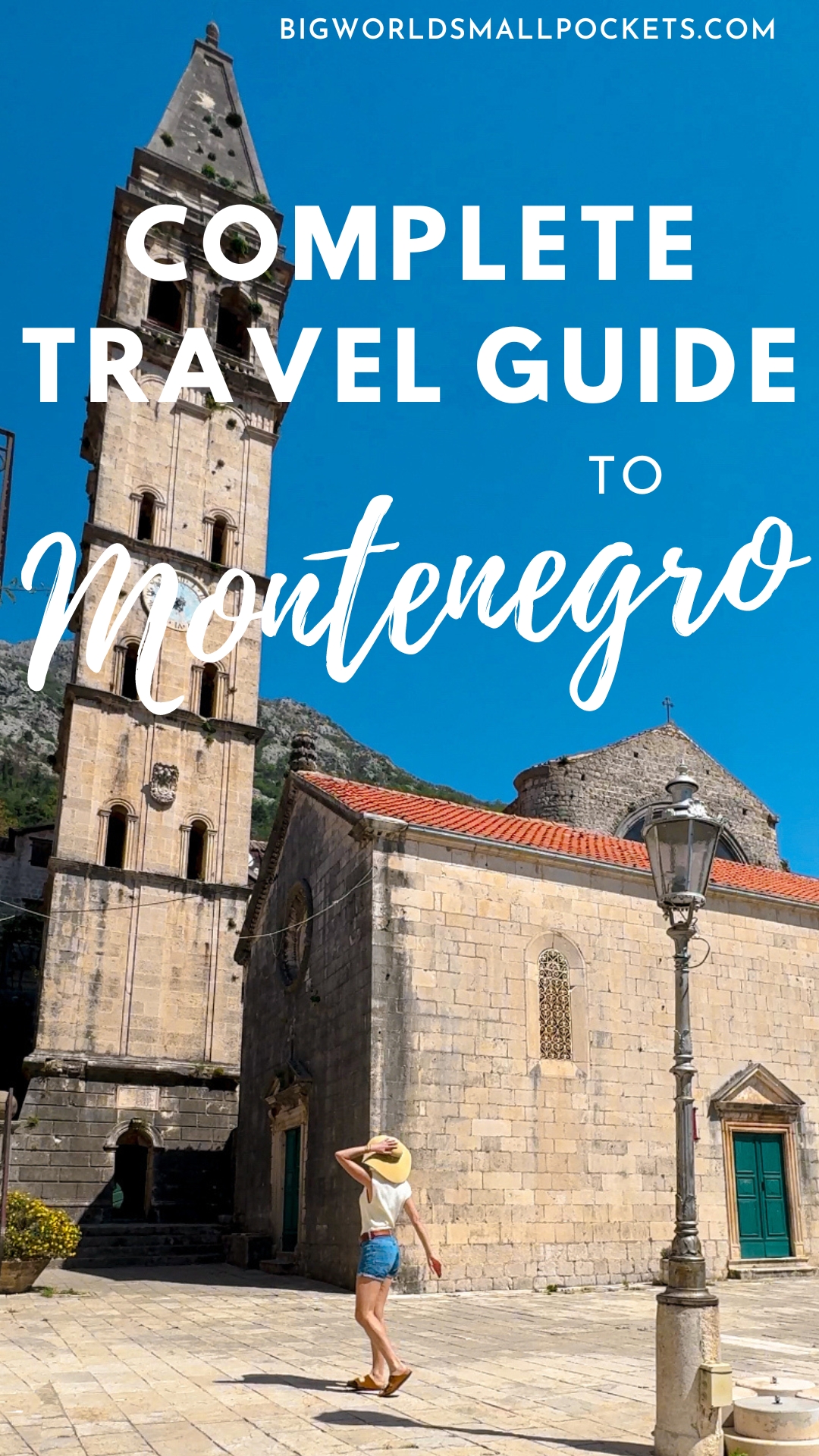
And there you have it, my complete travel guide to Montenegro.
I hope I’ve convinced you to give this amazing country a try on your next trip, but if you still have any questions or queries about adventuring here, don’t hesitate to drop them into the comments box below and I’ll get straight back to you…
This review was kindly sponsored by Holafly but, as always, all views are my own.
This page contains affiliate links meaning Big World Small Pockets may receive a small commission on any purchases at no extra cost to you.
Creator of Big World Small Pockets, Stephanie Parker is a travel addict! Originally from Jersey in the Channel Islands, Stephanie adventures the world collecting tips, advice and stories, to share with a smile
Leave a Reply Cancel reply
Your email address will not be published. Required fields are marked *
This site uses Akismet to reduce spam. Learn how your comment data is processed .
Fall in love with the Beauty of Montenegro
Latest articles.

Montenegrins: The Giants of Europe – Are They the World’s Tallest?

Montenegro’s Digital Revolution: From .yu to .me
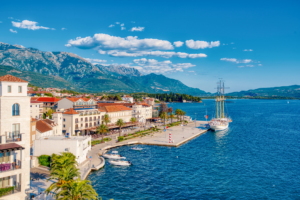
Top 5 Free Things to Do in Tivat
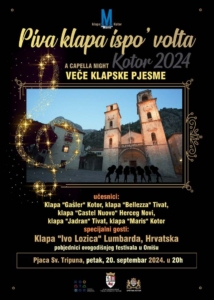
Kotor: Evening of Klapa Songs in Front of the Cathedral
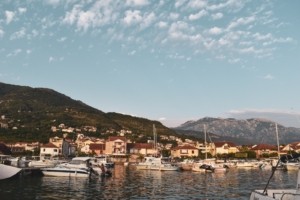
A Guide for Best Shopping in Tivat
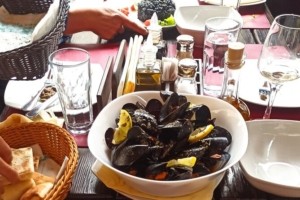
Best Tours in Montenegro for Foodies
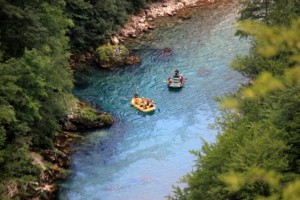
Explore the Best of Montenegro: Top 8 Tours You Must Experience!
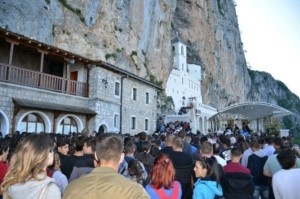
Top Ten Monasteries and Churches to Visit in Montenegro
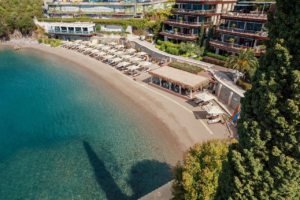
Beach Club Paradise: Discover Coastal Gems
Discover new horizons.
Discover the best of Montenegro. Get insider tips, practical advice, and firsthand experiences for your perfect trip
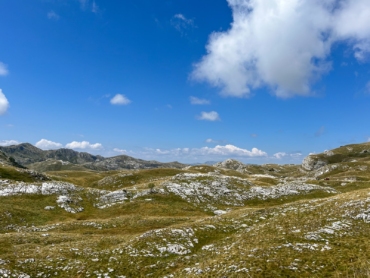
The Amazing Durmitor National Park

Your No 1 Guide to Perast

The Gorgeous Sveti Stefan
The Ostrog Monastery

The Statue Ballerina in Budva, Montenegro

The top movie locations in Montenegro

Tara River Canyon
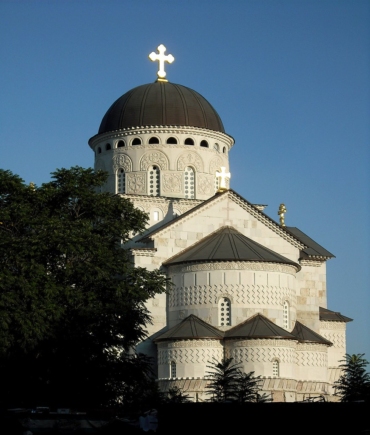
The Cathedral of the Resurrection of Christ
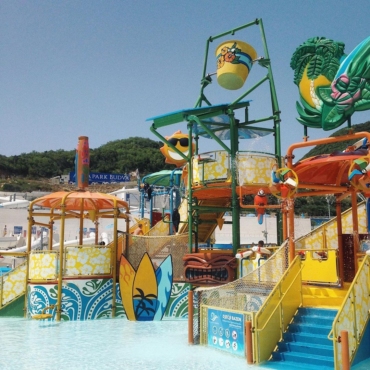
Aquapark Budva: A Family-Friendly Water Adventure
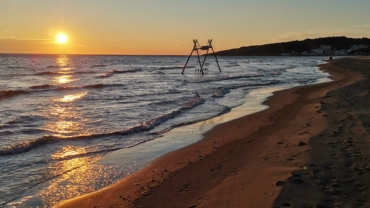
Ladies Beach in Ulcinj: Montenegro’s Healing Sanctuary

Milocer Beach: A Hidden Haven Awaits Your Discovery!
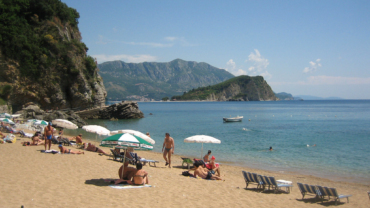
Does Montenegro have sandy beaches?

Beer Fest Cetinje
Drobni Pijesak Beach in Montenegro
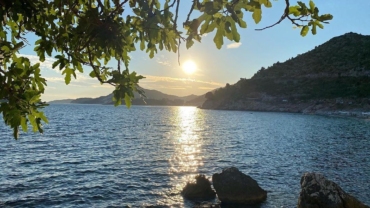
Kamenovo Beach: Our favourite hidden spot
Montenegro Travel Guide
Adventurous Kate contains affiliate links. If you make a purchase through these links, I will earn a commission at no extra cost to you. Thanks!
If you’re curious about Montenegro travel, you’ve come to the right place. I love teaching people about traveling in the Balkans, one of my favorite regions in the world, and especially telling people what it’s like to travel to Montenegro!
I loved Montenegro from the moment I first visited in 2012. How could this tiny country be so incredibly stunning? So many rugged mountains and clear teal lakes, so many fun adventure activities and picture-perfect old towns.
And from that first trip, I’ve kept coming back to Montenegro — for music festivals and mountain climbing, birthday celebrations and rafting trips, monastery-hopping and swimming in the Bay of Kotor.
This may be a small country — but it has so much to offer.
Here are things you need to know about Montenegro travel. (And don’t forget to check out my guide to the best things to do in Montenegro , too!)
Table of Contents
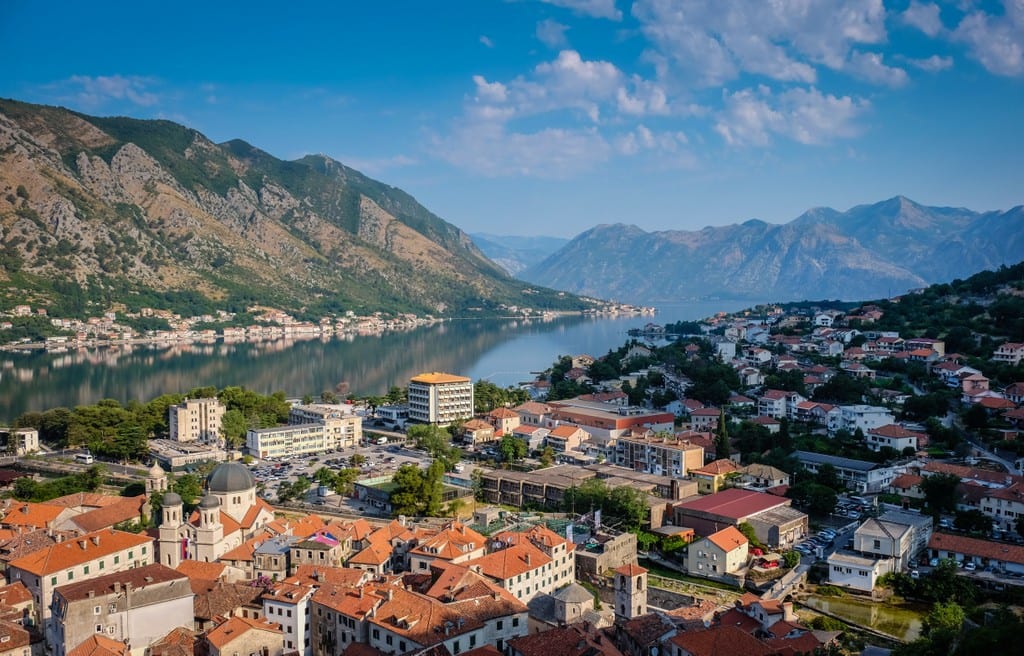
Montenegro is one of the most beautiful countries in the world.
I have frequently called Montenegro the most beautiful country in the world — or the most beautiful country in Europe. That’s high praise — and I don’t give it out lightly. (And yes, I’ve been to Iceland, Norway, Switzerland, you name it.)
While Croatia’s Adriatic coastline might get all the hype, Montenegro’s coastline has quite a bit of beauty as well. The Bay of Kotor is nothing short of spellbinding, with lush green mountains crashing down into clear teal water.
But that’s just the bay (which also happens to be the southernmost fjord in Europe). There are also the mountains. Once you head further inland, Montenegro is filled with stunning gray mountains interspersed with little tufts of greenery.
In fact, Montenegro’s name (Crna Gora) means Black Mountain, and was named for the dense evergreen forests on Mount Lovcen.
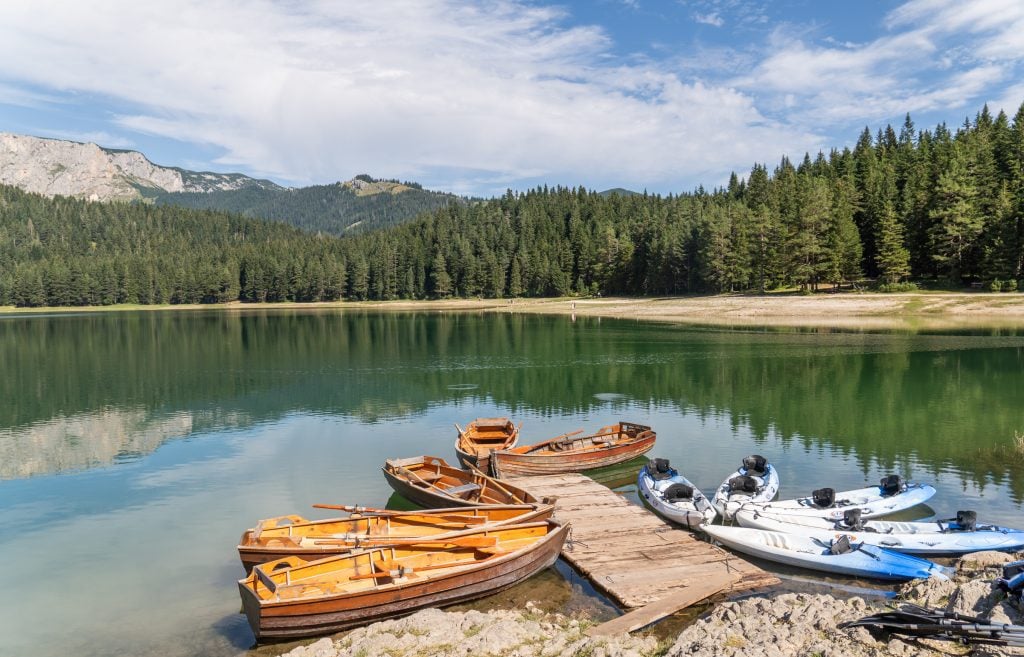
Where to go in Montenegro
Not super familiar with Montenegro? Check out my list of 30 best things to do in Montenegro . Here are some of the best places to visit in the country:
Bay of Kotor: This spectacularly gorgeous bay is the most touristed part of the country. Many, many day-trippers come over from Dubrovnik, and plenty more travelers just pop into Kotor and pop out a few days later. Cruise ship travelers base in Kotor as well.
Kotor is the most famous town to visit in the region and makes a good base for exploring both Kotor Bay and Montenegro as a whole. A tiny town close to Kotor is Perast , and gets a lot of day-trippers but also makes a good base for a few days. Herceg Novi is a big resort town close to the Croatian border; Tivat is home to the region’s international airport and gets a lot of moneyed yacht visitors.
A bit more inland but close to the bay, you have Lovćen National Park and the old royal capital of Cetinje , both worth a visit.
Budva Riviera: Budva is a major beach town in Montenegrin coast that has been drawing huge crowds of tourists for decades (and attracts lots of Russians in particular). This part of the country is home to high quality beaches . Some towns to visit beyond Budva itself include Sveti Stefan and Petrovac .
Northern Montenegro: This part of Montenegro is mountainous and rural, and is home to national parks including UNESCO World Heritage-listed Durmitor National Park , home to Black Lake and Tara River Canyon rafting, and, further east, beautiful and underrated Biogradska Gora National Park .
Central Montenegro: Central Montenegro is one of the lesser-visited parts of the country, but there are some cool places to visit here, like Ostrog Monastery , set into a rocky cliff.
Southern Montenegro: If Montenegro is shaped like a diamond, the bottom quadrant is home to quite a few various sites.
Here you have the scruffy yet popular beach towns of Bar and Ulcinj , which are a bit scruffier than the Budva Riviera and draw a more local Montenegrin and Albanian crowd. The current Montenegrin capital of Podgorica doesn’t have much to see, but nearby Stari Bar is a bit of a ghost town with ruins that were wrecked in the 1979 earthquake.
Skadar Lake National Park is home to the largest lake in the Balkans and is a very interesting place to spend an afternoon.
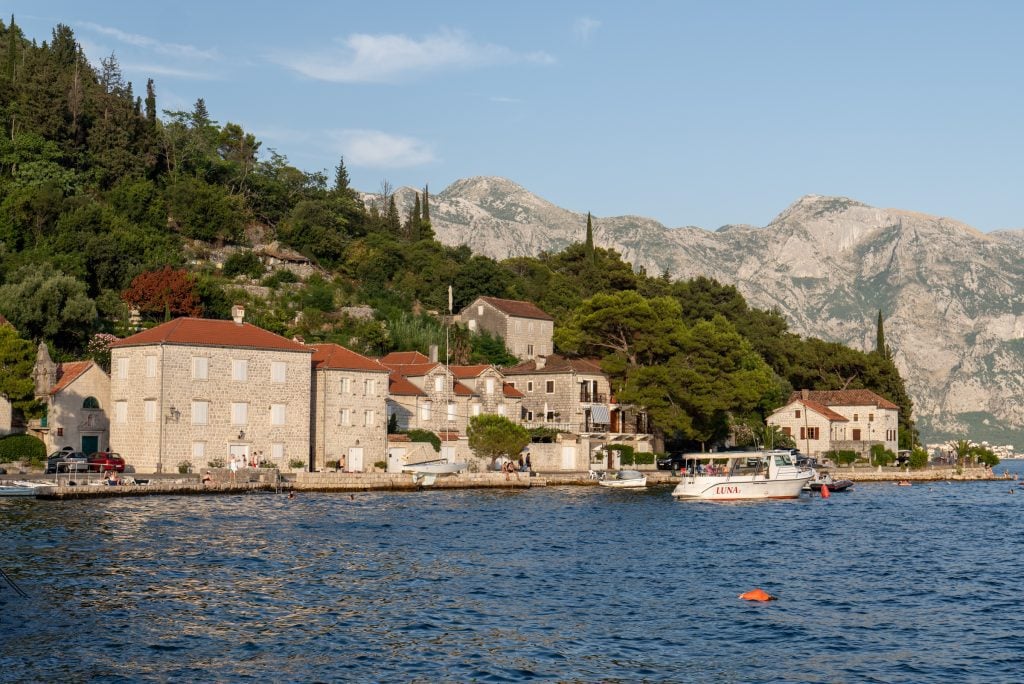
Is Montenegro the new Croatia? Not really.
Everyone loves to declare places the “new” something. Riga is the new Prague! Medellín is the new Chiang Mai! Mahahual is the new Playa del Carmen! And plenty of people have been calling Montenegro the new Croatia for years. (And, in turn, Albania the new Montenegro.)
Is that true? I don’t really think so. While Montenegro might have similar dramatic coastline, along with rocky but not sandy beaches, Montenegro is light years away from Croatia in terms of infrastructure for travelers.
What does that mean? There are no ride-sharing apps that work in the country, buses won’t honor internet-purchased tickets unless you print them out, the highways have a single lane in each direction and get backed up, and while there are some nice hotels here, most accommodation tends to be at a more basic level. Many tourism businesses don’t have much of an online presence, either, beyond a WhatsApp number to call.
I’m not saying this to insult Montenegro — far from that! I love it here. Just know before you come that travel here is a lot more basic — especially if you’re used to traveling in Western Europe.
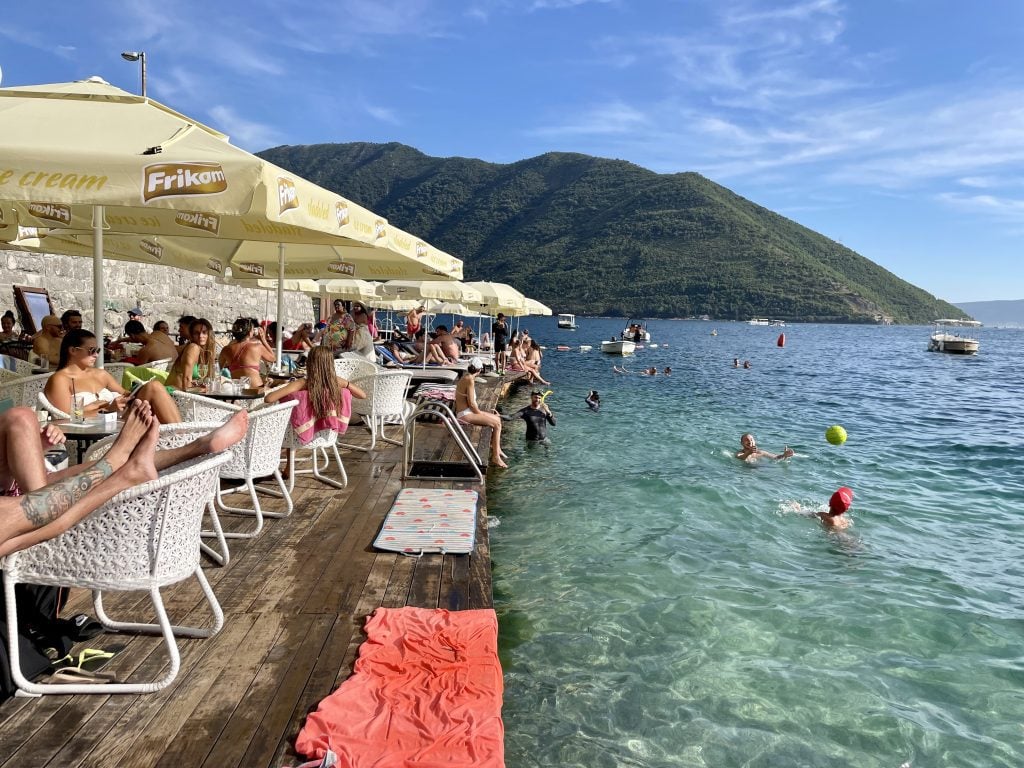
When’s the best time to visit Montenegro?
To me, Montenegro is a quintessential summer destination. Between swimming in the Adriatic Sea, hiking through the mountains, and hopping through the gorgeous towns, Montenegro is like drinking in sunshine. That’s why I wanted to return for my recent birthday in August.
Montenegro has a Mediterranean climate, though much of the weather depends on the elevation. The coastal regions tend to be much warmer and rainier than the inland mountain regions, which are cooler and get a good amount of snow in the winter months.
July and August are peak season in Montenegro; June through September is high season. However, I don’t recommend visiting during July or August if you don’t have to. I most recently visited in August and the traffic along the coastline was NUTS. Cruise ships were NONSTOP. The towns were PACKED. Taxis were charging INSANE prices (more on that below).
If you enjoy summer weather, I recommend visiting Montenegro from early to mid-June or mid-September to early October. It will still be summery and gorgeous — just a lot more peaceful of an experience!
What about shoulder season? Absolutely! If you don’t care about swimming in the sea or sunning yourself, spring and fall can be great times of year to travel in Montenegro. Shoulder season is especially good for hiking and outdoor adventure.
Winter will be very quiet, with many businesses on the coastline closed — but it’s a great time for skiing in the mountains. Skiing in Montenegro is absolutely a thing (look to the Dinaric Alps), and it will cost you a fraction of what you’d pay in the Swiss or Italian Alps.
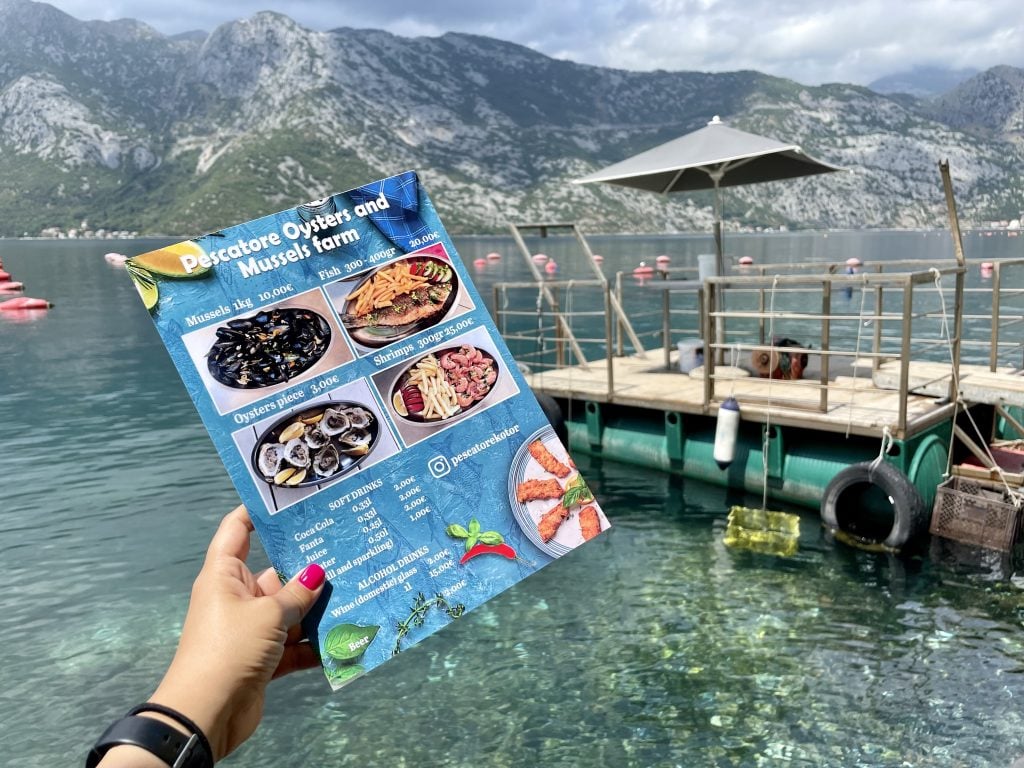
Is Montenegro expensive or cheap? Yes.
For decades, guidebook authors have been encouraging Europe travelers on a budget to head east. You’ll get far more for your money in Budapest than Paris!
The reality of that today? KIND of true, but not always. (After all I live in Prague, once a famously cheap European getaway, but now I often spend less in Italy than I do in Prague. Italy!!)
The Western Balkans — consisting of the former Yugoslavia and Albania — often get you quite a bit for your money. North Macedonia, Serbia, Bosnia, Kosovo, and Albania are very budget-friendly destinations, while Slovenia has grown more expensive and much of Croatia has become significantly more expensive, especially Dubrovnik.
So how expensive is Montenegro? It depends on where you go.
Kotor and Perast? Very expensive. These popular hotspots on the Bay of Kotor get a lot of tourism, and thus prices are driven far up. Budva and its southern beaches are only a bit cheaper than Kotor and Perast, though there are some deals to be had.
Southern beach destinations in Montenegro like Ulcinj and Bar that draw local visitors are a bit shabbier and a good amount cheaper than the beaches further north.
But once you head deep into inland Montenegro — think Durmitor National Park and Biogradska Gorda — prices drop significantly and are more on par with Serbian prices. Even heading slightly inland from the coast can make a big difference in prices.
It’s the same as anywhere else in the world: cities, coastal destinations, and tourist hotspots tend to be most expensive. Rural, inland, less popular destinations tend to be cheaper.
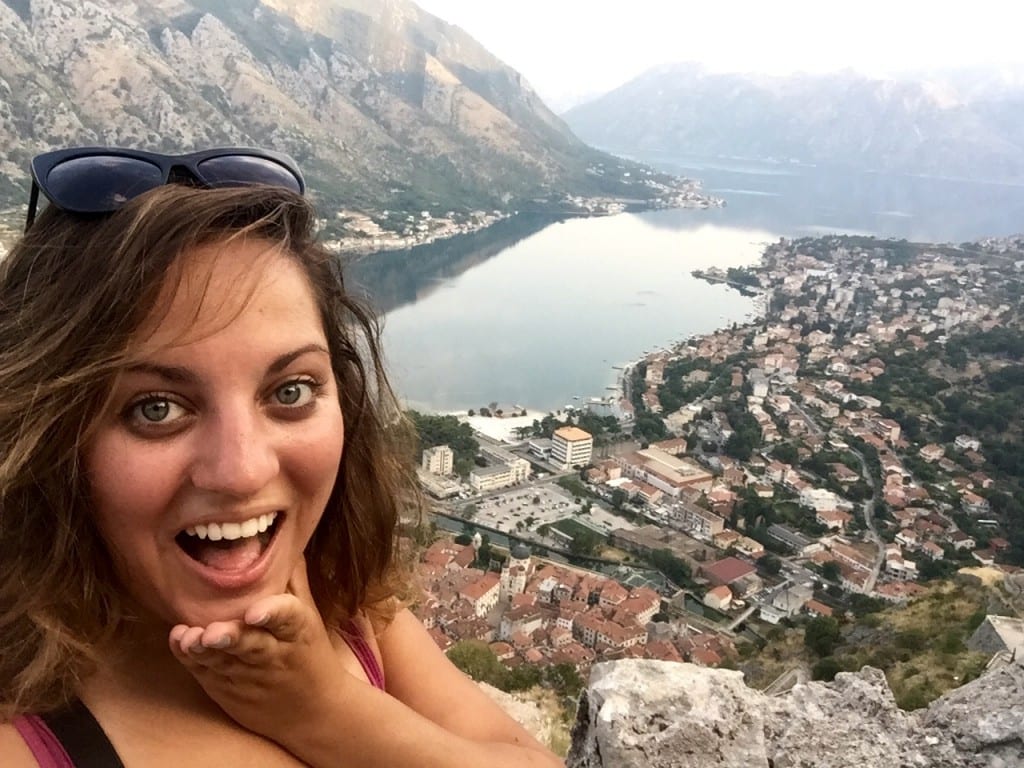
Is Montenegro safe?
Montenegro is as safe as most destinations in Europe — which means it may be safer than your hometown. Do what you would do in any other destination — keep your valuables on you in transit, don’t drink too much, stay aware of your surroundings, keep in touch with someone at home.
I’ve traveled in Montenegro as a solo female traveler and I felt very safe the whole time. I’d travel solo in Montenegro anytime. (Have you seen my top 10 travel safety tips for women ? Definitely check them out if you haven’t yet.)
Are there any Montenegro-specific safety precautions to take? A few.
Be cautious of petty theft. Pickpocketing can happen in busy towns like Kotor and Budva, especially in their dark, twisty old towns. Keep your belongings in a zip-up crossbody purse, don’t take more money and cards than you need for the day, and lock up the rest in your room in a portable safe.
Be careful on the roads. Roads in Montenegro tend to be narrow and winding, especially once you get deeper inland. Many of these switchback-filled roads that are safe, but you need to go much more slowly than usual. Be careful where you stop to take pictures, too. There are rarely guardrails at scenic overlooks. Allot extra time for your drive so you don’t have to speed.
Practice safety when hiking. Talk with a local before you head out on a hike, check the weather, make sure it’s currently safe and passable, and let your hotel know where you’re going and when you should be back. Be cautious of snowstorms in the mountains from fall through spring.
Don’t go drink for drink with Montenegrins, especially if rakija is involved. Like Serbians, Montenegrins LOVE to share rakija with visitors and will offer it often, especially if you’re a man (my husband even got offered rakija at BREAKFAST once!). You do not have anywhere close to their rakija tolerance — I recommend trying one shot, max, only if you’re not driving, or politely turning them down.
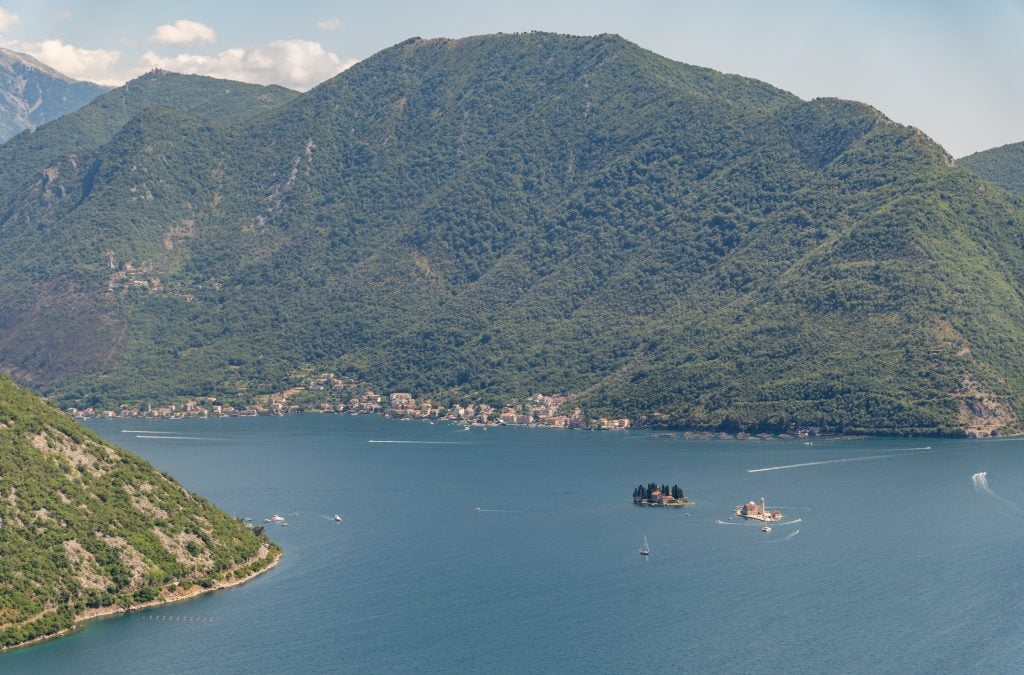
How to get to Montenegro
There are two international airports in Montenegro: Tivat, which is on the Bay of Kotor; and Podgorica, the capital. If you’re flying directly in, you’ll want to aim for one of those two airports. Neither airport is super well-connected, especially outside the summer months, but you can find your way via some larger cities.
Some people like to fly to Dubrovnik and head to Montenegro from there. I’ve done that before myself. The border is a bit of a pain, but it might fit into your trip better, especially if you’re adding on time in Croatia.
Alternatively, you can get to the city of Bar, Montenegro, two different ways: there is a Montenegro Lines ferry from Bari, Italy , as well as a train from Belgrade, Serbia.
Otherwise, you’ll be arriving overland by car or bus. For this reason, travelers often pair Montenegro with another country or two (I always have!). You can easily add Montenegro to a southern Croatia itinerary , or add Montenegro to a longer trip through Serbia, Bosnia, or Albania.
(Just let your rental car company know if you plan on crossing borders.)
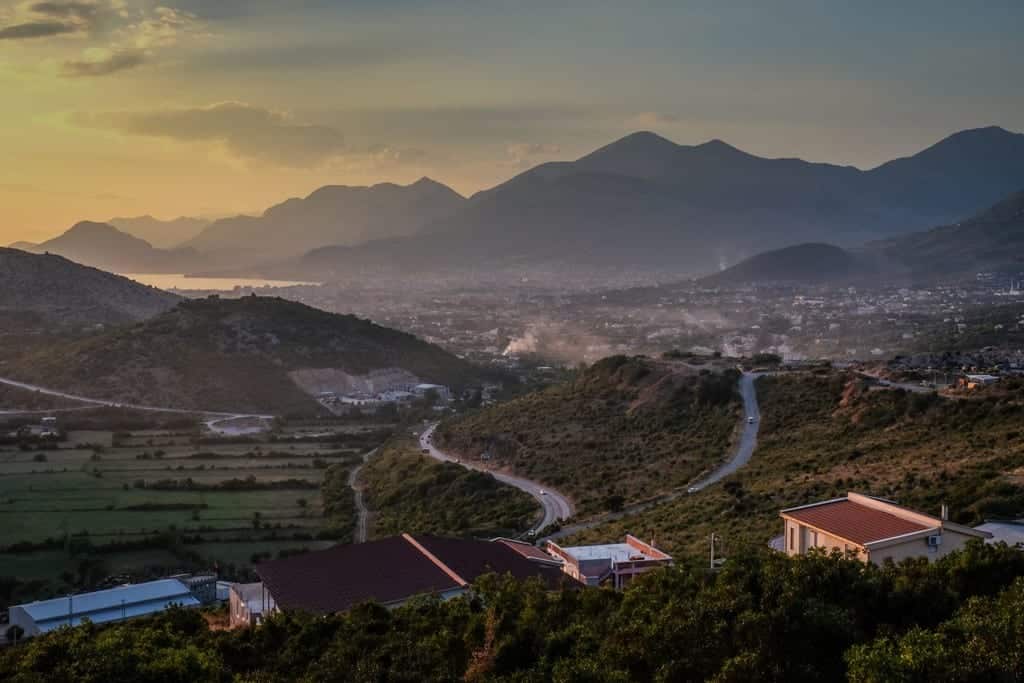
Montenegro is not in the Schengen Zone.
Like many of the Balkan countries, Montenegro is not part of the Schengen Zone. The Schengen Area is a group of 27 nations in Europe that have open borders.
Long-term travelers and digital nomads in Europe can only be in the Schengen Zone 90 days within a 180-day period. As a result, lots of these people are looking for nice non-Schengen areas to spend their time until they can return to the Schengen Zone.
So yes! Montenegro is not Schengen, so it makes a nice place to visit if you need to leave the area for awhile.
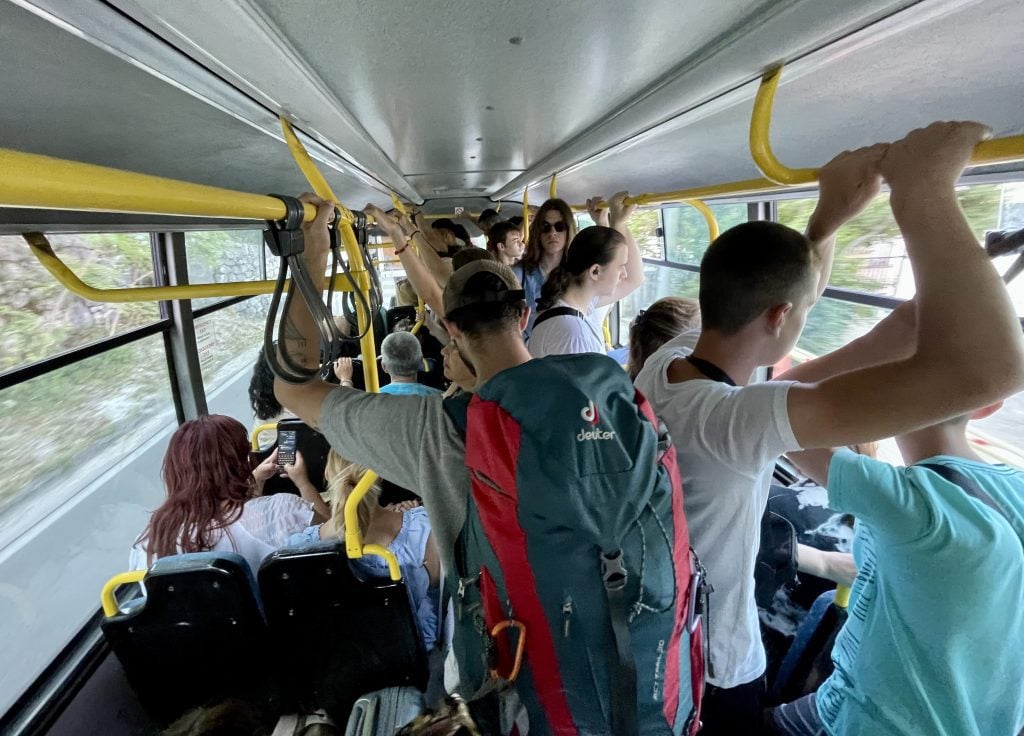
Can you do public transportation in Montenegro? Yes, but it’s a pain.
Montenegro travel can be done either with or without a car. I’ve done two Montenegro trips without a car and one with a car and honestly, having a car makes travel in Montenegro so much easier.
If you just want to do a quick Bay of Kotor trip, or maybe Kotor and a day trip to Durmitor, you can get away without a car. If you want to travel Montenegro comprehensively, you will absolutely need a car.
So what kind of public transport is there in Montenegro?
Bus: Buses are the main way to get around Montenegro, including points beyond the country’s borders. You can buy tickets at bus stations in cities that have them.
The Blue Line bus travels along the Bay of Kotor, from Herceg Novi to Kotor, stopping at most towns along the way, though know that buses can be late and packed to the gills.
Important note: you MUST have tickets printed out if you buy them in advance. Having them on your phone screen won’t work. I bought tickets through BusTicket4Me , a Montenegrin company, and they wouldn’t let me on because it wasn’t printed out!! If you don’t have a printer, you can have the bus station print them out for you, but it might be a long wraparound line, as it was the day I did it.
Train: Surprise, there’s a train in Montenegro — and it’s actually a gorgeous journey! There is a train that runs between Bar and Belgrade, Serbia, stopping at Podgorica and Bijelo Pole en route. This can be an all-day or overnight journey (13 hours by day, 9 hours overnight).
Ferry: If you want to skip the long drive around Boka Bay (on the Bay of Kotor), there is a short ferry between Kamenari and Lepetane. Ferries run constantly as they fill, take 10 minutes, and cost 4.50 EUR ($5 USD).
Internationally, there is a ferry that runs between Bar and Bari, Italy, on Montenegro Lines. The journey takes nine hours.
Tourist shuttles: Montenegro Hostel offers tourist shuttles (good-quality buses and vans that take you direct from hotspot to hotspot so you don’t have to change buses several times). I took their shuttle from Tirana to Budva once and it was a lovely, comfortable, air-conditioned experience. You can take them from destinations in Montenegro to Dubrovnik, Croatia; Mostar, Bosnia; and Tirana, Albania.
Hop-On, Hop-Off Bus: There is now a hop-on-hop-off bus in Montenegro running along the Bay of Kotor between Risan and Kotor. At 25 EUR ($27 USD) for 24 hours, I think it’s a deal if you are traveling solo and would be taking taxis otherwise. Honestly, I would LOVE it if it continued to Budva or even Sveti Stefan or Petrovac. Hope they expand it in the future.
Taxis: Frustratingly, Montenegro doesn’t have Uber or any ride-sharing or ride-hailing apps. Taxis can and will charge high fees, especially on the Bay of Kotor. In 2023 I was quoted 50 EUR ($53 USD) for a 30-minute one-way trip from Kotor to Budva!
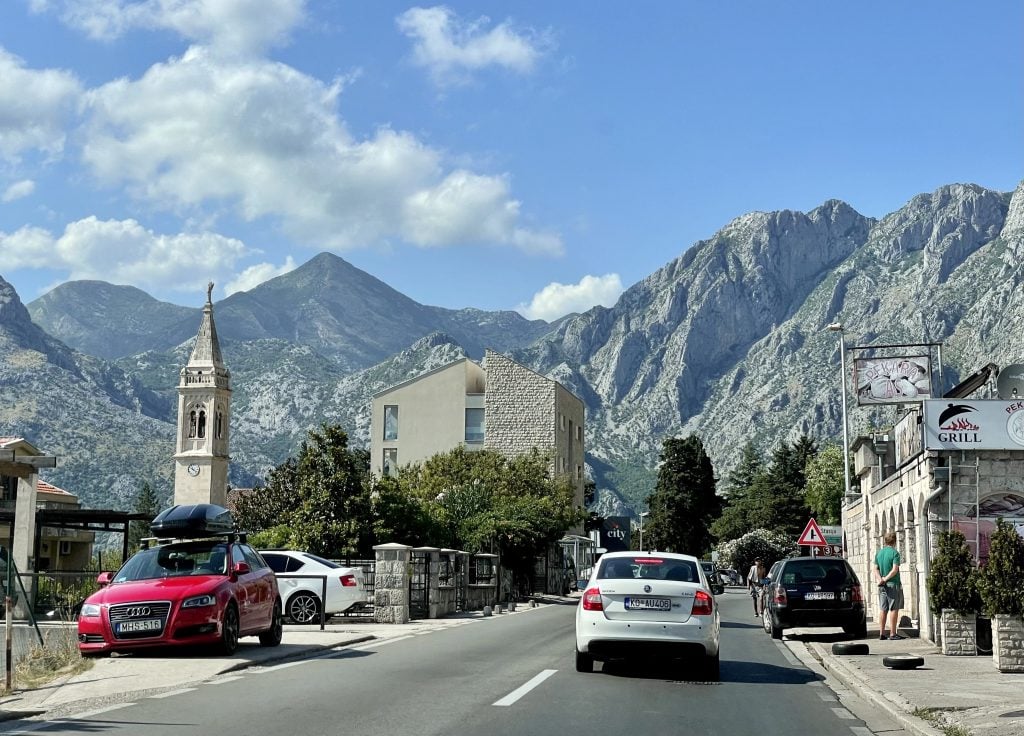
Driving in Montenegro has its challenges.
If you’re going to rent your own car in Montenegro, great! You’re going to get to see so much more this way.
However, you should plan for all of your drives to take much longer than you expect. Montenegro might be the size of Connecticut, but you shouldn’t expect to get from Herceg Novi to Ulcinj as quickly as you can get from Greenwich to New London. (Or maybe you can. I went to college in Connecticut and traffic there is pretty gnarly.)
There aren’t any wide highways in Montenegro. Major roads in the mountains may look like highways on Google Maps, but they are often very narrow and curvy with one lane of traffic in each direction. You often have to slow down to drive these roads safely, and once we even had to drive through a landslide!
That said, these roads tend to be in good condition and driving is smooth. Your main concern is switchbacks in mountainous areas, and there are tons of tunnels.
During the summer months, traffic is terrible along the coast. Once again, the only road along the coastline has a single lane in each direction. Know this ahead of time, and plan a flexible schedule in case you get stuck. (Otherwise, visit during another time of year. Even June and September can be better than July and August.)
As for Montenegrin drivers? They can occasionally get a bit aggressive, but it’s nothing on the level of what I saw in Albania or, shockingly, Slovenia.
Parking in Montenegro can be a huge pain during the summer months, especially along the coast (we literally had to sit and wait for someone to leave Perast in order to park there). Again, consider visiting outside of July or August, and consider just paying for parking to have less of a headache.
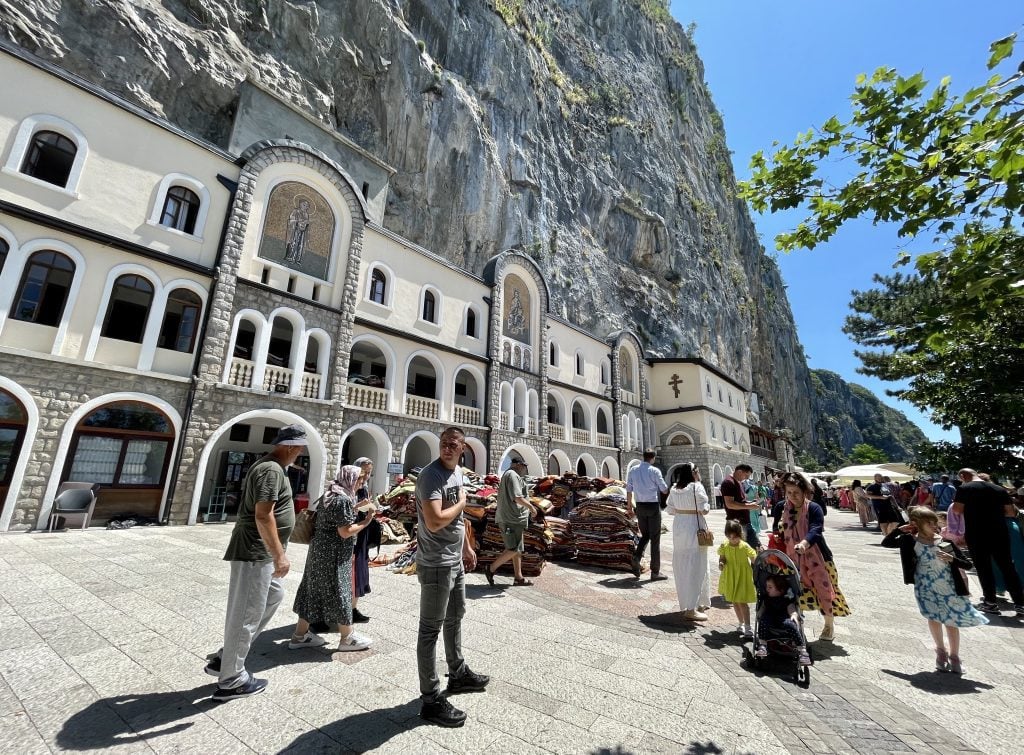
Do people speak English in Montenegro?
The local language in Montenegro is Montenegrin, one of the Serbo-Croatian languages. That said, isn’t much of a language barrier in Montenegro — in areas catering to foreign tourists, that is — so if you only speak English, you’ll be okay.
Like in many parts of Central Europe and the Balkans, everyone who works in tourism speaks English. In more rural, less touristy areas, you’ll find that younger people (under 40) tend to speak English while older people do not.
While Montenegrin uses two alphabets — the Latin alphabet and the Cyrillic alphabet — most signage in Montenegro uses the Latin alphabet. This is a big difference from Serbia, which leans more on Cyrillic.
You’ll find that menus in Montenegro tend to be in the local Montenegrin language, English, Russian (Russians especially love the Budva Riviera), German (Germans go everywhere), and Italian ( perché no? ).
Finally — speak any Slavic languages? You might be able to get by occasionally in Montenegro! My husband Charlie speaks Czech, and a few times he was able to speak Czech with Montenegrins and they got the gist of what the other person saying.
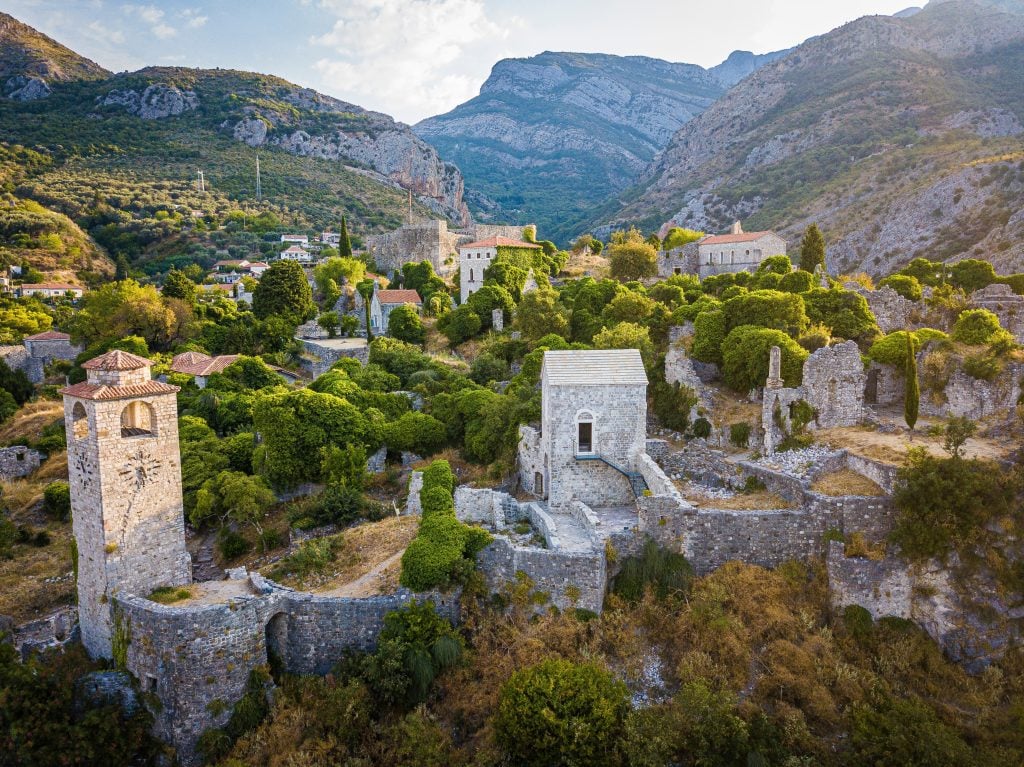
How does money work in Montenegro?
Montenegro is not part of the European Union, but they use the euro as currency. I keep the Currency app on the home page of my phone and use it constantly to double-check what prices are (not as much in Montenegro, as euros are pretty close to US dollars, but you bet I use it a ton in the Czech Republic where the rate is a hard-to-calculate 22:1!).
Here are some money tips for Montenegro:
Avoid Euronet ATMs. These ATMs are found throughout Europe and will RIP YOU OFF. Instead, use an ATM attached to a physical bank. (Added bonus: in the unlikely event your card gets eaten, it can be saved from a bank ATM.)
If it asks whether to charge you in euros or your home currency, ALWAYS choose euros or whatever the local currency is. This might appear on an ATM screen as “Will you accept the conversion?” Always say no — it will still work. Or when paying by card, it may ask you which currency to charge. Always the local currency.
I know, this doesn’t feel intuitive. But they end up charging you a lot more when they convert the rate.
You can use your credit card for most transactions in Montenegro. I use cards whenever possible — both for points and to keep better track of my spending in YNAB, my budgeting software (which I ADORE). However, it’s always a good idea to carry a small amount of euros for small purchases or when businesses don’t accept cards.
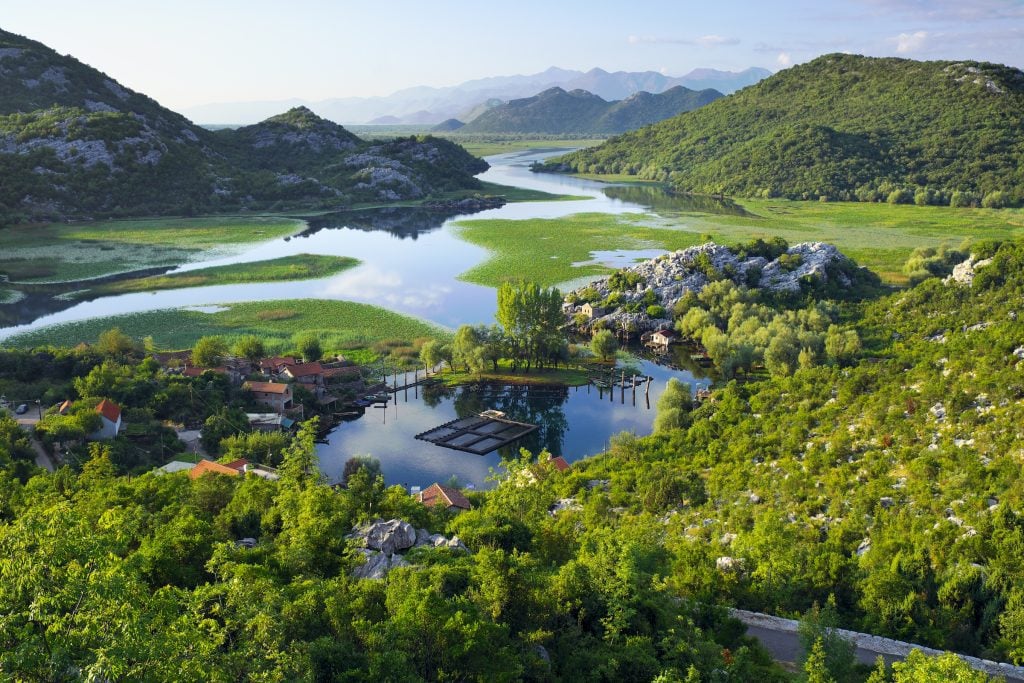
Will your phone work in Montenegro?
Do not use your home phone plan abroad — they will likely charge you ABSURD fees. Additionally, if you have an EU SIM card, know that it will not work in Montenegro.
But should you just rely on wifi in Montenegro? I don’t recommend it. Having working internet on your phone is a safety issue.
Instead, get an eSIM. I used to always get a real SIM card in Montenegro, but eSIMs exist now and they’re fantastic, as you can buy them at home without going to a store.
Nowadays I buy my eSIMs from Airalo. You can see their Montenegro eSIMs here. At the time of publication, you can get 3 GB of data for $15.
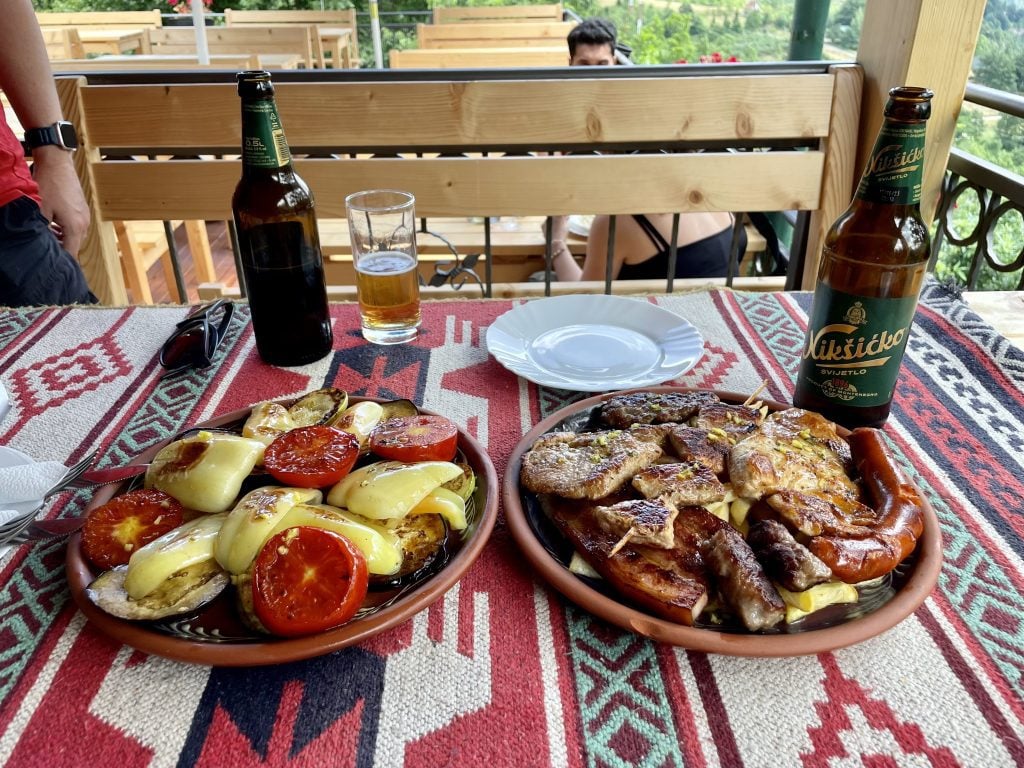
What is Montenegrin food and what will you be eating?
Diving into Montenegrin cuisine? Get ready to eat a lot of meat. (Unless you don’t eat meat, that is — you can avoid it if you want to.) Montenegro, like many Balkan countries, is really big on the meat consumption, especially up in the mountains.
It’s common to get a mixed grill featuring pork, lamb, veal, and chicken, as well as a big platter of tomatoes, peppers, and zucchini. Another meat dish is ćevapi (cheh-VA-pee), rolled minced grilled meat, often served in a pita. My husband is obsessed with pljeskavica , a Balkan burger made from pork, beef, and lamb.
Two sauces to try with your meat are kajmak (KY-mack), which is like clotted cream, and ajvar (I-var), made from roasted red peppers.
Along the coastline, you’ll find plenty of local seafood, with fish stews featuring prominently on many menus. A lot of mussel and oyster farms in the Bay of Kotor have simple restaurants operating out of shacks. You’ll never find fresher seafood than this!
In more touristy destinations, you’ll find slightly more international food options — along with a lot of pizza and pasta. (The quality varies, to be honest. Don’t be surprised if they bring you ketchup for your pizza.)
If you’re looking for a cheap snack or breakfast option, I recommend heading to a local bakery and grabbing a burek — a flaky pastry common throughout the Balkans. It can be filled with spinach, cheese, roasted red peppers, or anything else!
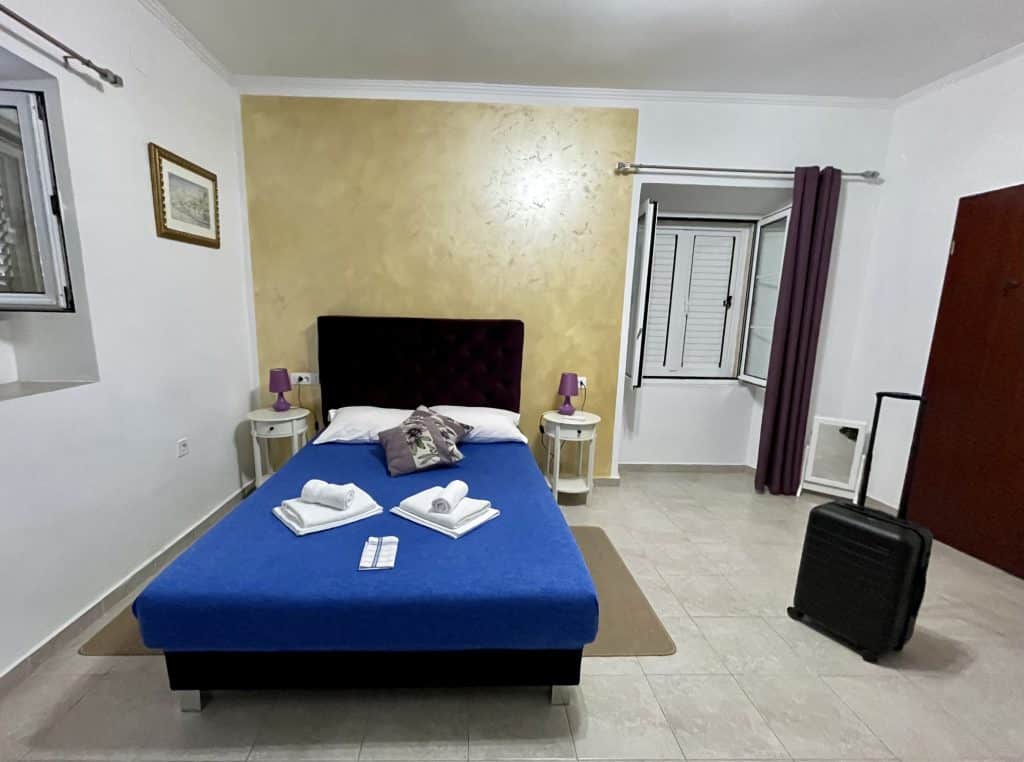
Apartments rule for accommodation in Montenegro.
In Montenegro, like most of the Balkans, apartment accommodation tends to be more popular than hotels. And no, it’s not an Airbnb thing — this is the way things have always been here.
In the pre-smartphone era, it was common for local women in Central and Eastern Europe to stand in train and bus stations with signs reading “apartment.” Even as recently as 2020 in Makarska, Croatia, I saw women on the side of the road holding up signs reading “Apartmenti”!
Sometimes these apartments are considered guesthouses, with several private, lockable rooms available for travelers. To book these places, you can find a lot of them on Booking.com these days . And yes, they are safe. I stay in guesthouses frequently and wouldn’t if they weren’t safe.
And keep in mind that when you stay in an apartment or guest house in Montenegro, you’re (usually) giving money to a local — not buying a hotel chain CEO a third yacht.
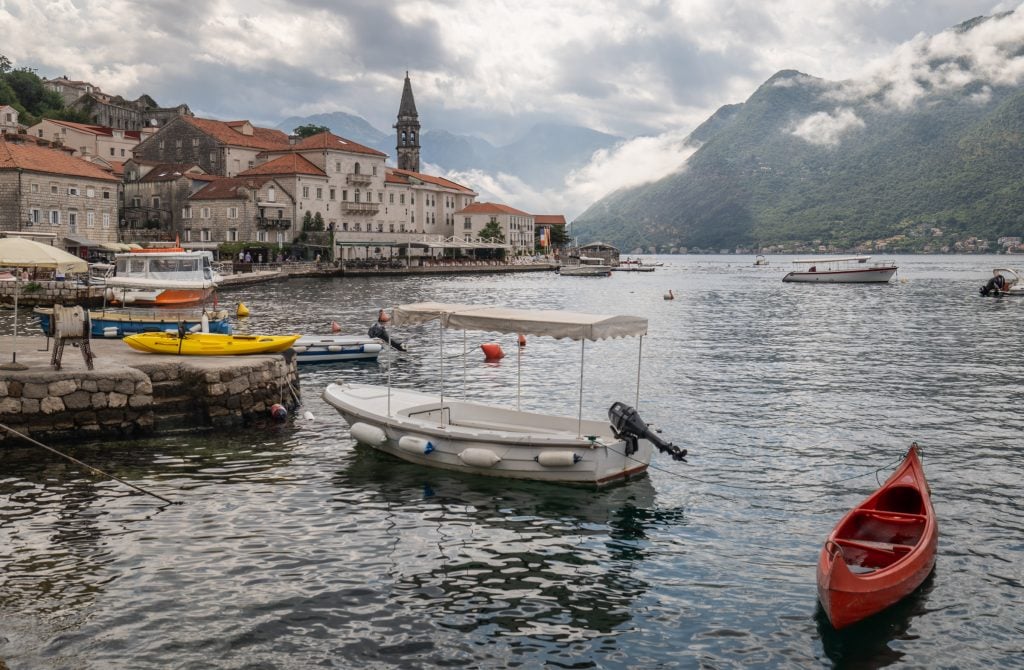
Montenegro is home to four UNESCO World Heritage Sites.
If you love visiting UNESCO World Heritage Sites around the world, Montenegro has four of them: two that are entirely Montenegrin and two that are split between different countries.
First off is the Natural and Culturo-Historical Region of Kotor, and includes the towns of Kotor, Perast, and Risan in addition to the various fortifications and palaces and how they were integrated into the mountainous landscape.
Durmitor National Park is also a UNESCO World Heritage Site, singled out for its biodiversity, glacial lakes, and the second-deepest canyon in the world.
The Stećci Medieval Tombstones Graveyards include a collection of sites in Bosnia and Herzegovina, Croatia, Montenegro, and Serbia. In Montenegro, there are two sites in Žabljak and one in Plužine.
The Venetian Works of Defence between the 16th and 17th centuries are found in Italy include a collection of sites in Italy, Croatia, and Montenegro. The fortifications of Kotor are the lone Montenegrin site.
And keep your eye on the tentative UNESCO list for the future — some Montenegrin sites that have been nominated include the Cetinje historic core, Biogradska Gora National Park, and Ulcinj old town, among others.
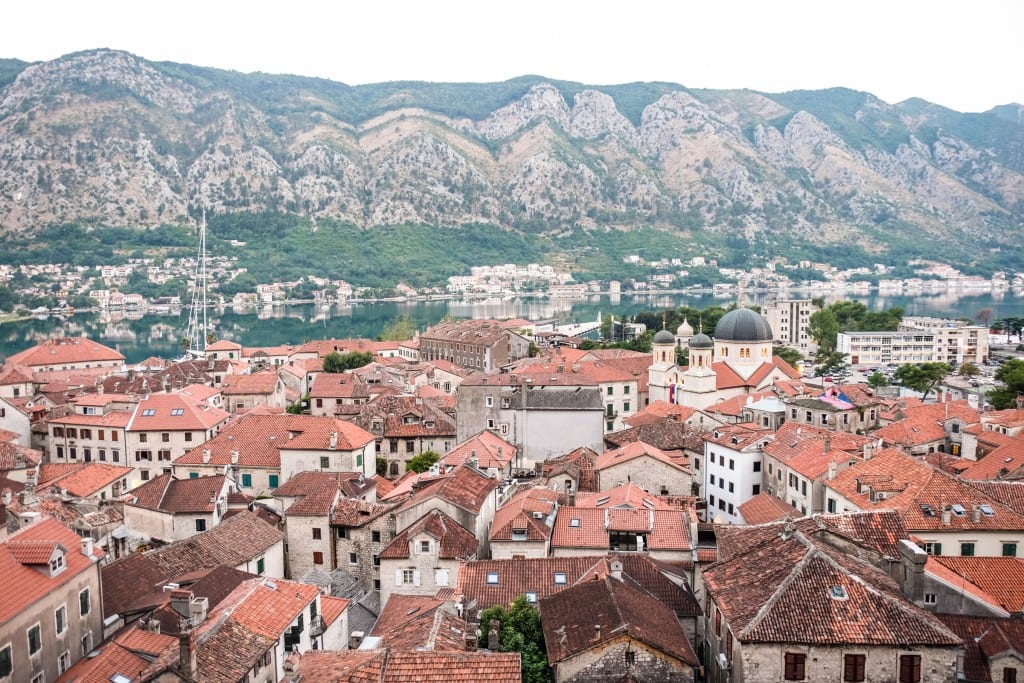
You can see a lot while using Kotor as a base.
Want to have an easier trip to Montenegro without worrying about a car? I recommend using Kotor as a base for your Montenegro trip and exploring from there.
Why Kotor? It has the most tourism infrastructure in the country. Buses head off in several directions from here (if going from Perast to Kotor, for example, you must change buses in Kotor). And many tours depart directly from here.
Spend a few days exploring what Kotor has to offer (and it has a LOT to offer). Hike up to St. John’s Fortress first thing in the morning, visit the Kotor Cats Museum, photograph everything in sight.
Spend one day on a Durmitor National Park day trip. This trip takes in Black Lake, Tara Canyon (no rafting) and Ostrog Monastery ; alternatively, you can do a Tara Canyon rafting day trip .
Spend one day on a Great Montenegro Tour , which includes the Kotor Serpentine, Ngejusi, Lovcen National Park, Njegoš Mausoleum, Cetinje, Lake Skadar, and a brief photo stop at Sveti Stefan.
One afternoon, take a boat trip to the Blue Cave, submarine tunnel, and Our Lady of the Rocks .
One day, take the hop-on-hop-off Montenegro bus to Risan, Perast, and Bajova Kula. (Or just take the Blue Line bus for cheaper, perhaps as far as Herceg Novi if you’d like.)
One day, take a bus to Budva and Sveti Stefan.
You can see QUITE a lot of Montenegro — and you’ll be able to lay your head in the same place every night. Not bad at all!
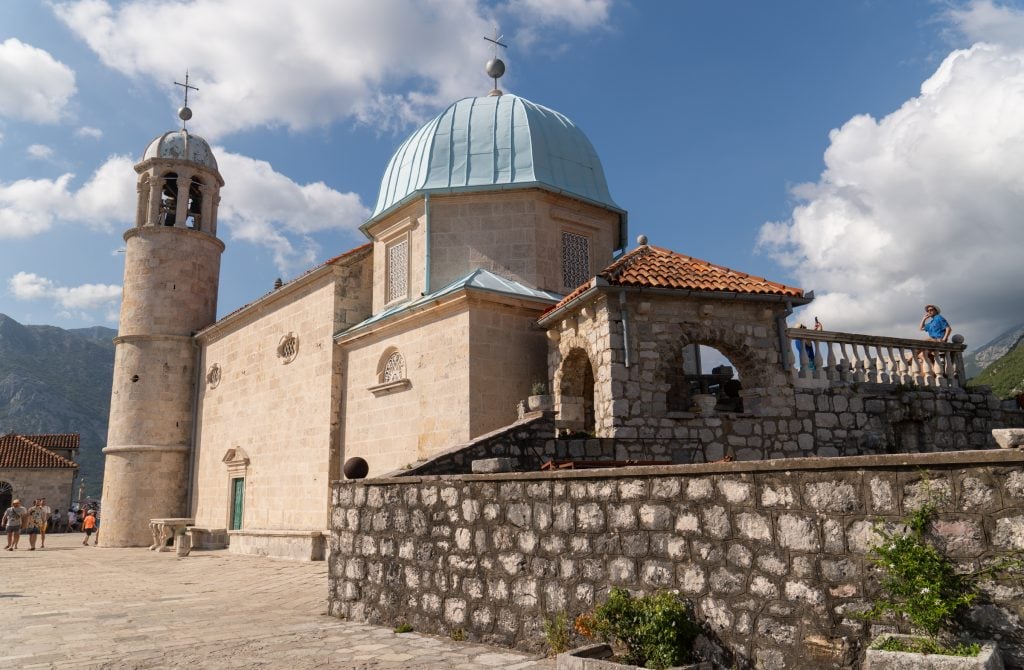
Should you take a day trip to Montenegro from Croatia?
There are so many Montenegro day trips that leave from Dubrovnik. Most of these trips take in Kotor and Perast. If you don’t have much time and you really, really want to experience Montenegro, then yes, you can absolutely do this.
This day trip from Dubrovnik to Montenegro is a good one , including Our Lady of the Rocks (or, alternatively, time in Perast), Kotor, and Budva.
However, you should know that summer traffic between Dubrovnik and Kotor can be rough. I’ve seen it get worse and worse over the years.
Additionally, you’ll need to go through passport control on both sides. And ever since Croatia became part of the Schengen Area in 2023, they’ve been extra strict and thorough with people at crossings.
A day trip to Montenegro means you’ll be sitting in traffic for a LOT of the day, especially if you visit during the summer.
Consider staying overnight, at the very least, if you’re visiting Montenegro from Croatia. You’ll get to see so much more. But if this is your only chance, take the day trip. You’ll still love it.
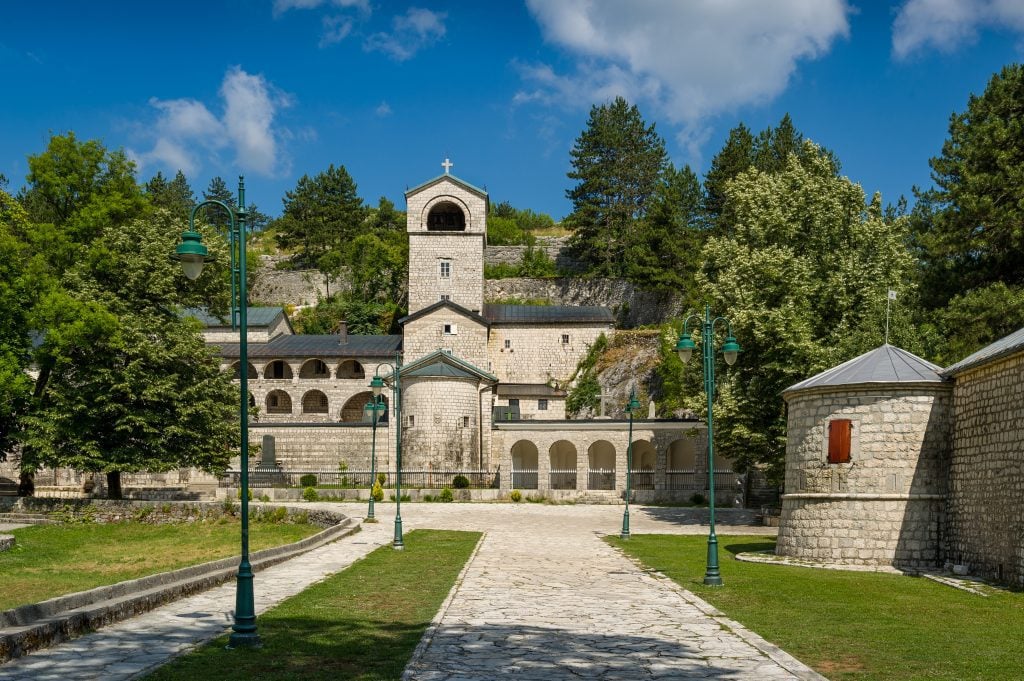
How much time do you need in Montenegro?
How much time should you actually spend in Montenegro? More than a day trip, of course, but how much do you really need?
I recommend spending around one week in Montenegro. I’d recommend spending 3-4 days on the Bay of Kotor — staying in Kotor is easiest, though I loved staying in Perast as a repeat visitor — and your remaining days in one or two other places.
Durmitor National Park makes a great choice; you can also head down into Southern Montenegro with easy access to explore the surroundings, especially if you have a car. Somewhere like Bar, for example, gives you a lot of options.
Is it too far to fly to Montenegro for just one week of travel? You can absolutely extend your trip if you’d like — or add on a short stint in another country. Croatia, Serbia, Bosnia, or Albania would be my top recommendations to add on to a trip to Montenegro.
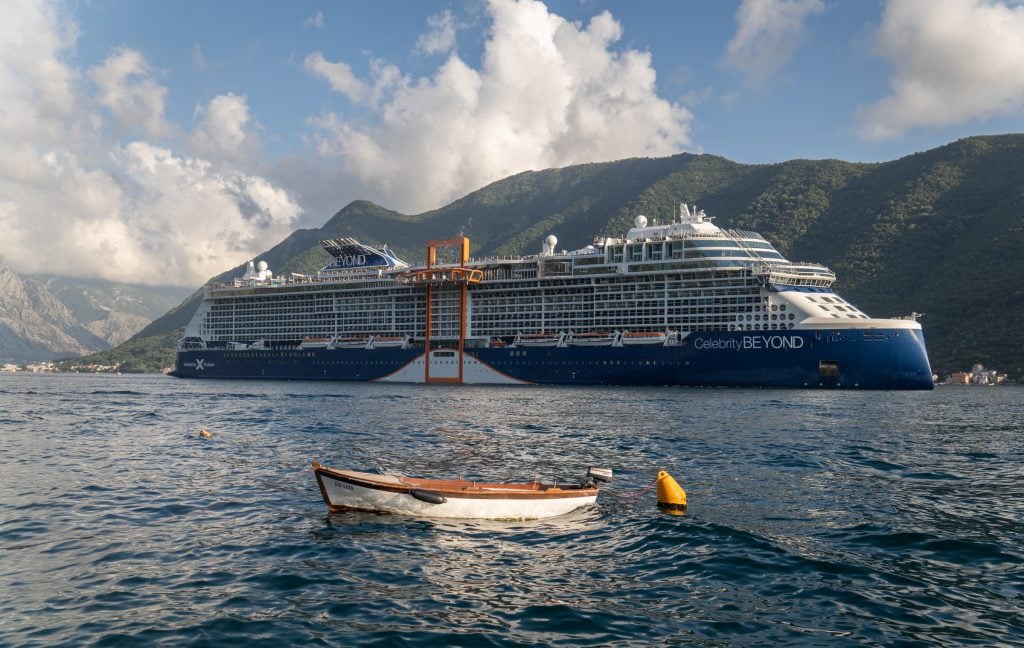
Please don’t take a cruise ship to Montenegro.
Yes, this is something that you hear me say frequently, and it deserves to be repeated. Cruise ships are terrible for most destinations around the world — and that includes river cruises. Cruise ships dump hundreds or thousands of travelers on a destination. They crowd the streets and spend little to no money. Who are they helping, really?
And it is especially egregious to see monstrously large ships sailing through the delicate Bay of Kotor and dropping people in the small city of Kotor. It is TOO SMALL to handle numbers those large.
Recently, Dubrovnik reduced the number of cruises they host. That was a smart move, and should be applauded.
But Kotor picked up the slack. All those cruises are now going to Kotor instead of Dubrovnik.
Do you want to see Montenegro by boat? Can I suggest a Montenegro sailing trip instead, or maybe a Croatia and Montenegro sailing trip ? This way you can still travel by boat and have a much gentler impact on local communities. And these trips are insanely fun.
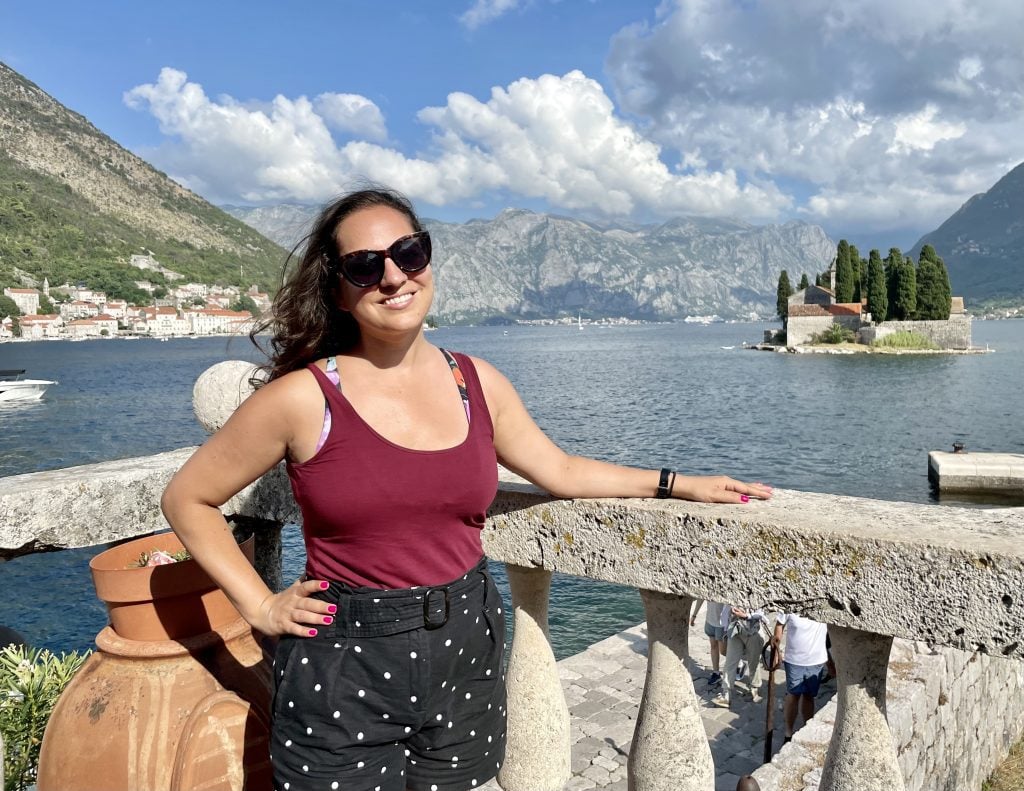
Travel to Montenegro and you’ll be back soon.
Montenegro travel is so worth it — and once you’ve had a taste of it, you’ll be hooked. Even years after my first Montenegro visit, I know I wanted to return to celebrate my birthday here. It’s that kind of place. It just makes everything feel special.
I hope you have the best time in Montenegro! Definitely come back and tell me all about it.
More on Montenegro:
- 30 Fun and Interesting Things to Do in Montenegro
- I was Haunted by a Ghost in Montenegro for 3 days
- 17 Beautiful Things to Do in Kotor, Montenegro
- 30 Stunning Beaches in Montenegro
- 15 Best Things to Do in Budva, Montenegro
More on the Balkans:
- Solo Female Travel in the Balkans: Is it Safe?
- What’s it like to travel in Albania?
- What’s it like to travel in North Macedonia?
- Ultimate 2-Week Croatia Itinerary
Do you travel to Montenegro? What are your tips? Share away!

14 Top-Rated Things to Do in Montenegro
Written by Meagan Drillinger Updated Jul 10, 2023
With a population of just over 600,000 people, I mean it when I say Montenegro is small. But it is one of the most spectacularly beautiful places on the planet. That's because it has a similarly impressive Adriatic coastline to neighboring Croatia, towering limestone mountains, dozens of medieval villages, and the Bay of Kotor — arguably one of the most beautiful bays in the world.
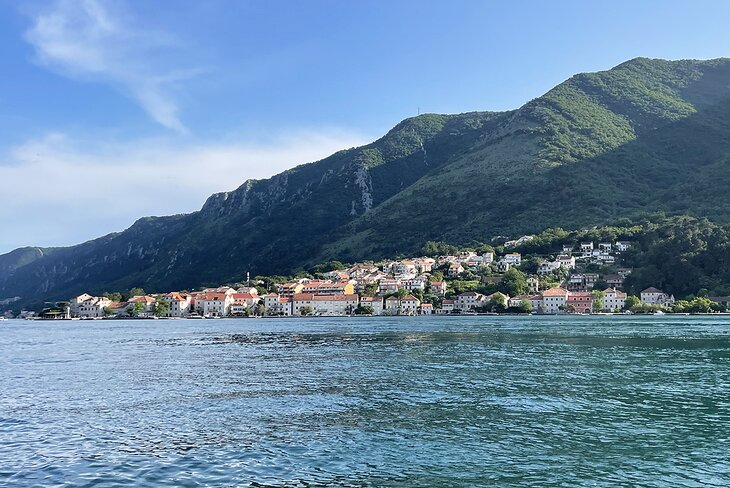
Add to that a mild Mediterranean climate, fabulous food, interesting attractions and things to do, and pricing that is famously much lower than in other European countries, and you'll soon see why Montenegro is fast becoming one of Europe's top tourism hot spots.
I adored my time wandering the cobblestone alleys in the Venetian Old Town Kotor, gazing out to the deep blues of the fjord-like bay, sprawling on the splendid Riviera beaches , and hiking the mountainous interior.
For more ideas on the best places to visit, read my list of the top things to do in Montenegro.
Kotor Old Town & Bay of Kotor
Budva riviera, our lady of the rocks, lake scadar, mount lovcen, sveti stefan, durmitor national park, tara canyon, ostrog monastery, biogradska gora national park, map of things to do in montenegro.
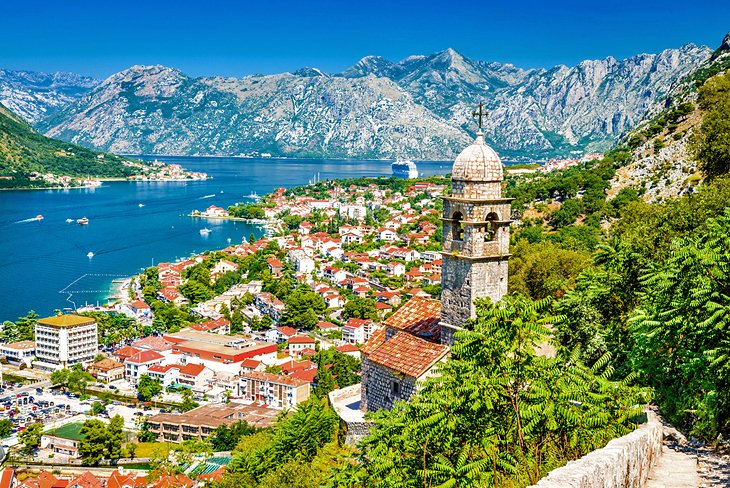
You will fall in love with Montenegro the moment you cross the border. Most independent visitors fly into Dubrovnik in nearby Croatia and make the 90-minute drive down to Kotor. Other travelers' first foray into Montenegro is part of a cruise stopover, which also calls in Kotor. No matter which way you get there, you will be introduced to Montenegro with the spectacular Bay of Kotor.
The Bay of Kotor (also known as Boka Bay) is one of the most impressive bodies of water in the world. The deep blue, fjord-like bay is wreathed in towering limestone mountains and peppered with red-roofed medieval towns. At the southeastern edge of the bay is Kotor's Old Town, a magical fairy-tale 9th-century city that is packed with secrets to discover.
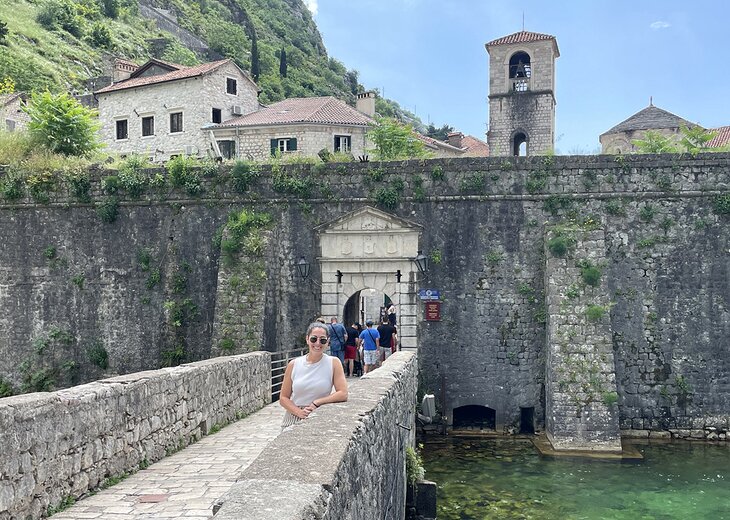
Old Town was my absolute favorite part of Montenegro: wandering the stone alleyways and narrow side streets, having coffee at one of the many outdoor cafes, and meeting the (dozens) of friendly cats that call the city home.
Visitors to Old Town will want to stop at the 12th-century Cathedral of Saint Tryphon, known for its carved stone altar. If you want a bit of exercise, you can climb the 1,300-plus steps up the mountain to the San Giovanni Fortress, which was built in the 9th century. From here you'll have the best sweeping views over the walls, Old Town, and Boka Bay.
Read More: Top-Rated Things to Do in Kotor, Montenegro
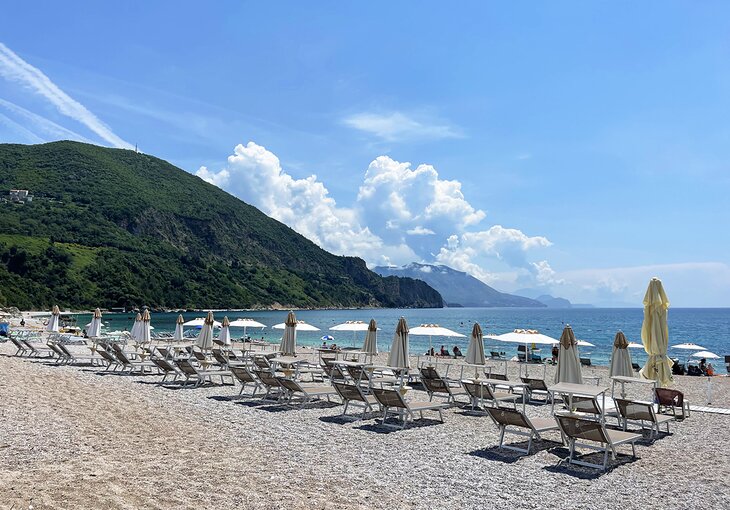
Stretching along the central Montenegrin coastline with Budva as its anchor city, the Budva Riveria is one of the area's main attractions and a hot summer beach destination for locals and tourists alike. The beaches here are a mix of sand and pebbles, backed by the clear, turquoise and aquamarine-blue hues of the Adriatic Sea on one side and dramatic mountains on the other.
There are a number of quality beaches along the Riviera, including Mogren Beach , which is the closest to Old Town Budva at just a five-minute walk along a seaside pathway from town. The beaches along the Budva Riviera are also lined with restaurants with outdoor seating.
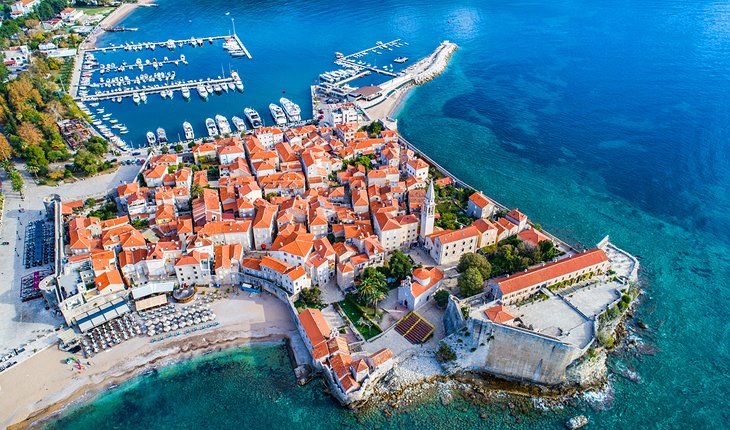
Old Town Budva has a history that dates back 2,500 years. This medieval walled city has a lively atmosphere and is filled with restaurants and shops, as well as a town museum.
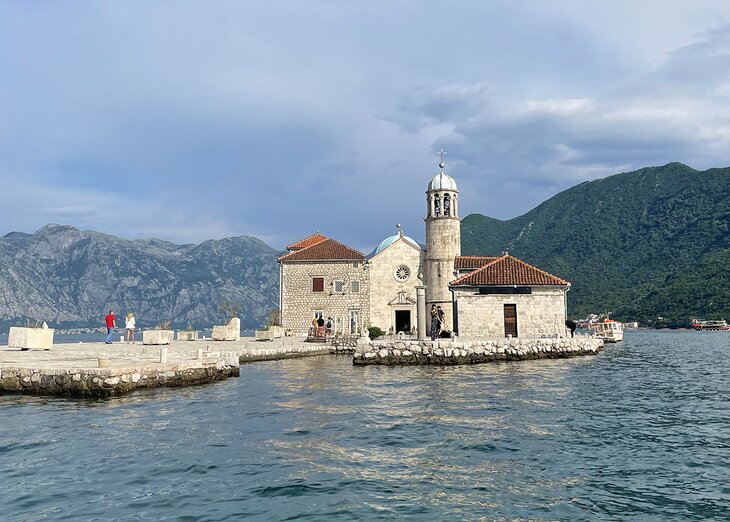
Out in the center of Boka Bay, just off the coast of the historic village of Perast, is a man-made lake topped with a gorgeous church. The church, known as Our Lady of the Rocks, originally dates back to the 15th century. Its history, plus its position on the lake surrounded by stunning mountains, will make even non-believers feel something spiritual.
I took a private boat tour of Boka Bay, which included a stop at the island and the opportunity to wander around the church. The views are awe-inspiring from every angle. The church has a robin's egg blue dome and red tile roof, which contrasts beautifully against the white stone and green of the mountains.
The church you see today is from the 17th century, as the original church was destroyed in an earthquake.
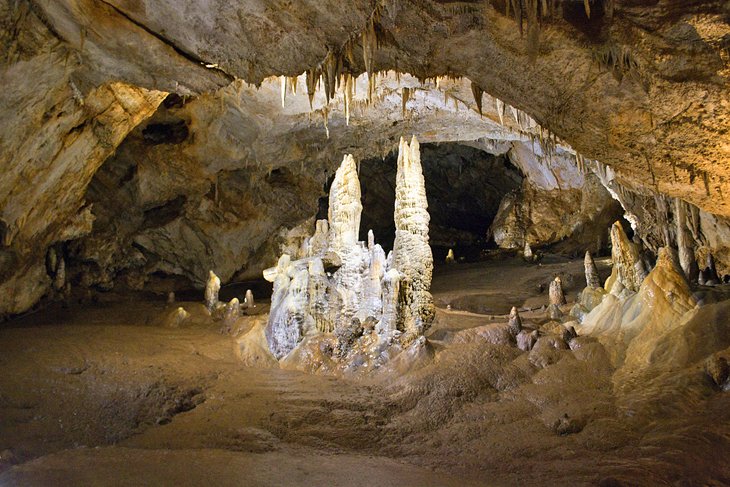
One of the largest caves in Montenegro, Lipa Cave, just a few kilometers from the village of Cetinje , is in the mountains north and just east of Budva . The cave was first discovered accidentally by a dog who fell through a hole into it, but managed to escape safely through another opening.
Today, the karst cavern is also one of Montenegro's most popular tourist attractions for adventurous kids and adults alike. A visit begins with a ride on a miniature train through the wild countryside, full of pomegranate and wild fig trees, to the cave's entrance. From here, you'll join a guided tour through some of the 3.5 kilometers of passages and great halls carved by thousands of years of dripping water and its underground river.
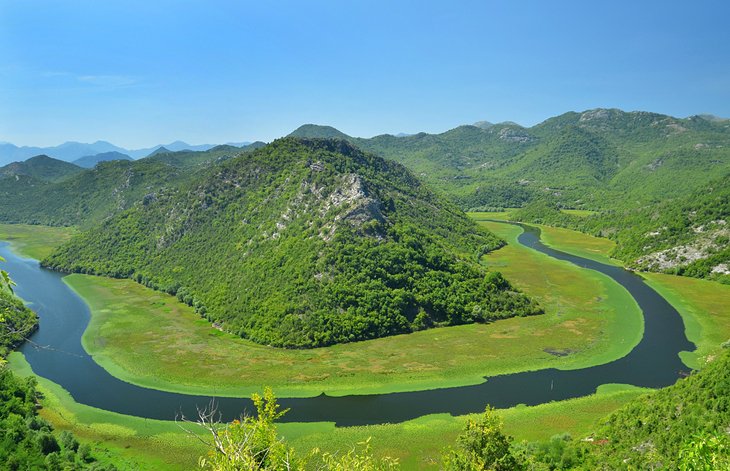
Lake Scadar, on the border with Albania , is the largest natural lake in Southern Europe . It is a great back-to-nature destination that hosts multiple species of migratory birds and other wildlife. The Montenegrin side of the lake has been designated as a national park. Explore the lake on a boat excursion and also spend some time checking out the villages dotting it. Many date back to the 13th century and have been designated as UNESCO World Heritage sites.
On the lake's southwestern shore, you'll find Murici Beach , which is a pristine and quiet stretch of shoreline backed by the beautiful Rumija Mountain Range. The beach can be accessed via a steep road to a small village at the edge of the lake. This is a great spot to just escape and breathe in the fresh air and countryside ambience.
Also, don't miss the Pavlova Strana viewpoint in the national park. From here, you'll see the horseshoe bend of the Rijeka Cronjevica River, which flows around a small, round mountain on its way into the lake. The lush green of the surrounding trees and hills juxtaposed against the blue of the river is stunning.
The viewpoint is about a 30-minute drive from Cetinje off the M2.3 highway. You'll reach it on a very narrow one-lane road with lots of tight hairpin bends, so drive carefully.
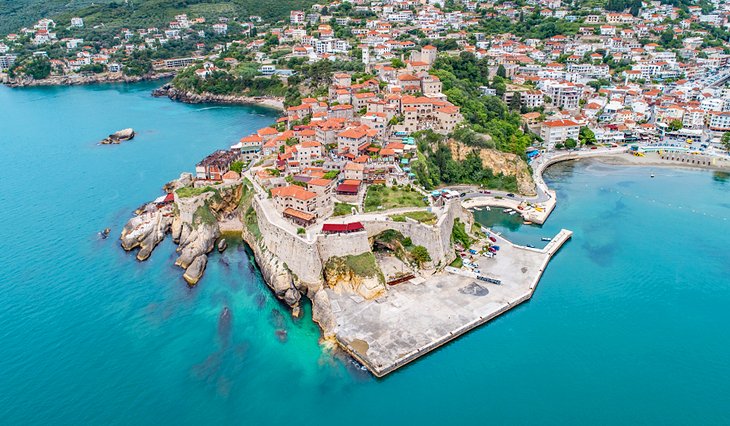
Not far from the Albanian border at Montenegro's southern tip, Ulcinj is an ancient seaport that was once infamous as the Adriatic Sea's pirate capital. Today, Ulcinj is a unique Montenegrin town with a largely Muslim population and some beautiful mosques and excellent restaurants and coffee shops along its peaceful seaside promenade.
The area is also known for its beaches, including Velika Plaza (which translates to "Big Beach"), and at 12 kilometers is Montenegro's longest beach. The water here is very shallow and great for families with small children. If you are a person who prefers a sandy beach over the traditional pebbly beaches you find in Croatia and Budva, you'll love Velika Plaza for its soft, fine sand.
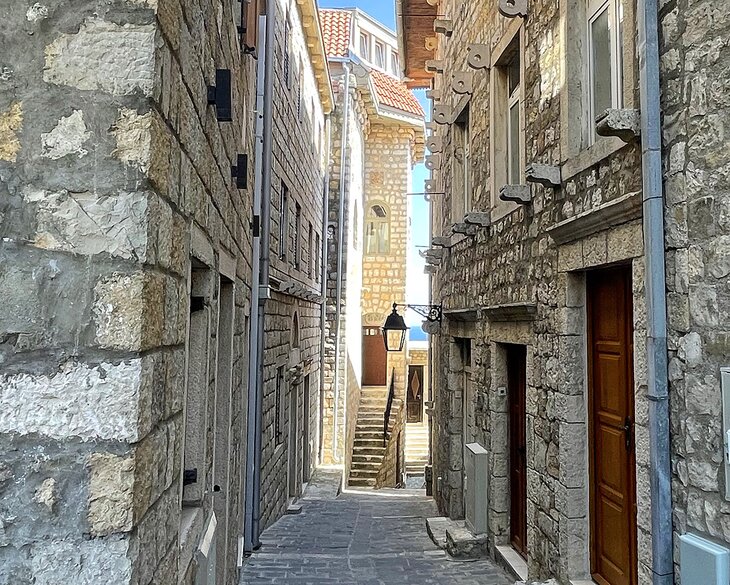
It is also a top spot for kitesurfers, who take advantage of the glassy smooth and shallow water and prevailing winds to catch a ride. If you'd like to learn more about the sport, there are a number of kitesurfing schools at the southern end of Velika Plaza.
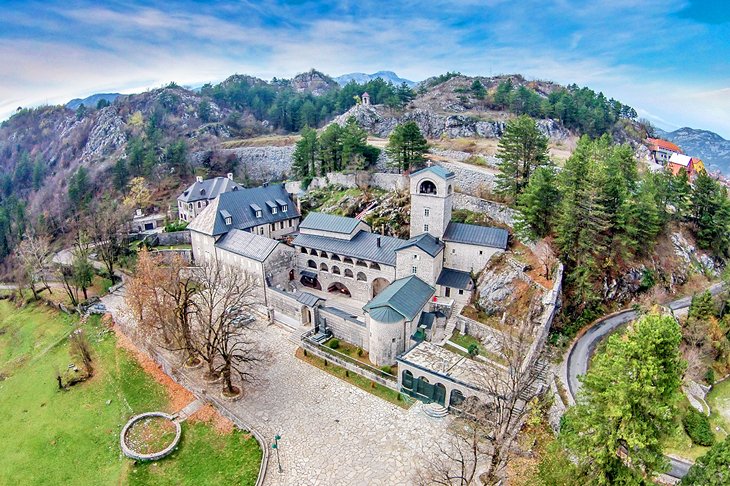
The 15th-century town of Cetinje once served as Montenegro's capital during the late 19th and 20th centuries (prior to WWI when it was still an independent country). At the time, the inland valley locale at the edge of what was then the Ottoman Empire made it a coveted spot to conduct diplomacy.
Today, the embassies have been turned into museums, government buildings, and educational academies, and the town is a pleasure to wander aimlessly about for an afternoon. The Cetinje Monastery here has a collection of Early-Christian-era relics you can see for a donation, and the Vlah Church dating back to the 15th-century is another notable sight.
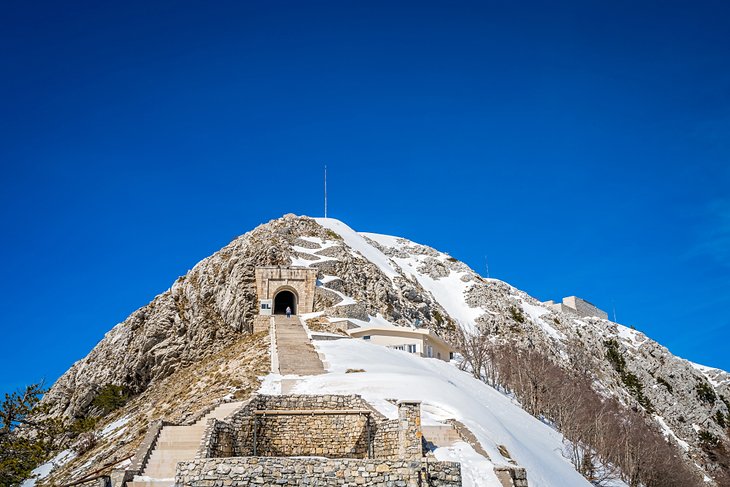
Montenegro's name was inspired by the towering granite peaks of Mount Lovcen, and the mountain is a source of national pride. Protected as a part o f Mount Lovcen National Park , the views from the circular platform at the top are truly stunning and have you looking down upon the Bay of Kotor and the medieval city of Kotor on its shores.
Also nearby is Njegos Mausoleum, where you can pay your respects to the author of Montenegro's national epic poem, "The Mountain Wreath." Its poet Petar II Petrovic-Njegos is buried here. The village of Cetijne is the main base for this park and where you'll find a number of hotel and restaurant options.
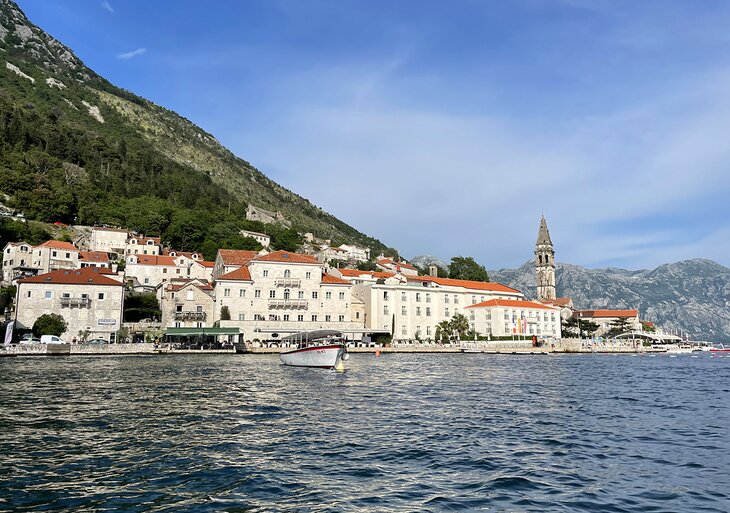
On the same beautiful bay as Kotor but located just to the northwest, Perast is a picturesque small town notable for its multiple churches and stone-crafted villas. In town, the Church of St. Nikola has great views of the town and the Bay of Kotor from its belfry tower.
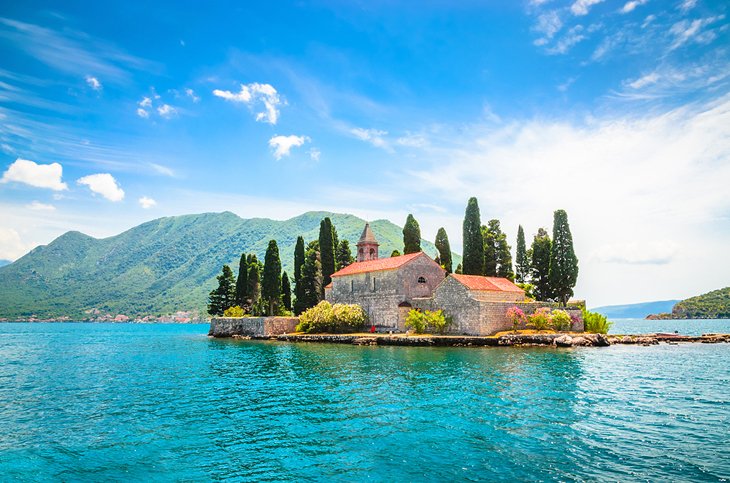
Two of Perast's most charming churches, Our Lady of the Rocks and St. George , however, are on tiny islets in the bay. The town does not have a beach, but the stone jetties along its bayfront are popular summer spots for sunbathers.
Perast can be combined with a trip to Our Lady of the Rocks, or you can visit from land on your own.
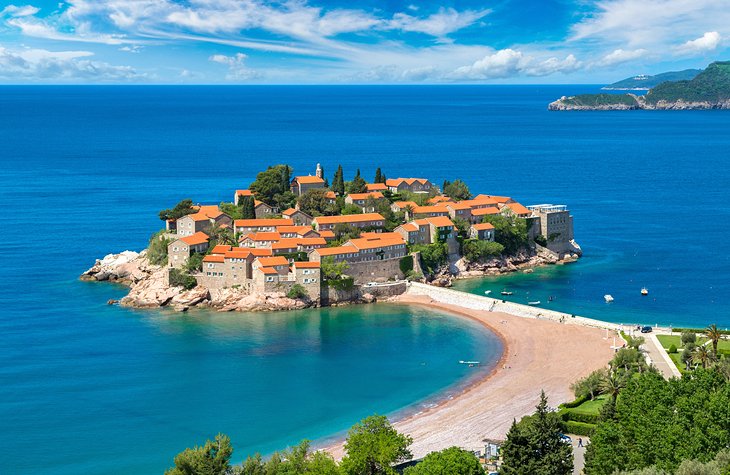
On the Budva Riviera , Sveti Stefan is connected to the mainland by a narrow isthmus and has been inhabited since the 15th century. Back then it was a simple fishing village. The town came to be known in the 1950s when it was turned into a luxury resort area, and guests like Marilyn Monroe and Sophia Loren would holiday here.
Following a downturn at the end of the 20th century as the Yugoslav federation collapsed, today it is again a vacation paradise, with two beautiful pebble beaches on either side of the isthmus. Although the beaches are public, the original village is only open to visitors staying at the Aman Resort here.
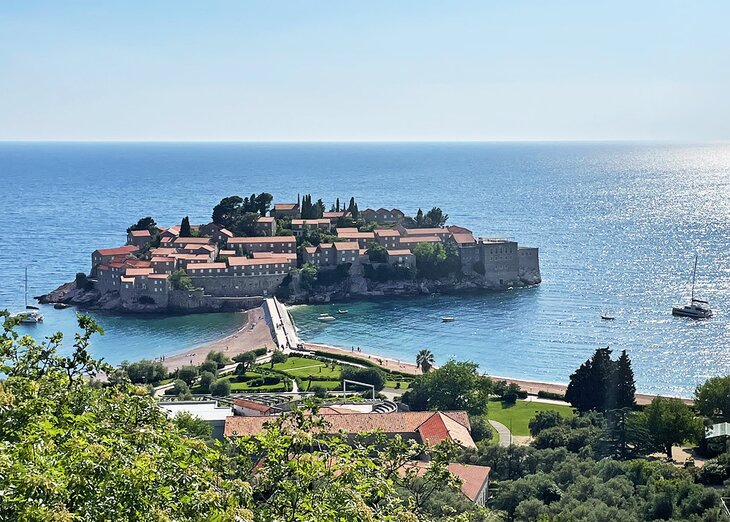
If you want a beautiful bird's eye view of the village, you can find a lookout point on the highway that looks down directly over it. If you're coming from Budva, the lookout point is just before the turnoff to go down to the beach.
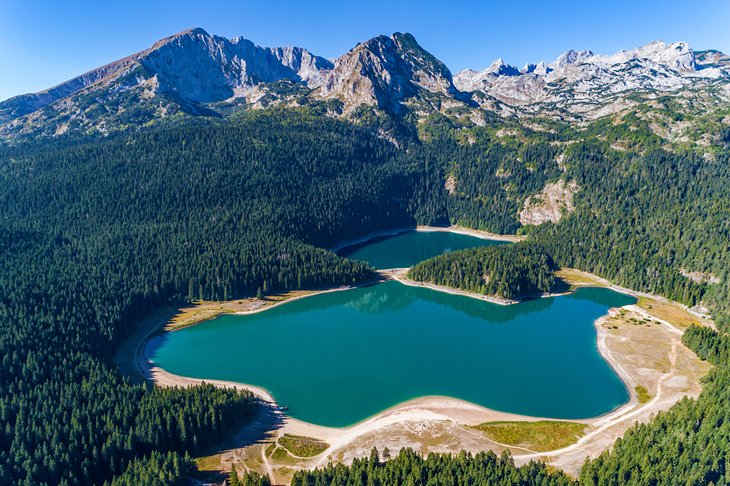
Near the mountain town of Žabljak, Durmitor National Park is another popular natural attraction. The park sits in the Dinaric Alps and is home to some 18 glacial lakes, the Tara River, and the world's second-deepest canyon (see Tara Canyon below).
Of the lakes in the national park, one of the best ones to visit is Black Lake . Once here, you can hire a kayak and explore the crystal-clear, jade and turquoise water from its helm. Or follow the four-kilometer track that meanders around the lake itself. It's an easy walk, and you'll pass historic caves along the way. Black Lake is also a great place to bring a picnic and just relax.
The park is also home to thick areas of forest and wildlife, from brown bears to wild boars, and 163 different species of birds. There are opportunities to go skiing or snowboarding here in winter, and in summer, you can hike, camp, and white water raft among other activities.
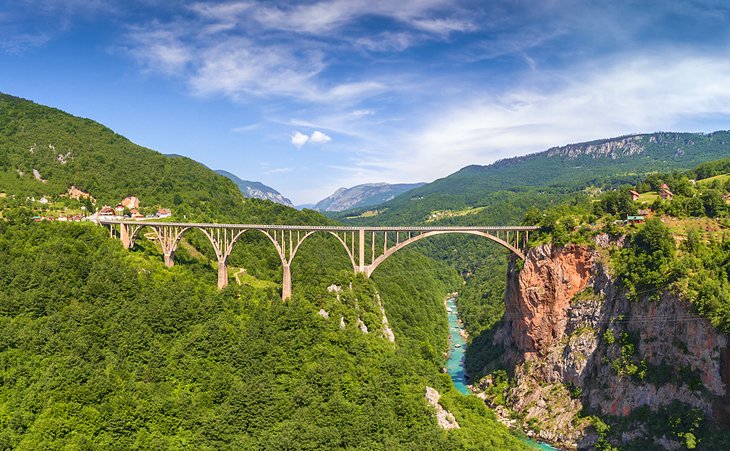
Tara Canyon is another of Montenegro's amazing natural wonders. After the Grand Canyon, it is the world's deepest canyon, and just like the Grand Canyon, it can be experienced with an epic whitewater rafting trip. Note that the water is a bit on the chilly side, however, at around 50 degrees Fahrenheit.
If you don't want to get wet, you can also see the canyon from the Ðurdevica Tara Bridge . The concrete arch bridge was rebuilt after WWII when it was blown up in an effective attempt to stop the Italian invasion.
Today, the bridge is 172 meters above the canyon floor and besides taking in views from it, adrenalin junkies can ride across the canyon on a zipline.
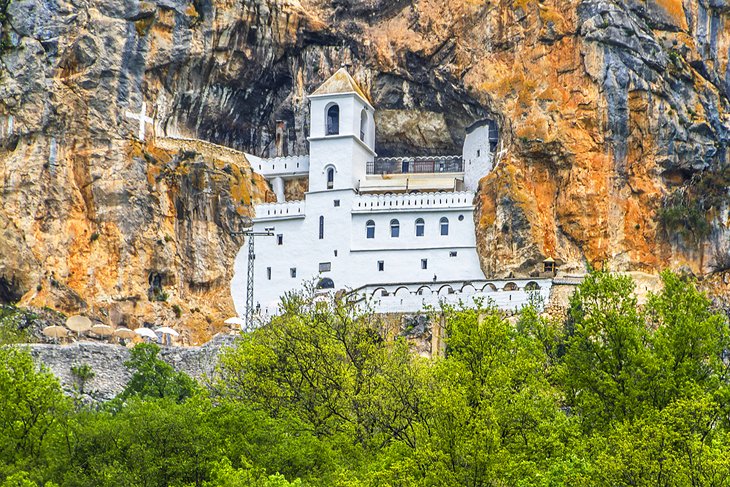
Built during the 17th century as a refuge against Ottoman Empire invaders, Ostrog Monastery is now a major Christian pilgrimage destination. Set atop a large granite outcropping, the entire monastery was carved from a cave on a nearly vertical cliff.
It is quite an impressive site, with two inner cave churches that can be visited. They are bedecked with frescos painted right onto the rock walls. The monastery also houses the remains of its founder, Sveti Vasilje, who became a saint after his death in 1671.
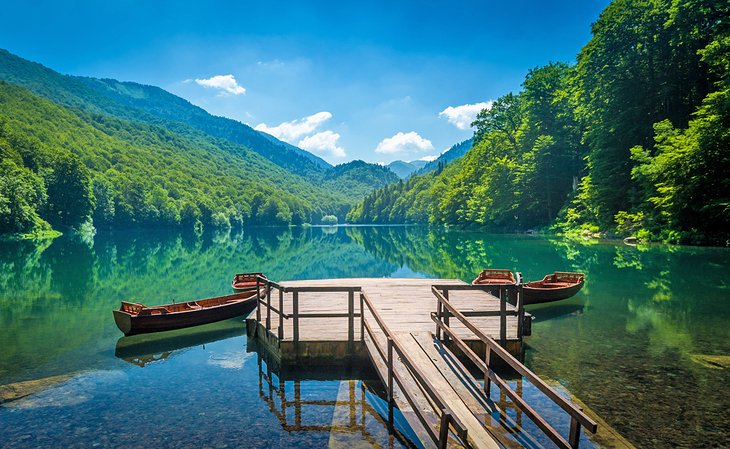
Montenegro has designated quite a bit of land to national parks, including the beautiful Biogradska Gora National Park in the center of the country. Set between the Lim and Tara rivers, it is filled with fast-running streams; sparkling, clear lakes; flower-filled meadows; and one of Europe's last primeval forests, where the trees are 500 years old.
The top natural attraction in this park is Lake Biograd, which is a large glacial lake in the middle of the park. The nearby town of Kolasin makes a good base with lodging and restaurants.

TOP 10 attractions of Montenegro
Montenegro is mandatory on every "bucket list,” so we’ve compiled a list of the very best it has to offer culturally, historically, and naturally. See our TOP 10 suggestions!
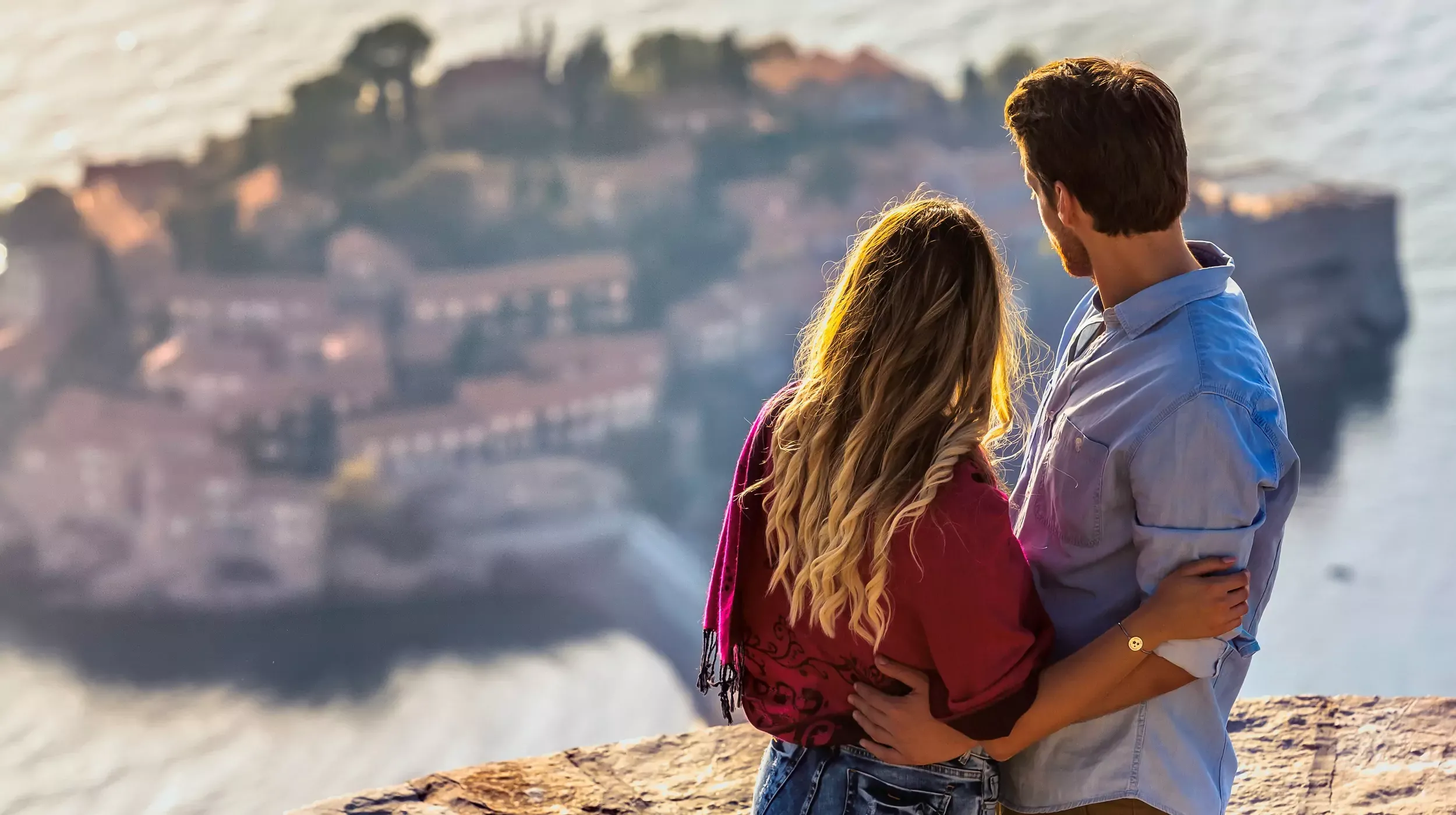
The charming town of Perast
A fifteen-minute drive from Kotor (12 km), you will find the quiet, picturesque town of Perast, adorned with numerous churches and palaces. The Church of St. Nikola is located on the square, in the central part of Perast, next to a bell tower 55 m high that offers a surreal panoramic view of the bay. While you are here, be sure to journey to two stunning islands - the island of St. George and the idyllic island of Our Lady of the Rocks - with a museum and Catholic church of the same name.
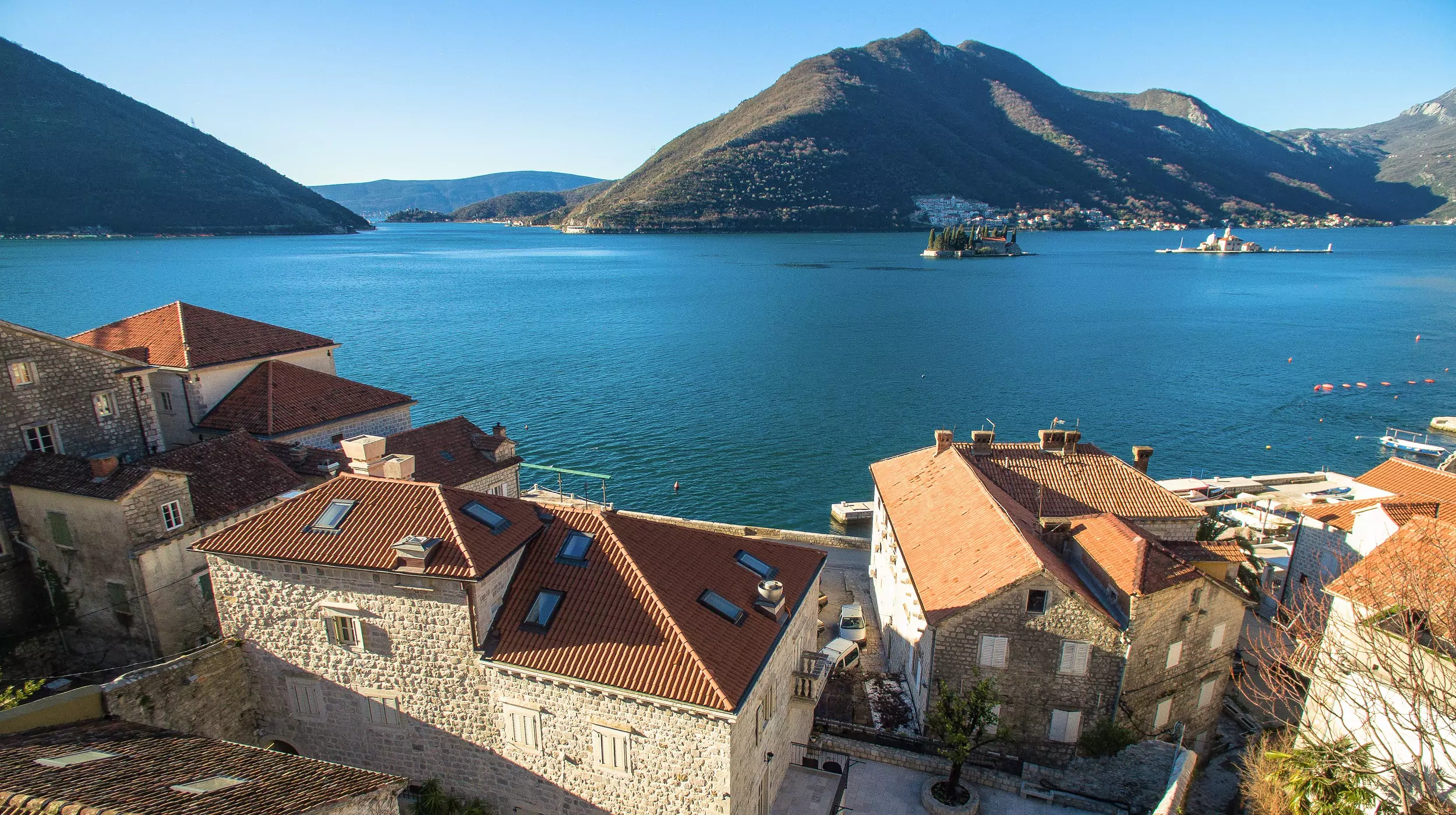
UNESCO Old Town of Kotor
The old town of Kotor, which is on the UNESCO World Heritage List, looks like an open-air museum. Take a walk through the narrow streets and squares of the Old Town, which are adorned with churches, medieval architecture, and palaces of wealthy Kotorans and noble families. In the central part of the Old Town, visit the Maritime Museum of Montenegro, which presents the seafaring history of this region. When you visit the city within the walls, take the stone path or narrow stone steps to the highest peak of the ramparts (260 m above sea level), where the fortress of St. Jovan is located. You will need to get a bit of exercise for this hike, but it is worth it because during the whole trip you will be surrounded by a beautiful view of the Old Town and the port of Kotor. At the end of the trip, reward yourself with lunch in one of the restaurants, because no tour of the Montenegrin coast is complete unless you taste the rich flavors of our cuisine, with delicacies including squid, risotto, and Vranac red wine.
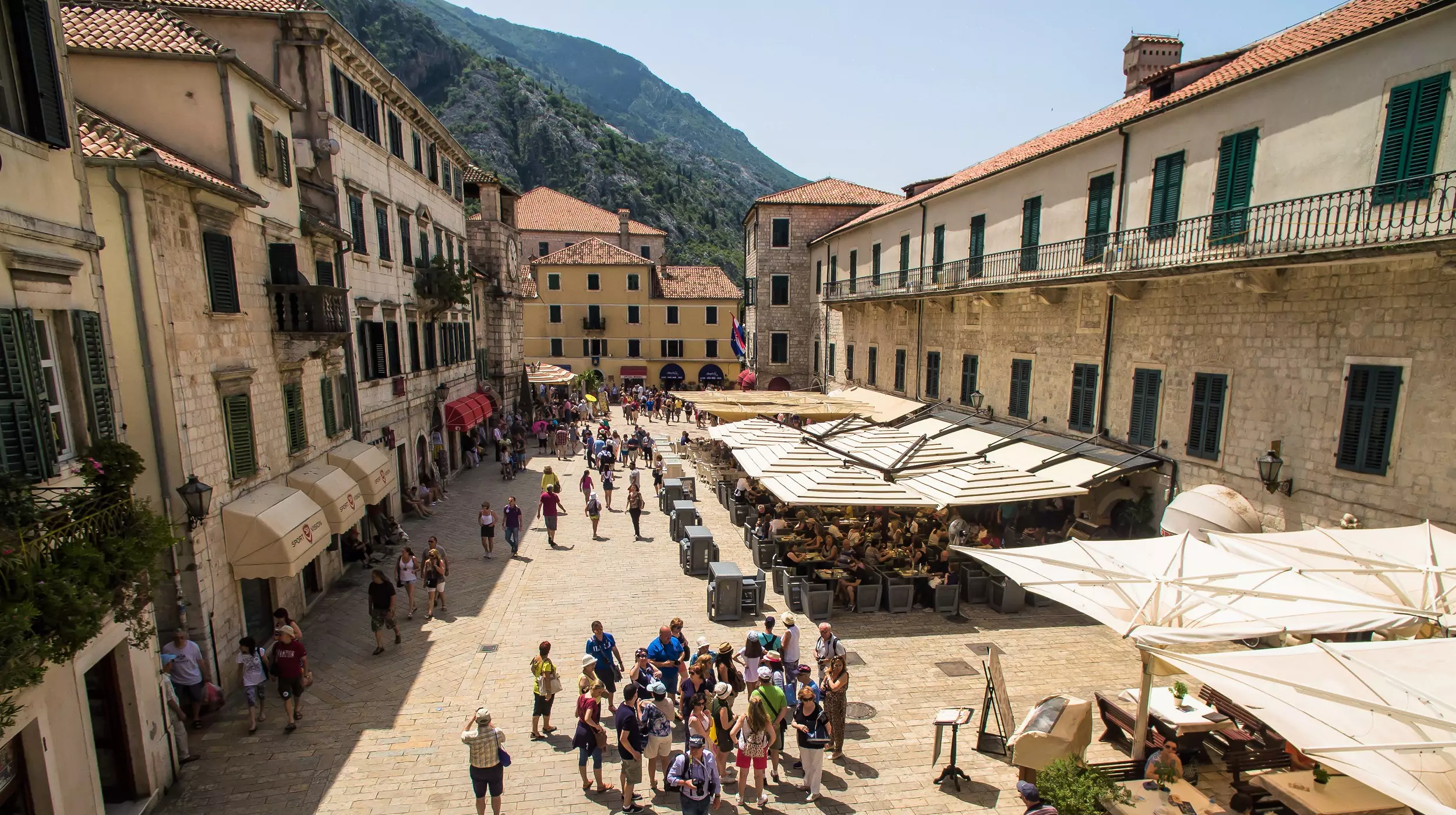
The old town of Budva
In the Old Town of Budva, go on a cultural scavenger hunt to find six churches, a carved relief on the citadel wall that connects the tragic love of two young people and the name of the town, and the collection of the Archeological Museum where you can witness the history of the Illyrians, Greeks, Romans, Slavs, Venetians and all who have come and gone here for centuries play out before your eyes. A five-minute walk along the sea shore, close to the city walls, a concrete path next to the hotel "Avala" will take you to the popular beach Mogren. Know that the city turns into a center of entertainment in the summer, with numerous restaurants within the walls, so it is perfect for sunset walks followed by a romantic dinner. From the pier, you can go on a boat trip to the island of Sveti Nikola, where you can enjoy the fascinating beaches surrounded by rich vegetation.
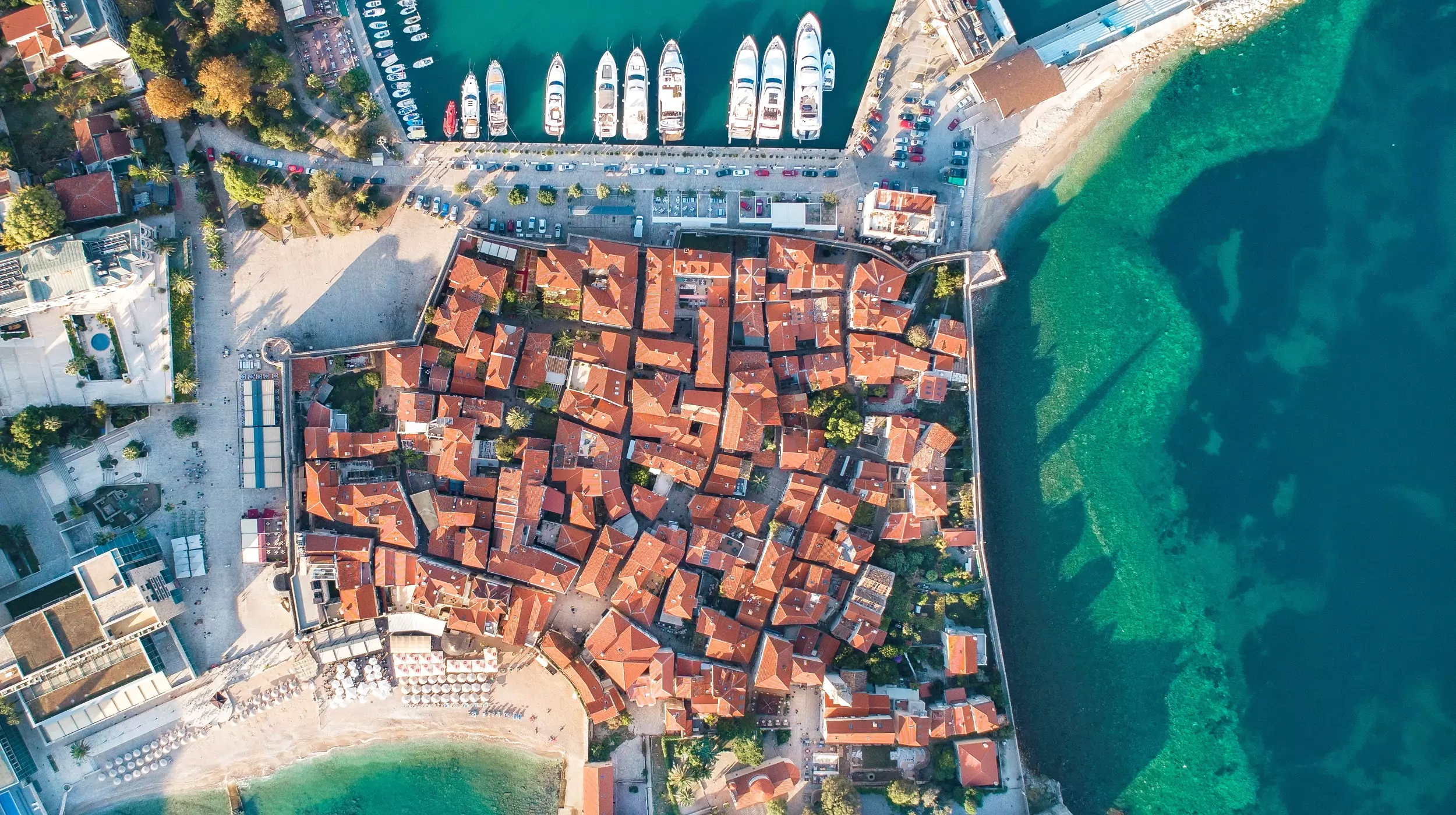
The peninsula that adorns the covers of world magazines - Sveti Stefan
If you take the Adriatic Highway from Budva to Petrovac, a 15-minute drive from the city center, on the right you will see the picturesque Sveti Stefan peninsula, which turned into a hotel city about sixty years ago. No matter how many photos you look at, none will prepare you for what you will see! You can enjoy the view of the island and walk around the surrounding beaches. However, if you decide to visit this tourist center, keep in mind that there is no daily price because the resort's offer is aimed at the rich and famous. This posh island has been visited by many stars, including Sofia Loren, Monica Vitti, Marina Vlady, Kirk Douglas, Sergei Bondarchuk, and Sylvester Stallone.
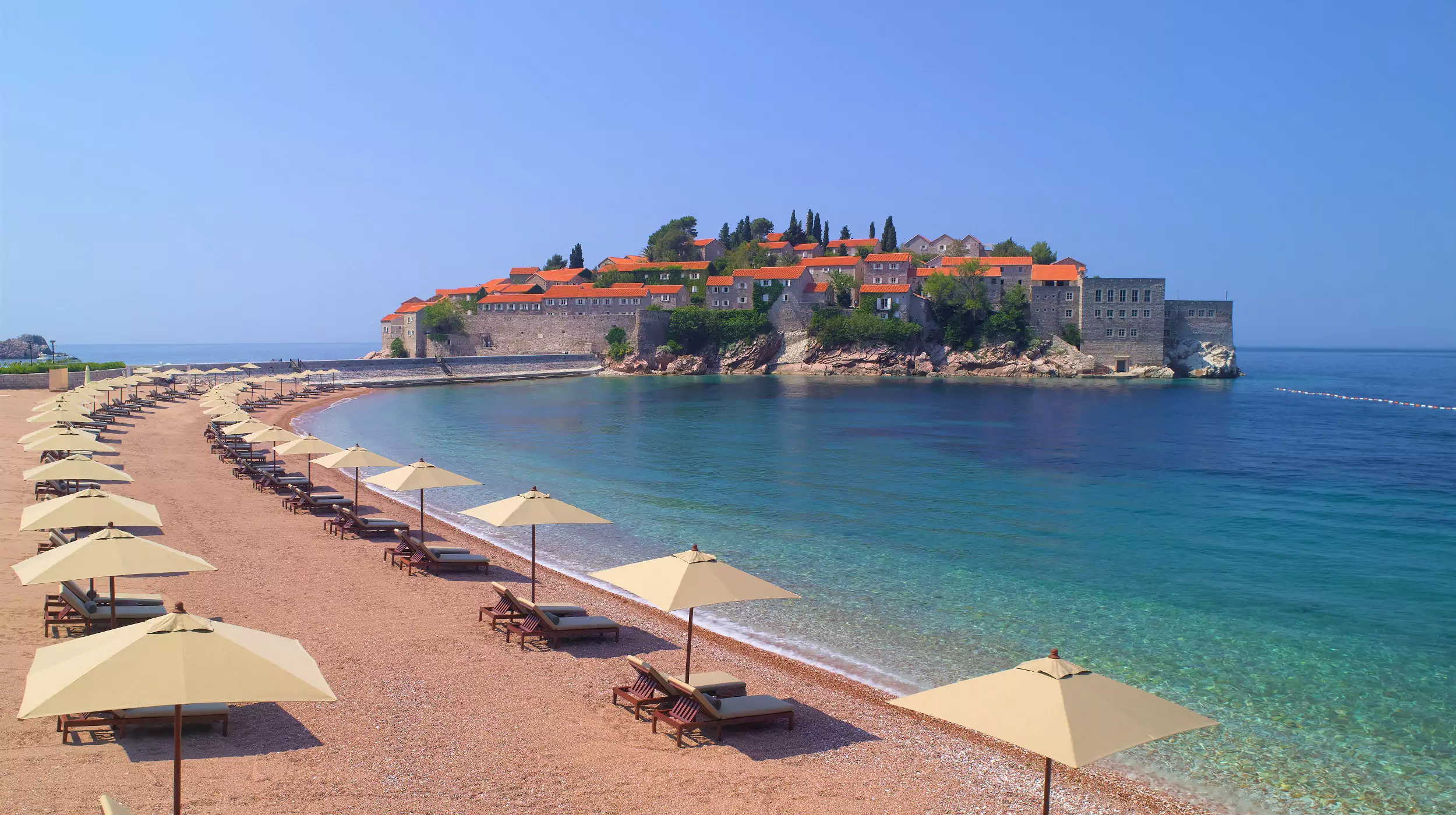
The longest beach on the Adriatic - Velika plaža
Come to Ulcinj, a 25-centuries-old city that has been home to 9 different civilizations. Although the city tour is fascinating, the most enticing feature of this locale is the longest beach on the Adriatic - Velika Plaža (Large Beach). About a twenty-minute drive separates you from this sandy beach with a special "zen" energy. Specialties of the beach include fine sand with healing properties, Mediterranean vegetation, and untouched wildlife.
If you want a special adventure, try kitesurfing , because you will find yourself in one of the most popular Mediterranean surf destinations. You can also just lounge under the canopies and relax with refreshing cocktails, or have a blast at daily beach parties . Whatever you decide, you will surely have unforgettable experiences! Near Velika Plaža, visit the island at the end of the river and the sea - Ada Bojana. This is a place that will leave you speechless.
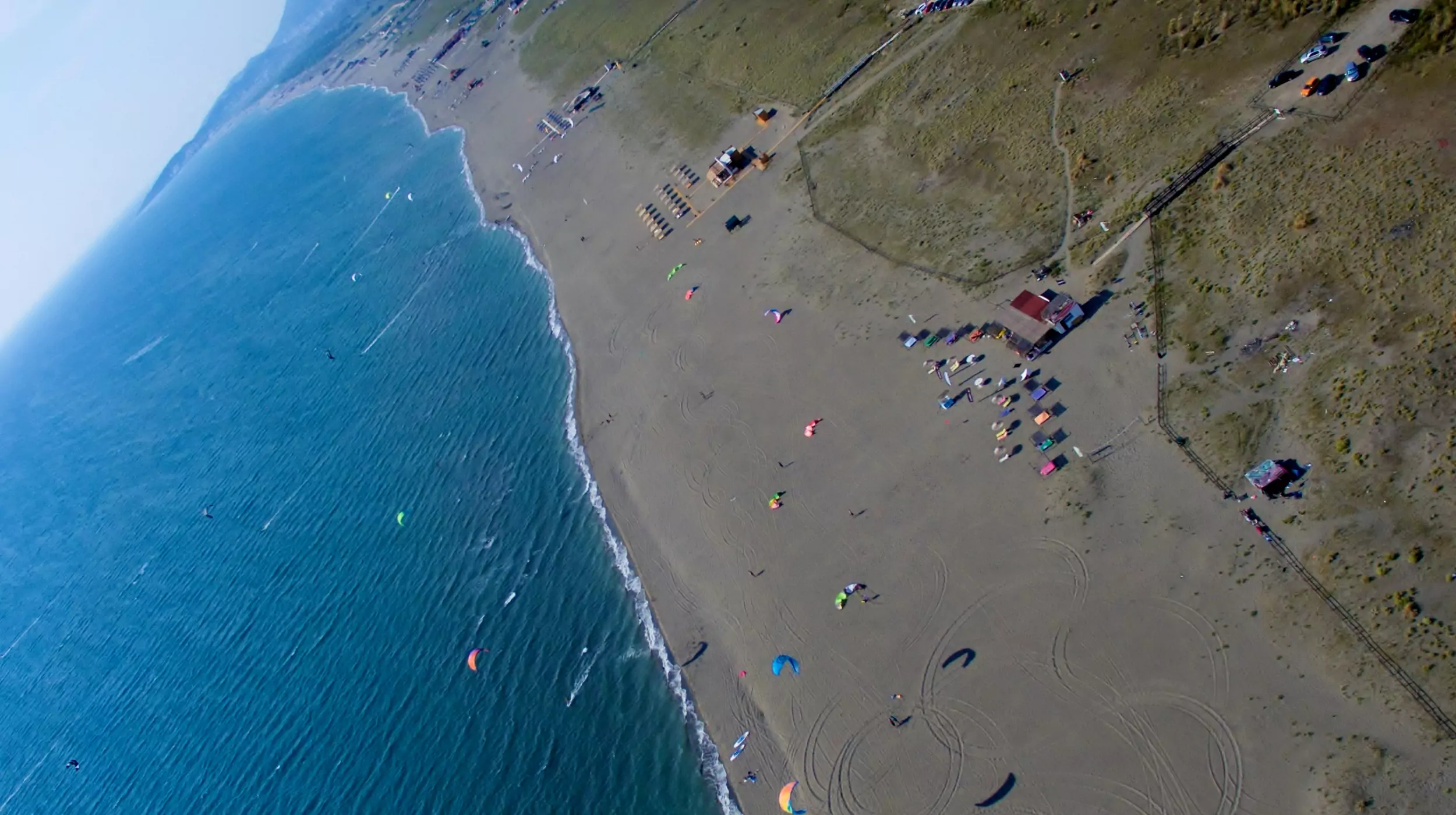
Mausoleum on Lovćen
Come to Cetinje. Take a walk through the streets of the city and discover the story of Montenegro's past through the rich tapestry of historical buildings and museums, right on the roads where the aristocrats of Europe walked. Make sure to stop at the Mausoleum of Petar II Petrović Njegoš on Jezerski Vrh (1660 m above sea level), opened in 1974. This adventure is not for the faint of heart - after a 40-minute drive (20 km), you need to conquer 461 steps leading to the Mausoleum.
Upon entering, you will witness incredible panoramic views, as well as tall statues of famous Montenegrins made of black granite and a seated figure of Njegoš with an open book - the work of the famous sculptor Ivan Meštrović - compete for your admiration. Inside the mausoleum, whose vaults are covered with a mosaic of 200,000 gilded tiles , there is a marble sarcophagus of Bishop Rada. Don't forget to take a walk to the nearby village of Njeguši - Njegoš's birthplace, where you can take a break for a traditional Montenegrin lunch.
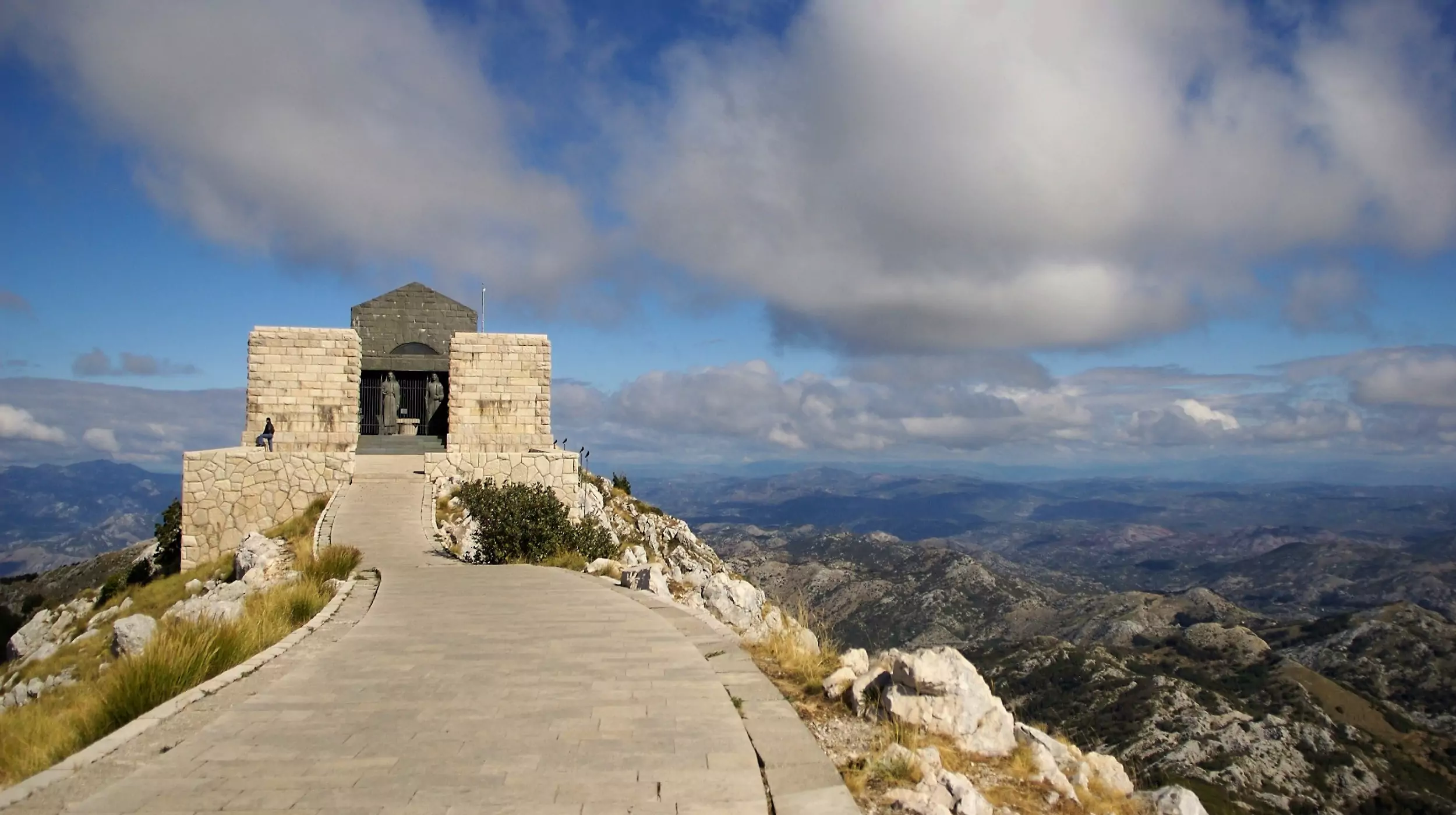
Skadar Lake National Park
This route (about 81 km in total) leads you to fascinating places on Skadar Lake and is one of the most beautiful in Montenegro. If you are leaving Podgorica, head to Virpazar. While traveling to Virpazar, take a short detour from the main road and visit the fantastic Žabljak Crnojevića ruins of a proud medieval fortified town for which Montenegrins gave their lives! In the settlement of the same name, you are greeted by history and tradition tucked away within the triangular area formed by the Karatuna River and the two branches of the Moračica River. Can you imagine the view from the fortress?
When you return to the main road, you will pass by the fishing village of Vranjina and the Lesendro fortress. Your next break is at Virpazar. Here you have space for sightseeing, breakfast (we suggest priganice, homemade cheese and honey) and ideally a boat cruise.
From Virpazar , cross the highway and go to the Crnojevića River. Picturesque lookouts await you here. The river Crnojevića is ideal for sightseeing, complete with rustic mills, small waterfalls, a cave, and an old bridge. Here you can swim on the local lake beaches and have lunch in one of the small, charming restaurants. On the way to Podgorica, stop at the most photographed place in this area - the Pavlova Strana lookout! This is a picture you will remember for a lifetime.
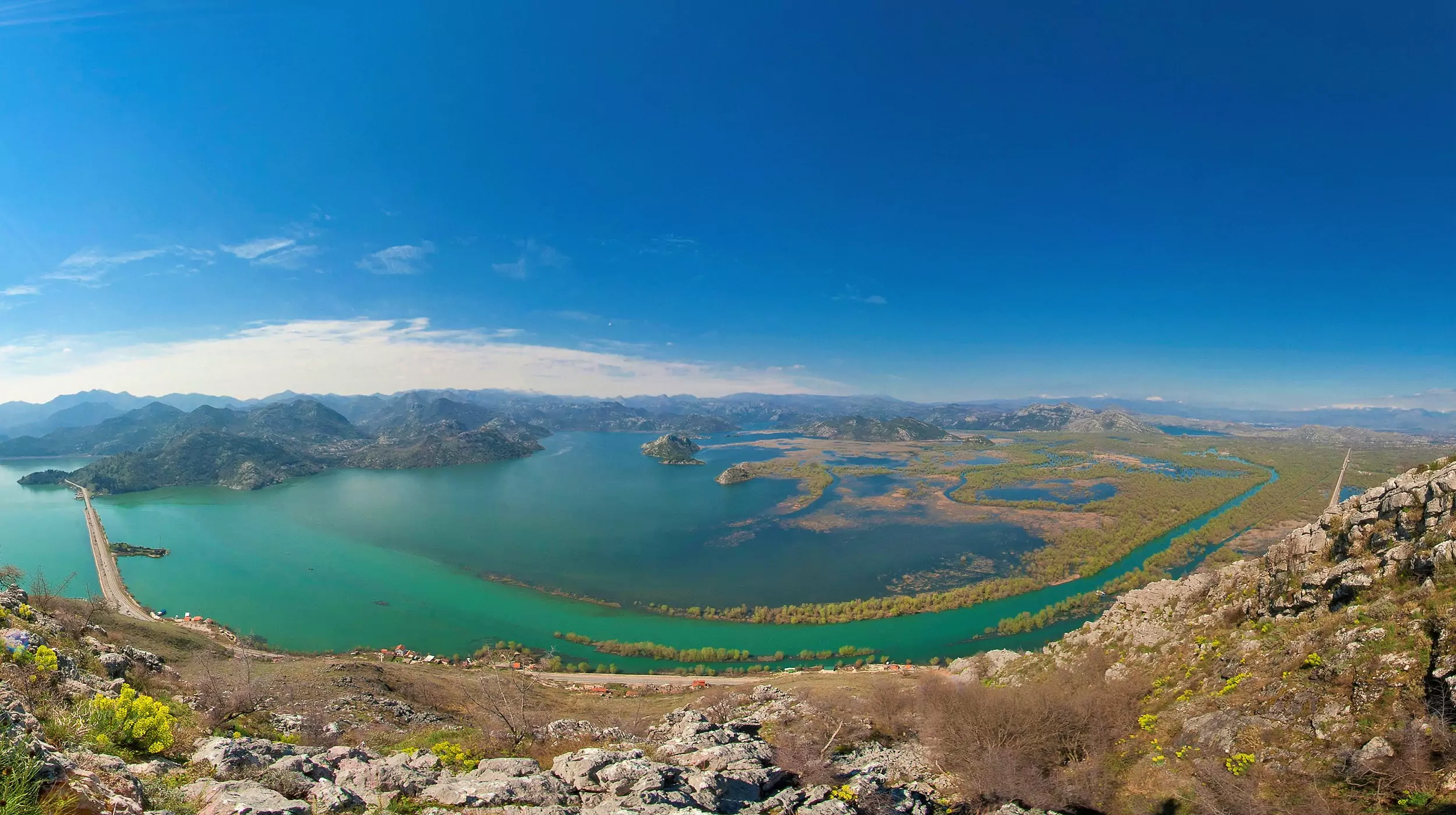
Monastery in a stone cliff at 900 m above sea level
If you are leaving Podgorica, about an hour's drive (42.5 km) to the Ostrog Monastery awaits you. Carved in a stone cliff in the mountain massif of Ostroška Greda 900 m above sea level, with a rocky mountainside opposite to it, this monastery stands out with its bright white color and the mystical energy it exudes.
Visit the Lower Monastery , which was built in 1824 on the plateau where the village church used to be, and dedicated to the Presentation of the Most Holy Mother of God.
Head on foot to the Upper Monastery (2.5 km or 40 minutes walk), where a church dedicated to the Holy Cross in 1665 was carved inside a cave in order to house the relics of St. Vasilije Ostroški, protector and healer. You will also be delighted by the colorful iconographic mosaics found both on the rocks and walls of the monastery itself, made of pieces of glass and stone. If you want, you can reach the Upper Monastery by car.
There is a boarding house in the monastery complex where you can spend the night. You will receive a bed, a pillow, a blanket and, if you wish, the spiritual advice of a priest.
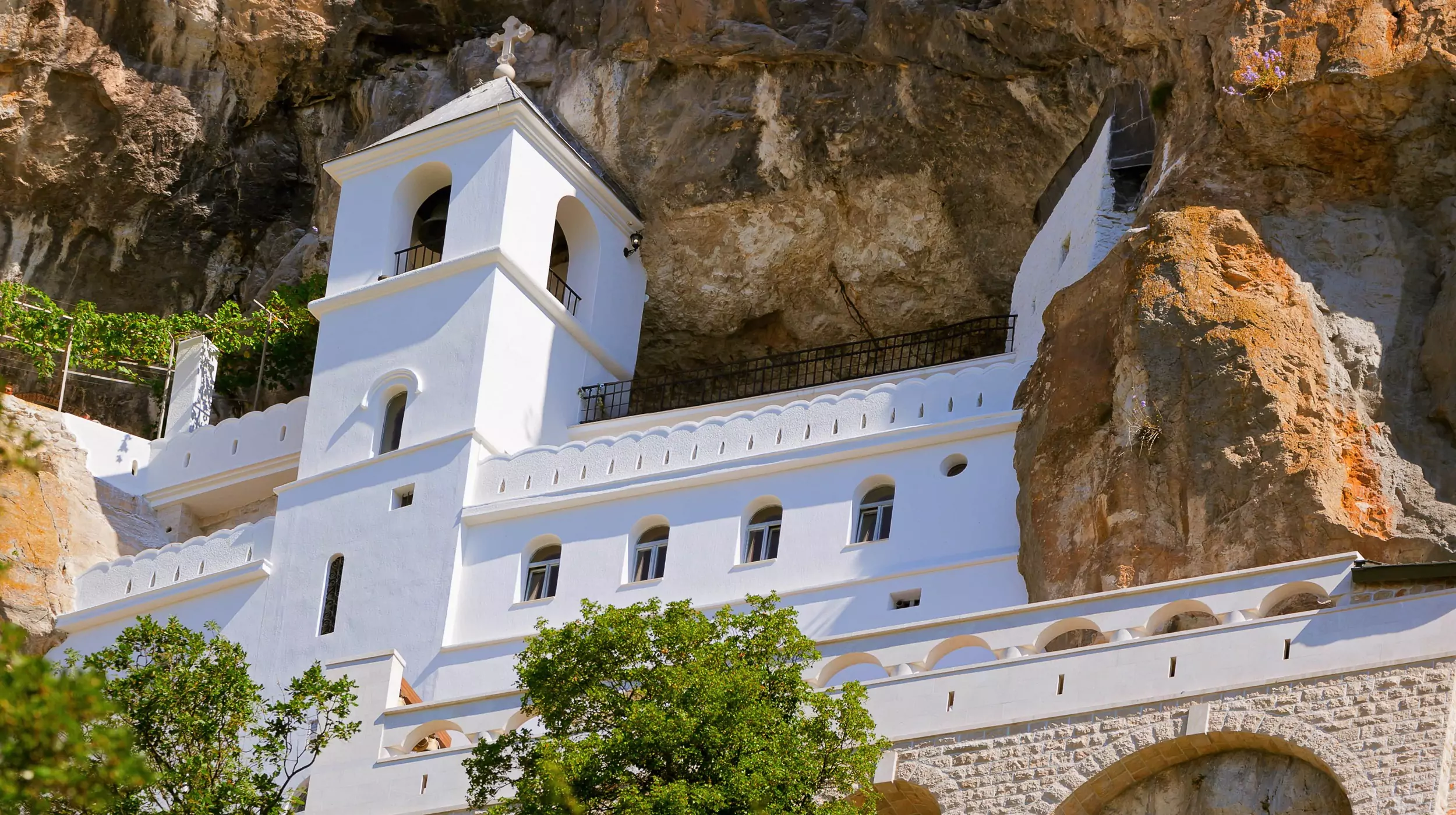
Biogradska gora National Park
About twenty kilometers away from Kolašin, tucked away on the Bjelasica mountain, the Biogradska Gora National Park offers you so much on its 5,650 hectares.
Take a walk through the primeval rainforest reserve, one of the last three remaining in Europe, and marvel at trees over 40m high and up to 500 years old.
Enjoy the landscape by casually strolling around the lake Biograd, and afterwards you can treat yourself to national dishes, prepared in restaurants around the park.
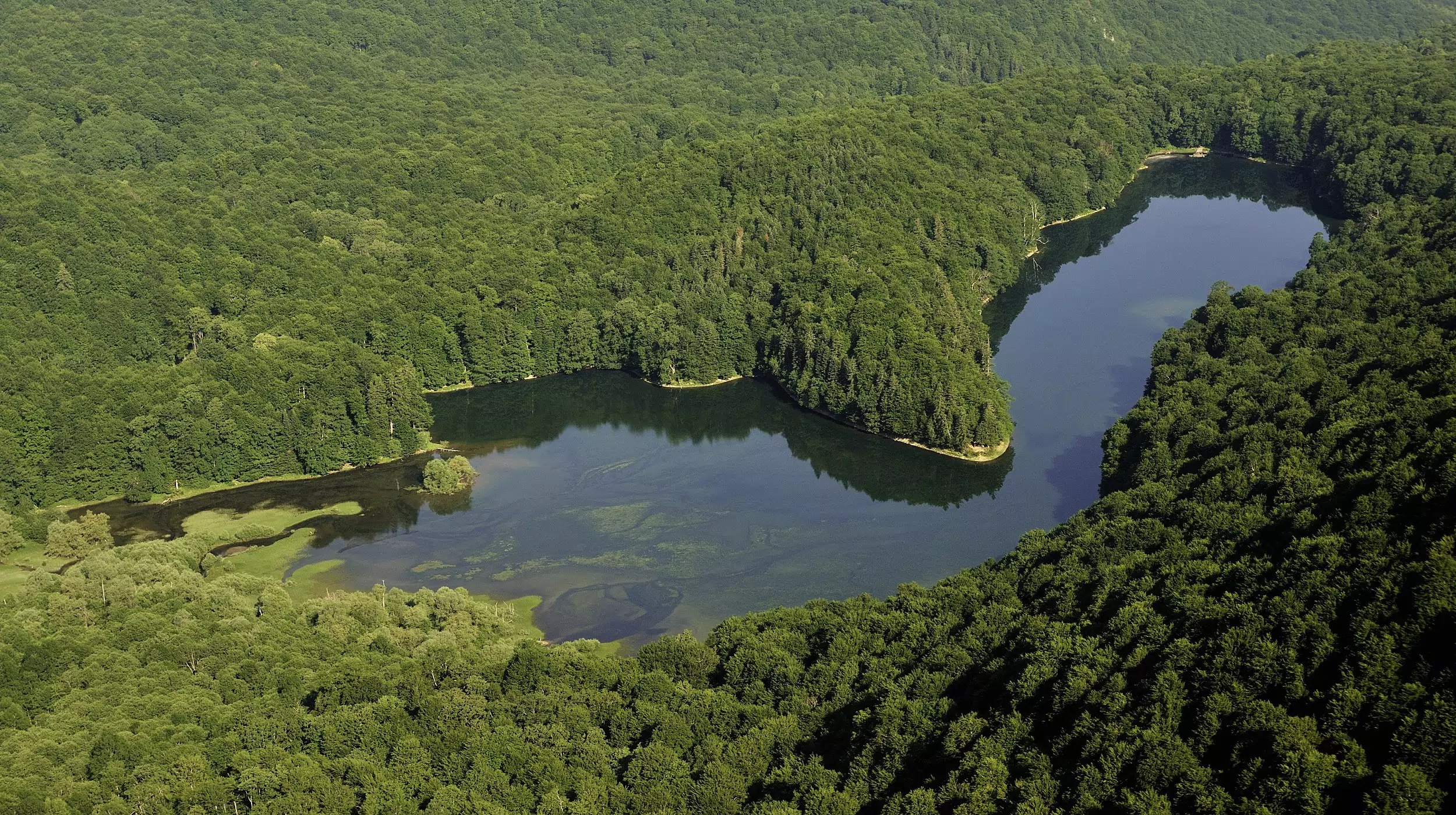
Tara Canyon - Durmitor National Park
The mighty Tara mountain river has shaped the limestone through which it passes for centuries, creating a fascinating canyon characterized by straits, huge boulders, and deep crevices. There are several ways to enjoy the beauty of the canyon, so in this part of the Durmitor area, try activities such as zip lining, rafting, hiking, etc. Rafting Tara is a particularly great experience, because you pass through the canyon which is the deepest in Europe (1,333 m) and the second deepest in the world.
The Đurđevića Tara bridge is a special attraction in and of itself, so stroll across it and enjoy the majestic landscape surrounding you.
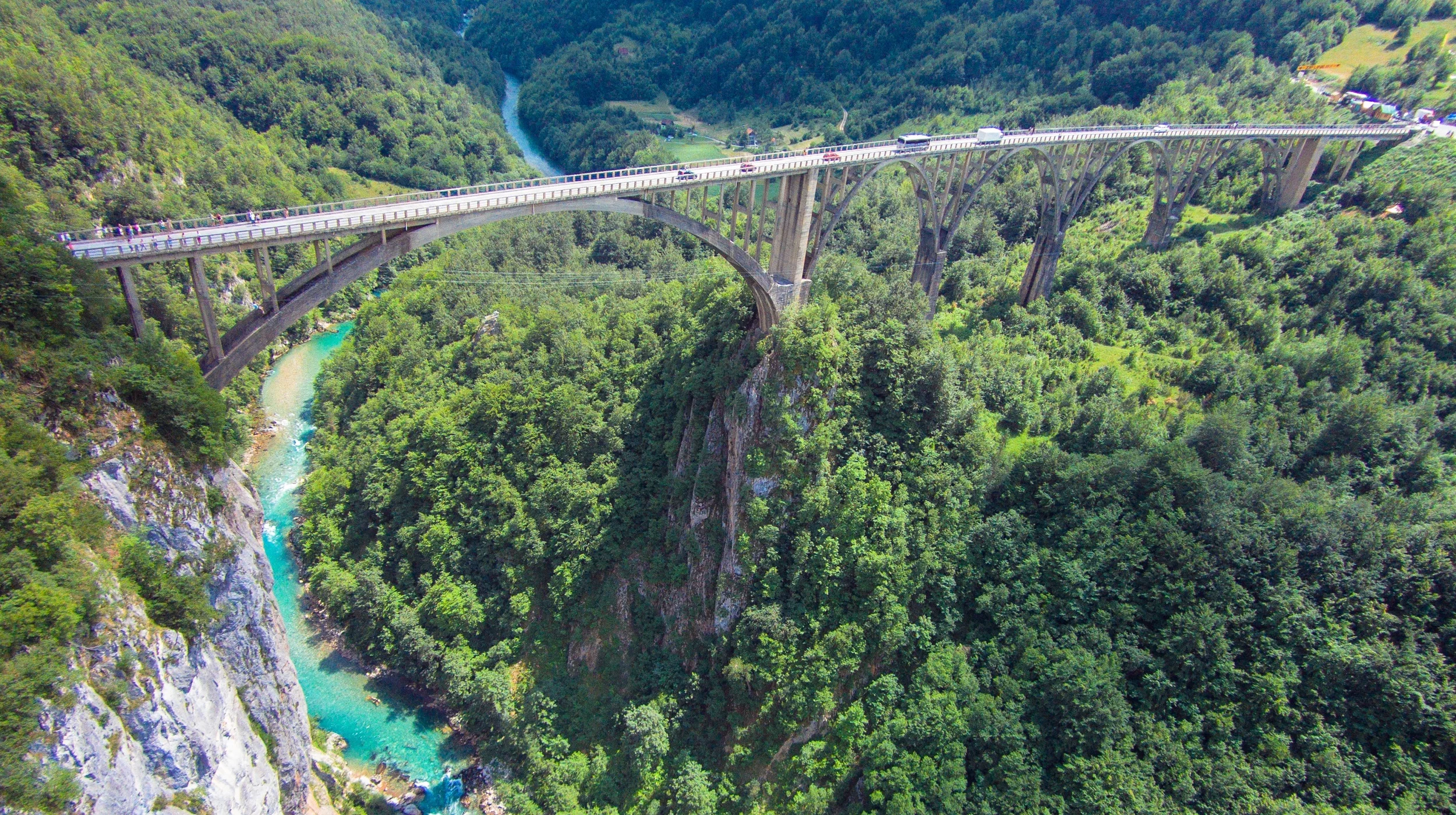
Looking for ideas for your trip?
See how others experienced their time in Montenegro. We would love hearing from you - share your Montenegro moments with following hashtag: #MontenegroWildBeauty #GoMontenegro
Discover unique Montenegro
So small you could drive across it in an afternoon. Don’t just skim through it but try to truly absorb it’s essence.
Explore destination year-round
Although small country it is incredibly diverse. See how much it can offer you:
Travel responsibly
Did you know? In 1991, the Montenegrin authorities adopted a declaration by which the country became the first ecological state in the world .
Keys for Understanding Montenegro
Eat like a local, meet cultural heritage (unesco), try organic adventure, privacy settings.
Here you will find an overview of the types of cookies used on the website. You can set your consent for each category individually.
Website accessibility CTRL + U
Keyboard shortcuts.

Montenegro Travel Guide
Last Updated: September 16, 2024
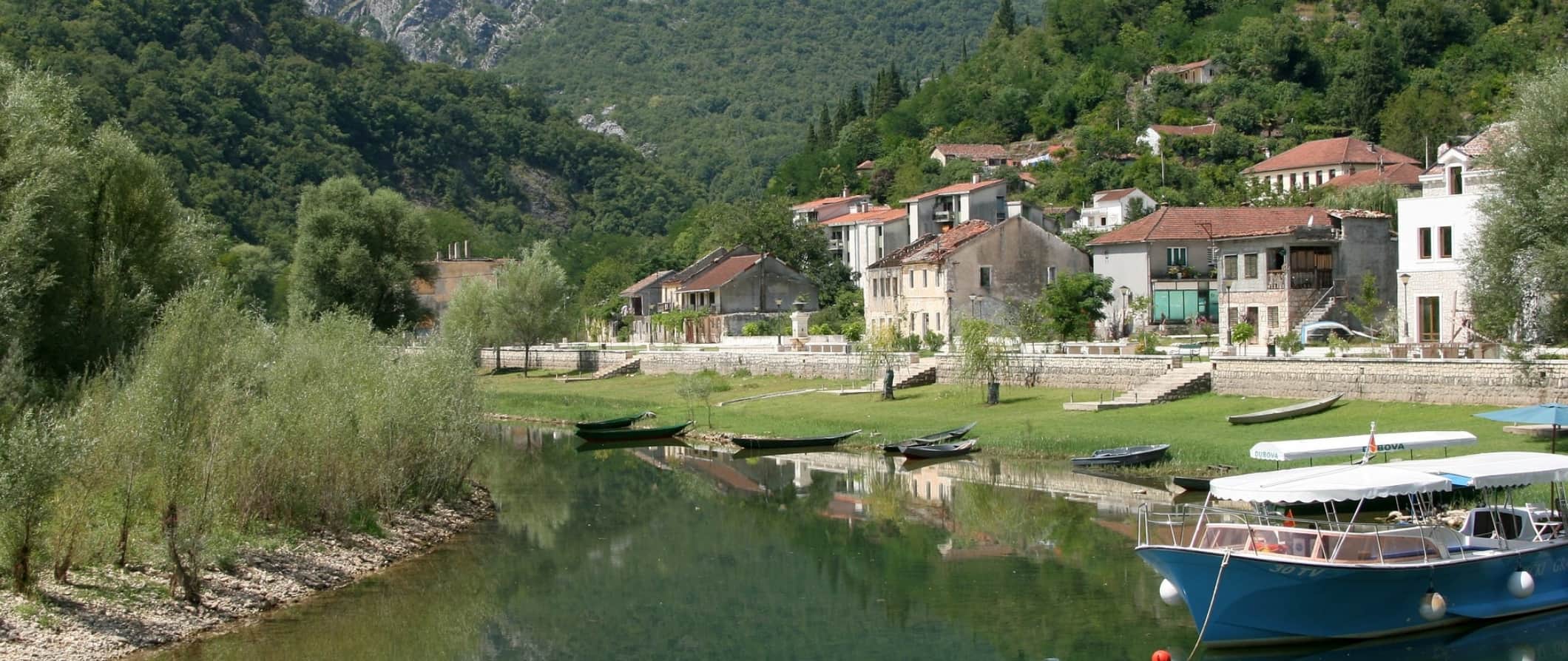
Montenegro is a tiny Balkan country home to rugged mountains, medieval towns, and miles of picturesque beaches. With just over half a million people, Montenegro has become a recent hotspot for backpackers, though it’s still overlooked by most budget travelers.
Offering idyllic gems like Kotor, with its stunning medieval architecture and fjord-like bay, as well as world-class pristine beaches stretching down the Adriatic coast, as the Balkans become one of the most up-and-coming tourist regions in Europe , Montenegro has soared in popularity, especially since it is relatively safe, small, and cheap.
I loved my visit to the country. It’s a beautiful and charming place.
This Montenegro travel guide has everything you need to know to plan your trip, save money, and make the most of your time in this overlooked and underappreciated destination!
Table of Contents
- Things to See and Do
- How to Stay Safe
- Where to Stay
- Typical Costs
- Suggested Budget
- Money-Saving Tips
- How to Get Around
- Best Places to Book Your Trip
Click Here for City Guides
Top 5 things to see and do in montenegro.
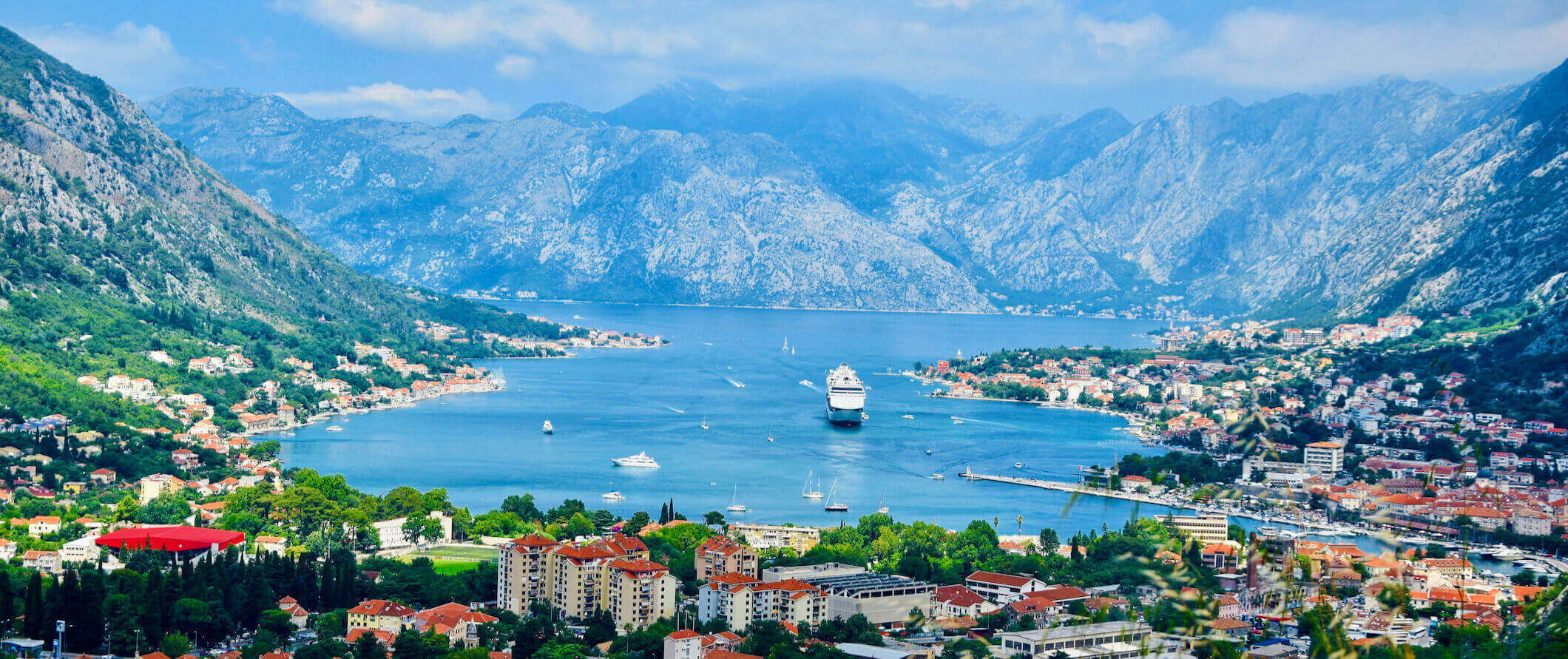
1. Explore Ulcinj
Ulcinj sits on the Adriatic coast and is best known for its long, sandy beaches. In fact, one of the longest beaches in Europe can be found here (Velika plaža). Ulcinj also has a picturesque Old Town (Stari Grad) with gorgeous narrow cobblestone streets, incredible sunset views, and tasty seafood near the city walls. A popular activity is to rent a bike and cycle to Long Beach and spend the day lounging. This beautiful coastal town is the perfect place to spend a few days relaxing and enjoying the water.
2. Hit the beach in Budva
Budva has several beaches as well as coves, cliffs, and islands you can explore. I don’t love the main town itself but the area is incredible. The city is 2,500 years old and a bit of a labyrinth of old narrow streets but it’s definitely a cool place to wander around. Don’t miss the Citadela Fortress, constructed to protect Budva from invaders. Today, the fortress is also a great place to grab a drink and enjoy the scenic views. The Budva Riviera highlights include Jaz Beach, Becici Beach, and Kamenovo Beach. If you want to get away from the main beach crowds, take a boat out to Sveti Nikola, a nearby island, to find incredible turquoise pebble beaches on the shores of a towering cliff. Bring your beach shoes!
3. Visit Kotor
Montenegro is full of beautiful coastal towns, but none are quite as dramatic as Kotor. Home to exquisite sea and mountain scenery as well as historic architecture, the entire town has been declared a UNESCO World Heritage Site. It’s one of the most popular places in the country. This 2000-year-old town has several main attractions including its Old City Wall, fortress San Giovanni, the beautiful Cathedral of St. Tryphon, and the Maritime Museum. Kotor has incredible cuisine due to centuries of influence from the Greeks, Ottomans, the Austro-Hungary empire, and many others. Try local dishes such as rice-stuffed calamari, lamb with peas, and grilled fish. Don’t forget to try the local wines like Krstac, Kratošija, Žižak, and Vranac, as Montenegro is well known for its 50 types of wine and this is a great place to try some.
4. Go hiking in Durmitor National Park
With its sweeping views of forests, lakes, and waterfalls, and the largest canyon in Europe, Durmitor is a nature lover’s dream. The national park makes the perfect outdoor adventure spot for hikers as there are glacial lakes, 50 different peaks, and plenty of beautiful trails to choose from. Some of the most famous hikes include the easy Black Lake and Zminje Lake hike, the moderate Prutaš peak (2,393 meters/7,851 feet), and the hardest, highest peak of Bobotov Kuk (2,523 meters/8,277 feet). Funky Tours offers day trips starting at around 70 EUR including transportation and lunch. Tara Canyon is absolutely stunning, with crystal blue waters surrounded by both rocky shores and tree-lined slopes. And if hiking isn’t your thing, Durmitor is also one of the world’s best locations for climbing and rafting. They also have an adrenaline park in case you want to check out the spectacular scenery from the comfort of a zip line, dirt bike, or ATV. Admission to the nature park is just 3 EUR.
5. Take a wine tour
A visit to Montenegro’s best wine-producing region, Crmnica, is a must for wine lovers, especially since there are so many award-winning varieties here. If you want to try some of the best wineries, there are 22 little villages in Crmnica but two of the most well-known are Godinje and Virpazar on Skadar Lake. You can try delicious wines paired with local cheese, olives, nuts, cured ham, and honey. Located in the south, many wineries here also offer tastings of homemade rakija , a popular Balkan brandy. Tours cost around 15-40 EUR (around 50 EUR or more if they include transportation).
Other Things to See and Do in Montenegro
1. go rafting.
Rafting on the Tara River is one of the most popular outdoor activities in Montenegro. Known as the “Tear of Europe,” the river is the fastest in Europe and forms the second deepest canyon in the world (the first being the Grand Canyon) and you can go rafting in easy and moderate conditions while taking in the incredible beauty of the canyon. Prices start at 40-50 EUR for one day of rafting, 70 EUR for two days, and 100 EUR for canyoning. There are multi-day rafting and canyoning combo trips available too.
2. Hike Lovcen Mountain
Lovcen is more than just a mountain to the people of Montenegro, it’s a sacred place and national treasure. Located in the southwest one hour from Kotor, the mountains contain the mausoleum of Petar II Petrovic-Njegoš, a beloved Montenegrin ruler. There is also a national park here with hiking trails, including a day-long hike to Kotor. Admission is 2 EUR. If you have time, head to the nearby village of Njeguši to enjoy some local cheese and smoked ham.
3. Relax at Lake Skadar
Lake Skadar, also known as Lake Shkodër in Albanian, is located in the south along the border with Albania and is the largest lake in southern Europe. There is plenty to see and do here, such as visiting the ancient island prisons and monasteries, exploring the National Park and bird reserves, relaxing on one of the private beaches, and taking a swim in the crystal-clear waters of the lake. Expect to pay around 25 EUR for a one-hour boat rental or 5 EUR per hour for a kayak. Lake cruises start at around 15 EUR.
4. Visit the National Museum of Montenegro
The National Museum of Montenegro is located in Cetinje, the country’s historic capital (the current capital is Podgorica). Established in 1896, it’s composed of several different museums and galleries in one complex. Two of the most popular museums are the Museum of History and the Art Museum. You can easily spend a full day here taking in the exhibitions and learning about the country’s history. Collective tickets cost 8-15 EUR while individual museum tickets are 3 EUR. Cetinje itself, a 15th-century town and also a great place to spend a morning or an afternoon. You can visit the Cetinje Monastery, with its collection of Early-Christian-era relics, and the 15th-century Vlah Church. Also, near Cetinje is Lipa Cave, one of the largest caves in Montenegro.
5. Enjoy the history of Stari Bar
Located in the southwest, this town was once ruled by the Byzantines. Its ruined fortress offers one of the most beautiful views in Montenegro thanks to the stunning backdrop of Mount Rumija. The town itself has been the site of many battles (chiefly against the Ottomans) so it’s been destroyed and rebuilt many times over. There are also the ruins of a 13th-century Franciscan monastery, an 18th-century Turkish bathhouse, and the oldest olive tree in the world (it’s over 2,000 years old). It is just an hour south of Kotor by car.
6. Watch the sunset in Sveti Stefan
Sveti Stefan is a 15th-century village just south of Kotor. Located on the coast, it has a postcard-perfect pink pebbled beach and beautiful clear blue water. While you can’t access the nearby island without staying at the five-star resort that occupies it, the beaches here are perfect for a late afternoon swim and for watching the sunset over the Adriatic Sea. Don’t miss the 600-year-old Praskvica Monastery that overlooks the village.
7. Hit the slopes
Thanks to an average of 120 days of snow each year, Montenegro is the perfect winter sports destination. The ski resorts in Montenegro sit at altitudes of up to 2,181 meters (7,155 feet) and there are over 20 kilometers (12 miles) of slopes to enjoy. The most popular resorts are Savin Kuk on Durmitor mountain or Kolasin 1450 on Bjelasica mountain. Lift passes are some of the cheapest in Europe, ranging from 10-25 EUR per day.
8. Visit the Cat Museum
For a more unconventional museum experience, visit Kotor’s Cat Museum (Museo del Gatto di Cattaro). Located in the Old Town, this small museum is dedicated to cats. It explores the history of Montenegro’s feline friends as Kotor has a noticeably high cat population thanks to its history as a trading port. Cats from all around the world traveled here on ships and were subsequently abandoned. They became an important part of the culture of the city. Admission is 1 EUR and helps support local stray cats.
9. See the Castle of San Giovanni
San Giovanni Fortress in Kotor is one of the city’s historic fortifications. Perched almost 300 meters (984 feet) above sea level, the castle has a taxing 1,355 steps you have to climb to get to it (which takes about an hour). The fortress, also known as St. John’s Fortress, is a UNESCO Heritage Site and dates to the 9th century. It’s one of the best historic remnants in the city. It’s mostly crumbled now, but there are several stone walls, fortifications, and foundations still in place. There are also over 4.5 kilometers (2.8 miles) of defensive walls, some of which are 20 meters (65 feet) tall. There are several viewpoints on the hike too. The admission price through the gate is about 9.50 EUR.
10. Explore the Blue Cave
Located on the Luštica Peninsula just 22 kilometers (13 miles) from Kotor, the famous Blue Cave of Montenegro is only accessible by boat on an organized tour from either Herceg Novi or Kotor. It’s named after the iridescent blue light that shines brightly within the cave. For a 1-2 hour tour of the blue cave (plus other nearby caves) expect to pay around 40-60 EUR per person.
11. Day trip to Perast
Just 20 minutes from Kotor, this stunning village is worth more than the half-day that most people give it (although if that’s all the time you have, it’s better than nothing!). There are 20 Baroque palazzi and 18 churches to see here, including the Church of St. Nicholas and its 55-meter (180-foot) Perast Bell Tower which you can climb to get an excellent view of the town. There’s also a Maritime History Museum here, and if you’re in the mood to relax, there’s a beautiful beach as well as boat tours around the Bay of Kotor.
How to Stay Safe in Montenegro
Although Montenegro is a relatively safe country, scams and pickpocketing can occur, especially in Kotor, Budva, Sveti Stefan, and Herceg Novi. Be vigilant in tourist areas and while on crowded public transportation and always keep your valuables secure and out of sight.
If you have a purse or shoulder bag, wear it across your body and not just over one shoulder so it can’t be easily torn off and stolen.
Solo female travelers should generally feel safe here, however, the standard precautions apply (never leave your drink unattended at the bar, never walk home alone intoxicated, etc.).
If you’re renting a car, be aware that many of the roads are in rough condition. Drive slowly and cautiously — even if the locals aren’t. Additionally, don’t leave any valuables in your vehicle overnight. While break-ins are rare, it’s better to be safe than sorry.
If you’re checking a bag on a bus, don’t leave any valuables in it just in case it gets taken or misplaced.
If you’re doing any mountainous hikes, be sure to check the weather in advance and bring appropriate gear/clothing. It’s colder and windier at higher altitudes.
Unfortunately, organized crime has a strong foothold here. While the majority of their activities won’t impact you, some beggars have been known to take part in schemes wherein they provide information to thieves and pickpockets based on who gives them money. Don’t give money to beggars to avoid complications.
You can read about common travel scams to avoid here.
There are a lot of unexploded land mines near the border with Kosovo. If you are exploring that area, be sure to stick to the main roads and don’t head off into the brush.
If you experience an emergency, dial 122 for assistance.
The most important piece of advice I can offer is to purchase good travel insurance. Travel insurance protects you against illness, injury, theft, and cancellations. It’s comprehensive protection in case anything goes wrong. I never go on a trip without it as I’ve had to use it many times in the past. You can use the widget below to find the policy right for you:
Where to Stay in Montenegro
Even though Montenegro is small there are tons of hostels around the country. Here are some of my favorite places to stay in Montenegro:
- Hostel Anton (Tivat)
- Pupa Hostel (Kotor)
- Hostel Centrum (Kotor)
- Old Town Hostel (Kotor)
- Freedom Hostel (Budva)
- Hostel Center (Ulcinj)
Montenegro Travel Costs
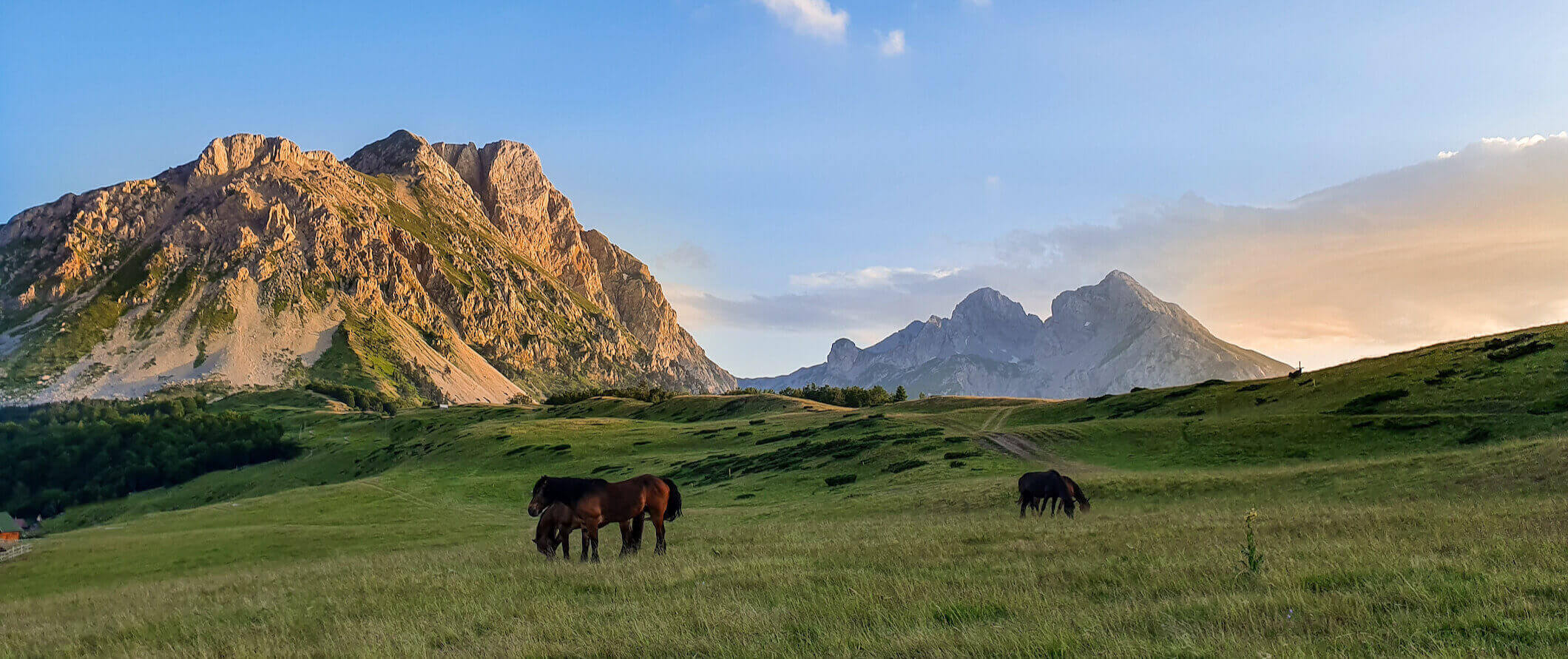
Accommodation
- Hostel dorms – 12 EUR per night
- Hostel private rooms – 40 EUR per night
- Budget hotels – 25-60 EUR per night
- Airbnb private rooms – 20-25 EUR per night
- Airbnb apartments – 40-65 EUR per night
- Campsite – 14-20 EUR per night (wild camping is illegal)
- Street food – 2 EUR
- Sit-down restaurants – 6-15 EUR
- Fast food (think McDonald’s) – 5-6 EUR
- Beer – 2 EUR
- Cappuccino/latte – 1.50 EUR
- Bottled water – 1 EUR
- Groceries for a week – 25-35 EUR
Montenegro Suggested Budgets
Backpacker – 40 eur per day.
On a backpacker budget, you can stay in a hostel dorm, cook all of your meals, limit your drinking, take public transportation to get around, and stick to mostly free activities like relaxing at the beach or hiking. If you plan on drinking, add 5-10 EUR to your daily budget.
Midrange – 95 EUR Per Day
On a midrange budget, you can stay in a private Airbnb or budget hotel. You’ll be able to eat out for most of your meals, enjoy a few drinks, take the occasional taxi to get around, and do more paid activities like rafting or canyoning.
Upscale – 185 EUR Per Day
On a “luxury” budget, you can stay in a hotel, eat out for all your meals, drink more, rent a car or take more taxis, and do whatever tours and activities you want. This is just the ground floor for luxury though.
Montenegro Travel Guide: Money-Saving Tips
Montenegro is affordable so you won’t break the bank here unless you want to splash out. That said, it never hurts to save more money! Here are a few ways to save while you’re traveling Montenegro:
Bring a water bottle – The tap water here is generally safe to drink so bring a reusable water bottle to save money and reduce your plastic use. LifeStraw is my go-to brand as their bottles have built-in filters to ensure your water is always clean and safe.
Take a free walking tour – Kotor and Budva both offer free walking tours. They’re my favorite way to get familiar with a new city and culture while connecting with a local guide who can answer all my questions. Just be sure to tip your guide at the end!
Cook your own meals – Many hostels here have kitchen facilities so if you want to save money make sure you book accommodation with a kitchen. Buying groceries may not be glamorous but it definitely saves you money!
Stay with a local – Staying with a local via Couchsurfing is a great way to save money and connect with a knowledgeable local who can share their insider tips and advice.
Walk everywhere – Most of the major towns and cities in Montenegro are walkable. Skip the public transportation if you want to save a few euros. And definitely skip the taxis!
Enjoy the free spaces – There are plenty of free parks as well as many free hiking trails around the country. Save your money and enjoy the outdoors for free.
How to Get Around in Montenegro
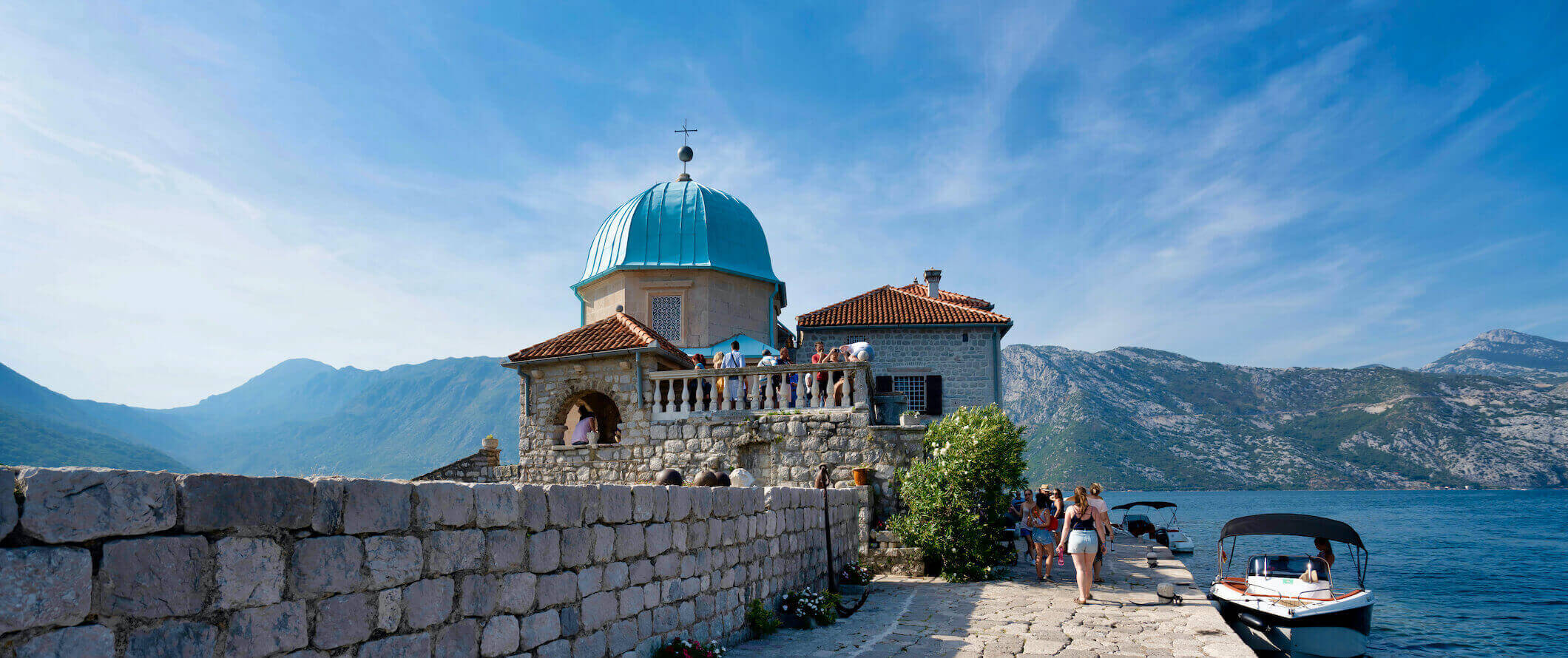
Public transportation – Public transportation prices vary by city, but expect to pay around 1 EUR for a standard adult bus ticket.
Bus – Montenegro has an extensive intercity bus network that is comfortable and reliable. You can often save money by buying your ticket directly from the driver as prices are sometimes cheaper when buying tickets right as you’re looking to leave. However, if you are traveling during the summer, it’s worth booking in advance to ensure you get a seat.
The bus from Kotor to Budva takes around an hour and costs as little as 5 EUR while the bus from Kotor to Ulcinj takes around 4.5 hours and costs around 10 EUR. Kotor to Dubrovnik, Croatia takes around 3-4 hours and costs 19-25 EUR.
Taxi – Taxis fares in Montenegro start at 1 EUR and go up by around 0.80 EUR per kilometer. Since they can add up fast, I’d skip the taxis if you can.
Train – The railway in Montenegro is old and not modernized at all. I would not advise train travel within Montenegro as the buses are nicer, faster, and far more reliable.
To enter and exit Montenegro, Montenegro Railways has a service that takes you north into Serbia all the way to Belgrade. It’s a 10-hour trip and costs around 29 EUR.
Flying – There are no domestic flights within Montenegro.
Car rental – Car rentals can be as low as 15-20 EUR per day for a multi-day rental. Just make sure you have an International Driving Permit (IDP) as you need one to rent a vehicle. Also, be aware that the roads here are in rough shape and that drivers can be on the aggressive side.
For the best car rental prices, use Discover Cars .
Hitchhiking – Hitchhiking in Montenegro is possible, but it can be rather slow as many of the roads are winding and mountainous. Expect long waits between rides — especially outside the main summer months. HitchWiki is the best website for more hitchhiking info.

When to Go to Montenegro
The best time to visit Montenegro is between April and September. Peak season is July and August when the weather is warmest. Daily highs in the summer are usually around 31°C (89°F).
If you’re on a budget and want to beat the summer crowds, the best time to visit is either June or September. You still have the heat but there are fewer crowds and it’s not sweltering. For hiking and outdoor activities, consider September-October as the national parks look particularly pretty as the leaves change.
Winters are cold, especially if you go inland where there is more of a sub-alpine climate, offering heavy rainfall and snow. Unless you plan on skiing, I’d avoid visiting in the winter.
Montenegro Travel Guide: The Best Booking Resources
These are my favorite companies to use when I travel. They consistently have the best deals, offer world-class customer service and great value, and overall, are better than their competitors. They are the companies I use the most and are always the starting point in my search for travel deals.
- Skyscanner – Skyscanner is my favorite flight search engine. They search small websites and budget airlines that larger search sites tend to miss. They are hands down the number one place to start.
- Hostelworld – This is the best hostel accommodation site out there with the largest inventory, best search interface, and widest availability.
- Booking.com – The best all around booking site that constantly provides the cheapest and lowest rates. They have the widest selection of budget accommodation. In all my tests, they’ve always had the cheapest rates out of all the booking websites.
- HostelPass – This new card gives you up to 20% off hostels throughout Europe. It’s a great way to save money. They’re constantly adding new hostels too. I’ve always wanted something like this and glad it finallt exists.
- Get Your Guide – Get Your Guide is a huge online marketplace for tours and excursions. They have tons of tour options available in cities all around the world, including everything from cooking classes, walking tours, street art lessons, and more!
- The Man in Seat 61 – This website is the ultimate guide to train travel anywhere in the world. They have the most comprehensive information on routes, times, prices, and train conditions. If you are planning a long train journey or some epic train trip, consult this site.
- Rome2Rio – This website allows you to see how to get from point A to point B the best and cheapest way possible. It will give you all the bus, train, plane, or boat routes that can get you there as well as how much they cost.
- FlixBus – Flixbus has routes between 20 European countries with prices starting as low 5 EUR! Their buses include WiFi, electrical outlets, a free checked bag.
- SafetyWing – Safety Wing offers convenient and affordable plans tailored to digital nomads and long-term travelers. They have cheap monthly plans, great customer service, and an easy-to-use claims process that makes it perfect for those on the road.
- LifeStraw – My go-to company for reusable water bottles with built-in filters so you can ensure your drinking water is always clean and safe.
- Unbound Merino – They make lightweight, durable, easy-to-clean travel clothing.
- Top Travel Credit Cards – Points are the best way to cut down travel expenses. Here’s my favorite point earning credit cards so you can get free travel!
GET YOUR FREE TRAVEL STARTER KIT
Enter your email and get planning cheatsheets including a step by step checklist, packing list, tips cheat sheet, and more so you can plan like a pro!

- Where To Stay
- Transportation
- Booking Resources
- Related Blogs
More destinations you need to see

- Itineraries
- All Planning Tips
- Attractions
- Private Tours
- Destinations
- National Parks
- All Things To Do
- Villas and Apartments
- All Accommodation
- Herceg Novi
- All Restaurants
Montenegro Pulse contains affiliate links and is a member of the Amazon Services LLC Associates Program. If you make a purchase using one of these links, I may receive compensation at no extra cost to you. See my disclaimer for more information.
Visit Montenegro: Everything You Need to Plan the Perfect Trip
Ready to visit Montenegro? This former Yugoslav republic is stepping into the spotlight and now is the time to visit this hidden gem.
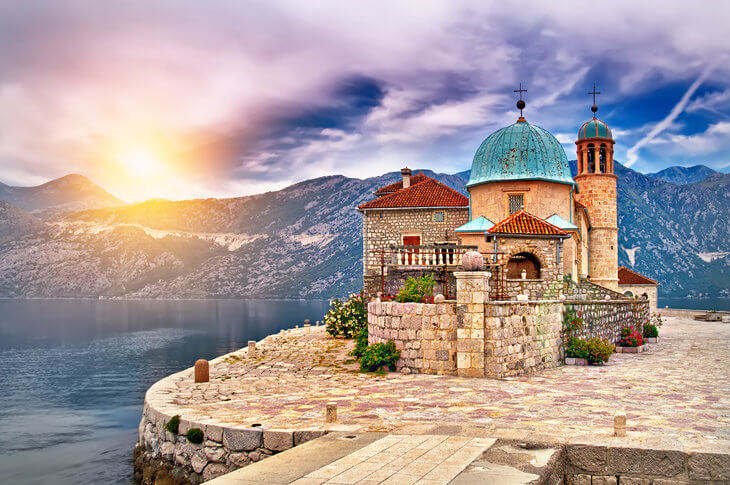
There's no better time to visit Montenegro.
Until recently this tiny country remained one of the last hidden gems of Europe. But now it takes its place as one of the fastest-growing tourist destinations in the world.
And with good reason.
Whether it's the warm weather, old-world charm, the excitement of exploring a relatively undiscovered destination or the stunning scenery, there are so many ways Montenegro can deliver your dream holiday this year.
Are you ready to visit Montenegro? This is where you'll find everything you need to know to plan your trip.
Travel to Montenegro
Getting around montenegro, climate of montenegro, culture and living in montenegro, what you should know before you visit montenegro.
Montenegro Deals: Discounted Tours and Sales - Save money on your trip with these Montenegro deals on packages and tours!
Where is Montenegro? Where It is and Where to Stay - Where is Montenegro? Find out where Montenegro is and which are the best destinations in this Mediterranean hidden gem.
How to Get to Montenegro: Top 5 Easiest and Most Affordable Ways - Wondering how to get to Montenegro? Discover the top 5 easiest and most affordable ways to get to Montenegro, whether you're flying, driving, or taking a bus.
Flights to Montenegro: 2024 Airlines and Flights - When you're booking flights to Montenegro, use my top tips for saving time and money on your trip.
Montenegro Airports - Montenegro has two international airports, one in the capital of Podgorica and one on the coast in Tivat. But, with more airports in neighbouring countries, you have many options for flying into Montenegro.
Podgorica Airport: Everything You Need to Know - Podgorica Airport is in Montenegro's capital city and welcomes over 1 million travellers per year. Find out everything you need to know about travelling to Montenegro's busiest airport.
How to Get from Dubrovnik Airport to Montenegro: A Step-by-Step Guide - Find the best way to travel from Dubrovnik Airport to Montenegro with this step-by-step guide that covers all you need to know.
Montenegro Croatia Border: The Ultimate Guide - Flying into Dubrovnik and driving into Montenegro is one of the most popular ways to get here. Make sure you're prepared with everything you need to know about crossing the Montenegro-Croatia border.
WayAway Review: A Candid Review of the Trending Travel App - WayAway is a new way to book all your travel arrangements while earning cashbacks on all your bookings.
Montenegro Visa Information - Find out whether you need a visa to visit Montenegro and where to apply for one.
Renting a Car in Montenegro: Ultimate Guide To Montenegro Car Hire - Explore Montenegro at your own pace with a rental car. Make the most of your time here and stop at as many scenic vistas as you like!
Do You Need a Car in Montenegro? Making the Right Choice for Your Trip - Do you need a car in Montenegro? This guide weighs the pros and cons of renting a car versus using public transport. Get insights on costs, tips and more.
Ultimate Guide to Car Insurance in Montenegro: What You Need to Know - Find out everything you need to know about car insurance in Montenegro with this guide that covers Green Cards, rental insurance and private car insurance.
Driving in Montenegro: 44 Things to Know Before You Rent a Car - Find out everything you need to know about driving in Montenegro. Essential road rules, etiquette, parking and more!
Kotor Bay Ferry - Everything you need to know about the Kotor Bay ferry, including timetables and where to buy tickets.
How to Save Time and Money Using Montenegro Transfers - Find out when booking your transfers online can save you time and money versus using local taxis.
Taxis in Montenegro - If you're not planning to drive, getting around town is cheap and easy with local taxis. And booking your airport transfer online will get your holiday off to a relaxed start.
How to Get Free Budva Maps For Your Stay in Montenegro - Where to find free digital and physical Budva maps to help you explore Budva.
How to Get a Free Bar Montenegro Map Using Google Maps on Your Phone - Easily find your way around, even when you don't have data, by downloading a free Bar Montenegro map using just your phone.
The Climate of Montenegro and When to Plan Your Trip - With a Mediterranean climate on the coast and continental climate inland, temperatures can vary in Montenegro. Find out what to expect during your stay and make sure you pack accordingly.
Weather in Montenegro in January: What to Expect, Pack, and Do
Weather in Montenegro in February: What to Expect, Pack, and Do
Weather in Montenegro in March: What to Expect, Pack, and Do
Weather in Montenegro in April: What to Expect, Pack, and Do
Weather in Montenegro in May: What to Expect, Pack, and Do
Weather in Montenegro in June: What to Expect, Pack, and Do
Weather in Montenegro in July: What to Expect, Pack, and Do
Weather in Montenegro in August: What to Expect, Pack, and Do
Weather in Montenegro in September: What to Expect, Pack, and Do
Weather in Montenegro in October: What to Expect, Pack, and Do
Weather in Montenegro in November: What to Expect, Pack, and Do
Weather in Montenegro in December: What to Expect, Pack, and Do
Frequently Asked Questions About Montenegro - Get all of your frequently asked questions about Montenegro answered right here.
Tipping in Montenegro: When, Where, and How Much to Tip During Your Stay - Discover the essentials of tipping in Montenegro. Find out who and how much to tip in Montenegro, from restaurants to taxis.
Brandy in Montenegro: All About Rakija, the Balkans' Favourite Drink - Discover the flavors of Montenegro with its beloved brandy! Learn about the history, production, and unique character of this Balkan spirit.
10 Montenegrin Commandments: Hilarious Guide to the Good Life - Follow these 10 Montenegrin Commandments to enjoy life like a Montenegrin!
Top 100 Montenegrin Names and Their Meanings + Name Generator - Discover the top 100 Montenegro names and surnames and their meanings. Generate your own Montenegrin names with our name generator!
Buying Property in Montenegro Guide + Free Calculator and Advisor - Avoid scams with this guide to buying property in Montenegro with free property cost calculator and personal advisor assistance for your peace of mind.
Dukley Gardens: Your Own Slice of Paradise on the Montenegrin Coast - Own a piece of paradise and live the endless summer lifestyle when you become a homeowner at Dukley Gardens on Montenegro’s idyllic Budva Riviera.
How to Move to Montenegro - Lots of people are making the move to Montenegro. Here's what you need to know before you take the plunge.
Kotor Videos: The Best Videos of Kotor - See the best Kotor videos (even one with Brad Pitt!) curated from around the net.
What Country is Kotor Montenegro in? And Other Questions About Kotor - 'What country is Kotor, Montenegro in?' is one of the most frequently asked questions about Kotor. Here, you'll find more information about Kotor and Montenegro.
Bay of Kotor Montenegro: Most Frequently Asked Questions Answered - Find out everything you need to know about the Bay of Kotor Montenegro. What to see, when to visit, how to get there and much more
Animal Welfare in Montenegro - Explore the state of animal welfare in Montenegro: initiatives, challenges, and how you can help. A guide to making a difference for animals locally.
Kotor Kitties: Changing Montenegro's Attitude to Cats - Kotor Kitties is U.S-based charity that's sterilising cats in Kotor and around Montenegro
Montenegro Dolphin Research - Discover which dolphins are found in Montenegro and how to report a sighting to Montenegro Dolphin Research.
Monty the Cat: From Starving Stray to International Adventurer - Read the story of Monty the cat who was on the verge of death... until he decided to fight off two dogs and climb into a traveler's van.
Although Montenegro is a fantastic place, like any destination, it's not going to please everyone.
Before you go booking your flight and packing your bag, I'd like to tell you a bit more about what to expect in Montenegro. That way when you do arrive, you won't feel misled or disappointed.
It's a rough diamond: If you want a slick, polished holiday experience, unfortunately Montenegro is not the place for you. Montenegrin tourism just hasn’t had enough time to get to that standard yet. If you’re looking for a first-world destination, where you can expect to have a flawless experience, Montenegro probably won’t meet your standards.
Culture differences: A Montenegro holiday comes with imperfect service as the locals learn to understand foreign tourists’ expectations and mannerisms. But I give them an A+ for effort, because for warm-hearted Montenegrins, hospitality is part of their culture and you’ll see that they love to treat you like family.
People in the Balkans speak plainly, rarely smile and don't say 'please' and 'thank you' often, so they can come across as rude. However, it's just one of those culture differences. Your Montenegrin waiter isn't intentionally being rude when he asks "What do you want?" without a smile. This is the normal way to address customers in Montenegro.
The Montenegrin Shrug: Most Montenegrins grew up during WWII, socialist Yugoslavia or during the more recent Balkan wars. That means they’re used to going without and making the best of a situation. They struggle to understand what the big deal is if the power goes out for a couple of hours or the drains smell when the north wind blows. Don’t be surprised if your complaints are met with the famous Montenegrin Shrug and a rhetorical "What can we do? That is how it is. Come, try my father's rakija (brandy ) , it's the best you'll ever have!"
Customer service: And that leads me to customer service. 'The customer is always right.' isn't a phrase that's made it to Montenegro yet. Montenegrins are very generous and most are scrupulously honest. But they won't automatically give in to a customer's demands because the 'customer is always right'.
Poor infrastructure: The infrastructure needs updating, meaning that we have power outages during storms and lots of roadworks. A stay here might mean you get stuck in traffic or have to take a detour. On the upside you’ll probably get to see some lovely scenery along the way.
Rubbish: Litter is huge problem in Montenegro. The beaches, mountains, roads and waterways are littered with plastic bottles, plastic bags, construction and household waste. It can be very disappointing for visitors to see a beauty spot ruined by a mountain of rubbish thrown down the side of a hill.
So Who Should Visit Montenegro?
You'll know you'll love Montenegro if any of the following resonates with you:
You have a sense of adventure: A holiday here will suit anyone with a sense of adventure. This is an emerging destination, well, as far as the west is concerned. Serbs, Russians and Norwegians have been coming here for decades!
You think of yourself as laid back: Don't sweat the small stuff? Live by the philosophy that no one ever went blind from looking at the bright side of life? You'll love Montenegro, whether you want a relaxing family holiday, fun beach-side getaway or an action-packed adventure holiday.
You're an outdoor enthusiast: From the depths of the sea to the tops of the those 'black mountains' Montenegro was named for, you'll find dozens of ways to enjoy the outdoors here.
You love exploring: Do you love to step off the beaten track? You'll be rewarded for your exploratory nature here. Whether it's a hidden beach, a tree full of ripe figs or an idyllic waterfall, you'll discover hidden gems around every corner.
You enjoy new cultures: Montenegrins love to share their culture. There are free concerts, festivals and carnivals year round in Montenegro. Ask your host what's happening locally and you'll find plenty of ways to dip your toe in Montenegrin music, art and food culture. A gastronomy tour is another way to experience Montenegro's wine and food, a cornerstone of the culture.
You love history: Montenegro's history goes back over 2,000 years and you'll be able to explore Roman ruins, Venetian old towns, ancient settlements, medieval grave sites and multiple museums.
You might like these
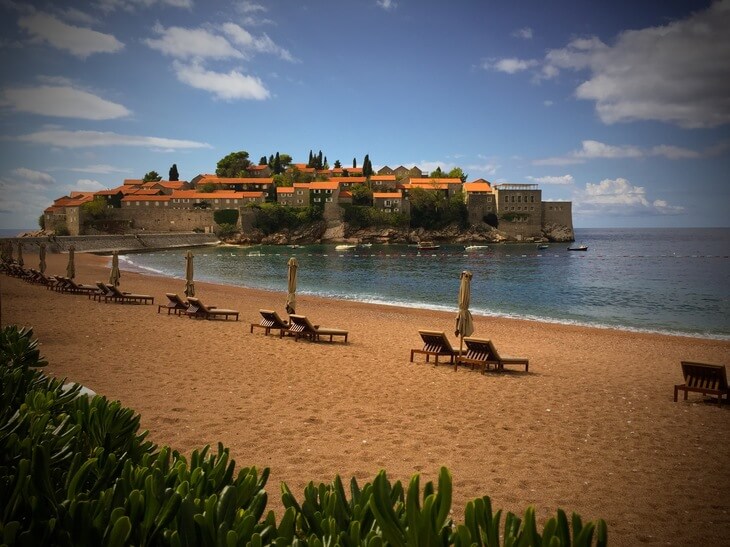
Where is Montenegro? Where It is and Where to Stay
Where is Montenegro? Find out where Montenegro is and which are the best destinations in this Mediterranean hidden gem.
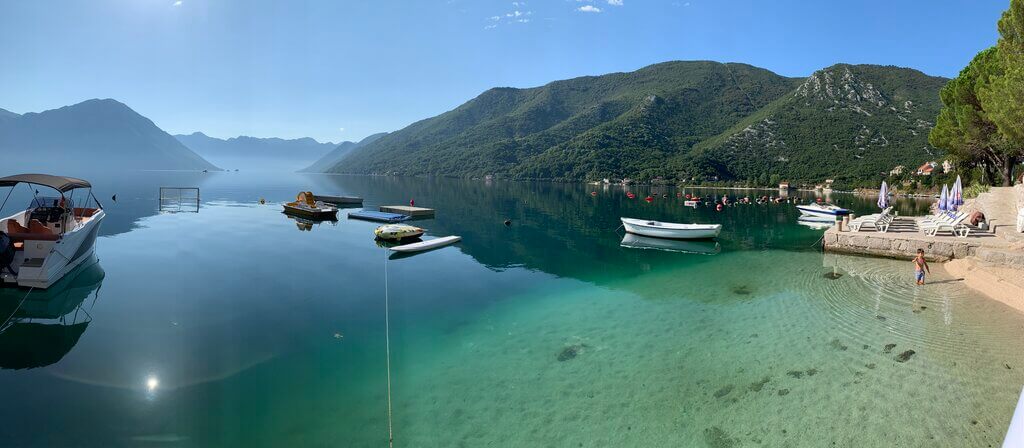
The Climate of Montenegro And When To Plan Your Trip
Pinpoint the best time of year to plan your holiday with this guide to the climate of Montenegro
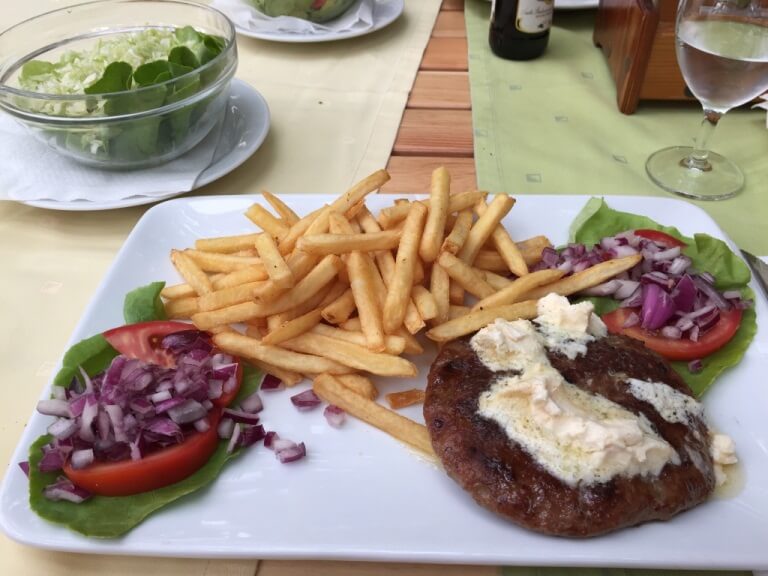
Frequently Asked Questions About Montenegro
Get all of your frequently asked questions about Montenegro answered right here.
Find the Best Travel Booking Services for Montenegro
- Find a deal! Click here to see current deals on tours and activities .
- Accommodation with Booking.com
- Tours and activities with Get Your Guide
- Tours and activities with Viator
- Cheap car hire with Localrent.com
- Cheap flights with WayAway
- Organised adventure tours with TourRadar
- Transfers with Kiwitaxi
- Travel insurance with SafetyWing
- Montenegro Travel Planning
About Sarah

I'm a New Zealander who's lived in Montenegro since 2008. I love exploring this beautiful country and sharing the best of it with you!
Save up to 50% with these Montenegro tour deals!
Experience the Real Kotor
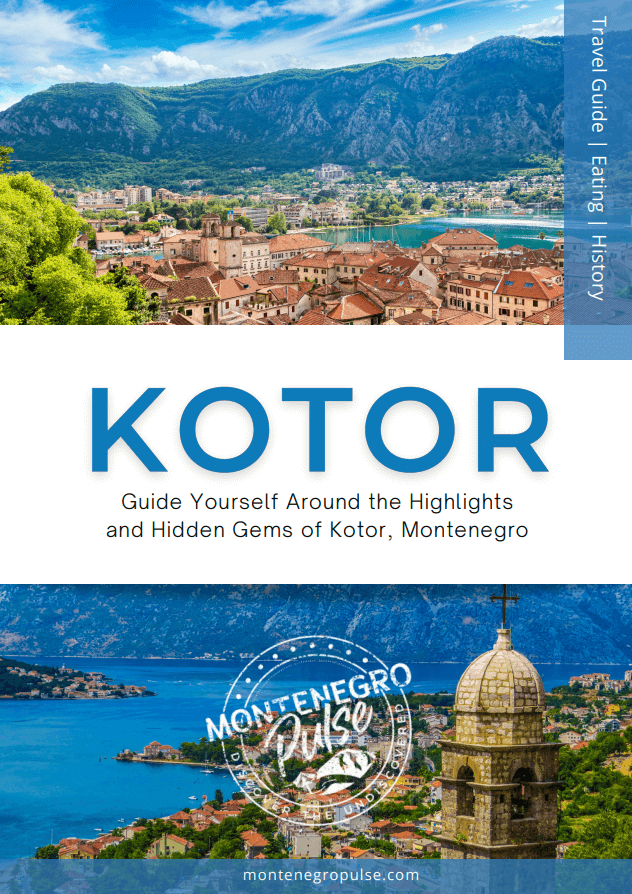
Kotor Secret City Trail
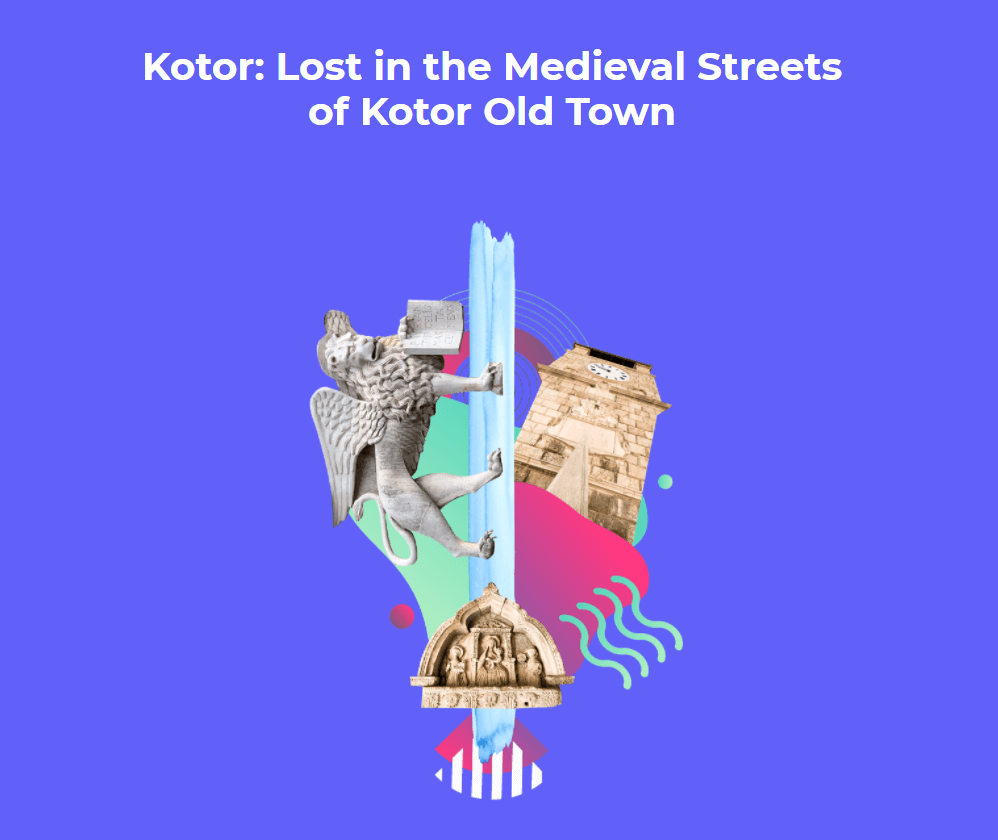
Make a Difference
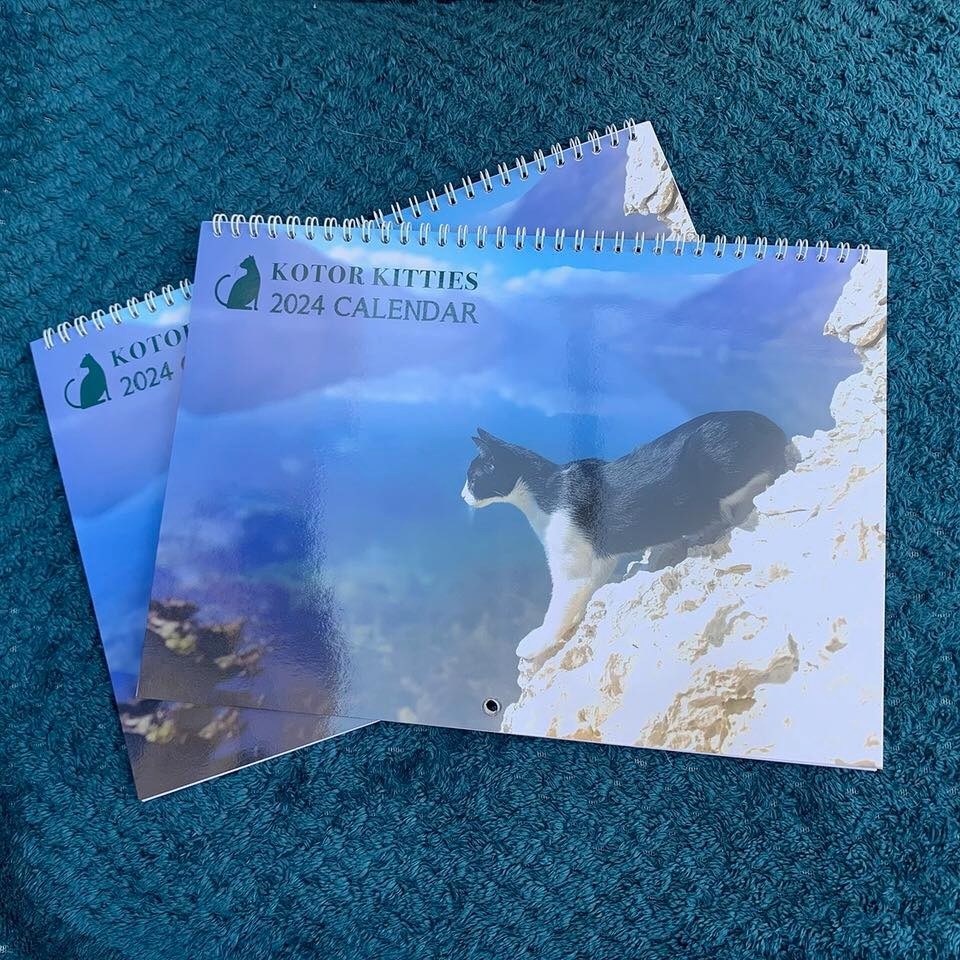
Hi! I'm Sarah, an adventurer, mum and animal-lover dedicated to helping you discover the best of Montenegro, no matter how long your visit to this intriguing part of the world.
By Sarah Pavlovic | © Copyright 2024 | Montenegropulse.com | All Rights Reserved | Privacy Policy
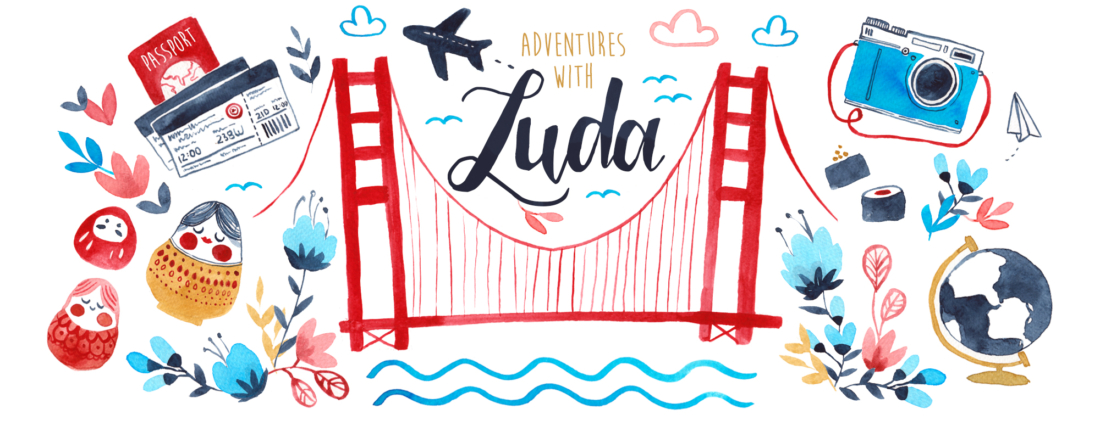
The Ultimate Montenegro Travel Guide: What to Do, Eat, Stay, and more!

With more than 300km of coastline, five national parks, and dozens of idyllic cities and towns, it’s no wonder why Montenegro is quickly becoming a popular destination .
In fact, thanks to its juxtaposition of monte and mari — the mountains and the sea — Montenegro is perfect for everyone!
Craving the sunny seaside ? You’ll find your perfect beach in Budva, Herceg-Novi, Ulcinj, or even Sveti Stefan.
Perhaps a trip to the mountains? Montenegro is famous for that too (it’s even in the name!) – just take a look at the Montenegrin National Parks mentioned here and I’m sure you’ll be packing your hiking shoes the moment you see the gorgeous emerald hills or snow-capped peaks.
It doesn’t matter if you just started to plan your trip to Montenegro or already have a solid itinerary — this Montenegro travel guide is jam-packed with travel tips that will take your vacation to the next level . Let’s take a quick look at what’s included…
Looking for the best places to visit in Montenegro ? There’s an entire section where I list out the top places to visit via region and interests (city, beaches, nightlife, etc).
Perhaps you’re wondering how to get here (or get around)? No worries, I’ve also listed out transport , including via air, bus, train, and even car.
… Or maybe you have all of that ready and just want to know what to eat ? Grab your appetite and order a Crni Rižot while you devour the what to eat in Montenegro section.
There’s also the best time to travel, safety tips, money, activities and day trips, and so much more!
Ready to travel to Montenegro? Let’s go!
TRAVEL TO MONTENEGRO: THE BASICS
Do you need a visa for montenegro montenegro is generous when it comes to visa-free travel. in fact, it allows almost 100 countries visa-free entry for up to 90 days here’s a quick cheat sheet:.
🇺🇸 USA : 90 days 🇨🇦 Canada : 90 days 🇦🇺 Australia : 90 days 🇪🇺 European Union : 90 days
You can check out the Montenegro visa requirements page for more information and apply (if needed).
Montenegro Tourist tax Did you know that travelers have to pay a tourist tax for each day that they stay in the country?
The tourist tax in Montenegro is about 1 EUR per person per day, although it varies depending which city you’re staying in. Some cities charge .80 EUR, some charge a little more.
If you’re staying in a hotel, there’s usually a separate charge for the tourist tax; if you’re staying in an Airbnb or private accommodation, typically the host will offer to register you (so that you have more time to be a tourist instead of waiting at the registry!)
Electricity & Plugs Don’t forget your electronics! Montenegro uses the type F plug and has a standard voltage of 230 V. I have used these adapters in more than 30 countries and highly recommend them!

BEST TIME TO GO TO MONTENEGRO
Usually, the best time to visit Montenegro is between April to the beginning of October , when temperatures are at their best.
However, don’t discount Montenegro as just a warm destination. During winter, the northern part of the country turns into a snowy wonderland and you can find top-notch ski resorts, cozy cabins, and fresh nature!
There are different versions of when is the ‘best’ time to visit Montenegro depending on your interests and plans. Here’s a quick overview:
Best time to visit the beaches: June to mid-September for the warmest water Best time to ski in the mountains: December to March (and sometimes up to April!)
Peak tourist season in Montenegro: July and August
Hottest months: July and August Coldest months: December through February
Best months if you want to avoid crowds: May/June and September/October
Seasons in Montenegro
Although Montenegro has four seasons, its Mediterranean climate allows the country to enjoy favorable temperatures without extreme weather. Case in point: you’ll usually see hot summers and mild winters, especially along the coast. Snow is rare, except for the mountainous regions.
However, snow lovers fear not — inland Montenegro can boast temperatures as low as -20 C (-4 F) during the winter, which makes it a perfect off-the-grid destination to ski and snowboard.
Here’s a quick rundown of each season in Montenegro:
Spring : March, April, May — May is optimal, as the water starts heating up towards end of May but there are virtually no crowds
Summer : June, July, August — July and August are the hottest and most crowded months
Fall : September, October, November — September is also fantastic, as the weather cools down and it’s a great month for hiking
Winter : December, January, February — Cold temps, coast has rain and northern part is snowy
Is everything closed in Montenegro in winter? Nope! Although most people might think of Montenegro as a summer destination, it actually works all year ‘round. Winter in Kotor is fairly mild (the average daytime temperature is 10C / 50F) and the streets are free of the typical cruise ship crowds. Hotels, transportation, and tours work, albeit some busses might have as many departures.
No idea what to pack for Montenegro? No worries! Check out my Montenegro packing guide that’s applicable for all four seasons.
How much time do I need in Montenegro?
If it’s your first time traveling to montenegro, i would recommend staying at least a week to really get a sense of the country and do a few day tours..
For example, you can fly into Tivat airport and use Kotor as your ‘home base’ while doing a couple of day tours, such as to Perast or the extremely popular All Montenegro Tou r.
If you’re flying to Montenegro during the fall or winter, you can split your week between the coast (i.e. Kotor or Herceg-Novi) and the northern part of the country, which has fantastic ski resorts and mountain cabins.
If you have 2 weeks , you can add the southern coast (Bar and Ulcinj), Budva, and Cetinje to your itinerary. In fact, if you’re near Cetinje, you can enjoy Montenegro’s lush nature and spend a day or two at Lovcen National Park, which is sure to give you an unforgettable memory of the country!

SAFETY IN MONTENEGRO
In a nutshell: Montenegro is extremely safe.
The only crime to look out for is petty tourist crime, such as money scams and pickpockets.
Pickpocketing is generally clustered around touristy cities like Kotor and Budva , especially when there are crowds of people. To avoid getting robbed, I recommend wearing a cross-body purse with a zipper and holding your hand over the top (so as to detract pickpockets from opening the purse). Don’t keep your valuables or phone in your pockets, which are another ‘hot spot’ for thieves.
Pay special attention in stores and kiosks, as there are amateur scammers who ‘accidentally’ give you back incorrect change or charge you the wrong price.
We’ve had this happen twice. One time a kiosk seller charged us 14 EUR for two bottles of water and some chips (which honestly should have costed, at most, 5 EUR) because it was Sunday and all of the regular grocery stores were closed .
Solo female travel in Montenegro — I’ve had a few friends who traveled Montenegro as a solo female traveler, and all of them had no issues whatsoever.
LANGUAGE IN MONTENEGRO
The official language in Montenegro is *drumroll* Montenegrin !
Interestingly enough, after a language reform in the mid-2000s, the Montenegrin language can be written either in Latin or Cyrillic (i.e. the same alphabet in Bulgaria, Russia, Ukraine, etc).
However, we noticed that Cyrillic was very rare and only used around 10% of the time we were in Montenegro — almost everything was in Latin.
However, no worries if you don’t — since Montenegro is quickly becoming a popular destination, English is widely spoken in touristic areas like Kotor, Budva, and hotels across the country.
SIM cards in Montenegro
Montenegro’s three biggest telecom companies are Telenor, Telekom (better known as T-Mobile in the USA), and MTel . If you’re wondering which Montenegro SIM card to buy, there’s really not much difference between the three of them — all have great coverage, cost about the same, and offer similar packages.
To put it in perspective, you could probably stream Youtube videos 24 hours a day and still have a decent amount of GB left after your SIM card expires. I freely used my SIM card, never connected to the WiFi in our accommodations, and spent about 70 GB by the time my month in Montenegro was over.

MONEY IN MONTENEGRO
If you saw my 17 Montenegro Travel Tips blog post , you might remember that Montenegro uses the Euro as its official currency . Interestingly enough, Montenegro is not in the European Union or the Schengen Zone (although it’s rumored that they might join in the next few years!).
Credit cards are widely accepted in most large cities such as Kotor, Budva, Podgorica, Herceg Novi, etc. However, if you plan to visit smaller towns or villages, it’s a good idea to keep paper bills on hand.
Likewise, always double check how you plan to pay for accommodations, especially if you book through Booking.com — some guest houses and family-owned accommodations will only accept cash upon check-in.
How expensive is Montenegro?
Compared to its bigger Balkan neighbors like Serbia and Croatia, I would say that Montenegro is less expensive.
The great thing about Montenegro is that it is only as expensive as you let it be.
If you want a budget-friendly trip , you can do Montenegro on as little as 15 to 20 EUR a day . If you want to go all out and enjoy a luxury vacation at a resort, dropping 200 EUR a day, then that’s definitely possible. And if you’re somewhere in the middle, then you can do Montenegro on a mid-sized budget. :)
Here’s how much you can expect to spend per day (per person) depending on your travel style:
💵 Budget travel —Staying in hostels, using the bus to travel, eating street food or buying groceries — 15 to 20 EUR / day
💰 Mid-range travel — Staying at a nice apartment or hotel, eating at restaurants and cafes, using the bus and/or renting a car — 30 to 60 EUR / day
💸 Luxury travel — Staying in high-end hotels or resorts (i.e. all inclusive), eating in fancy restaurants, renting a car or using a transfer service — 100+ EUR / day
Of course, these are just estimates. If you’re traveling as a couple (or as friends), for example, you’d obviously save some money by splitting the cost of a hotel room, car rental, and more.
It’s also important to note that cities along the coast (i.e. Kotor, Budva, Ulcinj) will be more expensive because they cater to tourists. The further inland you go, the more money you will ultimately save.
WANT TO LEARN HOW MUCH IT REALLY COSTS TO TRAVEL TO MONTENEGRO? Check out my in-depth post here , where I break down the prices in Montenegro, including everything from accommodations, food and drinks, transportation, activities/sightseeing, and more.
TRANSPORTATION IN MONTENEGRO
Getting into Montenegro is very easy, no matter where you’re coming from.
If you’re already in the Balkans, you can take the bus from Dubrovnik (Croatia), Shkodër (Albania), or Sarajevo (Bosnia and Herzegovina). Those in Serbia can take the famous Belgrade to Bar train route, which passes through Podgorica (Montenegro’s capital) and finishes at a seaside town called Bar.
If you’re traveling from Europe, the easiest way to reach Montenegro would be to take a flight to either Podgorica (the capital) or to Tivat (seasonal routes).
Here’s a quick rundown of each method:

MONTENEGRO BY AIR
Montenegro has a total of two airports in the country: one in the capital, Podgorica (TGD), and one near the coast, Tivat (TIV). Both airports serve international traffic, although Tivat gets considerably more passengers because it’s closer to tourist cities like Tivat, Kotor, and Budva.
If you’re flying from Europe, you can easily find flights on most major carriers such as LOT, Norwegian, Ryanair, SAS, and so on. Montenegro has its own national carrier called (you guessed it) Montenegro Airlines that services major hubs in Europe.
Alternatively, you can also fly into Croatia’s Dubrovnik airport (DBV) and drive or take a bus to Montenegro’s coast — the drive is around 70km and 1.5 hours by car or 2.5 hours by bus.
Check flights to Montenegro here

MONTENEGRO BY BUS
Despite its rugged geography and small size, Montenegro has an excellent bus system !
In fact, it’s usually the preferred way for locals and tourists to travel across the country because of convenient connections and bus stations in literally every city, town, and even village.
The majority of bus stations have a small cafe, lobby, and ticket desk, and are usually not too far from the center. If you’re buying a bus ticket online, don’t forget to print it out at the bus station. This usually costs between € 0.50 to €1 (depending on the station) as part of the ‘bus station fee.’
Likewise, you may be charged €1 by the bus driver for any luggage that’s bigger than a regular-sized backpack (this depends on the driver).
Although they’re not the newest models, Montenegrin busses are very comfortable and generally in excellent condition.
To check bus times and routes, try either BusBud (international routes) or BusTicket4.Me (domestic routes).
Fun fact: The first intercity bus line in Europe was introduced between the Montenegrin cities of Podgorica and Cetinje, during the time of King Nikola. Ironically, Cetinje was the first capital of Montenegro (the ‘Old Royal Capital’) before it was moved to Podgorica after World War II.
MONTENEGRO BY TRAIN
Montenegro has a small railway network that connects its most important cities with the capital.
Most travelers taking the train will either begin or end their journey on the Belgrade to Bar railway. This route starts in Montenegro’s seaside town Bar, connects through the capital, Podgorica, and continues to Serbia’s capital, Belgrade. It’s known as one of the most scenic railways in Europe, as you’re bound to see beautiful lakes, mountains, and canyons outside of your window.
Best of all, you can take the entire 10-hour journey , from Bar to Belgrade, for only 20 or 30 EUR ! (Depending if you choose first or second class)
Unlike busses, you need to buy train tickets at the train station. However, you can check timetables and routes on the official railway site .

MONTENEGRO BY CAR
Although the busses can take you virtually anywhere in the country, sometimes it’s nice to rent a car to visit truly “off the beaten path places” where public transportation can’t go.
Renting a car in Montenegro is one of the most popular ways to get around the country, especially to smaller villages and natural attractions (national parks, canyons, rivers, etc).
Typically a car rental starts around €15 to €20 per day , but you can get a great deal if you rent for a longer period of time (i.e. many agencies give weekly discounts). One thing to note is that cars with automatic transmission usually cost a bit extra.
I recommend RentalCars.com if you plan to rent a car , since they have the largest selection and offer great deals. This is the company I normally use whenever I need to rent a car. :)
TRAVEL TIP: Although Google Maps and Maps.me both work in Montenegro, Google Maps displayed the wrong address for our apartment rentals a few times. I would recommend using Maps.me over Google, especially in smaller towns (like Perast) and villages.
MONTENEGRO BY TAXI
There are plenty of taxis in Montenegro to get you wherever you need to go, whether that’s from the bus station to the center of town, or all the way off the beaten path.
A typical trip will cost you a few Euro, but be sure to check prices in advance so as to not be ripped off.
MONTENEGRO BY TOURS
Last but certainly not least, you can cover a great deal of Montenegro by taking day tours !
There are hundreds of different tours available for literally every type of traveler, from nature hikes to adventure activities (SUP, kayaking, rafting), guided tours around historical monuments, and even food and wine tours.
I typically like to use Get Your Guide when traveling — here are some of their most popular tours in Montenegro:
ACCOMMODATIONS IN MONTENEGRO

Although Montenegro is still fairly off the beaten tourist trail, that doesn’t mean you can’t find a great apartment or hotel! In fact, there are plenty of accommodations across the country for every budget.
The most popular hotel booking sites in Montenegro are Booking.com and Hotels.com , which offer fantastic options for every traveler, from hostels to hotels, apartments to penthouses, and everything in between.
We booked the majority of our accommodations through Booking, including a luxury apartment with jaw-dropping views of Kotor Bay , a cute little studio overlooking Perast, and a family-run guest house in Herceg-Novi.
If you want to check out what cool places are waiting for you, just add your city and expected travel dates here:
GUEST HOUSES
Guest houses are very popular all around the country and are a common way for local families to make a little extra money while hosting travelers. They’re very easy to find, as they’ll usually be called “Guesthouse [NAME]” or Apartments with the family’s surname (such as Apartments Đukić in Kotor).
Staying at a guesthouse is great for a number of reasons: you’re supporting the local economy , the majority of guesthouses are in pristine condition, and oftentimes it’s cheaper than a hotel room! Best of all, most guest houses have separate entrances and rooms, so you can choose to be as social as you prefer.
On a similar note, apartments in Montenegro are a great choice if you’re traveling with a larger group — or just prefer to have the same conveniences of home (kitchen, washing machine, etc).
In a similar note to guest houses, you can also opt for a family stay in a sobe . These are basic, cozy rooms in somebody’s house and are similar to the feeling you’d get in a guesthouse or bed and breakfast.
Sobe are usually booked in-person: in the high season, there are usually people waiting near bus stations holding up ‘sobe’ signs . You can also spot signs near people’s houses indicating they have a free room to rent.
ALL-INCLUSIVE
Last but certainly not least, all-inclusive resorts are quickly popping up in Montenegro! These are usually found along the Montenegrin Riviera in places like Budva, Sveti Stefan, Petrovac, and Čanj. The most popular all-inclusive chain is Iberostar , which can be found in the latter cities and have rave reviews.
WHERE TO GO IN MONTENEGRO
From the sea to the mountains and everything in between — here’s a quick overview of each region in Montenegro.
THE ADRIATIC COAST
The Montenegrin coast features some of the most beautiful seaside towns and cities on this side of Europe. Dive in by starting in Kotor and making your way westward.

KOTOR — The most well-known city in Montenegro , it’s no wonder why Kotor is so popular. A city where cobblestone streets meet historic stone buildings to breathtaking views from the Kotor fortress, inviting streetside cafes, and surprises at every turn, Kotor has everything you need for a picture-perfect vacation.
Kotor makes an excellent home base if you want to explore the rest of Montenegro with ease — you have Perast and Herceg Novi to the west; Budva, Ulcinj, and the entire southern coast to the south; Podgorica and Skadar Lake to the east; and Niksic and Zabljak to the north.
And speaking of day trips, you’ll also have the best variety because the majority of tour companies depart from Kotor. Check out my travel guide to Kotor here.

PERAST — What if I told you about a gorgeous seaside town — with idyllic boats bobbing near the shore, the sun shining on majestic Baroque palaces, and a place still very much under the radar — just a 15-minute drive from Kotor ?
Surprised? Then you definitely need to check out Perast! Small and sweet, perfect as a romantic weekend getaway or a quick day trip from Kotor, Perast is the ultimate charming small town in Montenegro. In fact, the photo above was the main reason why we chose Montenegro as our destination! Check out my travel guide to Perast here .
TIVAT — Tivat is often the first point of contact with Montenegro’s coast, especially for those flying into Tivat airport.
Although it’s usually skipped in favor of more popular destinations like Kotor or Budva, Tivat is perfect for those who want to avoid the crowds and enjoy a peaceful atmosphere while still being based near the coast.

HERCEG NOVI — Montenegro’s westernmost city, Herceg Novi is primarily known for two things: castles (its name literally means ‘New Castle’) and sunshine (it gets 200 days of sunshine every year). Herceg Novi is a great introduction if you’re entering Montenegro from Croatia, or as a weekend getaway from Kotor. Check out my travel guide to Herceg Novi here .
SVETI STEFAN — If you’ve ever seen a photo of an island with quaint stone houses, huddled together with their red-tiled roofs, then you’re already acquainted with one of Montenegro’s most famous attractions !
Sveti Stefan is a luxury resort and hotel that features serenity, privacy, and one of the most beautiful beaches in the country. You can book a room here , or visit on a day trip from Budva to get a postcard-perfect photo from above.

ULCINJ — The southernmost city on Montenegro’s coast , Ulcinj has a distinctly middle eastern atmosphere thanks to its proximity to Albania. Here you’ll find plenty of beautiful beaches, olive groves, and charming villages.
It’s also a great gateway to Lake Skadar, or if you want to continue your Balkan trip, to Albania as well. Check out my travel guide to Ulcinj here.
MONTENEGRO BEACHES

⛱ Dobrec Beach — Accessible only by boat, the U-shaped Dobrec Beach offers peace and tranquility from crowded cities. There’s an on-site restaurant serving fresh seafood and hammocks for rent.
⛱ Jaz Beach — Just 6 km west of Budva is this lovely beach, which has 1.2 km of coastline and plenty of activities. It’s great for families or day trippers because there are cafes and restaurants nearby, plenty of parking, and kiosks where you can rent a paddleboat, kayak, or even a jet ski.
⛱ Mala Plaža – Located right in the center of Ulcinj, ‘Little Beach’ is such a cute and picturesque place to chill out and enjoy Ulcinj! My absolute favorite beach in Montenegro, Mala Plaža has these sweet thatched umbrellas (a la Maldives or Bora Bora style) and calm waters.
⛱ Lucice Beach — Some 800 meters from the village of Petrovac, Lucice offers turquoise waters surrounded by pine forests and warm sand.
Did you know almost 80% of Montenegro is covered in mountains? With 5 national parks, turquoise-blue lakes, lush valleys, and mysterious caves, it’s no wonder why Montenegro constantly tops the list of the best countries for nature.

ŽABLJAK — Žabljak is unofficially called the ‘ gateway to Durmitor ’ and, thanks to its location along the mountain range, is the highest town in the country! Naturally, you can find great views, plenty of things to do, and charming nooks and crannies here.
During the summer you can hike around the nearby mountain ranges, while in the winter the entire region turns into one big ski resort!
DURMITOR NATIONAL PARK — Remember how I mentioned the highest point in Montenegro ? You can find it at Bobotov Kuk, the tallest peak in the Durmitor mountain range.
Surprisingly enough, one of the best hikes in Montenegro — to Bobotov Kuk — can be done in one day! There are two popular routes to the top that should take between 8 to 10 hours round-trip, depending on your level of fitness.

LOVCEN — Did you know this is the place that inspired Stefan Milutin to name the country Montenegro? That’s right! After Milutin saw Mount Lovćen covered in dark, dense trees back in 1276, he stated that the country should be named Crna Gora — ‘ black mountain .’
See if you can spot the similarities for yourself on a trip to Lovcen National Park, which houses one of the country’s biggest attractions, the mausoleum of Montenegrin ruler Petar II Petrovic Njegos, at the very top.
Want to spend an entire day at Lovcen? There are plenty of things to do, such as hiking, ziplining, and cycling.
SKADAR LAKE — Shared between Montenegro and Albania, Lake Skadar is one of the most popular natural attractions in Montenegro. In fact, it’s the largest lake in Southern Europe!
Lake Skadar is extremely popular during the spring and summer, when the weather warms up and locals enjoy a boat ride out on the water.
Although day trips are popular in the area, don’t forget to go off the beaten path and check out the small islands (particularly the one with Monastery Kom!), keep an eye out for birds, and explore the fortresses.
CULTURE & CITIES

Podgorica is great for those on the hunt for Soviet-style architecture and monuments; those who love off-the-beaten-path destinations, and those into the cafe scene. Otherwise, it’s perfectly fine to skip the capital if you’re short on time.
CETINJE — On the other hand, Cetinje is the (former) capital worth visiting! This was the first capital of Montenegro and, thanks to its history, has retained plenty of historic charm.
Cetinje is famous for being the cultural heart of Montenegro because of the many museums, colorful buildings, and former embassies that grace its streets. Check out my travel guide to Cetinje here.

BAR — Although often overlooked in favor of its bigger neighbors (Budva and Ulcinj), the town of Bar — or rather, Stari Bar — is worth a day trip to see the ancient ruins.
Take a walk through the impressive Stari Bar Fortress, see the oldest olive groves in the country, or wander around the picturesque old town.
NIKSIC — Known for being the second biggest city in Montenegro, Niksic has an industrial feel to it. It’s a popular day trip to see Yugoslavian-era spomeniks (monuments), like the Home of Revolution.

BUDVA — Budva has been called the “Miami of Montenegro,” and it’s no secret why. The first night we were there, it felt like everybody around us was dressed to the nines: girls in fancy dresses and heels walking with men in designer shirts, on their way to a nightclub or upscale bars.
Budva is, without a doubt, where everybody comes to party. Whether it’s a music festival during the daytime or the club during the night, Budva is unrivaled in its status as a party capital.
Of course, that’s not to say it doesn’t have its tourist charms. Budva also has a famous Old Town, lovely beaches, and even an island that you can visit via boat! Check out my travel guide to Budva here.
TIVAT – Nightlife in Tivat is more refined compared to its neighbors. This is thanks to Porto Montenegro, an upscale area with fancy lounges and bars where socialites come to hang out and be seen.
KOTOR — Hey look, it’s Kotor again. :)
While it may not have fist-pumping nightclubs or beach bars, Kotor still offers plenty for a night out. Check out the live music coming from restaurants and lounges, or enjoy a casual nightcap at a pub or bar.
CAN’T DECIDE BETWEEN KOTOR, TIVAT, OR BUDVA? Check out my post here , where I go in depth about each city, their pros/cons, and more!
BEST THINGS TO DO IN MONTENEGRO

This section was originally going to be a sort of ‘bucket list’ of things to do in Montenegro , but it got out of hand and turned into its own post !
You can see the top things to do in Montenegro in the aptly-titled The Ultimate Montenegro bucket list: 30+ things to do and places to see in Montenegro — just click that link. :)
WHAT TO EAT IN MONTENEGRO

With plenty of green fields, local farms, and a coastline that stretches almost 300km, there’s no shortage of fresh and organic food!
From hearty meat dishes to seasonal salads, seafood , and more, Montenegro has it all. Use this mini guide to Montenegrin food as you hop from cafe to restaurant during your trip:
APPETIZERS & SIDES
🥓 Montenegrin cheese & prosciutto plate – Montenegro is famous for its cheese and meat, especially from the Njegusi region (located between Kotor and Cetinje). In many restaurants, you’ll see this type of charcuterie board, along with vegetables, olives, kajmak, and slices of bread. Definitely don’t leave Montenegro without trying some Njeguši pršut!
🥗 Shopska salad – A traditional salad found in almost every cafe and restaurant. It contains slices of tomato, cucumber, pepper, grated cheese, and with a hint of olive oil.
🧈 Kačamak – One of Montenegro’s traditional dishes, this is a must-try when you’re here! It’s a mix of potatoes, cheese, and cornflour, drizzled with sauce, and looks similar to polenta.
🍚 Kajmak – Not to be confused with kačamak (above), kajmak is a type of clotted cream made from cow, sheep, or goat’s milk. This can be eaten by itself as an appetizer, or sprinkled onto a dish for added flavor.
🥯 Bruschetta, tortillas, toast – Not quite Montenegrin, but you’ll often see bruschetta, toast, and tortillas as part of the menu in various restaurants.
🥩 Steak : There are probably dozens of different ways to cook steak in Montenegro, but perhaps the most famous is Njeguski steak. In a nutshell, a pork or veal schnitzel is stuffed with prosciutto and kajmak cheese, then rolled, breaded, and fried. Mmm!
🌭 Ćevapi : The quintessential Balkan food, you’ll find ćevapčići all around the region — including Montenegro! These are small, long patties made of meat and spices, grilled, and smothered with onions.
🍔 Pljeskavica : Another staple that is often called the ‘Balkan burger,’ the pljeskavica is a piece of meat that looks like a burger patty and is often stuffed or drizzled with kajmak cheese.
🦐 Seafood : There’s so many options for seafood that it has its own category! If you’re traveling along the coast of Montenegro, I can guarantee that you’ll be able to walk up to any restaurant and see seafood on the menu. From sea bass to trout, octopus, shrimp, calamari, mussels, and more, you really can’t go wrong.

🥞 Palačinke – A thin and sweet pancake that’s similar to the French-style crepe. Palačinke is usually found with jam, Nutella, or fruit inside, although it can also come in savory flavors such as chicken, ham, cheese, etc. Best of all, a palačinke shouldn’t set you back more than 2 or 3 EUR!
🍚 Sutlijaš – Essentially rice pudding, this dish can be sprinkled with cinnamon or topped with raisins. If you love the taste, you can even buy ready-made packets to cook at home. :)
🍋 Lemonade – Found on every menu during the summer, this is similar to the lemonade from back home. However, be careful, as this drink tends to be on the sour side!
🍺 Niksicko beer – Nikšićko Pivo is the drink of Montenegrins and comes from the second-largest city, Nikšić. Speaking of beer… you’ll mostly see light beers on the menu, as dark beer isn’t so popular.
🥃 Rakija – Although beer may be popular, rakija is king! This mythical drink can be made from virtually any fruit and has an alcohol content between 40% to 80% — oof! Rakija varies from different regions, as each has their own special techniques and flavors.
🍷 Wine – Montenegro technically has two wine-growing regions: along the coast and in the Lake Skadar basin, not too far from the capital. With bold flavors and varieties, you’ll want to take a bottle home!

WHERE TO GO AFTER MONTENEGRO
Find out your next destination here:
🇭🇷 Croatia — Dubrovnik is only an hours’ drive away from Herceg-Novi and continues the theme of epic old towns, cobblestone streets, and charming seaside towns. Split, Zagreb, Plitvice Lakes National Park, Pula, and Hvar are worth a visit.
🇧🇦 Bosnia and Herzegovina — Kotor to Mostar is about a 3-hour drive, and another 2 hours if you want to visit BiH’s capital, Sarajevo. If you love nature, be sure to check out Bileća Lake on the way there; other popular spots to check out in BiH include Banja Luka, Blagaj, and Lukomir. Click here for my Bosnia & Herzegovina blog posts .
🇷🇸 Serbia — Remember the famous Bar-Belgrade train I was talking about? It’s time to check it out with a trip to Serbia! You can travel between both capitals via a train that leaves twice a day and offers plenty of fantastic views along the way. While in Serbia, don’t miss Novi Sad, Subotica, and western Serbia (especially Mokra Gora!). Click here for my Serbia blog posts .
🇽🇰 Kosovo — Although Kosovo’s status is still disputed to this day, it’s a fantastic place to visit during your Balkan trip. Be sure to pay attention to how you enter and exit Kosovo, as there are special rules (i.e. you can’t travel from Montenegro to Kosovo and onto Serbia). Check out the capital, Pristina, as well as Prizren, Rugova, and Bjeshkët e Nemuna national park.
🇦🇱 Albania — Just a quick drive from Montenegro’s southernmost city, Ulcinj, is the ancient town of Shkodër in Albania. Similar to Montenegro, the country also has its own Albanian Riviera (popularly known as Bregu) along the western coast. Popular destinations include Sarandë, Ksamil, Tirana, and the Albanian part of Skadar Lake. Click here for my Albania blog posts .
Inspired to visit one of these Balkan beauties? Check out flights here or bus tickets here !
USEFUL REFERENCES FOR TRAVELING TO MONTENEGRO
Looking for more information before your trip to Montenegro? I recommend the following websites, books, and items that I personally used:
🚌 Busticket4.me — This website saved our trip multiple times! It has an easy-to-use design where you can search for busses, check timetables, and even buy tickets online (for some routes). For international journeys, BusBud is also an excellent alternative.
📖 The Mountains of Montenegro — Planning to hike Montenegro’s mountains? This guidebook is for you! It features 17 routes (including day trips and multi-day routes) as well as travel tips and points of interest. Check it out here .
📖 Montenegro Marco Polo Pocket Guide — We had the chance to read this book during our trip (thanks to our host in Perast who had a mini-Montenegro library!) and it has plenty of great information about the main sights as well as smaller, off-the-beaten-path cities and towns. My favorite sections were ‘Only in Montenegro’ and the insider tips. Check it out here .
📖 Montenegro: A Modern History — If you’re looking to turn your trip into an in-depth history lesson, this book is highly recommended. As one reviewer noted, this book is “the greatest work on Montenegrin history,” and I completely agree. Check it out here .
📖 Lonely Planet Montenegro — Last but certainly not least, everybody’s favorite travel guidebook provides essential information, maps, where to stay, what to eat, and more. There’s even a section about Dubrovnik if you plan to cross over to Croatia. Best of all, it’s available in both paperback and Kindle for on-the-go access. Check it out here .
Looking for even more resources for your Montenegro trip? Here is my ultimate Montenegro list:
🛂 Need a visa to Montenegro ? Check out iVisa for more information .
✈️ Once you have your visa all set, it’s time to book airline tickets ! I use both CheapOAir and SkyScanner to book flights.
🛏 Book accommodations on Booking or Hotels . These two offer fantastic options for every traveler, from hostels to hotels, apartments to penthouses, local guesthouses, and everything in between!
✨ Speaking of amazing accommodations… I have an entire blog post dedicated to the best guesthouses, apartments, and Airbnbs in Montenegro !
📷 Find tours, day trips, or sightseeing activities at Get Your Guide or Viator .
❗️One of the most popular day trips is the All Montenegro Tour . This 12-hour tour gives you a taste of Montenegro as you enjoy breakfast at a local village, tour the Old Royal Capital, visit the birthplace of the Petrović dynasty, enjoy a boat ride through River Crnojevica, and finish the day with a panoramic view of the famous Sveti Stefan.
🚗 Prefer to carve out your own itinerary? Rent a car through RentalCars.com, which has the biggest selection of car rentals and the company that I use whenever I rent a car.
🧳 Not sure what to pack ? I have an entire blog post that details what to pack for a trip to Montenegro for all four seasons!
🇲🇪 Looking for even more information before traveling to Montenegro ? Check out my 17 Montenegro Travel Tips for some bite-sized tips…
🇲🇪 … Or check out all of my blog posts on Montenegro here ! Happy travels :)
PSA: Some of the links in this post are affiliate links, which means I may earn a small commission if you book something through them. This is at no cost to you and helps keep this site running. Thank you!
Photo credits : Car in Montenegro – Dejan Zakic | Croatia – Spencer Davis | Euros – Markus Spiske | Palačinke – Todd Cravens | Airplane Window – Adrien Olichon |
Related Posts
2 thoughts on “ the ultimate montenegro travel guide: what to do, eat, stay, and more ”.
I am very impressed 👏with all the work you put into this site.
Thank you Captain Ronald! :)
Leave a Reply Cancel reply
Your email address will not be published. Required fields are marked *
Notify me of follow-up comments by email.
Notify me of new posts by email.

- ALL TRAVEL GUIDES
- DESTINATION FILTER
TOP OF PAGE
Quick Facts
Best Time To Go
Cost & Spending
Travel Tips
Regions & Highlights
What To See & Do
Itineraries
What To Eat
Where To Stay
Trip Planning

Welcome traveler!
We're Andre & Lisa, adventurers and experienced budget travelers.
We have over two decades of travel experience and since 2018 have led a full-time nomadic lifestyle.
L earn more about us !
Thank you for visiting and we hope you find value in our destination pages! We thoroughly research and curate all content ourselves and everything you find on this site is put together by only the two of us.

MONTENEGRO TRAVEL GUIDE
Country Introduction
Montenegro, a small yet stunningly diverse country, offers an enchanting blend of historical richness and natural beauty. Nestled along the Adriatic coast, visitors can explore the ancient city walls and cobbled streets of Kotor, a UNESCO World Heritage site, or bask in the sun on the pristine beaches stretching down the coastline.
The country's interior is just as inviting, with the rugged peaks of Durmitor National Park and the deep canyons of Tara River offering thrilling adventures for outdoor enthusiasts. With a Mediterranean climate that's perfect for year-round visits, Montenegro's charming towns, vibrant cultural scene, and delicious cuisine make it an irresistible destination for travellers seeking both relaxation and exploration.
DO YOU NEED A VISA FOR MONTENEGRO?
<<VISA RESULT>>
<< Visa Details >>
For the latest requirements or for application click
Let iVisa take the pain out of travel planning and assist you with Electronic visas, Travel Authorizations, Visas on Arrival, and even Paper Visas. They can also help with Health Declarations and Embassy Registrations. If you're from the US, they provide a One-Stop Shop to renew your Passport securely and error-free.
⬇️ REGIONAL GUIDES ⬇️
Travel guide.

⬇️ COUNTRY GUIDE ⬇️
Officially known as the Republic of Montenegro, it's nestled on the Adriatic Sea and shares borders with Croatia, Bosnia and Herzegovina, Serbia, Kosovo, and Albania. The nation declared its independence from Serbia in 2006, marking a new chapter in its storied history.
Capital : Podgorica
Currency : Euro (EUR)
Landscape : Despite its small size, Montenegro's landscape is diverse, featuring the largest lake in the Balkan region, Lake Skadar, and a stunning 117 beaches along its coastline.
People : The country's population is diverse, with ethnic groups such as Serbs, Bosniaks, and Albanians contributing to the cultural mosaic. Montenegro's society is traditionally patriarchal, with close-knit family units and a high regard for hospitality and respect. Religion plays a significant role, with the majority of Montenegrins adhering to Eastern Orthodoxy, while there are also significant Muslim and Roman Catholic communities.
Language : Montenegrin (official), Serbian (recognized), Spanish, English (both used by tourists and small communities)
Fun fact : Montenegro's name, meaning "Black Mountain," originates from the dense mountain forests that cover much of its terrain.
The country's economy thrives on services, industry, and agriculture, with tourism playing a significant role, thanks in part to its scenic beauty, which Lord Byron once described as the "most beautiful encounter between land and sea" on the Montenegrin coast. Montenegro's population is under a million, but its cultural and historical heritage, from the ancient town of Ulcinj to the long sandy Velika Plaza beach, continues to enchant visitors from around the globe.
Public Holdays
7 January, Orthodox Christmas
1 May, May Day
21 May, Independence Day
13 July, Statehood Day
Also, Orthodox Good Friday and Orthodox Easter Monday.
Montenegro, a country known for its stunning landscapes and rich cultural heritage, hosts a variety of festivals that reflect its vibrant traditions and history.
One of the most significant is the Kotor Carnival , a vibrant event featuring traditional masked balls, children's carnivals, and local cuisine promotions, attracting visitors from across Europe.
Another notable festival is the Fašinada in Perast, a unique maritime event held on July 22nd, where locals participate in a boat procession to honour the island of Our Lady of the Rocks.
The International Klapa Festival , held in Perast, celebrates traditional a cappella singing with performances that focus on themes of love, wine, homeland, and sea.
Boka Night is an event where decorated boats parade along Kotor harbour, creating a festive atmosphere with music and lights.
In Kotor and Stoliv, Days of Camellia celebrates the camellia flower with exhibitions, art shows, and the election of the Lady of Camellia.

QUICK BOOKING RESOURCES

SEASONS AT A GLANCE
Most destinations have different times of the year when they’re more or less popular with tourists.
Peak Season
Shoulder Season
Off Peak Season

BEST TIME TO VISIT MONTENEGRO
Best time to visit
The optimal time to visit Montenegro falls roughly between April and September. Montenegro's climate follows two distinct patterns: the coastal region has typically Mediterranean weather, with hot summers and mild winters. The interior of the country, however, has a sub-alpine climate, typified by warm summers and freezing winters. During the winter, temperatures can drop to as low as -15 °C or -20 °C degrees, with heavy rainfall that often manifests as snow.
June - Beat the peak-season rush and prices but enjoy the balmy weather.
September - Warm water but fewer bods to share it with; shoulder season prices.
October - The leaves turn golden, making a rich backdrop for walks in the national parks.

The Montenegrin coast is a pleasant place to be at any time of the year, but it can get uncomfortably crowded in July and August. During this time, temperatures and tourists reach their peak. Accommodation is also at its most expensive during this period, with rates almost doubling in some places.
June and September are widely regarded as the optimum months for a visit when the sunshine is virtually guaranteed, and there's far less pressure on facilities. Some hotels close between late October and early April, but you may well be able to take advantage of excellent rates from those that remain open.
BEST TIME FOR:
Snow Sports
Montenegro offers a variety of snow sports opportunities, particularly in its stunning mountain regions. The country's most prominent ski resorts are Kolašin 1450 and Kolašin 1600, which provide a range of slopes suitable for all skill levels, from beginners to advanced skiers. These resorts are equipped with modern amenities, including a six-seater cable car with seat heaters and Wi-Fi, ensuring a comfortable and connected experience.
For those interested in ski touring, Montenegro's mountains offer the perfect terrain to explore on skis, with professional guides available to lead the way. Snowshoeing is another popular activity, with equipment rentals available at several locations, including Durmitor and Prokletije National Parks.
The best time to visit Montenegro for snow sports is from December to March, when the mountains are typically covered in snow, providing ideal conditions for skiing and snowboarding.
Hiking and trekking
Montenegro offers a plethora of hiking and cycling opportunities that cater to various levels of experience and adventure. The country's diverse landscape includes the stunning Bay of Kotor, the majestic Durmitor National Park, and the serene Lake Skadar, providing a rich tapestry of trails and paths for outdoor enthusiasts.
For hikers the Ladder of Kotor is one of the most renowned trails in Montenegro. This historic path, once the only route connecting Kotor with Njegusi village and Cetinje, is a challenging yet rewarding trek that promises breathtaking views of the bay and its surroundings. The trail begins near the Old Town of Kotor and ascends to the Krstac Pass, with a total ascent of 940 meters.
Hikers can expect a distance of 6.4 km one way, or 12.8 km for a round trip, and the journey can take between 3 to 6 hours to complete. The path is marked by over 70 switchbacks, a testament to its long history and the effort required to traverse it. Along the way, you will encounter the Chapel of St. Ivan and the Castle of San Giovanni, offering not only a physical adventure but also a journey through time. For those seeking an alternative route, there are other trails available that provide different perspectives and challenges. It's recommended to hike during spring or fall to avoid the summer heat, and always start early in the day for the best experience.

Cyclists can enjoy the challenging terrains and panoramic vistas along the mountainous regions. One of the most celebrated routes is the Bay of Kotor loop, which provides cyclists with stunning coastal views and the opportunity to explore the historical towns along the bay. For those seeking a mountainous challenge, the Durmitor ring offers breathtaking landscapes and a taste of Montenegro's rugged natural beauty. The "Endless Landscapes" trail is another notable route that begins in Podgorica and winds through multiple municipalities, offering a comprehensive tour of the country's varied scenery. Additionally, the route from Virpazar around Lake Skadar is perfect for those interested in combining cycling with bird watching and nature exploration.
The best time to embark on these activities is between June and July, when the weather is favourable, and the natural beauty is at its peak. The season extends into November, allowing for pleasant temperatures and crowd-free experiences.
Best Beaches
Montenegro is home to some of the most beautiful beaches in Europe. Noteworthy beaches include the picturesque Sveti Stefan, known for its breathtaking views of a tiny islet and crystal-clear waters, and Jaz Beach, famous for its golden sands and vibrant nightlife.

Mogren Beach, awarded the Blue Flag for its pristine conditions, is another gem that offers warm sands and clean water, located conveniently close to the city of Budva.
For those seeking tranquillity, Dobreč Beach on the Luštica Peninsula is accessible only by boat, offering a more secluded experience.
The best time to visit these beaches is between May and October, when the weather is ideal for beach activities and swimming in the sea. However, for a quieter vacation with mild weather, March and April are also good options. Montenegro's diverse coastline, ranging from sandy stretches to pebbled coves, ensures that every beachgoer will find their perfect spot under the Mediterranean sun.
Montenegro offers a variety of surfing opportunities, particularly favoured for windsurfing and kite surfing.
The prime locations for these activities are Ulcinj, Budva, Sveti Stefan, and Bar, with the season extending from mid-May to the end of September. During this period, the warm sea winds meet the cooler mountain air, creating ideal conditions for surfing.
For those interested in learning, there are numerous schools and rental stations, especially in the southern city of Ulcinj and the Ada Boyan beach. The best time for surfing in Montenegro is typically between late spring and early autumn, with the peak months being July and August for optimal wind conditions.
Montenegro offers a variety of kitesurfing opportunities, particularly in the town of Ulcinj, where the long sandy beach of Velika Plaza is a favorite among enthusiasts.
The best time for kitesurfing in Montenegro is from May to September, with the peak months being July and August, thanks to the reliable side-onshore thermal winds.
For more details on kite surfing in Montenegro expand this section!
FIND ALTERNATIVES TO MONTENEGRO?
Find your perfect destination.
Advanced, real-time destination filter by visa required, region, health risk, travel budget, country value, tourist seasons, best weather and activity or sport.
MORE POSTS ON MONTENEGRO

WEWILLNOMAD

MONTENEGRO TRAVEL COSTS
Travel Cost Section
VALUE RANK:
Montenegro might be cheap relative to Western Europe, but after visiting some of its immediate neighbours (Bosnia, Serbia, Kosovo) you will find it very expensive in comparison. However, Montenegro's travel costs align closely with countries like the Czech Republic or Latvia, known for their relatively reasonable prices within Europe. It's important to note that prices can vary depending on travel style, speed, and choices such as independent travel or organized tours.
On average, a day in Montenegro might cost around $112 (€104) on a mid-range budget, which includes meals, local transportation, and accommodation. A one-week trip for two people averages at $1,568 (€1,458), encompassing food, transport, and sightseeing.
Daily budget per person : Basic €40 / occasional treat €70.
Drink : Nikšičko Tamno beer €1.20 (bought from a shop).
Food : Sarma €2.50–€4. Hostel/budget hotel €20/€50.
Bus : Budva–Kotor €3; Train : Podgorica–Virpazar €1.80
Montenegro has some fantastic budget-friendly food options on offer. Visit the local bakery in the morning for a slice of burek , the Balkans’ answer to a meat pie. Layers of filo pastry are filled with meat or cheese and baked until crunchy and golden. Some bakeries also offer potato or spinach burek. Pair it with a tub of natural yogurt (also sold in bakeries) and you’ve got a hearty breakfast for just a couple of euros. Fresh bread from the local bakery is also one of the cheapest staples in Montenegro. A loaf of bread costs just 70 cents and the price hasn’t changed in years.
Traveling to Montenegro offers a blend of affordability and charm, with costs that are moderate compared to other European destinations.
FIND DISCOUNT FLIGHTS TO MONTENEGRO
Travel tips for montenegro.
For a truly immersive experience, don't miss the chance to explore beyond the well-trodden paths of the Boka Bay area; the heart of Montenegro lies in its quaint villages and scenic viewpoints.
GETTING IN:
Consider flying into Dubrovnik airport in Croatia, which is just 20 minutes from the Montenegrin border. If you’re really flexible, look for cheap one-way fares into one airport and out of another.
GETTING AROUND MONTENEGRO :
There is a local train service, operating from Bar, through Podgorica and Kolašin and Mojkovac to Bijelo Polje. It is the fastest and cheapest way (3h30min €7-11) to travel from north to south, but not as frequent as buses. For the routes and fares check the Montenegrin railway's website.
When visiting, it's advisable to rent a car for greater flexibility and access to various regions, although be prepared for challenging parking, especially along the coast. Driving yourself to the Tara Canyon for a rafting trip will save around €30 per person compared to booking a tour with transport, and it will allow you to stop at some of the sights along the way.
If you’re not planning to do much sightseeing, take advantage of the local bus networks. Buses are the most common mode of public transportation in Montenegro. They connect major cities, towns, and villages, offering a relatively inexpensive and efficient way to travel around the country. The bus network is well-developed, with frequent services (especially during the summer) between popular destinations. Just note that local buses may have no air conditioning. Ticket prices within Montenegro are all under €15. Buses to attractive tourist destinations (Budva, Kotor) are generally more expensive (up to 2 times more per kilometer) than others. Minibuses at bus stations are usually slightly cheaper, potentially a faster and more comfortable option.
BASIC PHRASES
Lastly, while the country is safe for tourists, a language barrier may exist, so learning a few basic phrases in Montenegrin can be very helpful:
Dobar dan / Zdravo: Good day / Hello
Doviđenja / Čao / Laku noć: Goodbye / Ciao / Good night
Jutro / Popodne / Večer: Morning / Afternoon / Evening
Hvala: Thank you
Molim: Please
Izvini / Izvinite: Excuse me / Sorry
Da / Ne: Yes / No
Dobro: Good
Zovem se…: My name is…
Drago mi je: Pleased to meet you
Travel Tips Section
REGIONS & HIGHLIGHTS OF MONTENEGRO
Bay of kotor (boka kotorska).
Nestled along the Adriatic coast, the Bay of Kotor is a stunning blend of natural beauty and historical charm. Often referred to as Europe's southernmost fjord, its serpentine shoreline and towering cliffs create a breathtaking backdrop for the medieval towns dotted along its coast. Visitors can explore ancient fortifications, enjoy local cuisine, and sail the crystal-clear waters. With a rich cultural heritage and a landscape that inspires awe, the Bay of Kotor is a captivating destination that promises an unforgettable experience.

Kotor : Kotor's well-preserved medieval old town, Stari Grad, is encircled by imposing walls and has been designated a UNESCO World Heritage site. Visitors can explore the labyrinthine streets, discovering Venetian palaces, the Cathedral of Saint Tryphon, and the ancient Church of St. Luke. The town's dramatic history is matched by the breathtaking views of the Bay of Kotor, making it a must-visit destination for history buffs and nature lovers alike.
Perast : Perast is known for its baroque architecture and tranquil atmosphere. Visitors can explore 17 Baroque palaces, 19 churches, and enjoy the stunning views of the bay and surrounding mountains. Notable attractions include the twin islets of Sveti Đorđe and Gospa od Škrpjela, each with its own storied history and charm. The town's compact size allows for leisurely strolls along the seafront, soaking in the serene beauty and rich history of this Adriatic treasure. Take some time for a boat trip to the island church of Our Lady of the Rocks, which features a museum and offers insight into local legends and history.
Herceg Novi : Known as 'The City of the Sun' for its abundant sunny days, visitors can explore the Old Town with its historic Sahat-Kula tower and Kanli-Kula fortress, offering panoramic views of the Adriatic. The town is also famous for its vibrant mimosa trees, especially during the Praznik Mimosa festival.
Tivat : Tivat, nestled in the heart of the Bay of Kotor, is a charming coastal town in Montenegro known for its sunny weather, stunning marinas, and rich cultural heritage. Visitors can explore the elegant Porto Montenegro, enjoy the local Mediterranean cuisine, or relax on hidden beaches. For those interested in history, the Maritime Heritage Museum offers a glimpse into the naval past of the region. Nature enthusiasts can hike to the Vrmac peninsula or visit the tranquil Solila bird sanctuary.
BUDVA RIVIERA
Welcome to the Budva Riviera, a stunning stretch of the Montenegrin coast that offers a perfect blend of natural beauty and historical charm. Here, visitors can explore the picturesque Old Town of Budva, relax on over 35 pristine beaches, and enjoy the vibrant nightlife. The Riviera is also home to the iconic Sveti Stefan, a unique islet with a rich history, now a luxurious resort. Whether you're seeking adventure, relaxation, or cultural enrichment, the Budva Riviera promises an unforgettable experience.

Budva Old Town : This walled city is a maze of narrow streets and small squares, filled with historic churches, quaint shops, and cafes. The citadel offers spectacular views of the coast and houses a museum and library.
Sveti Stefan : A small islet connected to the mainland by a causeway, Sveti Stefan is a luxury resort that offers stunning views and an exclusive atmosphere. While access to the islet is restricted to guests, visitors can admire it from the nearby beaches.
Bečići Beach : This long, sandy beach is ideal for sunbathing and water sports. The clear waters and well-maintained facilities make it a favourite for families and young travellers.
Petrovac : A quieter town with a beautiful promenade lined with cafes and restaurants. Visit the ancient Roman mosaics, the Castello fortress for panoramic views, and enjoy the peaceful beach.
CENTRAL MONTENEGRO
The central region of Montenegro offers a captivating blend of natural beauty and cultural richness. This area, anchored by the capital city of Podgorica, serves as a crossroads of history and modernity. Visitors can explore the harmonious mix of traditional and contemporary architecture in Podgorica, or delve into the country's past in the historic city of Cetinje, known as the "valley of gods." The region is also home to breathtaking natural landscapes, including the serene Skadar Lake National Park and the majestic Lovćen National Park.
Podgorica : The capital city blends modern and historical attractions. Visit the Millennium Bridge, the Ottoman-era Clock Tower, and the Ribnica River area. The city also offers various museums, such as the Natural History Museum and the Modern Art Museum.
Cetinje : Known as the Old Royal Capital, Cetinje is rich in history and culture. Explore the Cetinje Monastery, which houses relics of St. Peter of Cetinje, and visit the National Museum of Montenegro. The town’s historic embassies add a unique architectural charm.
Lake Skadar : The largest lake in the Balkans, Lake Skadar is a paradise for bird watchers and nature lovers. Enjoy boat trips, explore the picturesque village of Rijeka Crnojevića, and visit the medieval monasteries on the lake's islands.
NORTHERN MONTENEGRO
The northern region of Montenegro - a captivating landscape where the rugged beauty of the Dinaric Alps meets the serene ambiance of glacial lakes and the deep canyons of the Tara River. This region is a sanctuary for nature lovers and adventure seekers alike. Here, you can explore Durmitor National Park, a UNESCO World Heritage Site, offering a collection of over fifty peaks rising majestically above 2,000 meters, including the towering Bobotov Peak. The park is also home to the mesmerizing Black Lake, set against the backdrop of the giant peak Međed. For those seeking cultural experiences, the small cities and towns, such as Žabljak and Kolašin, provide a glimpse into Montenegro's rich history and tradition of rural hospitality.
Durmitor National Park : A UNESCO World Heritage site, Durmitor offers a range of outdoor activities. Hike to Bobotov Kuk, the highest peak, raft through the Tara River Canyon (one of the deepest canyons in the world), and explore the beautiful Black Lake.
Žabljak : This mountain town serves as the gateway to Durmitor National Park. It's popular for winter sports, including skiing and snowboarding, and summer activities like hiking, mountain biking, and climbing.
Biogradska Gora National Park : One of Europe’s last primeval forests, Biogradska Gora is home to diverse flora and fauna. Walk around the serene Biogradsko Lake, hike through ancient woodlands, and enjoy the peaceful natural environment.
Pljevlja : Visit the 16th-century Husein-paša Mosque, renowned for its beautiful minaret and intricate interior, and the Holy Trinity Monastery, which has impressive frescoes and offers insight into the region's spiritual heritage.
SOUTHERN COAST
The southern coast of Montenegro is a hidden gem nestled along the Adriatic Sea. Here, you'll discover a stunning blend of pristine beaches, historic towns, and lush Mediterranean landscapes. The coastline stretches for 294 kilometers, offering a variety of experiences from the luxurious Sveti Stefan to the charming alleys of Kotor's Old Town, a UNESCO World Heritage site. Whether you're seeking adventure in the form of water sports at Velika Plaža or a tranquil retreat in the less crowded Bar and Ulcinj Municipalities, this region promises an unforgettable journey. With its warm seas and perfect climate, the southern coast of Montenegro is a paradise waiting to be explored.
Ulcinj : A historic town with a vibrant atmosphere. Explore the old fortress, enjoy the bustling markets, and relax on Velika Plaža, a 13-kilometer-long sandy beach. Ulcinj also has a significant Albanian influence, adding to its cultural diversity.
Ada Bojana : A triangular island at the mouth of the Bojana River, known for its naturist beach and excellent windsurfing conditions. The island is also famous for its seafood restaurants, offering fresh catches daily.
Bar : A coastal town with a mix of modern and ancient attractions. Visit the ruins of Stari Bar, the old town with remnants of Roman, Byzantine, and Ottoman architecture, and explore King Nikola’s Palace, now a museum. The town's marina is lively, with cafes and shops along the waterfront.
Sights and Highlights section
WHAT TO SEE AND DO IN MONTENEGRO
I'm a paragraph. I'm connected to your collection through a dataset.
When you're visiting Montenegro, there's a wealth of experiences waiting for you. Here are some of the best things to see and do in Montenegro:
Explore the Bay of Kotor: Discover the charm of Kotor's medieval old town, walk the city walls for stunning views, and take a boat trip to the picturesque islands of Our Lady of the Rocks and St. George.
Relax on the Coast: Enjoy the sun and sea along the Budva Riviera, with its sandy beaches and vibrant nightlife. Don't miss exploring Budva's historic old town and the iconic Sveti Stefan Island.
Discover Nature: Explore the dramatic landscapes of Durmitor National Park, with its rugged mountains, deep canyons, and glacial lakes. Hike to the Black Lake, go white-water rafting on the Tara River, or tackle the challenging peaks.
Visit Ostrog Monastery: Marvel at this breathtaking monastery built into the side of a vertical cliff, an important pilgrimage site and a symbol of spiritual devotion.
Cruise Lake Skadar: Take a boat tour on Lake Skadar, Europe's largest bird reserve, to spot diverse wildlife and explore the charming fishing villages along its shores.
Experience Local Culture: Immerse yourself in Montenegrin culture by visiting traditional villages like Njeguši, sampling local cuisine, and attending cultural events such as folk festivals and concerts.
Admire Lovćen National Park: Drive the scenic road to the top of Mount Lovćen for panoramic views, visit Njegoš Mausoleum, and explore the park's hiking trails and picturesque villages.
Relax in Porto Montenegro: Indulge in luxury at this glamorous yacht marina, with upscale shopping, dining, and entertainment options set against the stunning backdrop of the Bay of Kotor.
Enjoy Outdoor Adventures: Take advantage of Montenegro's natural beauty by engaging in outdoor activities like hiking, mountain biking, rock climbing, kayaking, and zip-lining.
Savor Montenegrin Cuisine: Delight your taste buds with local specialties like grilled fish, seafood risotto, lamb cooked under the bell, and Montenegrin prosciutto paired with the country's excellent wines.
Explore the Old Royal Capital of Cetinje: Discover the historical and cultural significance of Cetinje, once the royal capital of Montenegro. Visit museums, monasteries, and the Cetinje Monastery, which houses relics of Saint Peter of Cetinje.
Visit the Blue Grotto: Take a boat trip to the Blue Grotto (Plava Špilja) near Herceg Novi, a stunning sea cave illuminated by sunlight, creating a mesmerizing blue glow.
Go Scuba Diving: Explore Montenegro's underwater world by going scuba diving along the coast. Discover colorful marine life, caves, and shipwrecks in the crystal-clear waters of the Adriatic Sea.
Attend a Traditional Event: Experience Montenegro's rich cultural heritage by attending traditional events and festivals. These may include music concerts, dance performances, and religious celebrations, offering insight into local traditions and customs.
Relax in Thermal Spas: Unwind and rejuvenate at Montenegro's thermal spas, such as the luxurious Žabljak Spa in the north or the thermal springs in the town of Igalo near Herceg Novi. Enjoy thermal baths, massages, and wellness treatments amidst serene natural surroundings.
Discover Ancient Ruins: Explore Montenegro's ancient history by visiting archaeological sites such as the Roman mosaics in Risan, the ruins of Doclea near Podgorica, and the ancient city of Stari Bar with its medieval fortress.
Experience Montenegrin Nightlife: Enjoy the vibrant nightlife in Montenegro's coastal towns, with beach clubs, bars, and restaurants offering live music, DJ sets, and entertainment late into the night.
Take a Jeep Safari: Embark on a thrilling jeep safari adventure to explore Montenegro's rugged interior, remote villages, and off-the-beaten-path natural wonders. Traverse mountain trails, cross rivers, and soak in panoramic views of the countryside.
Visit Biogradska Gora National Park: Explore one of Europe's last remaining virgin forests in Biogradska Gora National Park. Hike through lush woodlands, kayak on the tranquil Biogradsko Lake, and spot diverse wildlife including bears, wolves, and lynx.
Shop at Local Markets: Experience the vibrant atmosphere of Montenegro's local markets, where you can purchase fresh produce, artisanal crafts, souvenirs, and traditional products like honey, olive oil, and local cheeses.
SUGGESTED ITINERARIES FOR MONTENEGRO
Day 1-2: Explore the Bay of Kotor
Arrive in Kotor and spend the day exploring the charming old town, visiting landmarks like St. Tryphon Cathedral and Maritime Museum.
Climb the city walls to the fortress of St. John for panoramic views of the bay.
Take a boat trip to the island of Our Lady of the Rocks and explore the picturesque village of Perast.
Day 3-4: Budva Riviera
Travel to Budva and spend a day relaxing on the beaches and exploring the historic old town.
Visit the iconic Sveti Stefan island and enjoy the stunning coastal views.
In the evening, experience Budva's vibrant nightlife with dinner and drinks along the promenade.
Day 5-6: Durmitor National Park
Head to Zabljak, the gateway to Durmitor National Park, and spend a day hiking or biking through the park's breathtaking landscapes.
Visit the Black Lake, take a scenic drive through the Tara River Canyon, or go white-water rafting on the Tara River.
Day 7: Perast and Herceg Novi
Spend your last day visiting the coastal towns of Perast and Herceg Novi.
Explore Perast's historic architecture and take a boat trip to the island of St. George.
In Herceg Novi, wander through the old town, visit the Savina Monastery, and relax on the beaches along the Bay of Kotor.
Days 1-7: Follow the One-Week Itinerary
Follow the suggested one-week itinerary, exploring the Bay of Kotor, Budva Riviera, and Durmitor National Park.
Days 8-10: Lake Skadar and Virpazar
Travel to Lake Skadar and spend a day exploring the lake by boat, spotting wildlife and visiting lakeside villages.
Stay in Virpazar and enjoy outdoor activities like kayaking, hiking, or birdwatching in the surrounding national park.
Days 11-14: Coastal Towns and Cultural Experiences
Spend the remaining days exploring coastal towns like Ulcinj, known for its sandy beaches and historic old town.
Visit the ancient capital of Cetinje, explore its museums and monasteries, and hike to the nearby mausoleum on Mount Lovćen.
Experience Montenegrin culture and cuisine with visits to local markets, traditional villages, and cultural events.
These itineraries provide a mix of coastal relaxation, outdoor adventure, and cultural exploration, allowing first-time visitors to experience the best of Montenegro's diverse landscapes and attractions.

WHAT TO EAT IN MONTENEGRO
Most Montenegrin food is local, fresh and organic, and hence very seasonal. The food on the coast is virtually indistinguishable from Dalmatian cuisine: lots of grilled seafood, garlic, olive oil and Italian dishes. Inland it's much meatier and Serbian-influenced. The village of Njeguši in the Montenegrin heartland is famous for its pršut (prosciutto, air-dried ham) and cheese. Anything with Njeguški in its name is going to be a true Montenegrin dish and stuffed with these goodies.
Here are some local favourites:
Riblja čorba - Fish soup, a staple of the coast.
Crni rižoto - Black risotto, coloured and flavoured with squid ink.
Lignje na žaru - Grilled squid, sometimes stuffed (punjene) with cheese and smoke-dried ham.
Jagnjetina ispod sača - Lamb cooked (often with potatoes) under a metal lid covered with hot coals.
Rakija - Domestic brandy, made from nearly anything. The local favourite is grape-based loza.
Vranac & Krstač - The most famous indigenous red and white wine varietals (respectively).
LGBTQ IN MONTENEGRO
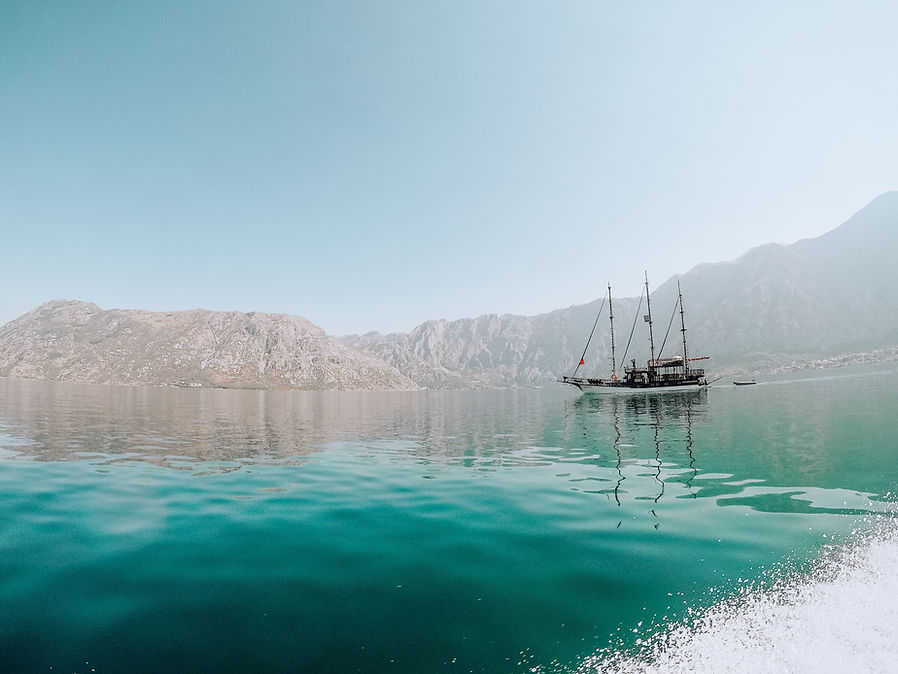
WHERE TO STAY IN MONTENEGRO
When deciding where to stay in Montenegro, consider the region's attractions, accessibility, and your travel preferences, whether you seek relaxation on the coast or adventure in the mountains.
Where To Stay In Kotor Bay:
Kotor Bay, a UNESCO World Heritage site, boasts breathtaking scenery, medieval towns, and cultural landmarks, offering a perfect blend of history and natural beauty. Staying in this region allows you to explore charming coastal towns, hike the surrounding mountains, and discover historic sites.
Budget: Montenegro Hostel Kotor offers budget-friendly accommodations with dormitory and private rooms, central location, and friendly atmosphere, ideal for budget travellers exploring the Bay of Kotor.
Mid-range: Hotel Vardar provides comfortable rooms, excellent amenities, and a prime location in the heart of Kotor's Old Town, offering convenience and charm for mid-range travellers.
Luxury: For a luxurious stay, consider Hotel Forza Mare , offering elegant rooms, spa facilities, and stunning views of the bay, providing an indulgent experience in Kotor Bay.
Tip: Visit during the shoulder seasons (spring and autumn) for better accommodation rates and fewer crowds, and don't miss hiking to the fortress above Kotor for panoramic views.

Where To Stay In The Budva Riviera:
Budva Riviera, renowned for its sandy beaches, vibrant nightlife, and historical sites, attracts visitors seeking sun, sea, and entertainment. Staying in Budva or nearby coastal towns allows easy access to beaches, cultural attractions, and lively nightlife.
Budget: Montenegro Hostel Budva offers budget-friendly accommodations with dormitory and private rooms, close proximity to the beach, and a social atmosphere, ideal for budget travelers exploring the Budva Riviera.
Mid-range: Hotel Astoria Budva provides comfortable rooms, modern amenities, and a central location near the Old Town and beaches, offering convenience and value for mid-range travellers.
Luxury: Splendid Conference & Spa Resort offers luxurious accommodations, spa facilities, and beachfront access, providing an upscale retreat with panoramic sea views along the Budva Riviera.
Tip: Consider visiting in the shoulder seasons (May-June and September-October) for pleasant weather, fewer crowds, and better rates, and explore nearby coastal towns like Petrovac and Sveti Stefan for a quieter atmosphere.

Where To Stay In Durmitor National Park:
Durmitor National Park, a UNESCO World Heritage site, showcases rugged mountains, pristine lakes, and outdoor adventures, making it a paradise for nature lovers and outdoor enthusiasts. Staying in or near the park allows for hiking, rafting, and exploring its natural wonders.
Budget: Camp Durmitor offers budget-friendly camping accommodations with basic facilities, stunning mountain views, and proximity to hiking trails, ideal for budget travelers seeking outdoor experiences.
Mid-range: Hotel Soa provides comfortable rooms, wellness facilities, and a scenic location near the Tara River Canyon, offering a relaxing base for exploring Durmitor National Park.
Luxury: Hotel Zabljak offers luxurious accommodations, gourmet dining options, and panoramic views of the surrounding mountains, providing an upscale retreat amidst the natural beauty of Durmitor.
Tip: Visit during the summer months for optimal hiking and outdoor activities and consider booking accommodations with outdoor terraces to enjoy the mountain views.
CHOOSE ANOTHER DESTINATION
Recent blog posts, plan your trip, visa services, let ivisa take the pain out of travel planning and assist you with electronic visas, travel authorizations, visas on arrival, and even paper visas. they can also help with health declarations and embassy registrations. if you're from the us, they also provide a one-stop shop to renew your passport securely and error-free..
FLIGHTS Find a cheap flight by using Sky scanner or Momondo . These are our favourite flight search engines. They index other travel websites and airlines across the globe to easily find you the best deal.
ACCOMMODATION
Booking.com is our number one resource for researching and booking accommodation. In addition to Booking.com , we have found Agoda.com to consistently returns the cheapest rates in Southeast Asia.
TRANSPORT
DiscoverCars.com is a leader in online car rental bookings; we compare car rental deals from many companies so that you can choose which is best for your trip. 12Go connects the world door-to-door, from transfers to flights, under the same user-friendly ticket.
INSURANCE Travel insurance can protect you against unexpecte d illness, injury, theft, and cancellations.
Heymondo (International Travel Insurance)
World Nomads (Travel / medical insurance for long-term travellers and nomads)
SafetyWing Nomad Insurance (Travel / medical insurance for long-term travellers and nomads)
Need more help to book your trip? Check our complete resource page for all the best companies to use when you travel. You will only find the companies we use ourselves.
Please note that some of the links above may be affiliate links, and at no additional cost to you,
we may earn a commission if you end up making a purchase.
Wander-Lush
Visit Montenegro: The Ultimate Montenegro Travel Guide
- Europe / The Balkans
Am I in Paradise or on the Moon? George Bernard Shaw on Montenegro
In Search of the Black Mountain
I don’t think I’m being controversial when I say that Montenegro is one of the most beautiful countries in Europe. When I road tripped around Montenegro for 10 days , it rained incessantly – and yet I still fantasise about the Martian landscapes.
From hiking in Lovcen and Durmitor National Park , summiting Bobotov Kuk and casting eyes on the glacial Black Lake , to rafting on the Tara River or kayaking on the glassy Bay of Kotor , travelling in Montenegro is a requiem for outdoors enthusiasts.
Then there are other kinds of adventures, such as driving the Kotor Serpentine and catching sunset from the top (truly one for the ages). Trace the romantic Boka Kotorska, visiting the UNESCO World Heritage old towns in Kotor and Budva , and draw out your time in Perast , my favourite place in Montenegro, for as long as humanly possible.
Dip your toes in the capital, Podgorica , a city everyone loves to hate on, before heading for the incredible Lake Skadar . Shared between Montenegro and Albania , the largest lake on the Balkan Peninsula is as picturesque as it is bio-diverse. It’s worth making a detour to ride the rails from Podgorica to Bar – the final leg of the legendary Belgrade to Bar train – which delivers incredible views as it ambles across the lake bridge.
From Herceg Novi all the way to Ulcinj , every day in Montenegro is filled with ‘wow’ moments. Best of all, it’s so compact and easy to get around, you can see it all in a few short weeks.
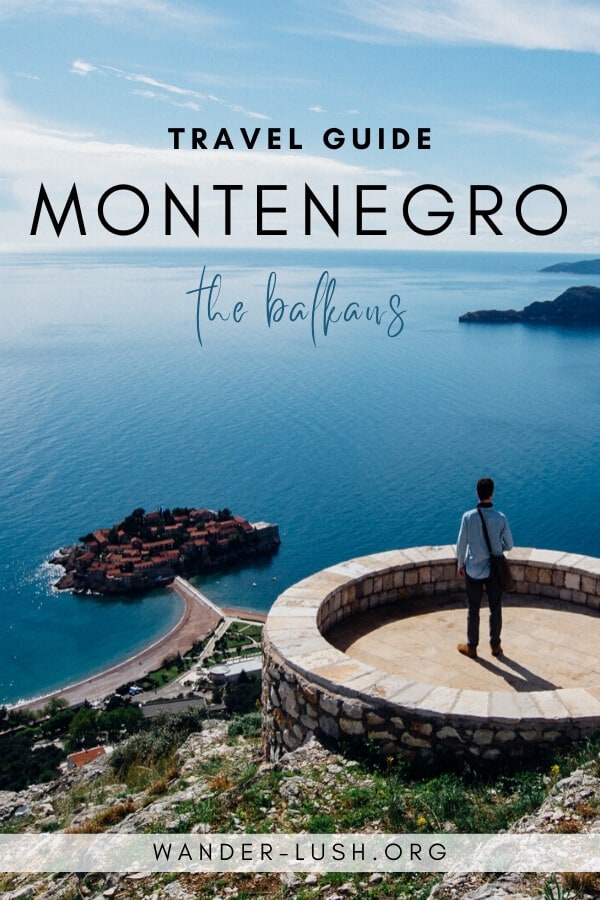
Montenegro travel essentials
Please note: Some of these links are affiliate links, meaning I may earn a commission if you make a purchase by clicking a link (at no extra cost to you). Learn more .
May/June or September/October (shoulder seasons); June-August for hiking.
How long in Montenegro?
If driving, allow 10 days for the highlights; 2 weeks to see (almost) everything.
Daily budget
60 USD per person per day (mid-range hotel; restaurant meals; car hire; museum tickets).
Getting there
Fly into Podgorica, Tivat or Dubrovnik, (Croatia); train from Belgrade; drive/bus from any neighbouring country.
Montenegro visa
Visa-free for most passports (stay up to 90 days).
Getting around
Hire a car; use intercity buses; take the train to Bar.
Where to stay
Hostels, family-run guesthouses or hotels.
Tours & experiences
Old town walking tours, boat trips and monasteries.
Explore Montenegro
Discover all the best things to do in Montenegro with my latest travel guides.
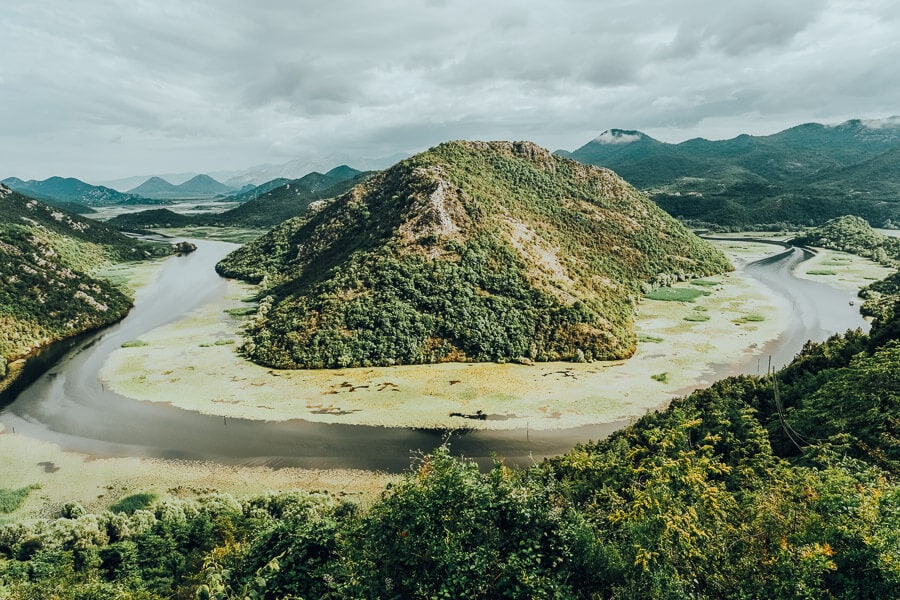
21 Useful Things to Know Before You Go Travelling in Montenegro

35 Useful Things to Know Before You Rent a Car & Go Driving in Montenegro
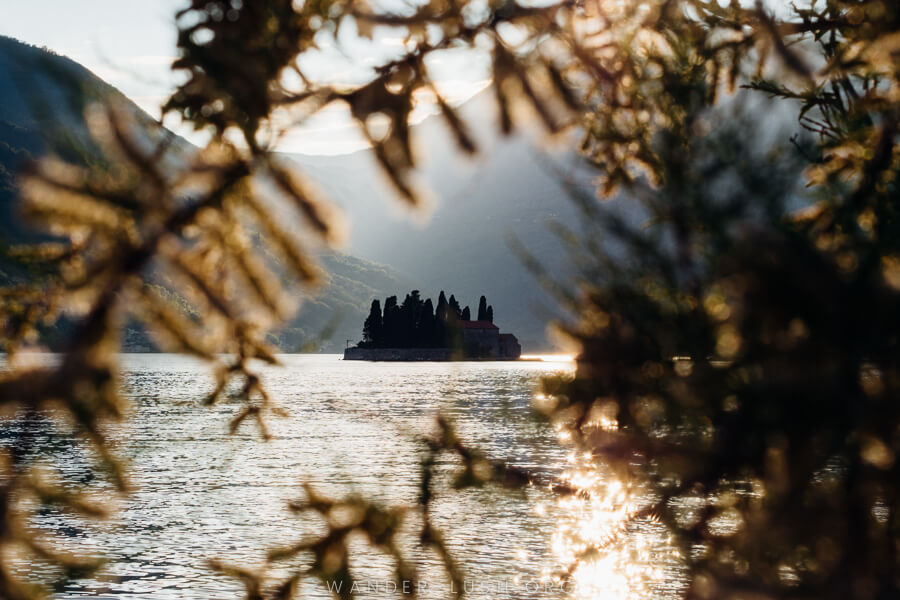
Montenegro Road Trip: The Perfect One Week Itinerary
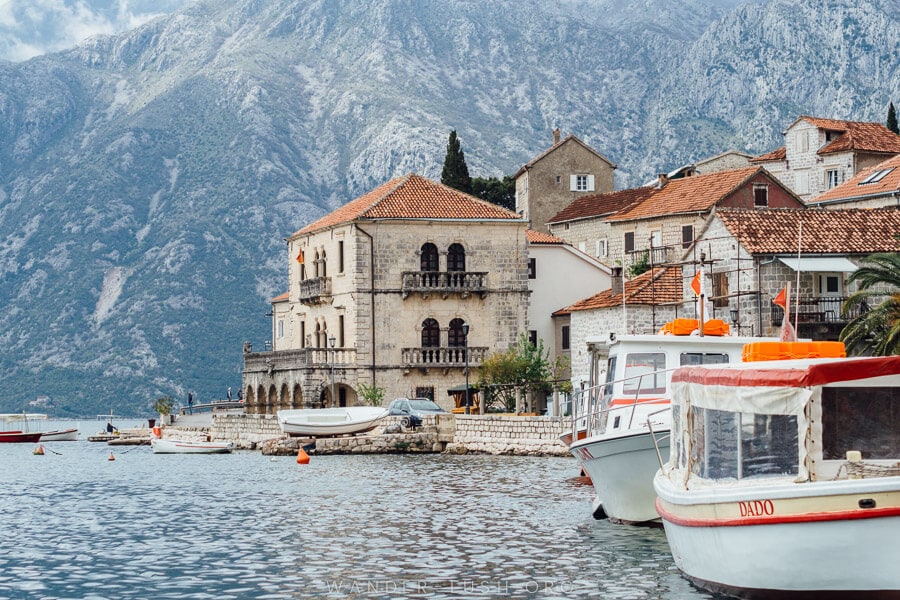
13 Things to Do in Perast, the Loveliest Town on the Bay of Kotor
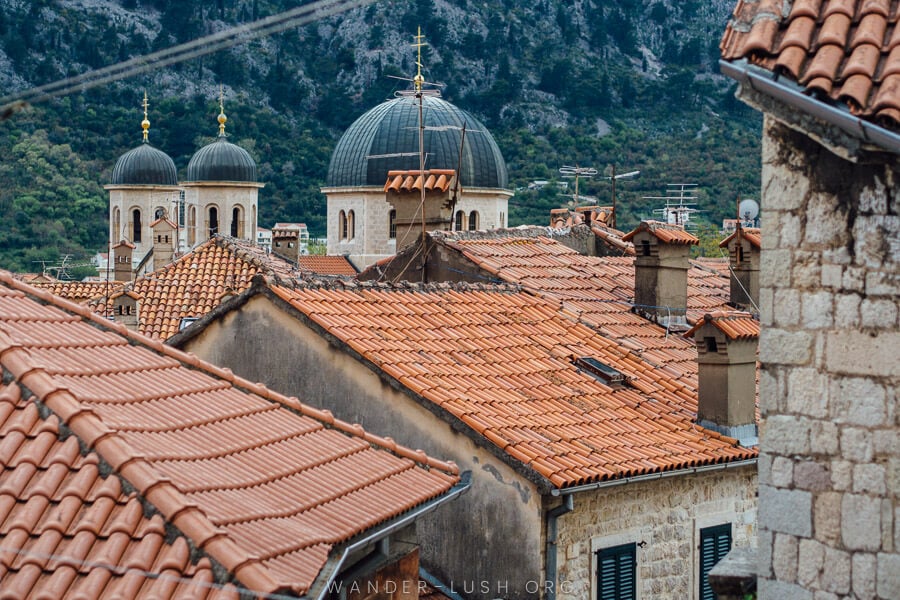
12 Wonderful Things to Do in Kotor, Montenegro
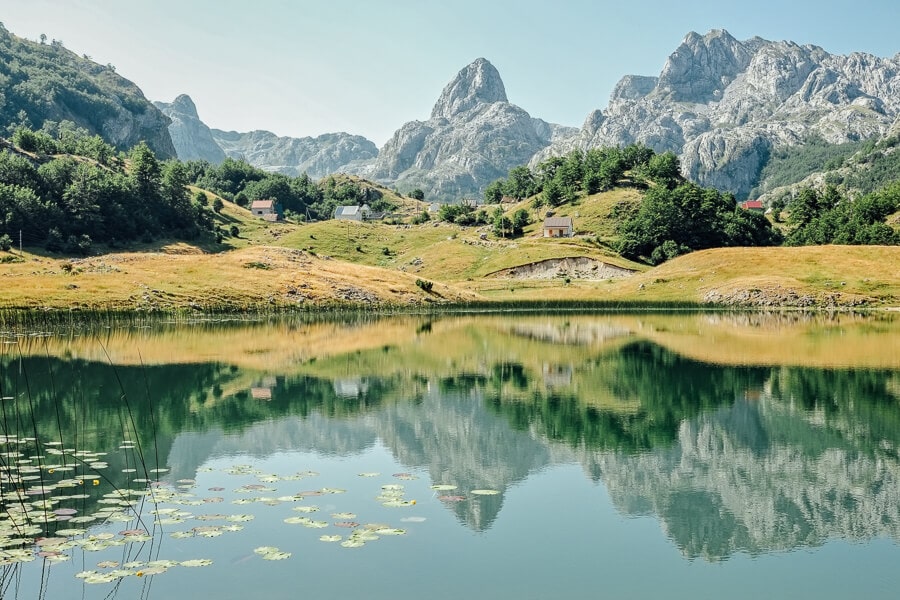
25 Most Beautiful Places in Montenegro to Add to Your Itinerary
My montenegro favourites.
Bobotov Kuk in Durmitor National Park.
Must-eat meal
Home-made Sarma (cabbage and mince rolls).
local experience
Sunset drinks in Perast on the Bay of Kotor.
best souvenir
A bottle (or two!) of local Vranac wine.
- Montenegro Coast
- Central Region
- North / Mountains
- Where is Montenegro?
- Useful Information
- Visa Requirements
- Events & Festivals
- Interesting Facts
- Invest in Montenegro
- Buying a Property
- Airport Transfers
- Airports & Flights
- Car Rentals
- From Dubrovnik
Guides and Brochures

Visit Montenegro brochure brochure provides condensed facts about Montenegro: one-liners about the most interesting towns and their history. You will find compact information about the most beautiful and popular beaches, captivating lakes and canyons, monasteries carved into mountain sides and at-the-mountaintop monuments that deserve to be on your bucket list.
This brochure is a compressed walkthrough of Montenegro. Glance through it to get hints on where to go for a memorable adventure.
Download Brochure
27 Things You Should Know Before Visiting Montenegro
Are you considering traveling to Montenegro ? If yes, do you know some facts about this country? If no then we have them for you! This Balkan country is one of the famous tourist destinations in the world. Having plenty of beautiful places and exciting activities, it will make your next holiday enjoyable as ever.
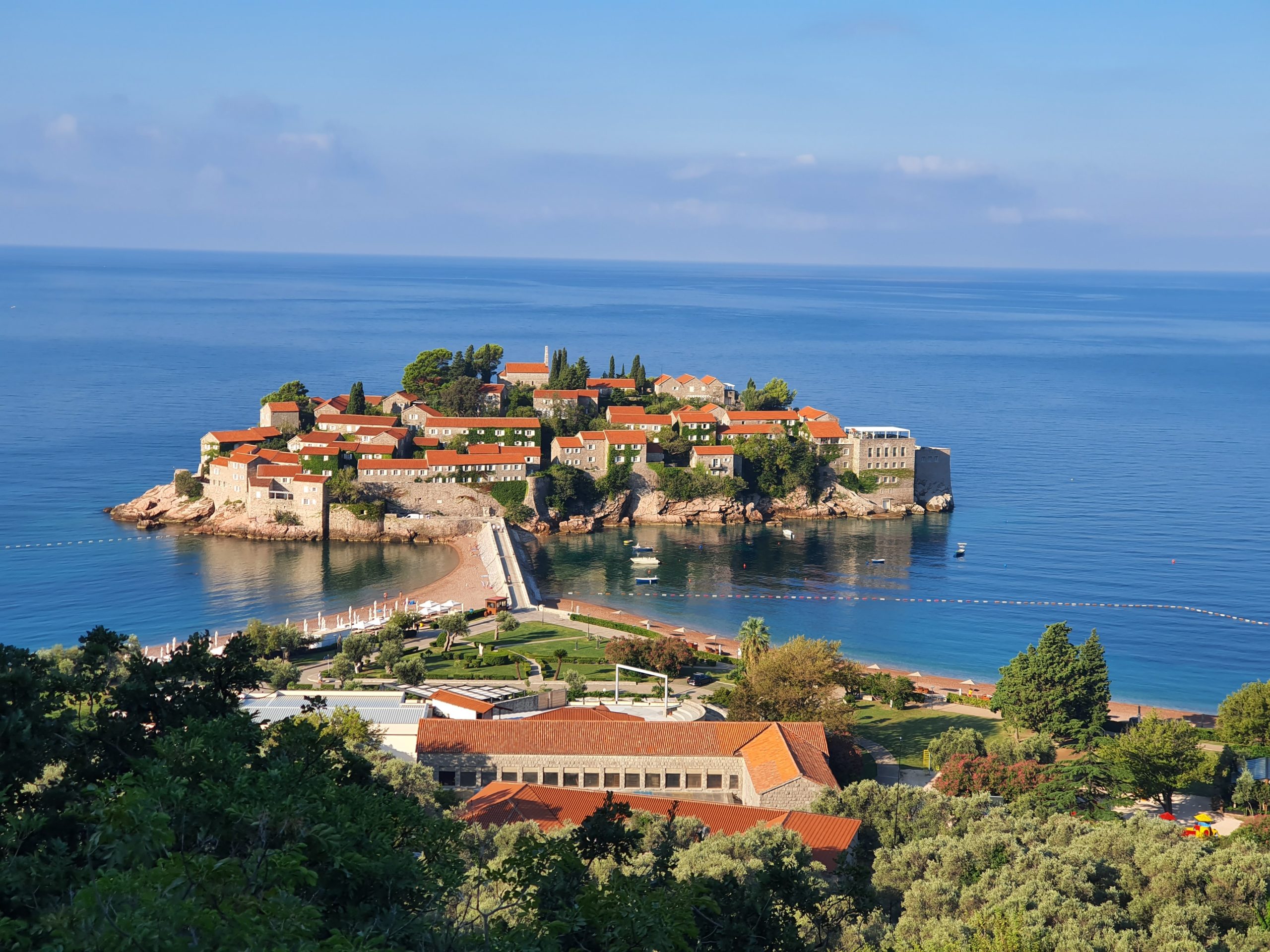
Montenegro surely has a lot of surprising and interesting facts that are ready to be explored by a traveler like you! Having tons of castles and historical sites, it offers an exciting and meaningful trip to anyone staying here.
- Diving in Montenegro – Our Underwater Experience in Boka Bay, Herceg Novi
- How To Apply for Montenegro Visa for Philippines Passport Holders – Tourist Visa for Filipinos
- Balkans Local Cuisine: 10 Types of Montenegro Dishes that You have to Try
- 15 Best Places That You Must Visit in Montenegro
- 12 Reasons Why You Should Include Herceg Novi, Montenegro In Your Travel Bucketlist
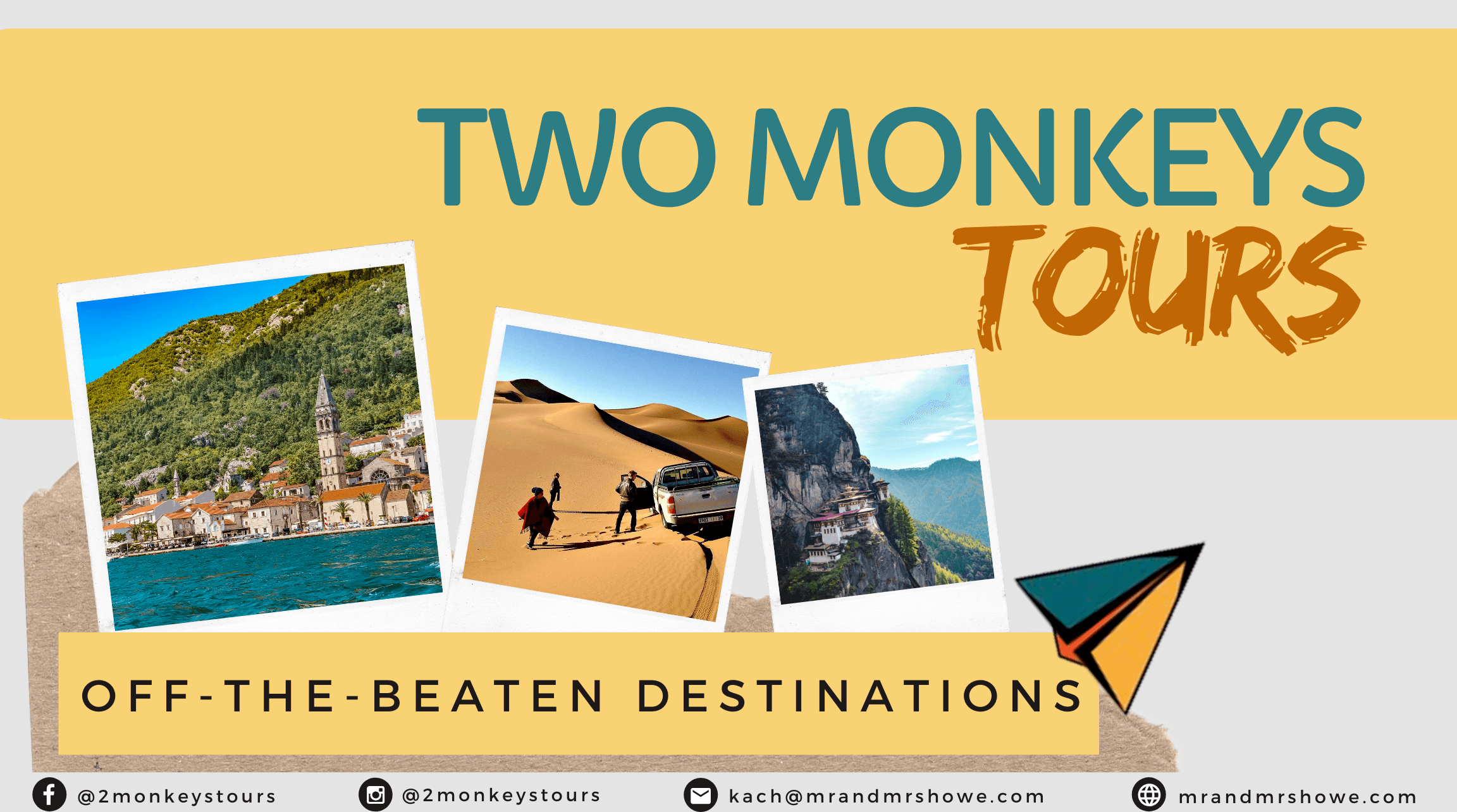
Just to be prepared before your trip, we listed the things to know about Montenegro for you to know what to expect when you go there. These facts are surprising and interesting at the same time. But these will also help you have a wonderful stay and will help you learn more about the country’s culture that of course, we need to respect. Here are the facts about Montenegro.
1. As of 2019, the population in Montenegro is 627,987.
2. the official language is montenegrin. however, bosnian, croatian, serbian and albanian are also widely spoken. , 3. montenegro uses the euro as its currency. however, it does not print or issue its own euro. it imports them from other countries. .
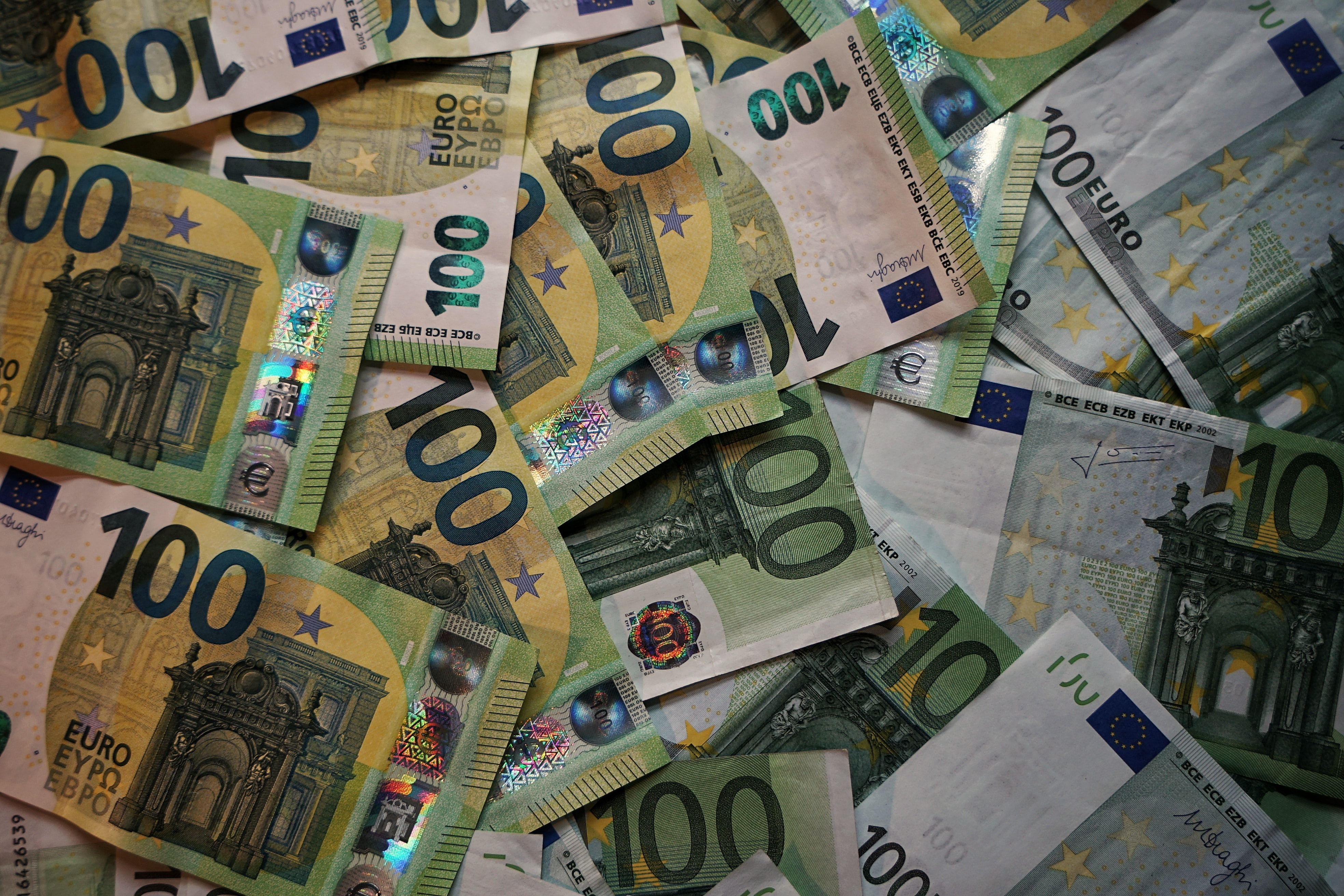
4. Montenegro gained its independence from Serbia in June 2006 making it one of the newest countries in the world.
5. one of the oldest olive trees in the world can be found in mitrovica, a village in montenegro. it is said to be at least 2,000 years old, 6. montenegrins are considered as some of the tallest people in the world. the average height for men is 1.83 m (6ft)., 7. montenegro is one of those countries that is diverse. with montenegrins, serbs, bosnians, and albanians living in the country, it’s not surprising to see a mixture of religion, ethnicity, and language..
8. Montenegro is a small country, it is almost equal to the size of Connecticut, USA.
9. Filipinos need a visa before entering Montenegro
Requirements for Visa application (For Filipinos)
- Completed Visa application form.
- A passport that’s at least 6 months valid.
- One colored photo (35×45 mm)
- Proof os purpose of stay in Montenegro. (It can be an invitation letter, a state authority in Montenegro, or a letter from an organizer of an event in Montenegro)
- Proof of accommodation.
- Proof of sufficient funds, it can be a bank account, traveler’s checks, credit cards, etc.
- A return ticket.
- Proof of means of travel in Montenegro (transportation tickets or driver’s license).
- Proof of health insurance.
- Proof of the consular fee that has been charged.
10. Montenegro has a total number of 117 beaches.
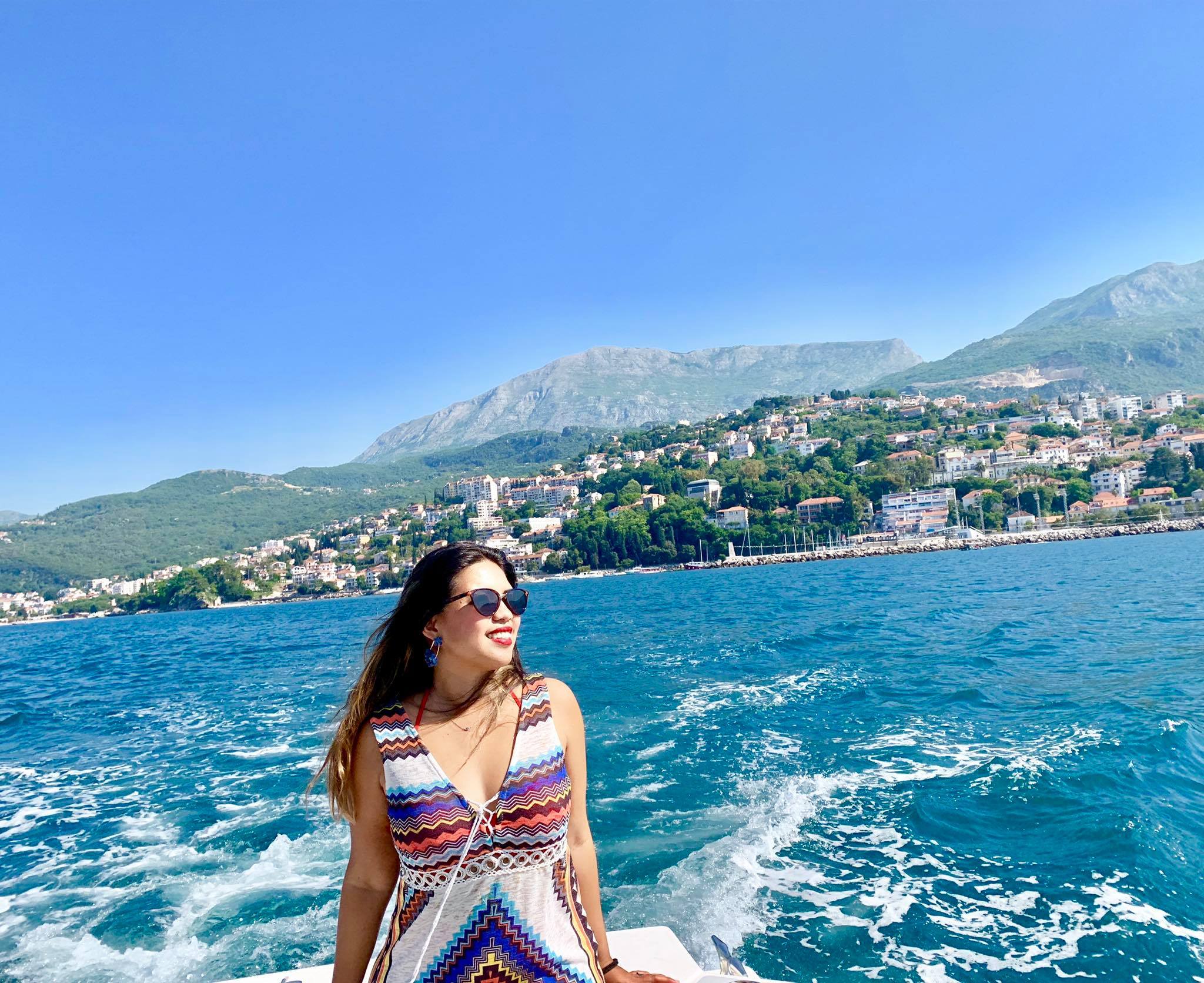
11. It is one of the most famous tourist destinations in the world.
12. Lord Bryon, a legendary English Romantic Poet described Montenegro as: ‘At the birth of the planet the most beautiful encounter between land and sea must have been on the Montenegrin coast’.
13. Podgorica is the capital city of Montenegro.
14. Montenegro’s flag features a lion. It is based on the flag that was in use during King Nicola I reign in 1910 to 1918.
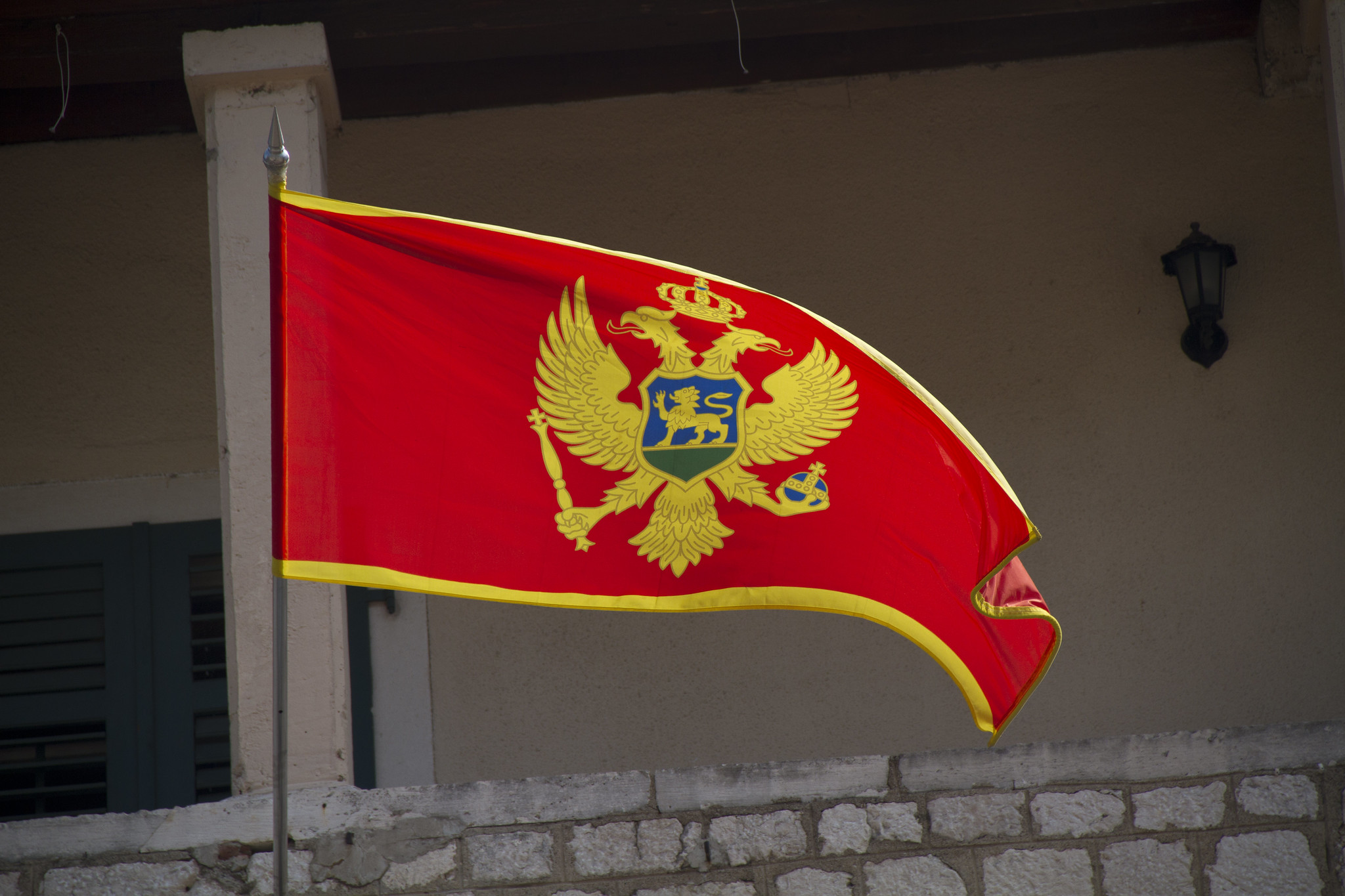
15. The Tara River measures 144 km in total and 110 km of it is in Montenegro. The 34 km are in Bosnia & Herzegovina.
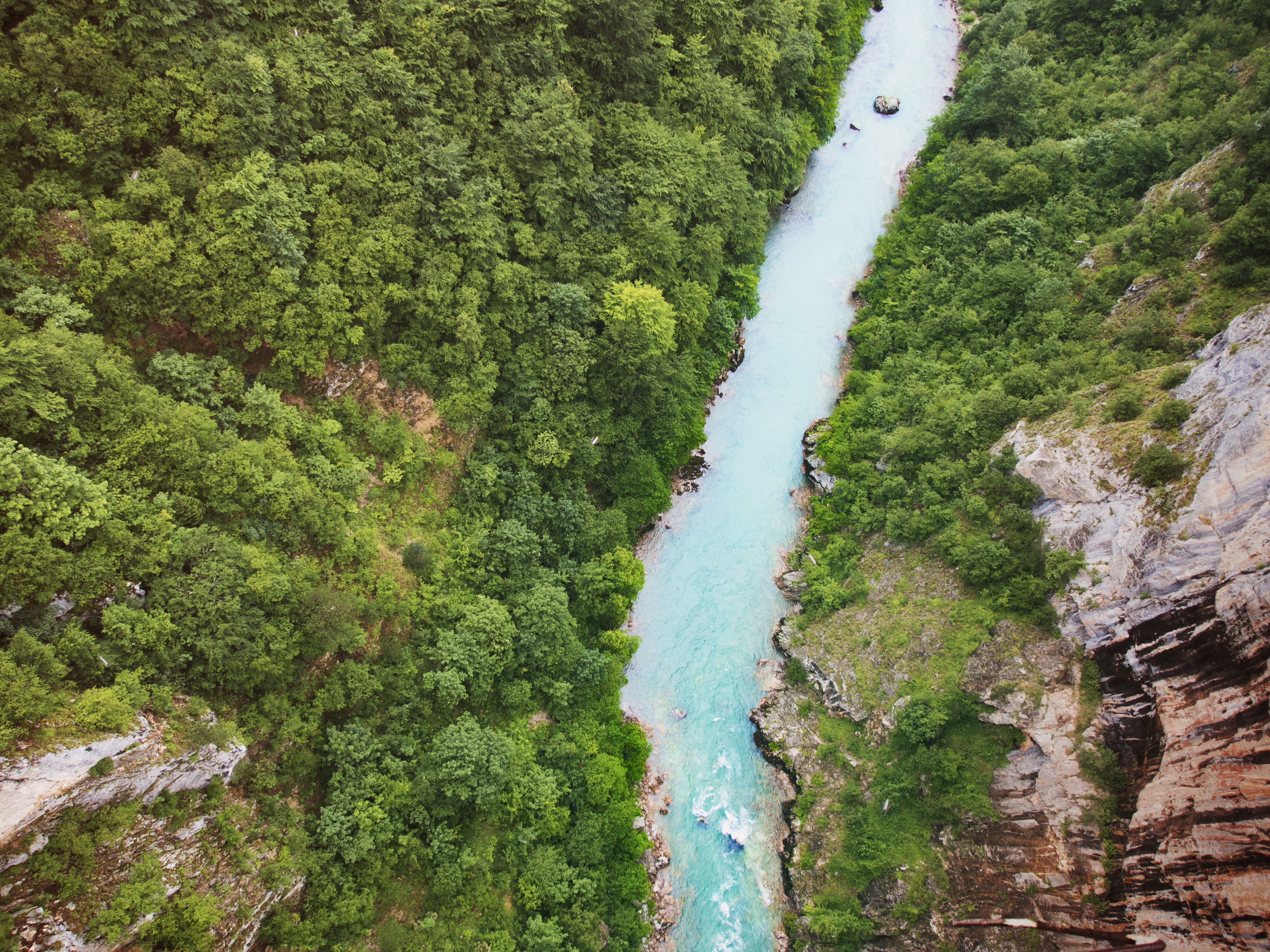
16. The major trade partners of Montenegro are Italy , Serbia , Germany , Hungary , and Croatia .
17. Sveti Stefan is the most popular tourist destination in the country. It is just 15 minutes away from Budva, by car.
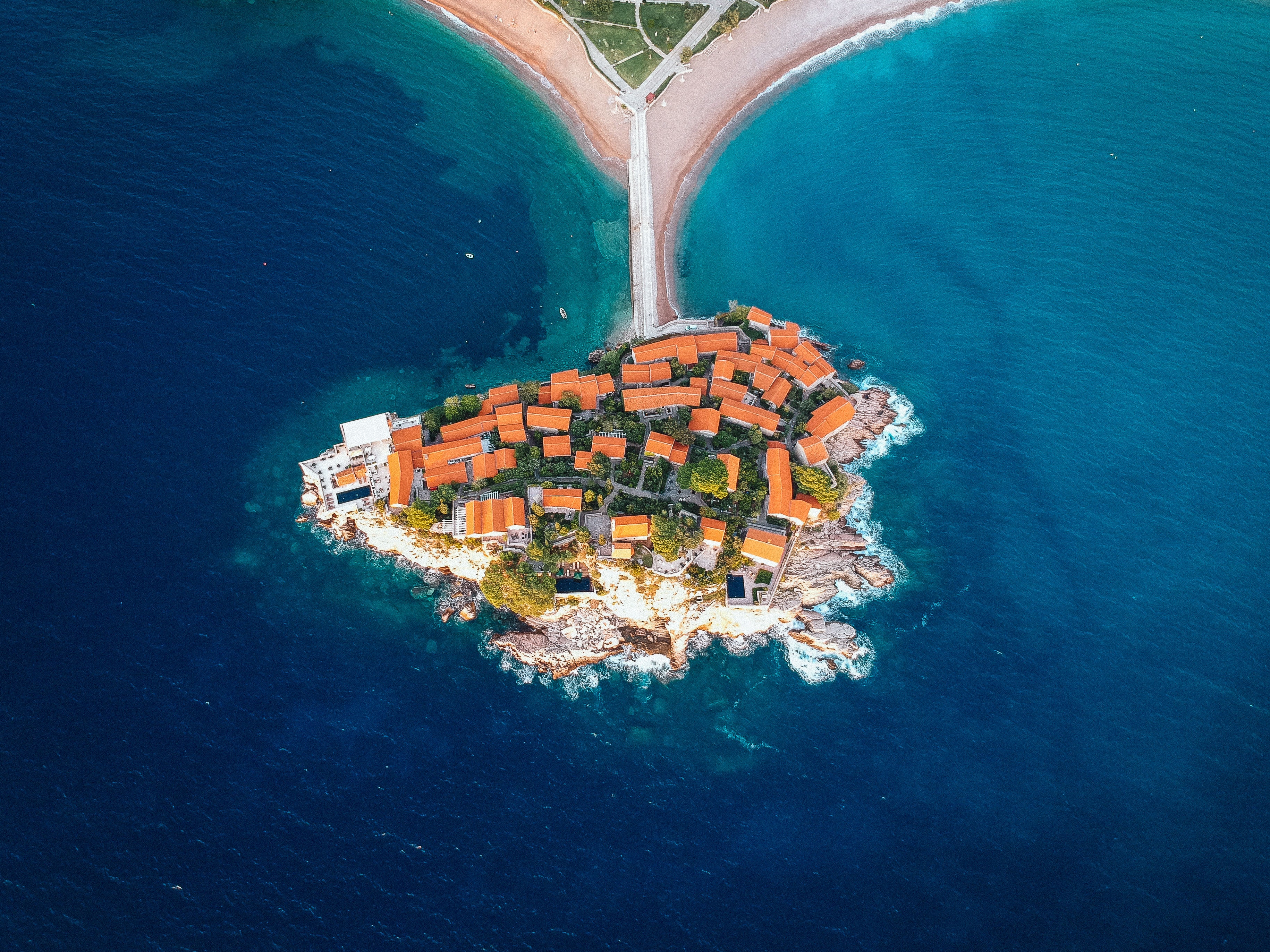
18. The National Holiday of Montenegro is celebrated every July 13. It is known as Statehood Day.
19. During the winter season, Montenegro’s weather becomes really cold, snowy, and intolerable. So fewer tourists go here during these months.
20. The first National Printing House was in Montenegro.
21. Montenegro became the 192nd member of the United Nations on June 26, 2006.
22. In Montenegro, it is part of their custom to bring a box of coffee and a bottle of wine when being invited by someone.
23. About 47% of Montenegro’s population is between the ages of 25 and 54.
24. Montenegro has a 99% high literacy rate.
25. It may be a small country, but Montenegro has a total of 5 airports (2 international and other 3 for aviation/military).
26. More than a million mobile subscriptions and 160,000 fixed-line telephone connections are there in Montenegro.
27. 60% of Montenegro’s population uses the internet.
These are the things to know about Montenegro that would get you ready when you decide to visit and explore this Balkan country. Make sure to make the most out of your adventure and bring home great memories as you leave this place and went back to your homeland.

Are you on Pinterest? Pin these!
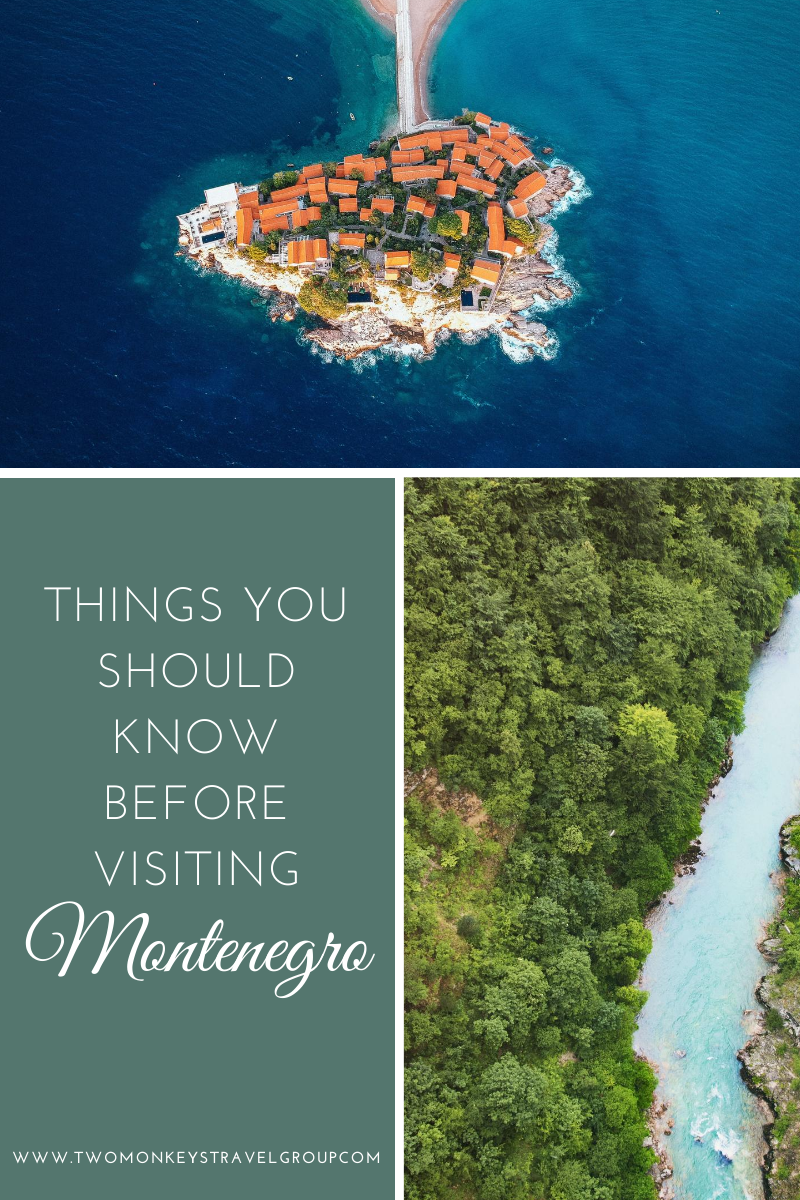
Leave a Reply Cancel reply
Your email address will not be published. Required fields are marked *
This site uses Akismet to reduce spam. Learn how your comment data is processed .
One thought on “ 27 Things You Should Know Before Visiting Montenegro ”
Hi, very nice, but have some things to comment 🙂 Montenegro is a 1000 years old country and actually in 1878. it was finaly completely liberated and recognized as 26th independent country in the World. Since forever the official language in Montenegro was Serbian and since 2006. It’s called Montenegrin, Serbian, Croatian and Bosnian (equally) because of the politics. The print house was the “Crnojevica” print house not national, it was considered as the first one along South Slavs (back then nationality didn’t exist).
COPYRIGHT DISCLAIMER: Many of the articles on Two Monkeys Travel Group are guest posts by a number of Approved Contributors and are hosted by Two Monkeys Travel Group. Approved Contributors control their own work and post freely to our site. This includes all text and images that they use within their own work. All contributors are instructed to follow internationally recognised copyright and intellectual property guidelines. Two Monkeys Travel Group takes its own responsibilities very seriously, so if you feel that any part of this work is abusive in any way, please send us an email so that we can investigate - [email protected]
DISCLOSURE: Please note that some of the links above are affiliate links. So when you make a purchase we sometimes make a small commission, at no extra cost to you. The cost to you remains the same, sometimes even cheaper if we have negotiated a special deal for our readers.We use all of the companies we have listed here and that’s why they are in this list, but of course we need to keep Two Monkeys Travel Group running as well as it can, which is exactly what you’re helping with if you do decide to buy or book something through an affiliate link! If you have any more questions about the companies we use or any other companies you’re looking at, just email us and we’ll be happy to help. Please see our full disclaimer page for more information.
Written by Two Monkeys Travel - Contributor
Two Monkeys Travel Group – Community Travel Blog is a travel blog and website. We quickly grew into a valuable source of inspiring travel stories, advice, itineraries and travel guides, with the aim of demonstrating how to live a sustainable life of travel, whilst living your own definition of success. If you'd like to contribute and write a guest post, contact us at [email protected]
11 Best Hiking Treks To Experience in Nepal
Getting the most out of your holiday in bali, 5 best things to do in canggu, bali, indonesia [diy travel guide to canggu], 10 awesome things to do in florence, italy, africa unveiled: discovering the continent’s hidden gems and iconic landmarks, related posts, 10 best things to do in kos, greece [with suggested tours], how to apply for schengen belgium visa for filipinos [belgium schengen visa guide for filipinos], import and customs law in montenegro – what to remember, why majorca is spain’s best multi-destination holiday island, previous post, 15 things to do in reno, nevada [with suggested 3 day itinerary], 7 things to do in afghanistan [best places to visit in afghanistan], subscribe to our newsletter.
Receive tips on how you can live a sustainable long-term travel lifestyle!
- First Name *
- Email This field is for validation purposes and should be left unchanged.
Road is Calling
Montenegro Road Trip: 3 Scenic Itineraries for One or Two Weeks
With my Montenegro road trip itineraries, you can go on short drives in different directions or combine them all in one big Montenegro tour and explore the country in 7 or even 10 days.
These are the routes Mark and I have personally driven many times and they are great picks for anyone thinking of going on a drive in Montenegro in any season.
If you feel like these suggestions are still not enough and you need more tips, check also my Montenegro itinerary for 7 days that starts from Herceg Novi or 5 days in Montenegro itinerary from Podgorica . Or, for a more personalized touch on any road trip itinerary you may have in mind, get in touch and I’ll take a look.
Calling Montenegro now my second home, I am always excited to share my personal insights to enhance someone’s travel experience!
Please note: This post contains affiliate links. I may earn a commission if you make a purchase or booking by clicking a link (at no extra cost to you).
Montenegro Road Trip Itineraries (Great for 5, 7 & 10 Days in the Country)
Road trip around montenegro’s famous bay of kotor.

Herceg Novi
- Donji Stoliv
This road trip is great to start from Tivat where many people fly into and where renting a car is easy. However, you can also start it in Herceg Novi when arriving from Dubrovnik .
While Tivat is more straightforward, from Dubrovnik, there are two ways to do it.
The first is to rent a car in Dubrovnik city (or airport) with the drop off in Podgorica. This is a bit more expensive but works well for those who fly out of Podgorica or continue their journey along the coast to Albania. There are very few rental companies that allow international one-way rental. Two companies I know, which allow that are Green Motion and Carwiz .
Another option is to come to Herceg Novi from Dubrovnik by bus, which doesn’t take very long. Spend some time in town and then rent a one-way rental car from a local supplier . They are much more flexible on one-way rentals, and deliveries to smaller towns and often are cheaper than to rent at the airport. This way you can drop off your car in Budva or any other town convenient for you.
This town is not large but has a luxurious vibe with nice-looking harbor condos and some really fancy yachts parked at the marina.

All sorts of restaurants, cafes, bars, and bakeries, are at your disposal. Not to mention some shopping and a nice-looking boardwalk. Spend some time there but not too much before heading out to Kotor.
Here is my guide to Tivat to make planning easy.
The town of Kotor is a highlight of the Boka Bay with the largest old town included in aged city walls and a magnificent extension of the city wall stretching uphill, which you can hike along.
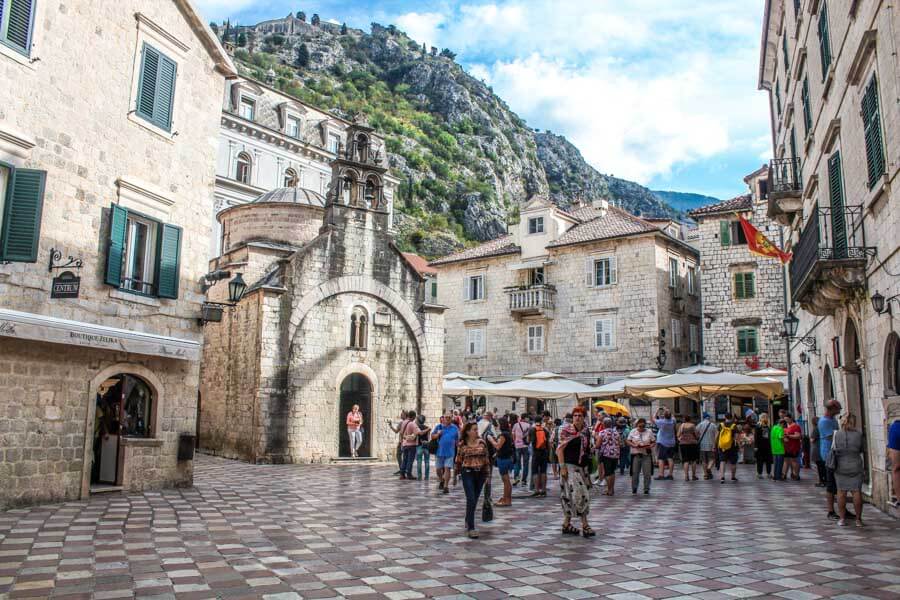
This is a city where cruise ships arrive, and at those times, it can get pretty crowded. Luckily they don’t come every day. Despite that, I highly recommend spending some time there, getting a meal or a drink in Old Town, and visiting the town’s attractions, such as the Kotor Fortress.
On the way out of Kotor, I suggest stopping by Dobrota which is a settlement that has grown next to Kotor and has lots of cute guesthouses, a variety of restaurants, and a pleasant walk along the shore of the bay. This is a good stop to make to escape Kotor’s tourist crowds and grab a cheaper snack in a relaxing atmosphere.
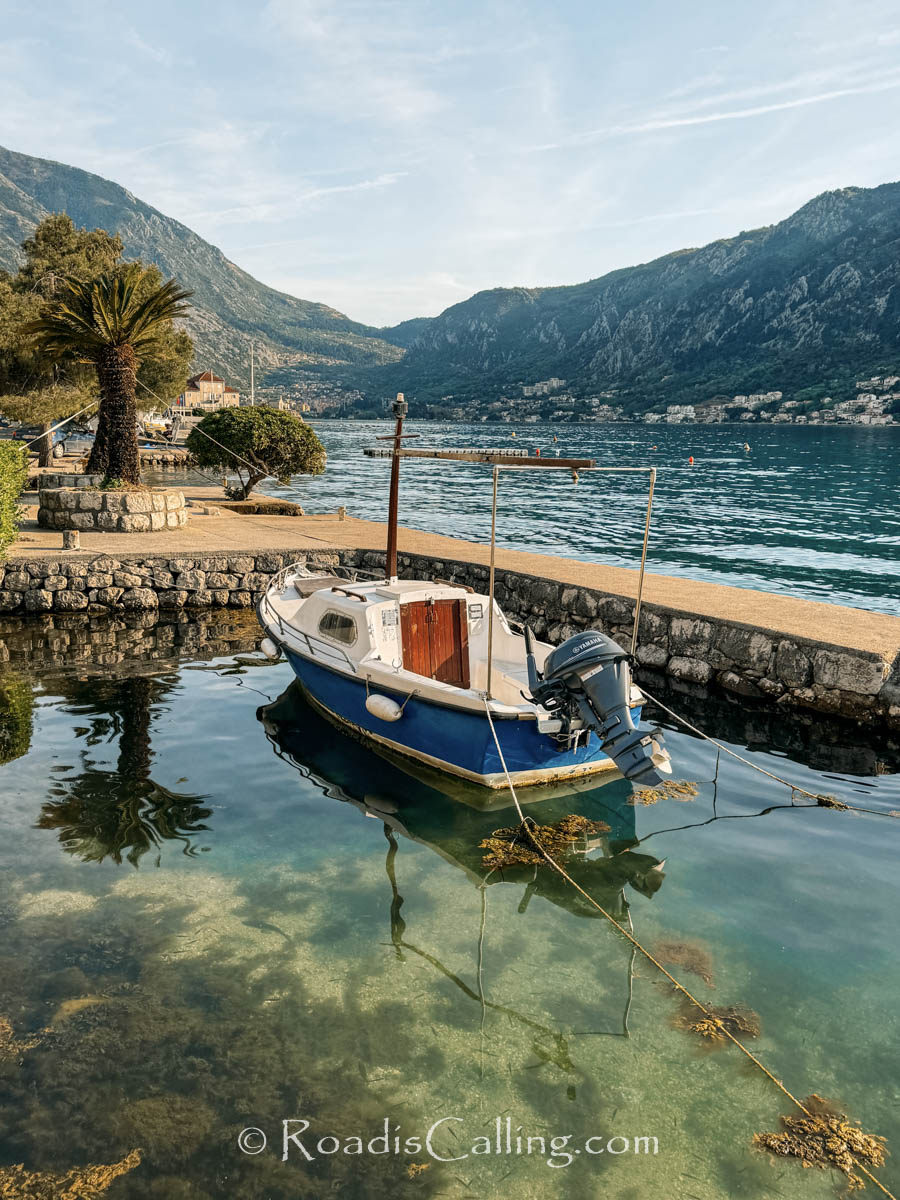
This is the second most famous town in Kotor Bay and is an iconic place for the Montenegro landscape. It is here where you can take a boat to the famous Lady of the Rock Island, which is an artificial islet with a Roman Catholic church dedicated to the Virgin Mary.
Once there, don’t miss a chance to walk on the waterfront, get a view of the bay from the Bell Tower, and if visiting outside in summer (like fall or spring), go hiking above Perast for views and the ancient fortress.
This town is more of a quick stop on the route to get refreshments in the little old part within its courtyards just a step away from the waterfront.
This is a newly built marine harbor area of Herceg Novi province that gives you a luxury feel of newly built coastal condominiums and a beautiful exclusive 5-star Hotel One & Only .
You don’t need to stay there, but if you like, stop at their exquisite lounge bar with the views or at their beach club in summer.
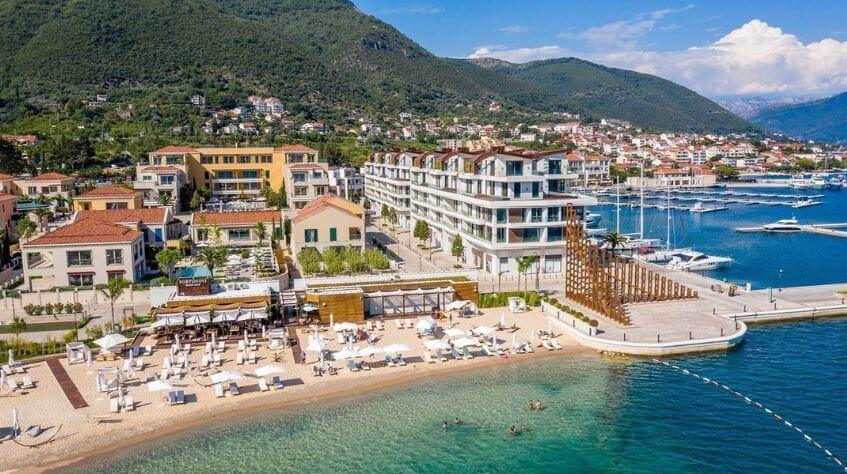
Of course, besides the hotel, there are other restaurants and cafes you can enjoy. For coffee, stop at Kafeterija Portonovi . And for food, if you are looking for something quality, yet not expensive, stop at Kantina65 . It is just outside of the “Newly developed” area and they offer a buffet for just €6 or €8, depending on your choice.
TIP : Before you even reach Portonovi, there are many other places where to stop along the way like Kamenari, Bijela , Baosici, and a couple of panoramic restaurants between them. Of course, make stops for photography because scenic landscapes open up around each corner.
In summer, beach clubs start welcoming guests as well, so if you want to take it slower, there is a chance to do so. Our favorite beach clubs are Tramontana Beach Club in the small village of Morinj and El Cortez in Orahovac before you even reach Perast.
Herceg Novi is not a big town but it is definitely worth visiting as it is one of the nicest places on the Montenegrian coasts. Many people suggest that Herceg Novi is the best town for living in the country.
Despite the city’s size, there are actually a lot of interesting things to do in Herceg Novi , so ideally I would suggest spending a night or even two there. But that applies to the whole country, really. It seems small but packed with wonderful things and places to explore.
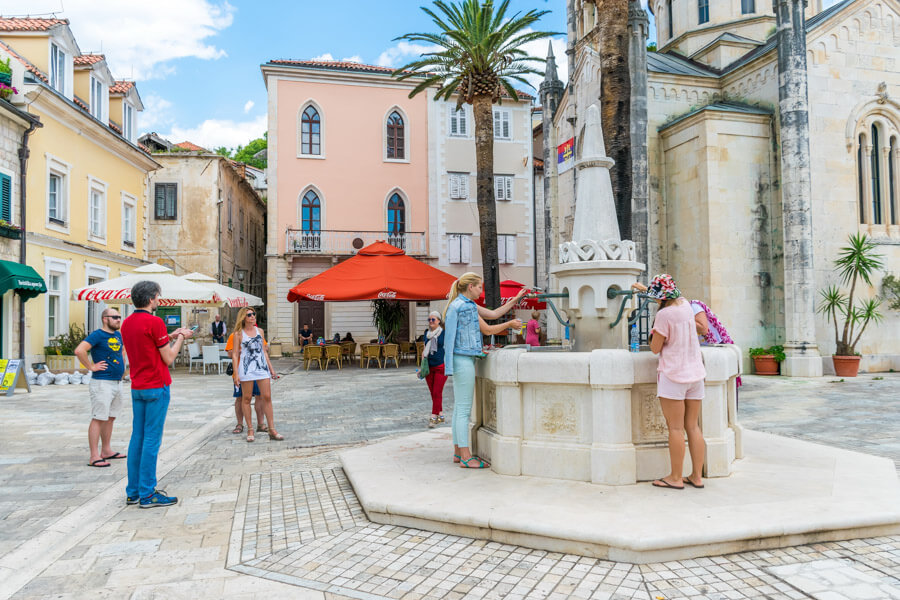
If you have limited time, spend here what you can but do not skip for sure.
There is a nice old town with lots of cozy cafes, restaurants, bakeries, and bars (Anya talks about our favorite spots there in this post). But there is also a very stretched and beautiful coastal line great for walking, running, swimming as well as dining and resting.
After Herceg Novi, it is just a quick drive back to Kamenari where to take a ferry to another side of the bay and continue driving through other Kotor Bay towns .

Donji Stoliv & Muo
These are small towns (or better say villages) with old stone houses, narrow streets, historic churches, and beautiful views of the Bay of Kotor .
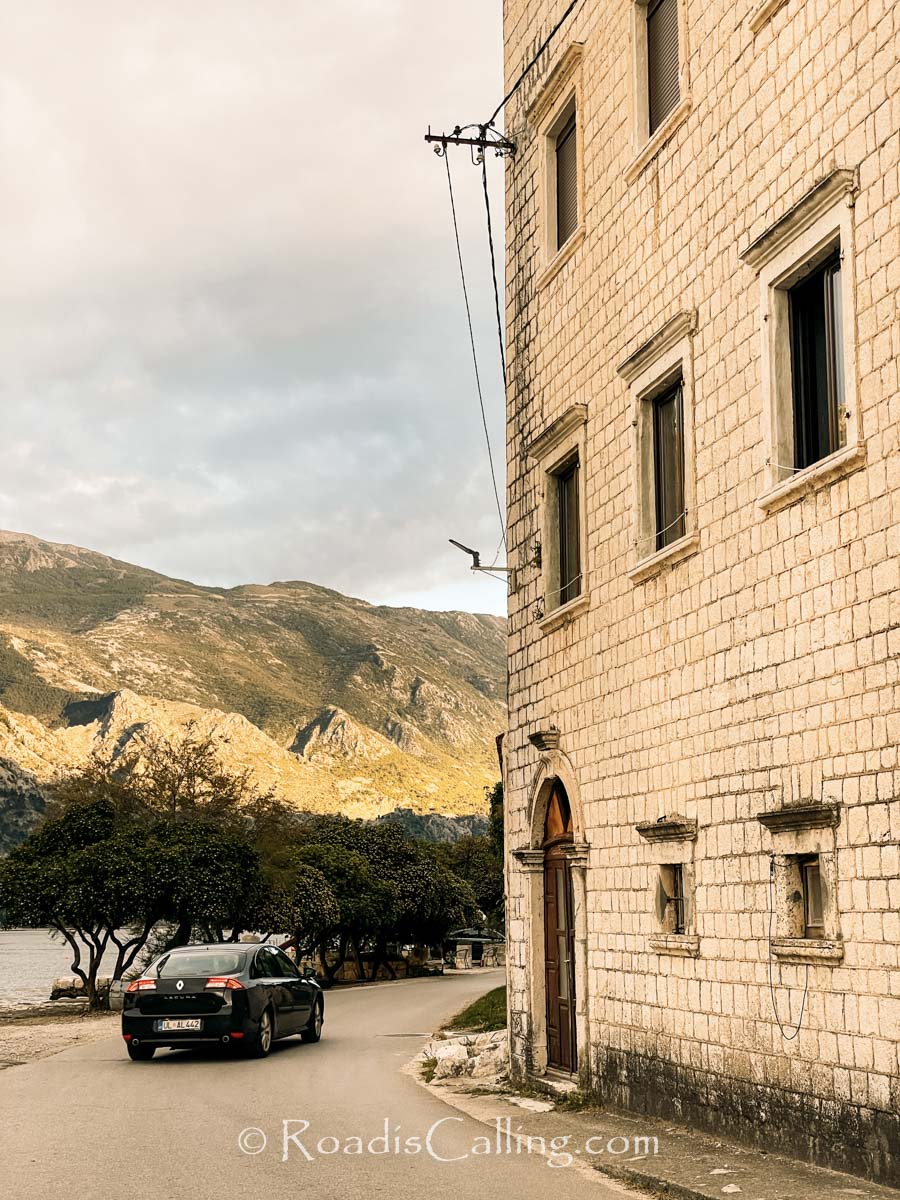
Muo is known for its proximity to Kotor and its seafaring tradition, while Donji Stoliv features centuries-old chestnut trees and a unique blend of Venetian and local architecture.
Above both of them, there is a good network of trails, so if you like hiking, that’s the right area where to do it.
Montenegro Road Trip to See the Coast & Largest Lake

Sveti Stefan
Shkodra lake.
If you are staying somewhere on the Bay, Tivat is a great starting point for this road trip. A beautiful town with a luxurious vibe and a pretty boardwalk.
If you haven’t seen my guide to Tivat yet, here it is with a list of things to do .
This is the fastest growing town in Montenegro which is acquiring a more modern look these days, but you would want to visit their Old Town (and some of its beaches in June and September as they have blue flags).
By the way, before you enter Budva, you can stop at a really nice yet not expensive restaurant Restoran Vista Vidikovac , right off the road driving down the hill. From there you can get a great view of Budva’s old part and the city in general.

Another iconic image of Montenegro – Sveti Stefan, is a must-stop. Unfortunately, because the island is privately owned, it cannot be visited at this time.
But honestly, there is not much need for that. The place is better to be admired from one of the coastal trails . There is also a restaurant “Olive” , where you can make a stop with great views of it.
Before I start talking about Petrovac, I want to say this – I’d recommend skipping this town in July and August due to the high number of people, really bad traffic jams, and rather dirty beaches.
But in spring, late fall, and even winter , Petrovac is an excellent destination in Montenegro with parks, wide streets, beautiful walking trails, and high-class apartments and hotels.
It is ideal for a peaceful (yet not beach-centered) vacation. The area here is beautiful, with greenery everywhere and designated areas for walking.
And for people who have a car and plan to go on road trips around Montenegro, Petrovac is a perfect spot where to make a base.
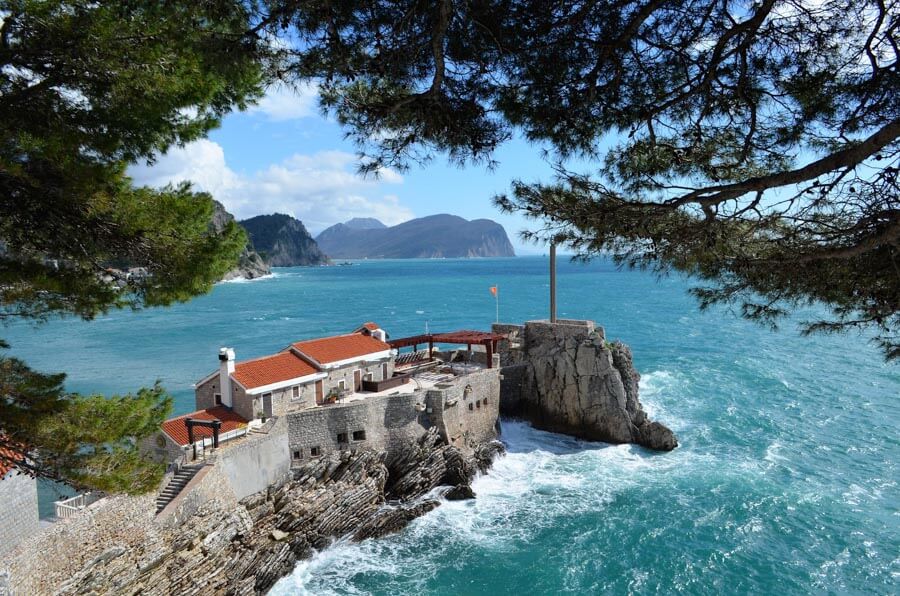
Bar is more of a residential town. I mean there are great cafes and restaurants, the beachside and King Nikola’s Palace if you like history.
But the main thing why to come here is Bar’s Old Town , which is more inland and uphill. It is not very large but pleasant to walk through and you will find some great traditional restaurants there.
Many people come here for the longest beach in Montenegro (name Velika Plaža – it’s about 12 km long) and that is the only truly sandy beach in the country.
But I think Ulcinj is a nice city in Montenegro to visit on a road trip not just for the beach, but for its old town , which is one of the oldest settlements on the Adriatic coast.
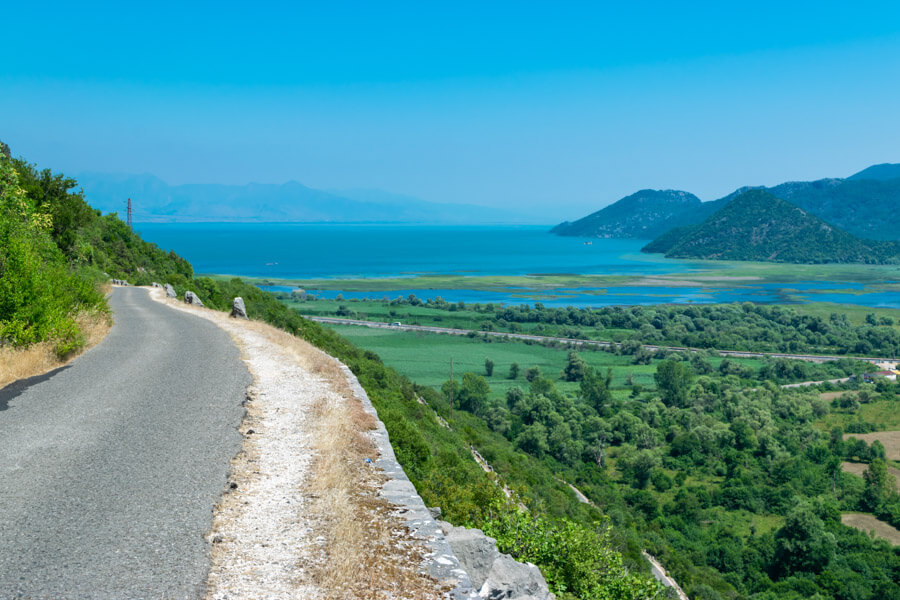
This is one of the biggest lakes in Southern Europe that Montenegro and Albania share together.
As you head towards Virpazar , you will find different recreational opportunities there like boating, kayaking, biking, and gastro tours. Here is a popular spot to go on a tour around the lake and visit a couple of UNESCO sites, fortres, and enjoy a swim.
However, Virpazar lately became too touristy. We like to visit to go to Rijeka Crnojevića , Prevlaka , monasteries on small islands, and one of the wineries (there are many of them in the area).
In-Land Road Trip Through Montenegro To See the Mountains

Moraca Canyon
Bjelasica mountains or komovi mountains, biogradska gora national park, tara canyon, durmitor national park, ostrog orthodox monastery.
This multi-day road trip in Montenegro is great for two categories of people – first, for those who fly into Podgorica and want to combine a bit of history with mountainous nature (especially when traveling in Montenegro in the fall ) and second, for people who had enough of the coast and now want to see other parts of the country as much as possible.
Renting a car in Podgorica airport is also always easy (and often cheaper than in Tivat) but for the lowest price (and best service in our experience), rent it from MTL CarRent or AddCar .
The capital of Montenegro is not considered to be among exciting European capitals but it is the biggest city in the country and is well developing. I suggest you make a start there for the in-land country road trip.

Podgorica was almost entirely destroyed during WW2, so you will not find a noticeable old town or a lot of other historical presence. Yet, it is worth stopping there for a few hours just to get a feel of the city and check out some of its attractions and interesting restaurants.
Walk on its bridges (the new iconic Millennium Bridge and old Ribnica Bridge built by Ottomans), check out one of the parks (there are many in the city, but Gorica Park also offers nice panoramic view of the city), see both mosques and orthodox churches that coexist together next to each other, and of course stop for a meal and drink since Podgorica has many awesome dining establishments .
This is an old road from Podgorica up North to Kolasin and farther (you can see it above in a photo under this Montenegro road trip map where we drive through the rock tunnel). After the completion of a new highway, not many people drive it regularly.
But while the highway is mostly a straight road with a bunch of tunnels, the old way takes you through the Moraca Canyon, a very scenic road.
Along it, there are a couple of areas where to pull over and take photos or even have a mini adventure like on this ancient suspension bridge over the Moraca River. Later on, don’t miss Moraca Monastery with its serene atmosphere and impressive frescoes depicting medieval Montenegrin art.

One of the highlights between Podgorica and Moraca Monastery is Mrtvica Canyon , which is accessible on foot from the main road. To get to it, you’d need to devote 3-6 hours (depending on the final point where you want to go), but the whole experience is well worth it.
Read my post about the best Montenegro hikes where I mention this hike in more detail, it is the last one on the list.
NOTE : When leaving Podgorica, remember to stay on E65/E80, do not turn onto the A1 Motorway.
In Kolasin, I recommend you make a stop for the night or even a couple of nights before continuing your road trip because this city is a gateway to the lesser-known beautiful nature of Montenegro .

Kolasin is a small town that has been around for a while but recently took a giant leap in development due to the completion of the first country’s highway and amazing mountain nature that is now in close proximity to the coast.
In winter, it is also a ski resort destination but it doesn’t die out outside of the winter season. In summer, it offers plenty of opportunities for hiking to glacier lakes, biking, relaxing amidst mountains, and trying very delish (and cheap) traditional Montenegrin mountain food (I talk in this food guide about some awesome restaurants and dishes to try in Kolasin).
There is also a small center where you will always find people at restaurants, cafes, and tourist centers.
In summer, Kolasin is also among fantastic places where to escape the heat as the weather is very mild.
When choosing to stay in Kolasin, you have time and opportunity to see the non-touristy pristine mountains of Montenegro . They surround Kolasin on all sides.

Mountains that are quickest to reach are Bjelasica since they are just a short drive away. Kolasin 1600 Ski Center & Cable Car is the most famous point but there is also nearby Vranjak village with eco camps, many hiking trails, and a big resort area (which is still under construction) with stores, hotels, spas, and luxurious amenities.
As of now, the first hotel that is open there is Swissotel Resort where it is possible to make a stop (to go to a restaurant, spa, or just to enjoy the grounds) if you don’t plan to stay there.
An alternative would be (if you like very quiet and authentic places) Komovi mountains, south of Kolasin. I have a mini guide about the Komovi mountains, give it a read to understand what expects you there.
One of 5 country’s national parks – Biogradska Gora, is just a short drive away from Kolasin and is a must-visit stop on Montenegro road trip around the country.

Normally, you can spend a lot of time at the park, but even if your road trip is short, I advise you to stop by to quickly hike around Biograd Lake which is surrounded by a virgin forest that has been preserved for centuries and is exceptionally rich in biodiversity.
The road to the park will bring you to this lake, from where you can also go on longer hikes or camp surrounded by forest and mountains. A truly beautiful place.
After Biogradska Gora National Park, the drive goes by Tara Canyon, the second deepest canyon in the world, following the Grand Canyon.
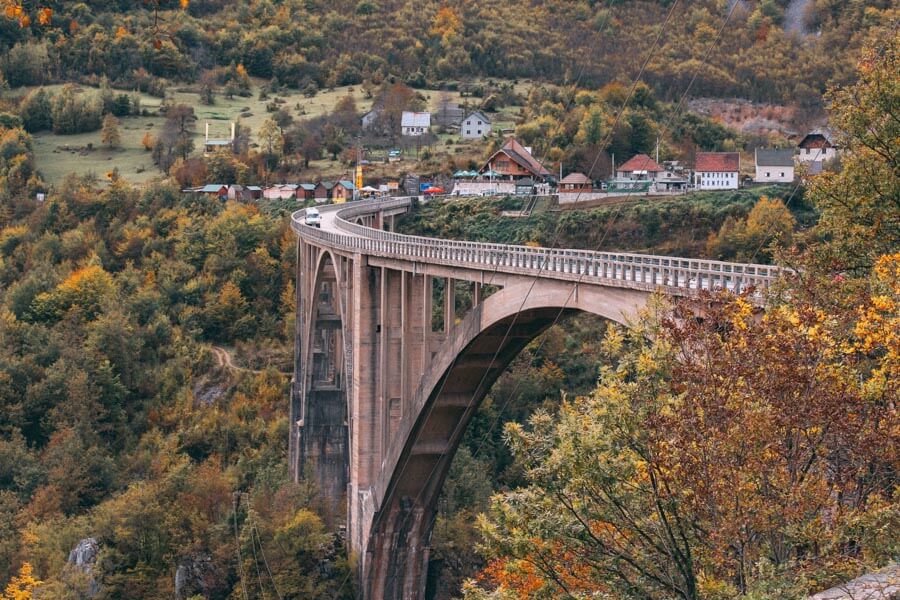
It is here where you can go rafting (just make sure to book it in advance, there is zero chance to sign up for a rafting adventure on the spot), ziplining (at Durdevica Tara Bridge ), or going down to the bottom of the canyon to one of its wild beaches.
NOTE : The road from Mojcovac to Durdevic Bridge is often closed during certain hours of the day as safety measures are reinforced to prevent rocks from falling from the mountains. You need to ask in Kolasin Information Center when it is going to be open, so you know when to drive.
One of the must-stop places on a road trip in Montenegro is Žabljak, a small town and the main hub for activities in Durmitor Park.
This is where you can find good food, visit a local information center, and get a variety of accommodations to stay overnight.
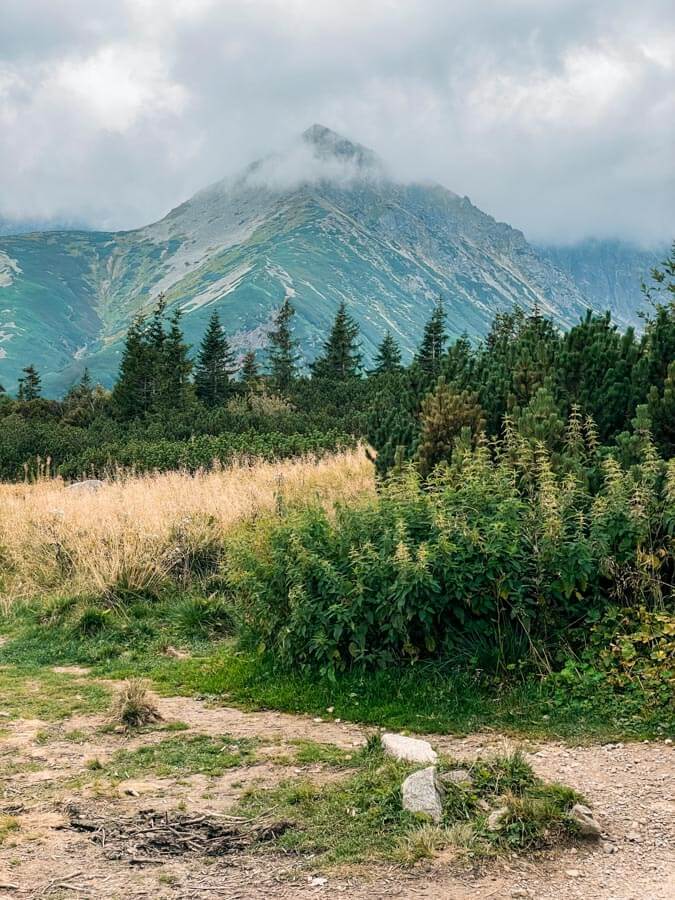
Again, this national park is another place in Montenegro where you can spend days and engage yourself in all sorts of activities, including hiking to Bobotov Kuk or choosing one of the easier hiking trails in Durmitor .
But as far as a road trip, head towards Piva Lake through Sedlo Pass , as that drive is just magnificent.
The pass would be, however, only accessible in warm time from around May (depending on how much snow is there) to around the end of October.
This is another stop to make on this road trip with quite a few interesting places to visit and activities to have – an old fortress, a few monasteries, mountain lakes, fishing, hiking, rafting, cycling, and SUP/kayak expeditions on the lake.

After the lake, the drive continues south where there is a significant old Orthodox monastery in Pluzine. Interestingly, it is not its original location as it had been moved stone by stone from another spot up the stream, due the infrastructure development. The relocation process took 12 years to complete.
On the outside, the monastery building looks new, but inside, all the original 13th-century frescoes have been carefully transferred piece by piece from the walls of the old monastery.
Niksic is another stop on this Montenegro road trip route but just to stretch your legs and eat traditional food if you are hungry. The city is non-touristy and quite ordinary, so I wouldn’t concentrate much on it.
However, if you would like to grab something to eat, I’d recommend Kastel 2 restaurant , it just has quite an extensive menu with some of the most delicious dishes. We like stopping here to eat goulash with mashed potatoes or civcara with salads.
One of the interesting things to do in the city is to go to Bedem Fortress which opens up a nice view.
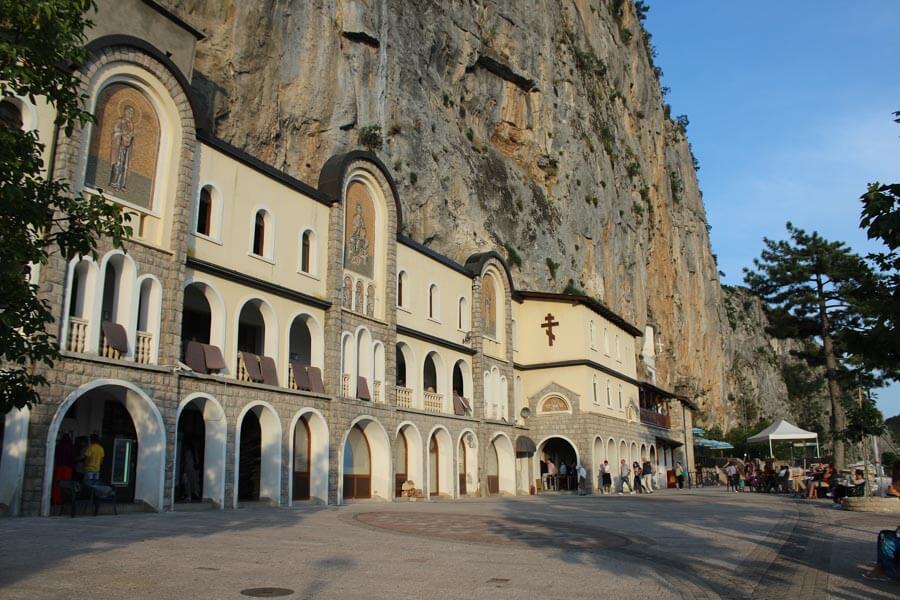
A not-to-miss highlight of this drive is an old Serbian Orthodox Monastery that was carved into the cliff sometime in the 17th century.
The entrance is free but everyone is welcome to buy and place a candle inside.
After Ostrog Monastery, drive back to Podgorica where you can start another road trip or finish your journey.
Do You Want to Plan Another Road Trip in Montenegro?
If you feel like you’d like to plan another Montenegro road trip itinerary, specifically tailored for your needs and special requests, then get in touch with me and I’ll help you do it.
We are based in Montenegro for part of the year and know the country very well. Discovering new driving routes is one of my favorite things to do in this country !
More Montenegro Travel Tips
- How Many Days to Spend in Montenegro? – tips and advice on how to decide
- Is Montenegro Safe? – what to know before you go
- Is Montenegro a Good Country? – my honest take on it
- Secret Beaches in Montenegro – away from tourists and crowds
- Where to Stay in Montenegro – guide to different areas and accommodation
Other Cool Road Trips in Europe & Beyond
- Georgia Road Trips Ideas – scenic drives in the Caucasus
- Unique Road Trip in Spain – I bet you didn’t know about it
- Barcelona to Valencia drive – another road trip in Spain not to miss
- Best Road Trips in Andalusia – if your starting point is Malaga City
- Unique Road Trip in Turkey – to see the Turquoise Coast

Anya is originally from Ukraine but in heart she is a citizen of the world. She is working online and that’s why has an opportunity to travel a lot and live in different countries. At present time, she is based in Spain while waiting for the war in Ukraine to be over to be able to return home. On this blog, her main goal is to inspire others to travel to under-the-radar places and discover the world while working remotely.
Similar Posts

Hiking in Montenegro: 11 Best Hikes For Different Seasons
I continue to expand my list of the best hikes in Montenegro since there are always new trails to explore. This summer I am based in the north of the country, discovering Montenegro’s mountains…
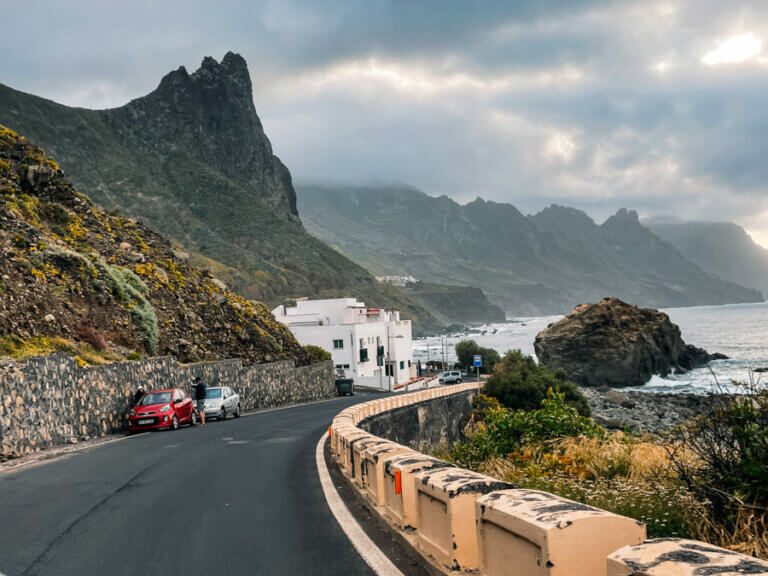
16 Unexpected(!) Cold Places to Visit in Summer in Europe
Quite recently, I preferred to get through the summer without much travel and instead spend this time on work. Because I couldn’t take the heat and all the high prices that this season brings….
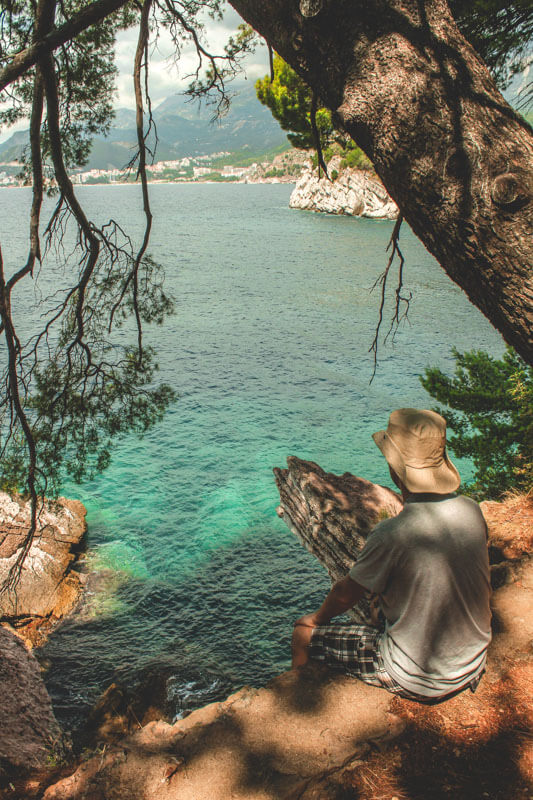
Walking in Montenegro: 6 Scenic Easy Trails For Any Visit
A significant part of the relief of Montenegro is an excellent platform for leisurely walks and hiking trips. Depending on how much time you have in the country and your physical form, there is…
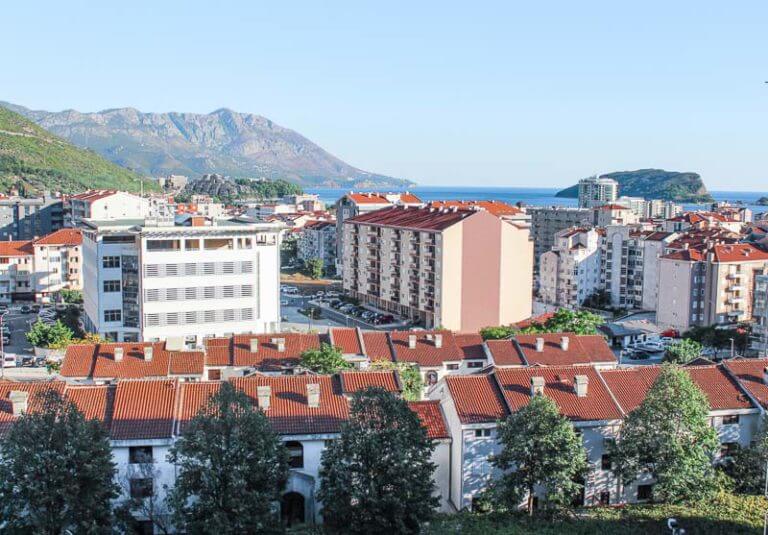
Practical Tips on How to Find and Rent Apartment in Montenegro (Long-Term)
During our time in Montenegro, we rented three different apartments while living in Budva. At some point, we thought to move to Kotor, Bar and even Zabljak and checked quite a few different homes…
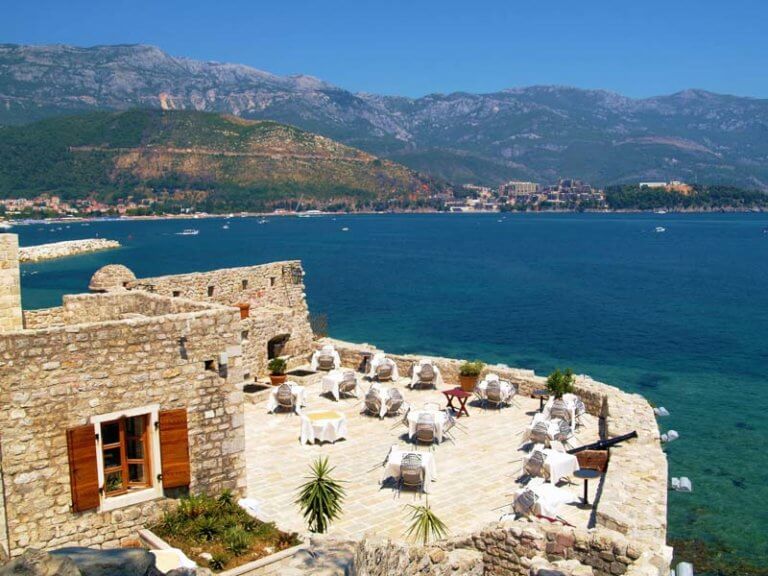
Guide to Beaches in Budva – Which One to Choose & Where to Stay
Budva as one of the most visited cities in Montenegro gained fame for many reasons – for unique things to do, for rich nightlife, and, of course, for a large number of different beaches….
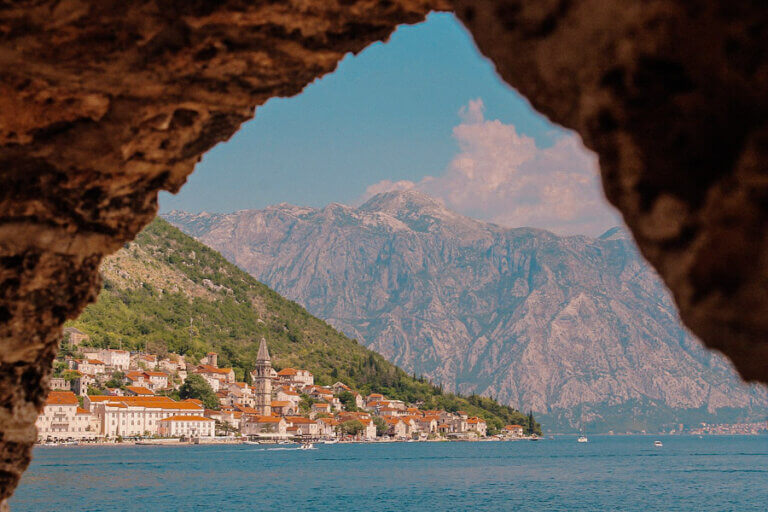
Bay of Kotor Travel Guide: Things to Do, Best Hotels & Travel Tips
The Bay of Kotor, also known as Boka Bay, Boka Kotorska Bay, or simply the ‘Southernmost Fjord of Europe’ is a must-visit destination in Montenegro, no matter if you are visiting on a mega…
Leave a Reply Cancel reply
Your email address will not be published. Required fields are marked *
- Dubrovnik Airport Transfers
- Tivat Airport Transfers
- Podgorica Airport Transfers
- Group Transfers
- VIP Transfers
- Kotor Walking Tour
- Adventure Park
- Montenegro Tour
- Mini Montenegro Tour
- Budva and Sveti Stefan
- Create Your Own Itinerary
- Olive experience Tour
- Via Ferrata
- Tara River White Water Rafting
- Monastery Ostrog
- Canyons Of Montenegro
- Skadar Lake
- Photo Tours
- Jeep Safari
- Kitesurfing
- Paragliding
- Tara River Rafting
- Big Game Fishing
- Birdwatching
- Rock climbing
- Team Building
- Meeting & Conferences
- Incentive Trips & Events
- Car Rental Croatia
- Car Rental Montenegro
- Montenegro Coast
- Central Montenegro
- Northern Montenegro
- NP Biogradska Gora
- NP Durmitor
- NP Prokletije
- NP Skadar Lake
- Wine and Dine
Tourist Information
- Things to do in Montenegro
- Official Currency: Euro € (although Montenegro is not yet an EU member)
- Area: 13 812km2
- Time Zone: GMT +1
- Capital: Podgorica
- Population : 625 266 (census 2012)
- Total Border line: 614 km
- with Croatia: 14 km
- with Bosnia and Herzegovina: 225 km
- with Serbia: 203 km
- with Albania: 172 km
Interesting geographics facts
- Total coastline lenght: 293.5 km
- Total Beaches lenght: 73 km
- Longest beach: Velika plaža Ulcinj - 13 km
- Mayor Bay area: Bay of Kotor
- Highes mountain peek: Bobotov kuk (Durmitor mt.) 2 522 m
- The biggest lake: Skadarsko jezero -391 km2 (biggest on Balkans)
- The deepest canyon: Tara river1300 m (deepest in Europe)
National Parks
- Durmitor: 39.000ha
- Lovćen: 6.220ha
- Biogradska gora: 5.650ha
- Skadarsko jezero 40.000ha
- Prokletije: 1.052 ha
UNESCO Herritage sites
- Kotor old town
- Durmitor with Tara Canyon
National Hollidays:
- 01.January - New year
- 1.Maj - Internationa Labour's day
- 21 Maj - Independence day
- 13.Jul - National Holliday of Montenegro
Major telephone codes and numbers
- International prefix: + 382
- Informations: 1181
- Exact time: 125
- Fire department: 123
- Polce and Emergency: 122 or 112
- Emergency: 124
Banks work Monday to Friday usually opening at 08:00 or 08:30 and closing around 16:00. Saturday closing at 12.00h. You can change currencies (ie US$ to Euros) only in banks. Street changning is prohibited by law. Beside penalty you could be part of fraud and loose your money. We suggest to change your money just in banks.
ATM machines works arround the clock. Check with your bank about percentage when getting money on other machines.
Payment in shops, hotels and restaurants could be done via credit or debit cards.
Your health care
Pharmacies are open usually from 08:00 and they are open until 20:00 or 21:00. During season, tourist centers has night drugstores. If you suffer from chronic health conditions, please bring enough medications in original package.
Emergency works arround the clock. All cities have excellent Emergency health systems.
Hospitals and Health centers works 7.00 to 20.00. Health care for forigners are concerted by the international laws. Before traveling to Montenegro please check your Health insurance coverage.
Hospitals – Montenegro operates a Health Centre system, with most non-urgent cases being assessed, and usually treated at the local health centre. If hospital admission is required the patient will be referred from the Health Centre to the relevant hospital. Most main town health centres (Dom Zdravlja) operate an emergency room, and also a separate childrens' admissions section. In main towns throughout Montenegro private clinics are also becoming more common.
During your visit, Montenegro Travel Service ask you to inform us about your possible health problems, conditions and special needs, as well as if any Emergency occure, you will get our unlimited help and attention. Do not hessistate to contact us imediately !
Supermarkets tend to open at 06:00 and close at 22:00, larger supermarkets may work 24 hours a day except Sundays when they close for the night. General shops and clothes boutiques often work a double shift, opening in the morning, closing for around 3 hours in the afternoon and then opening again in the evening until late. This is normal in most coastal areas.
PDV/VAT: 90/31-01685-9
Lic.No: 306 Min.Turizma CG
- Terms and Conditions
- Privacy Policy

IMAGES
VIDEO
COMMENTS
Find out what to see and do in Montenegro, a small but diverse country with stunning natural beauty and rich cultural heritage. Discover the jewels of the Adriatic, the Tara Canyon, the workshops of local craftsmen, and the events and offers for every season.
Discover Montenegro, a country of dramatic nature contrasts and colorful rains. Find out about its history, culture, attractions, activities and book your holiday, car rental and transfers online.
Learn about the best places to visit, how to travel, when to go and what to do in Montenegro, a Balkan country with stunning coastline, mountains and culture. This comprehensive guide covers everything from Kotor and Budva to Durmitor and Tara Canyon, with tips and advice for your trip.
Boka Bay: This river canyon is a great spot for hiking and admiring the views below. Courtesy National Tourism Organization of Montenegro. Durmitor National Park: Formed by glaciers, this is a ...
Drobni Pijesak Beach in Montenegro. Explore Montenegro's top attractions in Kotor and Budva. Discover hidden gems, insider tips, and expert recommendations for a memorable trip.
Discover Montenegro's majestic mountains, breathtaking beaches and larger-than-life locals with Lonely Planet. Find attractions, articles, activities and tips for your trip to this small but stunning country.
Learn about Montenegro's stunning scenery, culture and activities in this comprehensive guide by a travel blogger. Find out where to go, when to visit, what to do and how to get around in this Balkan country.
Discover the best places to visit in Montenegro, from the stunning Bay of Kotor and medieval towns to the Budva Riviera and Lake Scadar. Learn about the history, culture, nature, and attractions of this beautiful Balkan country.
Learn about Montenegro's geography, climate, currency, visa regime and more. Find out the deepest canyon, the largest vineyard, the longest beach and the highest peak in Montenegro.
Discover the best places to visit in Montenegro, from the charming town of Perast to the longest beach on the Adriatic. Explore the UNESCO Old Town of Kotor, the Mausoleum on Lovćen, Skadar Lake National Park and more.
7. Hit the slopes. Thanks to an average of 120 days of snow each year, Montenegro is the perfect winter sports destination. The ski resorts in Montenegro sit at altitudes of up to 2,181 meters (7,155 feet) and there are over 20 kilometers (12 miles) of slopes to enjoy.
Njegoš Mausoleum. Central Montenegro. Lovćen's star attraction, this magnificent mausoleum (built 1970 to 1974) sits at the top of its second-highest peak, Jezerski Vrh (1657m). Take the 461….
Things to Do in Montenegro, Europe: See Tripadvisor's 270,444 traveler reviews and photos of Montenegro tourist attractions. Find what to do today or anytime in September. We have reviews of the best places to see in Montenegro. Visit top-rated & must-see attractions.
Montenegro Destinations: Best Places to Visit in Montenegro. Kotor, top tourist destination in Montenegro. Image: Deposit Photos. Most of the top tourist destinations in Montenegro are on the coast. With stunning beaches, idyllic towns, and plenty to see and do, the coast is a must-see during any trip to Montenegro.
A gastronomy tour is another way to experience Montenegro's wine and food, a cornerstone of the culture. You love history: Montenegro's history goes back over 2,000 years and you'll be able to explore Roman ruins, Venetian old towns, ancient settlements, medieval grave sites and multiple museums.
11. There's a 'secret' way to visit St. John's Fortress for free. 12. You must spend a night in Perast when Travelling in Montenegro. 13. Montenegro has two capitals (and only one is worth visiting) 14. Don't skip one of Europe's prettiest (and most underrated) train rides. 15.
Plan your trip to Montenegro with this comprehensive guide that covers visa, tourist tax, seasons, activities, and more. Find out the best places to visit, eat, and stay in this beautiful Balkan country with mountains and sea.
On average, a day in Montenegro might cost around $112 (€104) on a mid-range budget, which includes meals, local transportation, and accommodation. A one-week trip for two people averages at $1,568 (€1,458), encompassing food, transport, and sightseeing. Daily budget per person: Basic €40 / occasional treat €70.
Trace the romantic Boka Kotorska, visiting the UNESCO World Heritage old towns in Kotor and Budva, and draw out your time in Perast, my favourite place in Montenegro, for as long as humanly possible. Dip your toes in the capital, Podgorica, a city everyone loves to hate on, before heading for the incredible Lake Skadar.
Visit Montenegro brochure brochure provides condensed facts about Montenegro: one-liners about the most interesting towns and their history. You will find compact information about the most beautiful and popular beaches, captivating lakes and canyons, monasteries carved into mountain sides and at-the-mountaintop monuments that deserve to be on your bucket list.
10. Montenegro has a total number of 117 beaches. 11. It is one of the most famous tourist destinations in the world. 12. Lord Bryon, a legendary English Romantic Poet described Montenegro as: 'At the birth of the planet the most beautiful encounter between land and sea must have been on the Montenegrin coast'. 13.
Montenegro is one of the fastest-growing tourist destinations. [1] In 2007, over a million tourists visited Montenegro, making some 7.3 million overnight stays (23% increase, compared to 2006). This accounted for some 480 million euros in tourism revenue in 2007 (39% increase, compared to previous year). [citation needed] In 2015, tourism realised over 1.7 million arrivals, with a further ...
With my Montenegro road trip itineraries, you can go on short drives in different directions or combine them all in one big Montenegro tour and explore the country in 7 or even 10 days. These are the routes Mark and I have personally driven many times and they are great picks for anyone thinking of going on a drive in Montenegro in any season.
General shops and clothes boutiques often work a double shift, opening in the morning, closing for around 3 hours in the afternoon and then opening again in the evening until late. This is normal in most coastal areas. Montenegro Travel Service is DMC company in Montenegro, servicing incoming tourists for MICE, accommodation, transfers and ...
What a beautiful country. And with so much information gathered from this forum (special thanks to Vuky of course), our plan worked - for us. I say that because our plan was to spend a small amount of... Montenegro. Montenegro Tourism Montenegro Hotels Bed and Breakfast Montenegro Montenegro Holiday Rentals Flights to Montenegro Montenegro ...